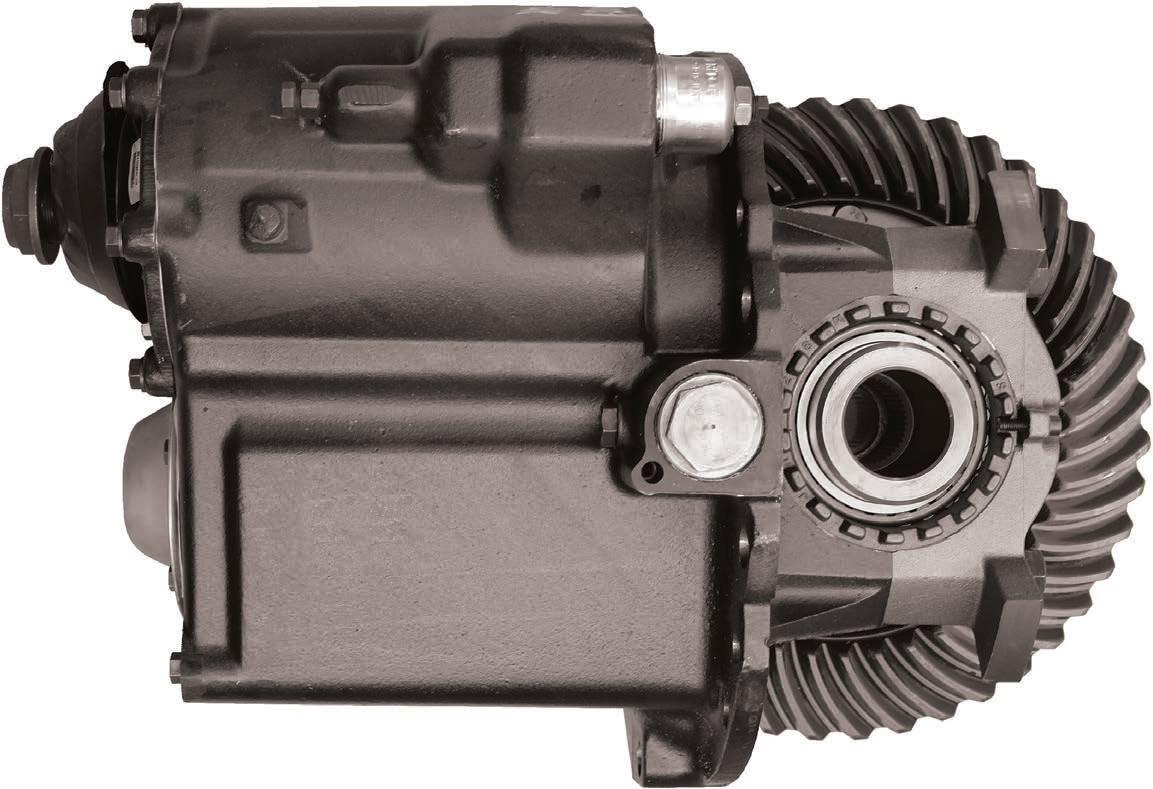






CONTACT US
Address:
Phone:
Email: editor@bigrigs.com.au
Web:
Accounts:
Subscriptions:
EDITOR








Address:
Phone:
Email: editor@bigrigs.com.au
Web:
Accounts:
Subscriptions:
EDITOR
THE results are in from a national heavy vehicle blitz targeting the waste and construction sectors.
The National Heavy Vehicle Regulator (NHVR) conducted “Operation Sapphire” from May 19 to June 15.
A total of 4500 trucks were inspected, with over 3000 of these deemed to have components that were defective.
“The aim of this operation was to clean up unsafe practices within two of the nation’s busiest transport sectors – and unfortunately, we have uncovered a number of significant safety risks during this fourweek initiative,” said NHVR Chief Operations Officer Paul Salvati.
BUSINESS
Treena
*12 month average, October 2024
“The primary concern was mechanical non-compliance, with 3074 defective components identified during the operation and whilst the majority of these were minor issues, 113 were classified as major and mainly for faulty brakes.
“A single truck with failed brakes is all it takes to turn a routine workday into a disas-
ter, and this is 113 times where we could have seen potential tragedy occur on our roads.
“When a fully loaded truck can’t stop effectively – lives are on the line.”
According to Salvati, the transport of waste and construction materials can be particularly hazardous and present challenging safety risks for the driver of the vehicle, and other road users – meaning compliance with safety obligations under the Heavy Vehicle National Law is crucial.
“NHVR Safety and Compliance Officers (SCOs) issued 1530 defect notices as a result of mechanical non-compliance. I would like to urge all operators to take these findings seriously and invest in proactive maintenance, and prioritise pre-departure checks of their vehicle before it hits the road to ensure it is safe and ready for the journey.”
The regulator also identified non-compliance with mass limits as a significant concern during the blitz, with 94 breaches detected – 47 of
which were classified as substantial offences, and 11 categorised as severe violations.
“Mass non-compliance can result in the damage of critical infrastructure and compromise a vehicle’s braking ability, both of which are concerning safety risks,” Salvati said.
“Additionally, out of the 82 loading offences detected throughout the operation, 67 were minor in nature, while 14 were classified as substantial offences.
“Incidents involving overloaded vehicles or loads falling from trucks can have catastrophic impacts, and each of the offences detected throughout Operation Sapphire, no matter how minor, could have had serious consequences had our SCOs not intervened.
“While we recognise and commend the vast majority of industry who are committed to safety and compliance, the results from this operation show there is certainly opportunity for improvement.
“Whether you’re transporting building materials or
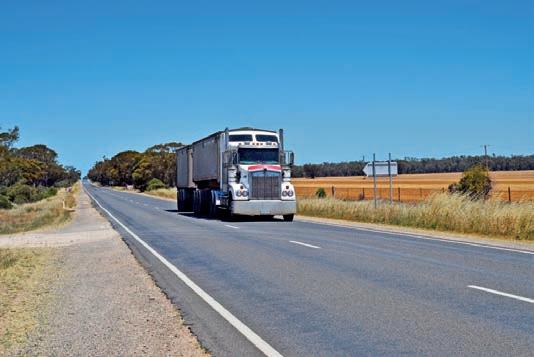
equipment to and from construction sites or transporting waste to a facility – safety is never disposable.”
SCOs worked with police during the four-week operation, focusing their efforts on key transport corridors and high-risk locations, such as quarries, waste disposal sites and construction zones.
“We are committed to working with our partners to proactively reduce road safety risks before they turn into serious incidents and prevent the devastating impacts of road trauma on communities across
Australia,” he said.
“I would like to remind industry that the NHVR is always ready and willing to help with compliance and ensure their movements are safe and efficient, but we won’t hesitate to act when safety is being binned.”
The NHVR recently registered the Waste and Recycling Code of Practice, helping operators manage their Chain of Responsibility (CoR) obligations. The code outlines practical measures for drivers, managers and businesses to eliminate preventable risks.
ANOTHER transport business has entered administration, with Transtar Linehaul Pty Ltd now up for sale – including its 46 prime movers and 70 trailers.
According to the Australian Securities and Investments
Commission (ASIC), administrators were appointed for Transtar Linehaul on July 7, 2025 – with Hamilton Murphy as the administrator. A f irst meeting with creditors was held on July 16.
The business was also listed
as being for sale, with expressions of interest for the business and its assets closed on July 28, 2025.
Transtar Linehaul provides transport services. Its fleet consists of European prime movers and drop deck tautliners.

“Transtar Linehaul provides scheduled linehaul services to its long-term clients which include Couriers Please, Aramex, Hunter Express, Star Track Express and Food and Dairy Co. Transtar Linehaul maintains a companywide service level greater than 99,” the business sale notice read. This news follows a string of recent closures, including Don Watson Transport, Tailored Freight, Francis Transport and XL Express.
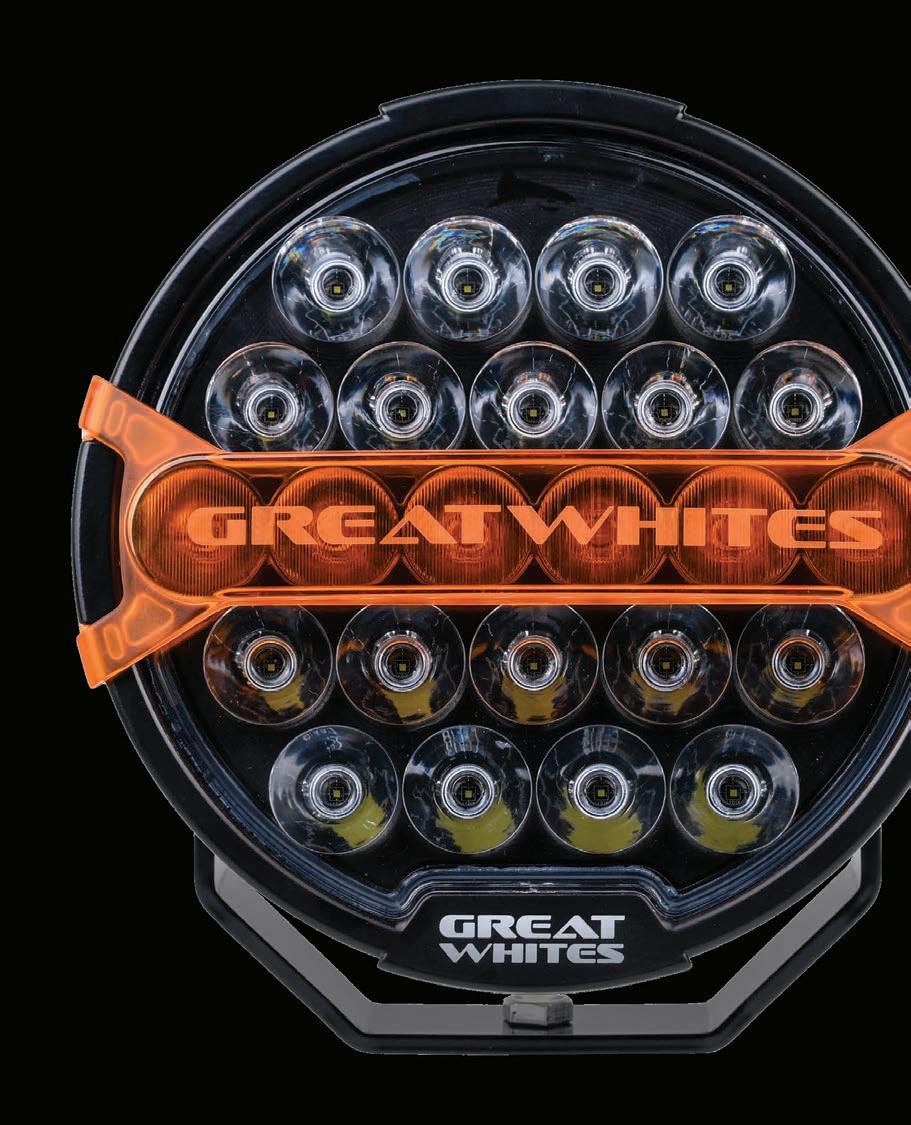

BY JAMES GRAHAM
UNNECESSARY long delays for truckies and operators due to weather events and other incidents in the west are a step closer to being resolved after an industry-first workshop in Adelaide.
Organised by Western Roads Federation (WRF) CEO Cam Dumesny, WA, NT and SA governments, emergency services, regulators and industry come together to solve practical challenges and work towards a joint strategic view for Australia’s “vulnerable freight triangle”.
Dumesny called the meeting to flesh out practical solutions to improve response and safety after several years of increasing disruptions to SA-WA-NT road and rail freight routes, with little to no help from Canberra.
“The federal government has really become far too obsessed with that Melbourne-Sydney-Brisbane corridor and ignored the rest of Australia,” Dumesny told Big Rigs
“We’ve also got a national de fense problem now. We want to be able to project force from our northern bases, but to keep those going, we’ve got to be able to supply them from the southern regions – and we’re struggling to do that now as a civilian industry in peace.”
Dumesny believes working together with the Australian Defence Force could be the driver of change.
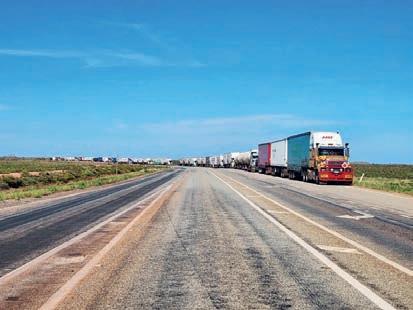
He cited the example of Sweden whose highways double as military airfields in places, a practice that could easily be adopted here.
“There are other simple things: we need rest areas and Defence needs convoy packet pull-up areas when they’re moving convoys across – can we look to duplicate those so there is a dual purpose to them.
“Defence is going to need additional storage capacity in the north. Well, additional storage capacity also gives us the opportunity to mitigate risk when we have freight disruptions by having buffer stocks up there.
“They’re short of drivers, so are we. Can we work together? It’s the simple things like that.”
Dumesny is now calling for the adoption of integrated national freight solution, led by Canberra.
“They should be coordinating the three jurisdictions [ WA, SA and the NT] working together, and there is good willingness among them that came out of the workshop.
“I will now organise a joint WA, SA and NT industry lobbying effort to raise the profile of the issue federally.
“We need to improve the
time it takes to establish alternative routes after incidents nd address road safety issues, including the lack of mobile phone coverage that hinders incident response.”
Dumesny also wants to see steps taken at a federal level to improve safety for drivers.
“We’ve had a lot of inexperienced operators, predominantly out of the east coast, flooding on to the route with things like no spare tyres, trying to do U-turns on the Eyre Highway and jackknifing because they have passed the only fuel station for 150km.
“Main Roads in WA is taking the lead on that and we’re working with them to put some form of standard in so we don’t get people flooding in without experience on to that route during an outage – bearing in mind we had six people killed in the last outage.”
As part of those steps, Dumesny said WA is now looking at adopting the SA licensing model for foreign drivers, while also addressing what he
described as “cultural issues” on the road from “both sides”.
Dumesny is also calling for the banning – or suspension – of major sporting or endurance events during any weather events, or incidents.
Steve Shearer, Executive Officer of the South Australian Road Transport Association, welcomed the ‘freight triangle’ workshop and is already in discussions with Dumesny about what follow-up action to take.
Meanwhile, the Northern
Territory and federal governments are pitching in together in a flood resilience study targeting the Stuart, Victoria and Barkly Highways which connect the Territory’s major cities and remote communities.
It is intended that, the $2.1 million study by WRM Water & Environment will help future proof the Territory’s main transport links by identifying vulnerabilities and developing strategies to upgrade infrastructure to build resilience.
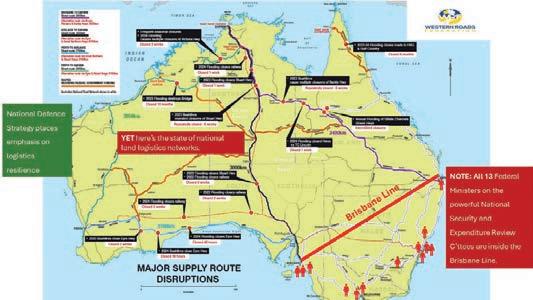
THE Australian Trucking Association (ATA) wants to see every state follow South Australia’s new approach to licensing for road trains and other very long trucks.
To get an MC licence, a driver must hold a heavy combination (HC) or heavy rigid (HR) licence for at least 12 months and undertake training and competency-based assessment or a driving test.
An experienced truck driver from another country may be able to count some or all of their overseas experience toward the 12 months.
But ATA Chair Mark Parry says these rules for MC licences raise two issues.
“The MC class covers trucks with widely different handling characteristics. A driver trained on a B-dou-
ble may not be able to handle a longer road train safely.
The major crash rate for triple road trains is almost 2.5 times higher than the rate for B-doubles,” Parry said.
“A driver whose experience is from overseas may find driving an MC truck even more challenging because they are still learning the formal and informal rules of Australia’s roads,” he said.
Parry says that while Australia’s transport ministers have agreed in-principle to wide ranging reforms to truck licensing, those reforms will take years. The ATA believes an interim solution is needed – and South Australia has shown the way.
Following the death of industry veteran Neville Mugridge in a horrific crash on the Eyre Highway,
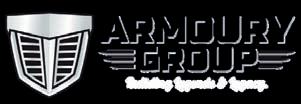
South Australian Transport Minister, Tom Koutsantonis, implemented a supervised MC Licence Program as an alternative to the existing 12 month waiting period.
Since Neville’s passing, his widow Delphine Mugridge has continued fighting for the nationwide adoption of South Australia’s changes to the heavy vehicle licensing of drivers from overseas.
South Australia no longer recognises overseas experience toward obtaining an MC licence, except for drivers from New Zealand.
South Australian Road Transport Association (SARTA) CEO Steve Shearer OAM said the association had lobbied for years for the change, which was repeatedly ruled out nationally.
“Australia has much larger
trucks than other countries and our operating environ ment is different. We now urge every other state to match Minister Koutsan tonis’s initiative, ensuring consistent training and as sessment of all truck drivers, including those from over seas, before they are issued an MC licence,” Shearer said.
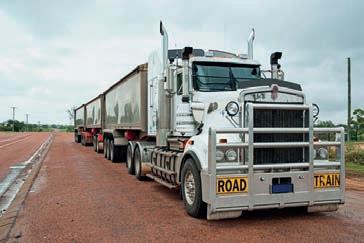
It was the Australian Livestock and Rural Transport A ssociation (ALRTA) that advanced the South Australian approach to the ATA’s member council for endorsement. Its president, Gerard Johnson, said the SA model was practical, inclusive and safety focused.
“Implementing this model nationally will ensure all drivers – regardless of background – are trained on Australian roads to handle the
The ATA says the major crash rate for triple road trains is almost 2.5 times higher than the rate for B-doubles. Image: JavierBallesterLegua/stock. adobe.com
real-world conditions they’ll face,” Johnson said.
“It’s great to see the industry united in backing Minister Koutsantonis’s leadership to deliver a smart interim step while longer-term reforms are developed. This is the kind of
common-sense, cooperative reform Australia needs.”
Parry added that the ATA had tested the merits of the SA approach with a roundtable of multicultural drivers, with the support of Teletrac Navman, the NHVR and the ATA’s Foundation Sponsors – Volvo Trucks, NTI and BP.
“The roundtable participants unanimously endorsed the changes that South Australia has made,” he said.
“The ATA believes that implementing the South Australian approach nationally will not only improve road safety. It will help address the appalling level of racism experienced by some international truck drivers, because every MC driver will have the same HR or HC experience on Australian roads.”
Advantanges of this improved design: Easy to fit with no drilling required Hidden bolt design Fits all truck models Custom length
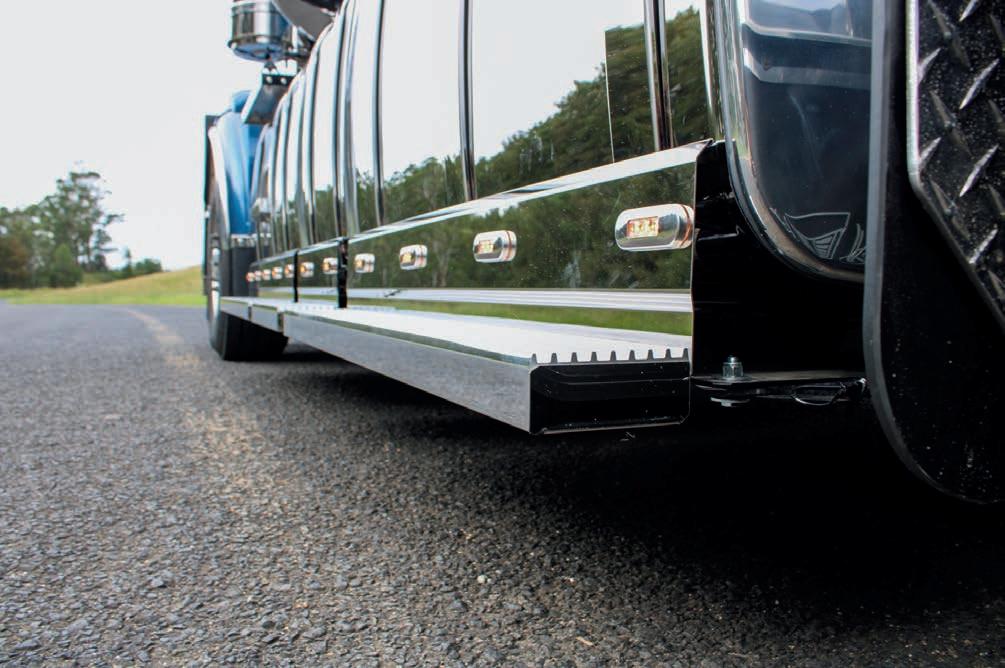
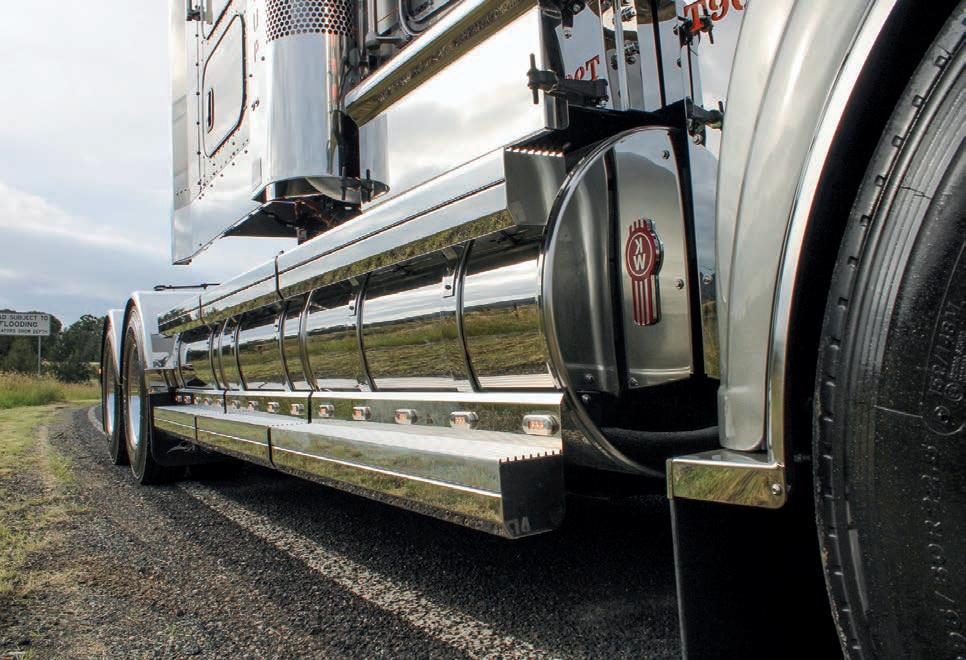
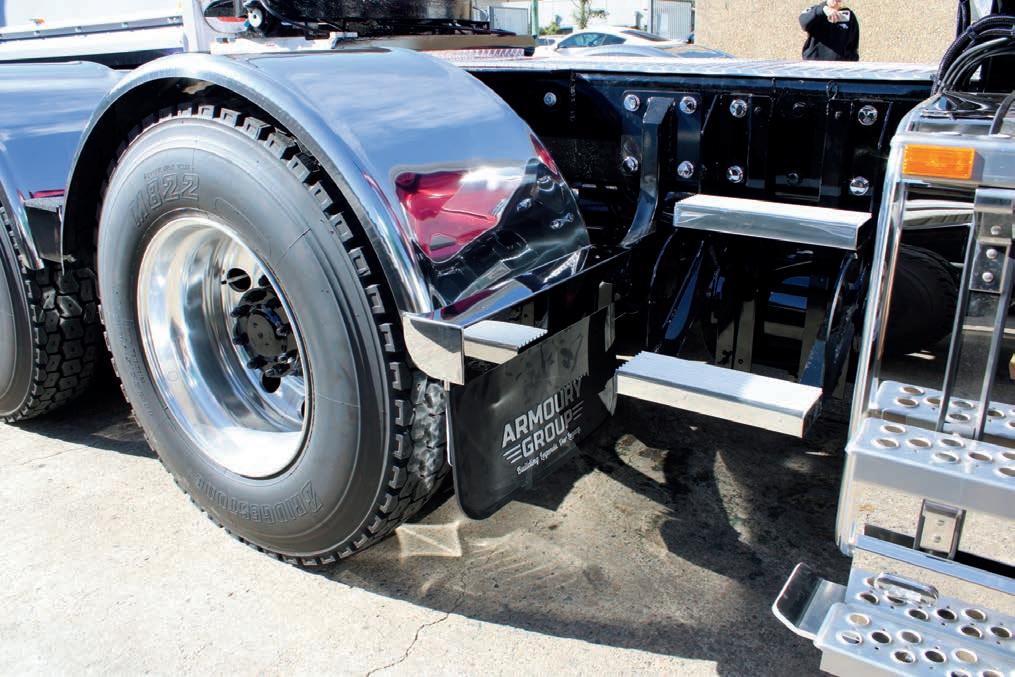
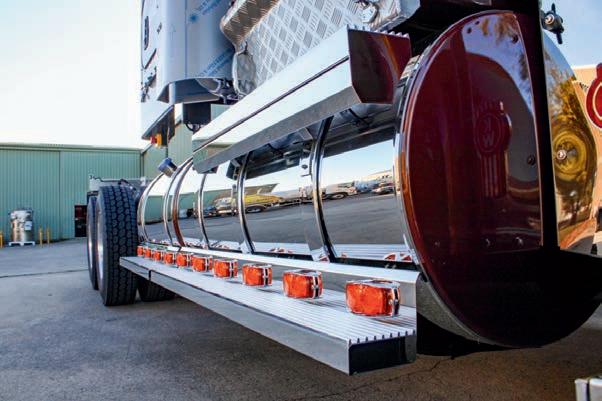
For the first time in its 55-year history, one of the most trusted names in the road freight industry is fronting court over an alleged over-height breach.
BY DANIELLE GULLACI
FAMILY owned and operated, Clayton’s Towing is one of Queensland’s largest tow operators, with a fleet of around 150 tow trucks and 16 locations across the state. Bill and Mary Clayton started the business from scratch in 1970 after they hand-built their first tow truck. Their son Mike Clayton joined the family business in the 1990s and serves as CEO.
In all its years of operation, this is the first time Clayton’s has been accused of breaching the Heavy Vehicle National Law (HVNL).
On February 27, 2025, one of its drivers was tasked with picking up a Kenworth rigid from Bundaberg, to be transported to Brisbane.
The vehicle was intercepted by National Heavy Vehicle Regulator (NHVR) Safety and Compliance Officers
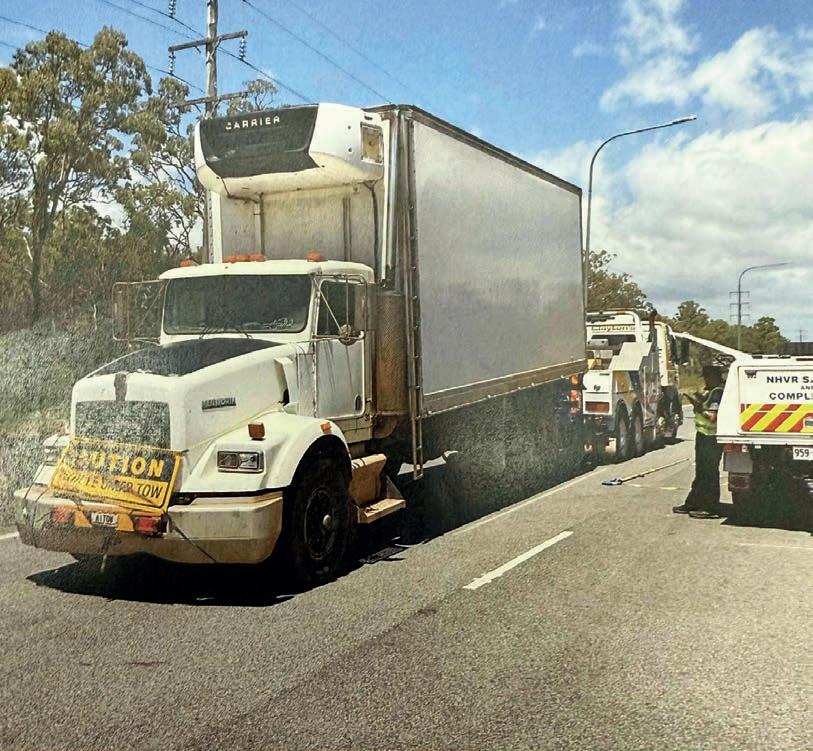
(SCOs) on the Bruce High way, Maryborough. They p found that the heavy vehi cle had a permitted height o height of the Kenworth be- plied was an eye-watering
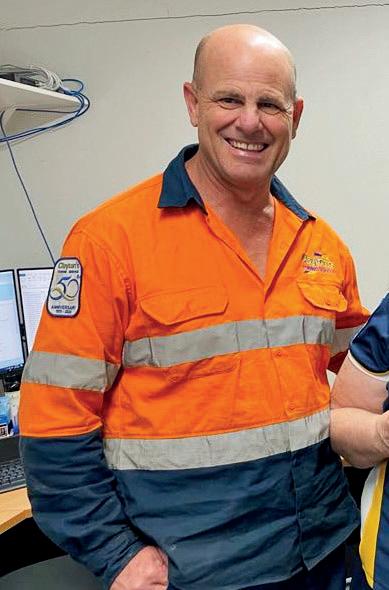
.4 metres high. What the NHVR is saying is that we can’t go above 4.3 metres.
66,550, as the breach was Clayton’s contested the
s Mike explained, “We picked up a Kenworth rig-
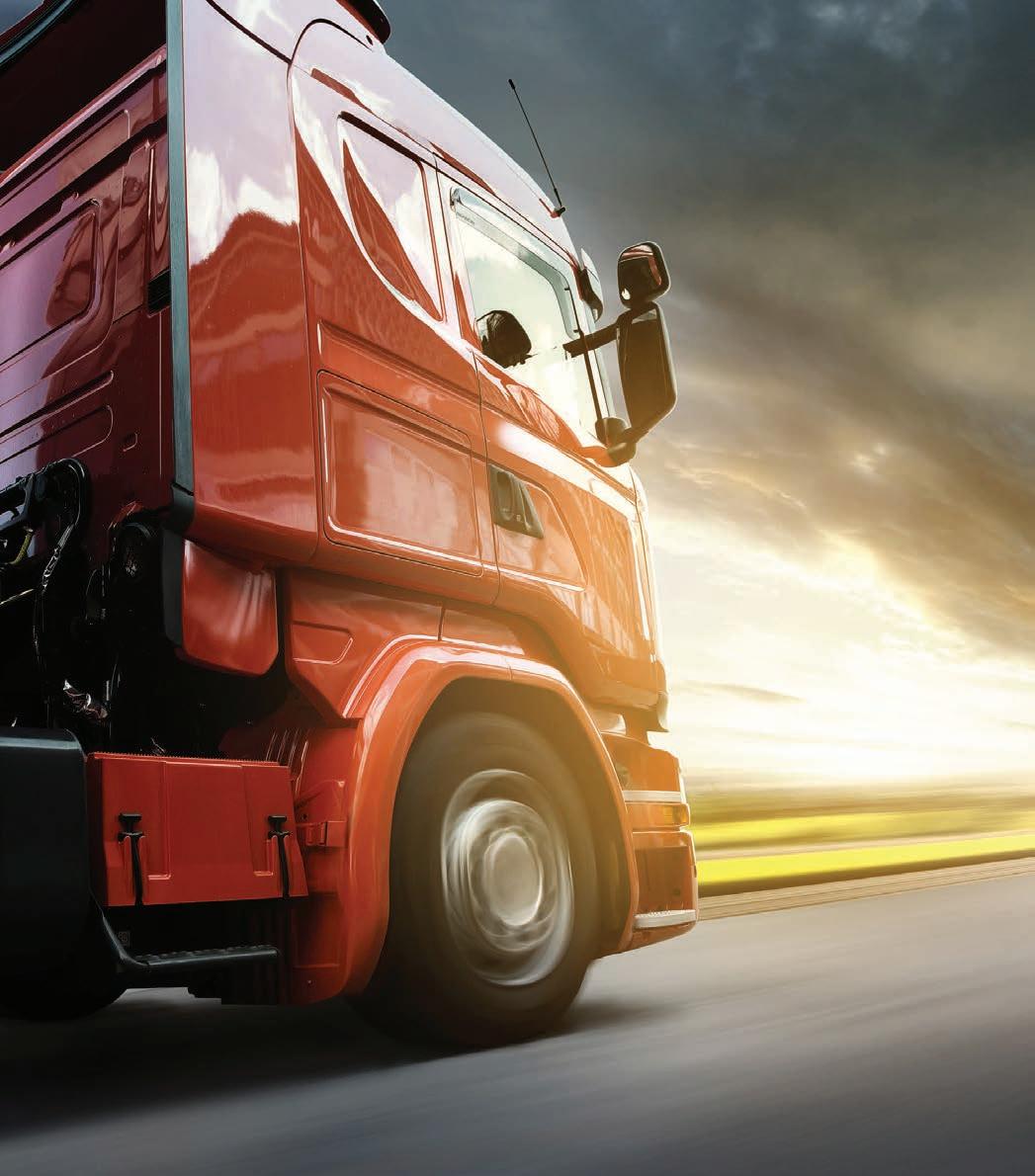
However within our permit guidelines, we can go to 5 metres high if we load a vehicle onto one of our super tilt trailers – and that’s legal.
“If you’ve already got a tall truck to tow, you can’t put that onto a trailer because it
IT’S NOT LIKE WE’RE TRYING TO GO HIGHER SO WE CAN CART MORE GOODS. WE’RE JUST TOWING THE VEHICLE BEHIND US.”
MIKE CLAYTON
will be way too high. So the only way to tow it would be to put it behind a tow truck. The purpose of a tow truck is to tow a vehicle.
“The concern with the 4.3 metre height is that a lot of trucks on the road are already at that height, so when you hook them up to a tow truck, of course you’re going to be over-height.
“Since this incident, I’ve had calls from multiple heavy vehicle towing companies and we’re all doing the same
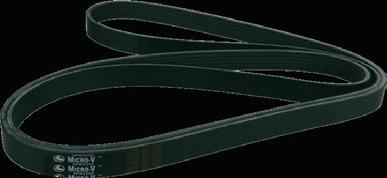





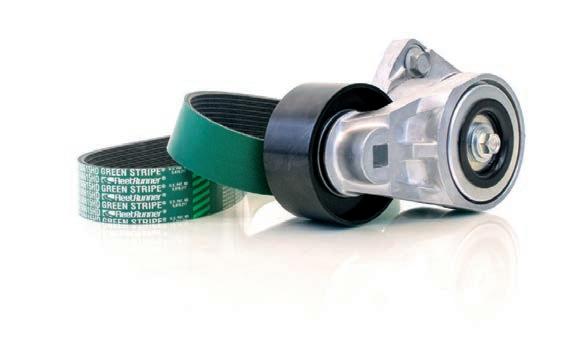

thing. There’s nothing to say you can go above 4.3 metres, but there’s also nothing to say that you can’t.”
In court, Mike says it was suggested that a pilot vehicle be used for cases like this where the towed vehicle brings the combination above the prescribed height.
However Mike explained that this wouldn’t be feasible.
“Sometimes it’s hard enough to get a tow truck somewhere with the hours and distance that can be required. To add a pilot vehicle into that equation just makes it that much harder.
“If a pilot vehicle was required for safety reasons, that’s one thing. But if we were using a super tilt, then we could go up to 5 metres. There’s nothing to gain for the motoring public or the towing operators through the use of a pilot vehicle. Surely they’ll come to their senses.
“They’re calling this a ‘severe risk’ breach – but it’s a severe risk to what exactly?
If you can have a Class 4 super tilt operating at 5 metres high with no severe risk, or a livestock truck at 4.6 metres high, how can it be a severe risk to tow a vehicle above 4.3 metres.
“It’s very confusing and to my knowledge, I don’t think any towing company in Australia has been booked for this before. I’ve spoken to multiple large towing companies in Queensland and none of them have ever heard of this happening. It’s well known that to tow a vehicle,
the truck being towed will be lifted higher. It’s the purpose of a tow truck.
“It’s certainly stirred the pot and if they stick to this it’ll be a huge cost to towing operators to have a truck towed.
“Once this sets a precedent, if you need to start having a truck towed with an escort, there’s a flow-on effect.”
While Mike says he fully understands the need for height and dimension restrictions under the law, it’s a different situation for towing operators. “It’s not like we’re trying to go higher so we can cart more goods. We’re just towing the vehicle behind us. We’re not going to stack another truck on top of it – and that to me is the difference.
No one is trying to get an advantage out of going above these heights. We’re just trying to tow a vehicle and if that’s the height of it, we can’t change that. It’s not causing any risk to anybody.”
Big Rigs contacted the NHVR for comment on the matter.
“Heavy vehicles, including their components and load, must comply with dimension (including height) requirements. This obligation requires vehicles being towed to also comply with dimension requirements,” an NHVR spokesperson said.
“Dimension limits are in place to protect all road users and the road network, and operators and drivers have a responsibility to ensure their vehicles meet these requirements.
“Drivers should always ensure they have correctly configured or attached a towed vehicle before they start their journey.”
The NHVR added that if an over-height vehicle cannot be towed while maintaining dimension requirements, they may need to apply for an Oversize Overmass Permit.
However as Mike explained, “Clayton’s had a Tow Truck Mass or Dimension Exemption Permit in place for the tow truck, which covers increased weights and lengths, but does not mention heights of the load we can tow. We took the intent that we were governed by the height of the vehicle we were towing, and obviously it was going to be higher than its normal height when being towed.”
Big Rigs also asked the regulator why this instance has been deemed to be a severe breach.
“While NHVR Safety and Compliance Officers prioritise an inform and educate approach to encourage voluntary compliance within the industry, where there is a significant risk that jeopardises the safety of not only the driver, but other road users, the NHVR enforces the Heavy Vehicle National Law (HVNL). Under the HVNL, corporations found guilty of offences face a maximum penalty of five times the maximum for an individual.”
The case has been adjourned, with Clayton’s Towing due to reappear in court on September 29
THE National Heavy Vehicle Regulator (NHVR) has issued a reminder about ensuring Advanced Braking Systems are properly connected, following a recent heavy vehicle intercept.
NHVR Safety and Compliance Officers (SCOs) inspected the truck and trailer combination recently while it was travelling through Coomera, Queensland.
During the intercept, SCOs found that the ABS was not connected between the prime mover and the trailer, and there was a loose pitman arm on the steering box.
told Big Rigs, “SCOs provided education and informed the driver that if a trailer fitted with ABS is coupled to a hauling unit which provides a separate ABS plug, it must be connected.
“A disconnected ABS decreases the stability of the heavy vehicle while also resulting in the trailer not being able to brake effectively, causing significant safety risks.”
connection missing between the prime mover and trailer – with Authorised Inspection Station clearance required.
“The NHVR would like to remind drivers and operators to frequently inspect and maintain their brakes –faulty brakes can drastically reduce the ability to stop safely, particularly in emergencies,” the spokesperson added.
SYDNEY
510 Victoria Street, Wetherill Park NSW 2164 Ph. 02 9756 6199, email: isri@isri.com.au, www.isri.com.au
BRISBANE
3/120 Gardens Drive, Willawong QLD 4110 Ph. 07 3275 2044, email: sales@isribrisbane.com.au, www.isribrisbane.com.au
BRISBANE NORTH
1/259 Cullen Av, Eagle Farm QLD 4009 Ph 1300 11 4774, email: seats@isrinb.com.au, www.isrinb.com.au
MELBOURNE
Unit 1/569 Somerville Rd, Sunshine West VIC, 3020 Ph. 03 9311 5544, email: sales@isrisunshine.com.au, www.isri.com.au
MACKAY
110 – 120 Maggiolo Drive, Paget QLD 4740 Ph. 07 4952 1844, email: admin@isrimky.com.au, www.isriseatsmackay.com.au
PERTH
408 Welshpool Rd, Welshpool WA 6106 Ph. 08 9362 6800, email: info@mmtisri.com.au, www.mmtisri.com.au
DARWIN
Mobile Sales and Service
Ph. 08 8927 0986, email: info@isridarwin.com.au, www.isridarwin.com.au
NEWCASTLE/HUNTER VALLEY
Ph 02 4932 0600,
Unit 2/13 Hinkler Ave, Rutherford NSW 2320 email: sales@hvss.com.au www.isri.com.au


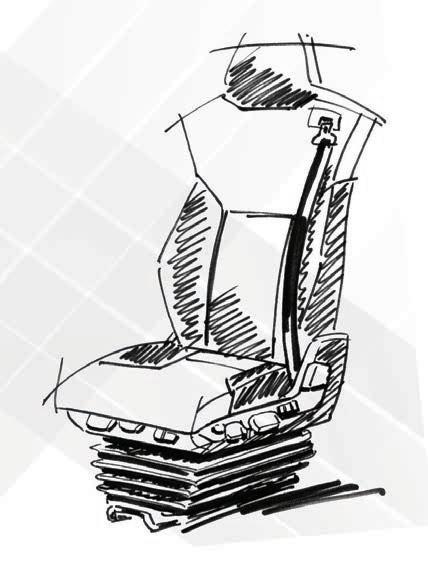
“The NHVR recommendslist, such as the NHVR’s Daily Safety Checklist, to ensure the vehicle is safe and
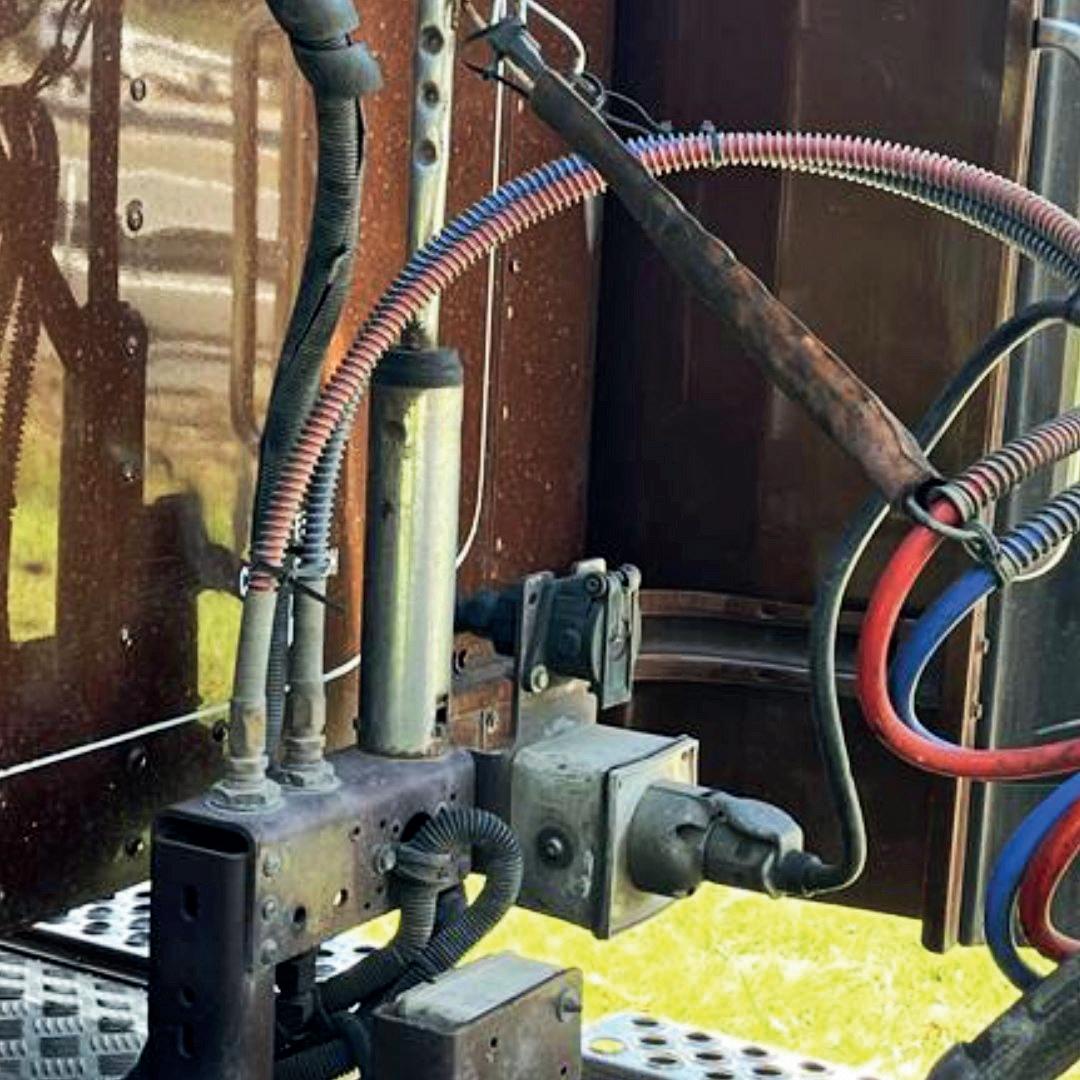
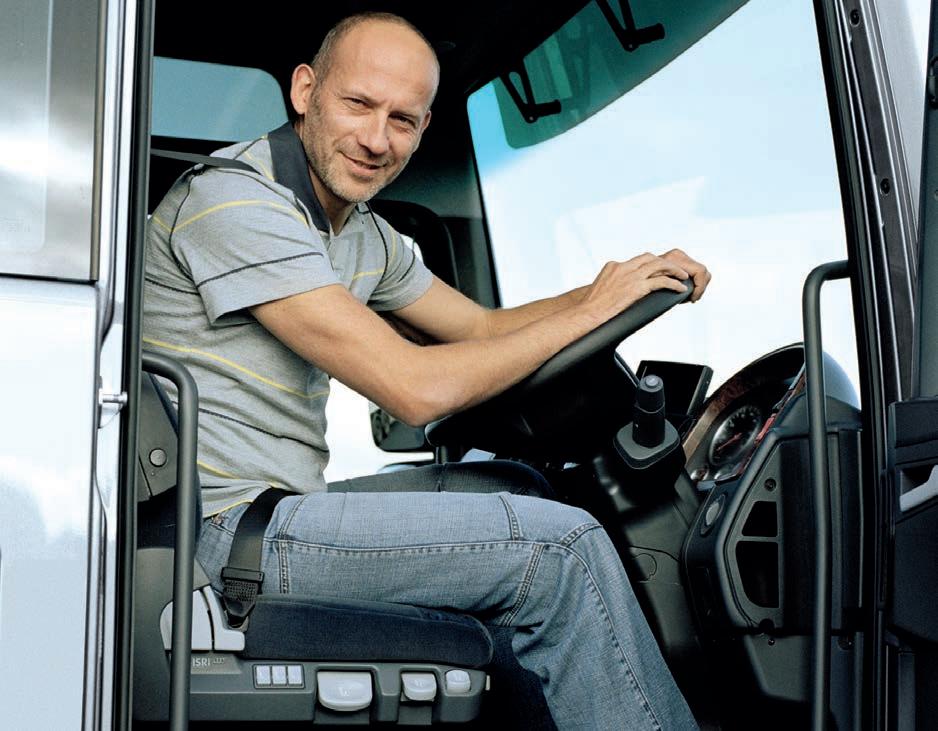




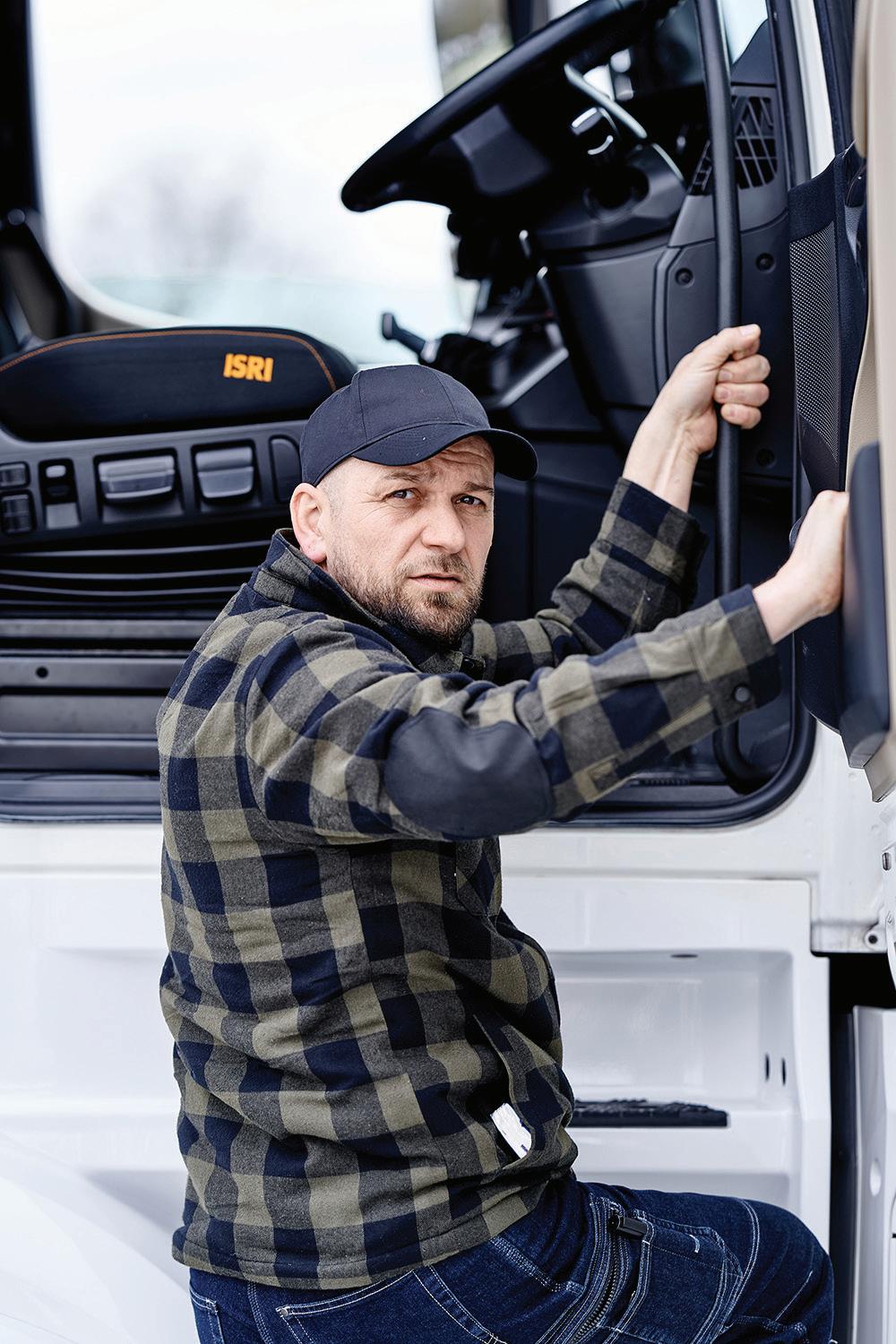


North East Link progress
The Bulleen Road Interchange has become the first permanent section of road to open to traffic as part of the North East Link project.
Representing the biggest ever infrastructure investment in Melbourne’s north east, North East Link will comprise of 6.5-kilometre tunnels linking Melbourne’s freeway network.
To build the new 270-metre section of Bulleen Road, crews installed over 100 of the largest ‘Super T’ beams ever built in Victoria, each up to 43 metres long and weighing up to 126 tonnes.
Work is also ramping up on the major upgrade to the Eastern Freeway, with upcoming overnight closures required at times, through to September.
Mammoth hay run
Farmers Across Borders has partnered with Need For Feed to transport over 6000 bales of hay, with the support of funding from the Department of Primary Industries and Regions.
On Friday July 25, a huge convoy of trucks set off on a major hay run, transporting fodder from Western Australia to drought impacted farmers in South Australia.
The run saw a whopping 84 road trains filled with hay make their way across the Eyre Highway.
Truck driver jailed Queensland truck driver Adam Ohlmeyer, 48, has been jailed for manslaughter after a court found he’d failed to properly secure a load of fencing that detached and killed a motorist in northern NSW.
Grafton’s Martin Stait died after a roll of wire came off the back of the truck and hit his car, causing him to crash near Grafton in August 2021.
Judge James Bennett sentenced Ohlmeyer to three years’ imprisonment for manslaughter with a non-parole period of 13 months.
According to the agreed police facts tendered in court, the truck broke down near Byron Bay and had to be towed to a service station in Ballina.
A driver with a prime mover met Ohlmeyer there and the trailer was transferred onto the second truck.
Judge Bennett said the subsequent check by Ohlmeyer was a failure to take reasonable steps to examine the load”.
Three other men have pleaded not guilty to charges relating to the incident. Their cases are due to go to trial in April.
The has issued a reminder to operators wishing to utilise the Victoria Emergency Drought Network Pre-Approved Permit-Based Scheme. Operators must hold a valid permit even for access to the pre-approved network.
Developed in collaboration with the Department of Transport and Planning, Agriculture Victoria, the Victorian Farmers Federation, and the LRTAV, this scheme aims to streamline and reduce regulatory barriers for interstate operators transporting grain and fodder into drought-affected regions of Victoria.
BY JAMES GRAHAM
JON Kelly, one of the most recognisable names in the Australian trucking industry, is cleaning house.
But no, he’s not going broke, as he stresses to his 271,000 followers on his Heavy Haulage Assets Face book page.
Kelly is instead in the throes of scaling back his heavy haulage operation to focus more on the booming sales and refurb side of his business.
After outgrowing his cur rent Wacol base, Kelly’s just brought a new 12-acre site on the outskirts of Brisbane and doesn’t plan to take most of the working fleet of big bangers with him when makes the permanent move there in 2027.
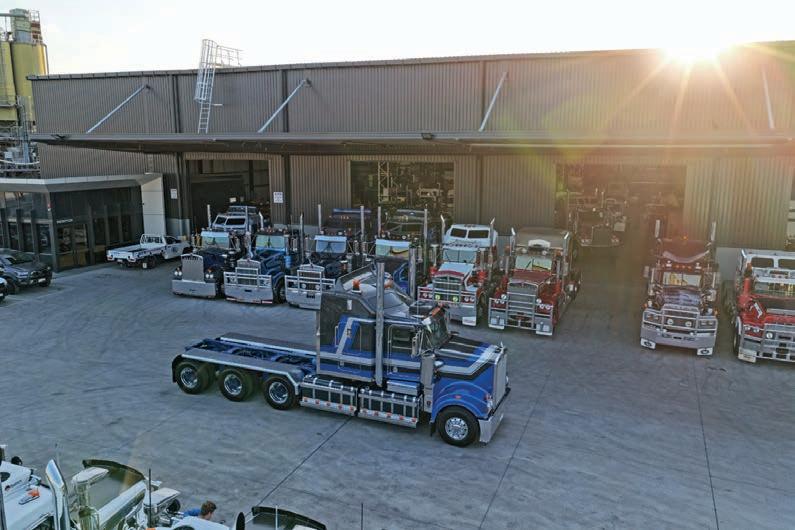
bought a 10-axle platform and think they’re heavy haulage heroes.
Kelly said 14 of his trucks and some trailers will go under the hammer with online auction house Pickles from August 10-14, 10 of which will be on display at the Casino Truck Show on August 2 for would-be buyers to kick the tyres.
Auction lots include all of Kelly’s “blue and silver working trucks” and a couple of hand-picked collectibles.
Kelly said the standouts would be his T900 Legend, SAR Legend, two V8 Mack Value-Liners, a V8 Ultra-Liner and a 1987 SAR Kenworth.
“There’s a great cross-section there for everybody, right down to a 1967 Mack Flintstone.”
Kelly said he had treated heavy haulage as more of a hobby in recent years but found his interest in the sector had been “diminishing” of late for a number of reasons.
“I’ve lost the desire to be a service provider in an industry that’s probably over serviced and underpriced,” he said.
“Everyone’s gone and
“But they haven’t bought a calculator that assimilates what the value should be in terms of what they’re running for.”
Kelly said the playing field has changed a lot since he was the kingpin of the heavy haulage sector and the first call for anyone wanting to move the biggest loads in the land.
“I don’t see the Jon Kelly’s of the world coming through, you know. I don’t see these young guys that all they had in their vision was to go trucking and they wanted to be a perfectionist about it.
“I see big corporations wanting anyone who’s anyone to drive a truck with zero credentials.
“In heavy haulage I keep tabs on what’s going on, and there’s heavy haulage companies that are going and putting people in trucks that have got zero experience and wondering why they have an incident or an accident.”
Looking around the yard, Kelly said it was “ridiculous” how much gear he had tied up just to do one or two heavy haulage jobs a year, which only accounted for around 10 per cent of business revenue.
“Doing this development is going to cost some serious
coin and I need to be realistic about how far I’m going to extend myself financially.
“So, I’m looking at sacrificing one part of the business but having an amazing development at the end of it.”
Kelly said the new site will be big enough for 3000 square metres under roof, made up of 1500-1800 square metres of showroom/ museum space and another 1000-1200 for the busy refurb workshop.
Kelly, who has team of around 20 staff, said he hopes to sell 150-200 secondhand trucks a year, along with a handful of new trucks in a “pretty compressed market” with a further 40 trucks coming out of the refurb division.
“In Covid times we were doing 250-350 trucks per year. I think those days are gone.
“The secondhand market has been tough in the last six to nine months – pricing has come back considerably.”
Kelly said if you’ve got 4050 trucks which were worth $20 million, and the market shifts 10-20 per cent, “you’ve just gone and burnt $3 million bucks”.
“What we’re doing now is combating dealers that have got trucks in stock for the first time in three years.
“All your late model secondhand trucks in your yard
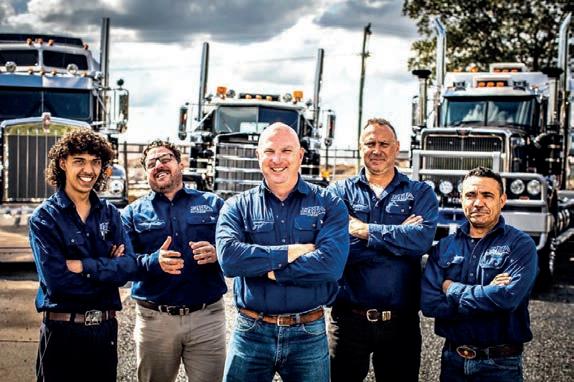
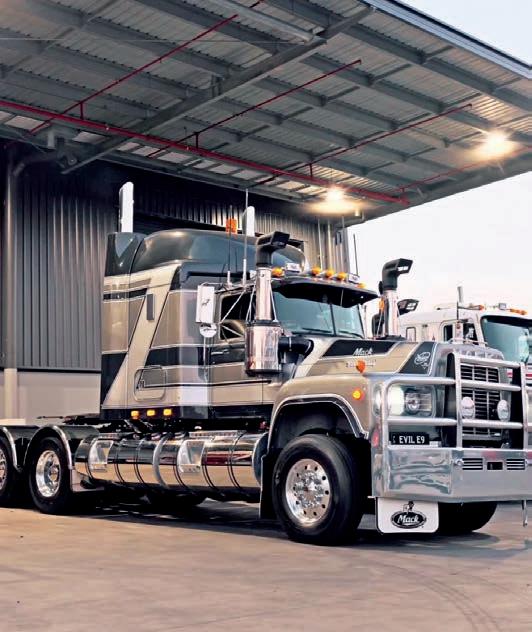
a so we’re back to a purely price market.
“You’ve got to demonstrate value for money in this market. Even if you have a sexy truck that looks good it still needs to demonstrate value for money.”
Kelly said the key to his business is “not getting caught with your pants down” when the trucks are worth $100,000 and then in 12 month’s time only $30,000.
“The key for us is to move our stock and be priced in line with the market. That’s the trickiest thing we do in terms of truck sales, and that’s our biggest risk.”
Kelly, however, is excited
nities with his “bespoke” business which continues to expand an already impressive fan base.
“I look at the following we’ve got in terms of our social media presence, having the open day there during the Brisbane Truck Show and having nearly 10,000 people come through was a massive eye opener to me, to be honest.
“We would get between four and six groups a week through looking at our equipment from various different parts of the world. So being able to showcase that on a more formal basis is my motivation to go and set up this new depot.”
BY JAMES GRAHAM
STEVE Shearer, boss of the South Australian Road Transport Association (SARTA), has added his voice to industry calls for an ATO crackdown on sham contracting in the trucking industry.
The widespread practice, which sees employers hiring truckies on Australian Business Numbers (ABNs) to avoid paying taxes and entitlements, is now top of the agenda at the annual SARTA conference on October 18, said Shearer.
“We’re very concerned about the increasing practice,” Shearer told Big Rigs
“From the intel I’ve managed to gather from talking to drivers, none of them are getting paid the equivalent of a wage for a driving job, which also has super and Work Cover, and all the other entitlements.
“They’re just getting paid to drive and they’ve either got no Work Cover or they’ve got to find their own which will cost
them about $150 a week here in South Australia.”
Shearer said they’ve also got no super, unless they put away a portion of what they’re paid themselves.
“That means for the actual driving job they’re getting paid well below the mark, and the prime contractor is grabbing a major commercial edge with up to a 22-23 per cent saving on their labour costs.”
Shearer said the onus is now on the ATO to do more to crackdown on those flouting the laws.
“How hard would it be for the ATO to run a check on its database for individuals under ABNs who are truck drivers?
“They ought to be able to find that very easily and it would be a large number of individuals. If they did some digging, there would be a very large amount of superannuation that’s not getting paid. Not only are those individuals disadvantaged but down the track, they then become more
of a burden on society.”
In our story on the same issue in our July 18 issue, titled “Pleas for help grow louder”, an ATO spokesperson reiterated that sham contracting is a contravention under the Fair Work Act and can be dealt with by the Fair Work Ombudsman (FWO) through the imposition of civil penalties.
The spokesperson also told Big Rigs that even if the worker is a contractor with an ABN there is an extended definition of employee in the Superannuation Guarantee Administration Act 1992 which requires super to be paid for some contractors.
“Such as where the worker works under a contract that is wholly or principally for their labour.”
The spokesperson added that when the ATO investigates a worker classification matter it will look at the facts of the arrangement to see if there is an employment relationship which gives rise to a tax or
superannuation obligation.
W here an employee has been incorrectly classified as a contractor the business will be liable for a number of penalties and charges including one for up 200 per cent of the SGC, the ATO said.
Owner-driver Ray Christie, however, said he put those laws to the test recently when he took a timber supplier he was working for to court for sham contracting.
“As someone who did actually take a certain timber sup plier in SA to court for sham contracting and lost that these “statements/laws” around sham contracting are just as big a sham,” Christie said.
“I had my own truck which I provided and fitted a new crane onto at my cost and then sub-contracted back to this timber mob solely working for them and them only.
and I worked full time for them permanently and I never contracted to anyone else as I had all their signage all over my truck.
Christie said it took less than 40 minutes at the hearing for the magistrate to effectively ‘throw out’ his case.
“I was then left completely high and dry as I had the truck, no immediate work and copped all my legal fees too.
“It’s nothing more than all talk, smoke and mirrors.”

“My lawyer presented the case that I was indeed an “employee” as my truck was sign written with all their signage


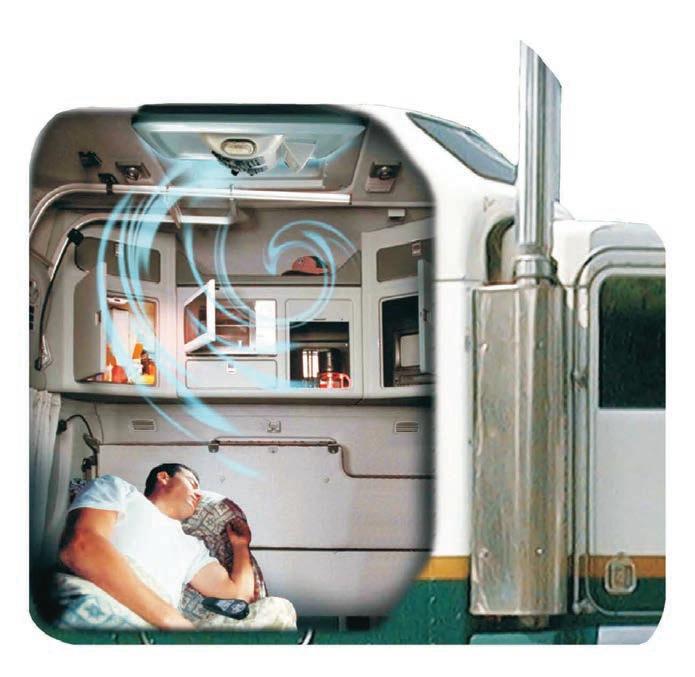

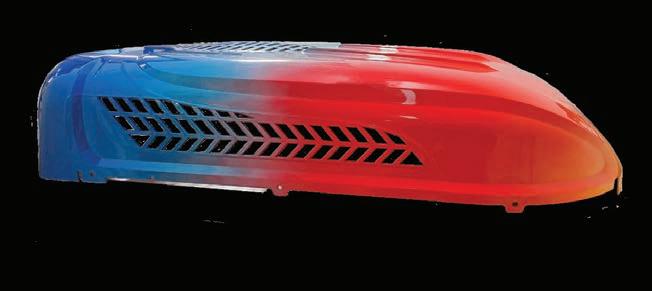


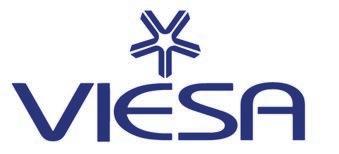
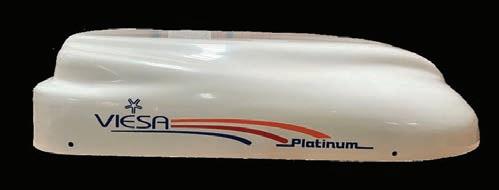
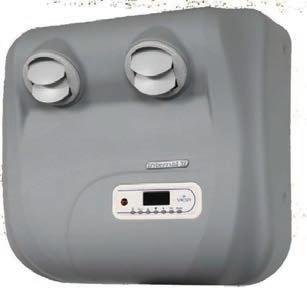

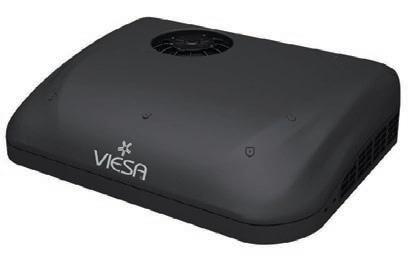

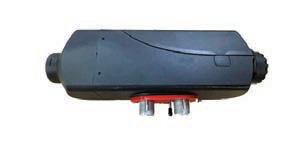


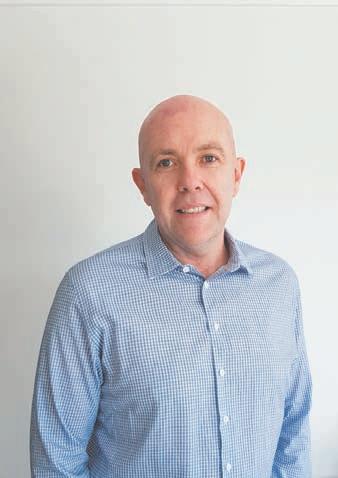
EDITOR JAMES GRAHAM
idea of a licensing system for industry entry.
It was so good, we asked cartoonist Ryan Lee-Taylor to give us his usual satirical take on the right.
Judging by the outpouring of commentary on our Facebook page, a lot of you are still just there for the comments. If you had clicked through to the story, you would have discovered Jodie wasn’t writing about overseas drivers. Given the dramatic spike of company closures of late, she was instead asking why the barriers to entry to this industry are so low. As you all know, anyone can wake up today and start a transport company tomorrow. The checks and balances only come later. Wouldn’t it be better to ensure these companies have all their ducks in a row before unleashing them on the road? Something has to change.
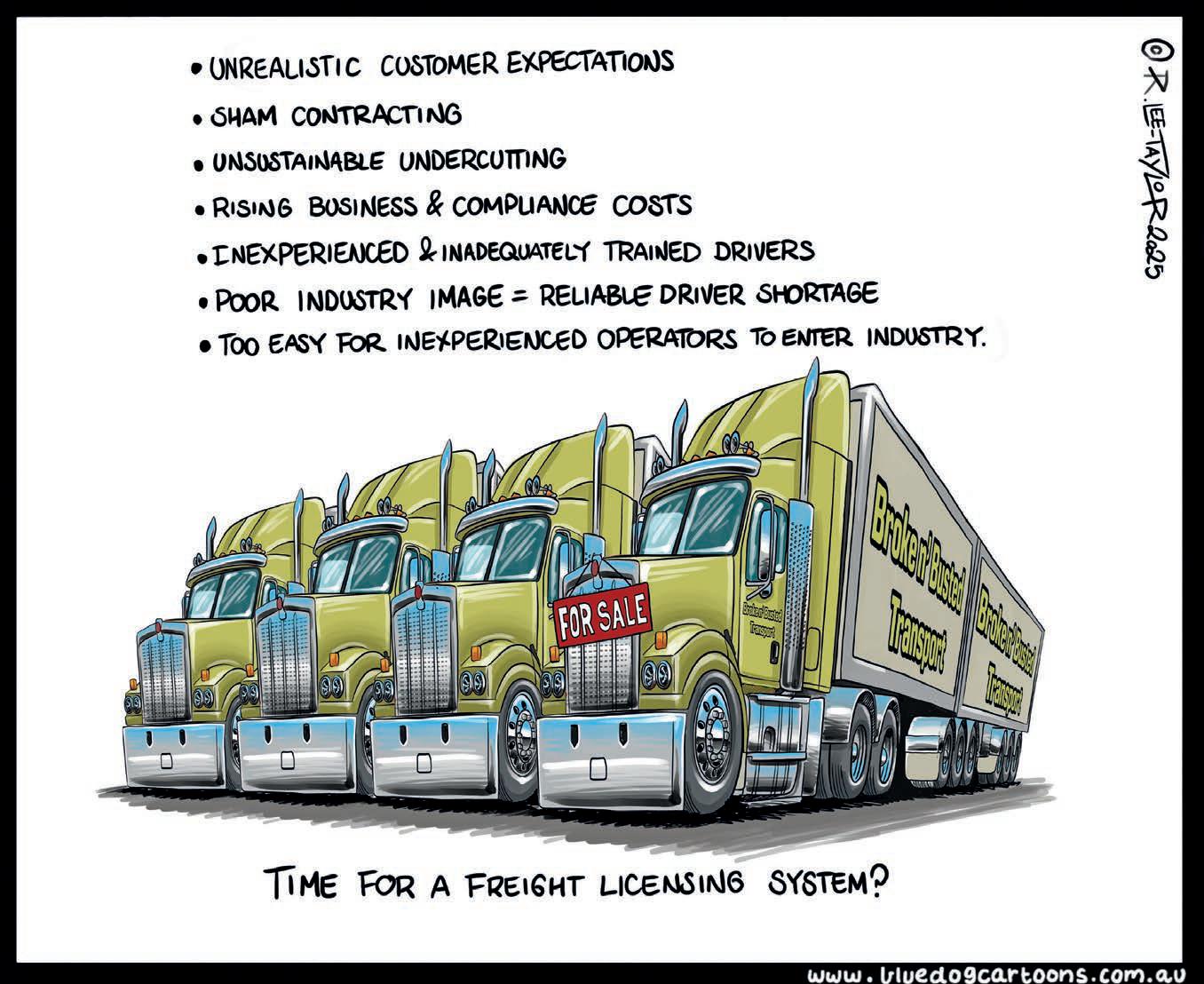
JODIE Broadbent’s latest column debating the timing and merits for introducing a licensing system for operators wanting to enter the industry sparked a huge reaction a mongst readers online.
Interstate truckie Trevor Warner, aka The Driver’s Advocate, said he also proposed an industry-wide licensing model to raise the bar for entry at the recent Senate committee hearing into safe and sustainable transport.
“This was picked up by the Australian Logistics Council who made a public statement of support,” wrote Warner.
“As soon as the Australian Trucking Association heard about this it was killed off. Stone cold dead.
“In Australia, you cannot even build a shed in your backyard without at least an owner-builder’s licence, yet you can operate a fleet of interstate heavy vehicles with nothing more than cash or credit.”
NFG, however, said to “just leave everything along”.
“We don’t need another body handing out licenses to people who they deem suitable to run a business. Let everyone have a free right to start a business.
“If a new player uncut and knocks a long-term player out of the industry, so be it.
“Those long-term players didn’t get where they are by playing nice.
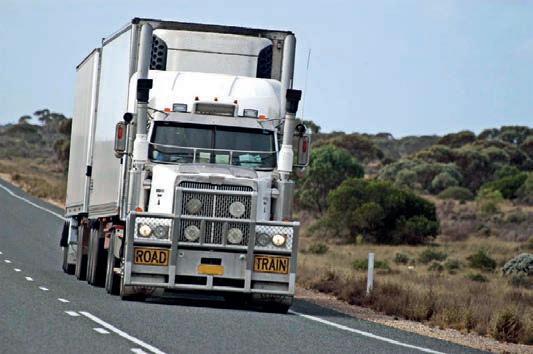
“As for customers dictating the rate, that is because of the oversupply of trucks.”
Added Tony Stephens: “Yep, that’s called regulation, and I believe the government should step in and start regulating the industry.
“They deregulated the coach industry and then it opened the flood gates to dubious operators and slashed profit margins as all the owner-operators started undercutting prices.
“It’s not as bad as it used to be but still a lot of undercutting going on. And this is what is wrong with the transport industry; no regulation price-cutting and too many freight forwarders screwing owner-drivers on freight rates and scheduling. Nothing is working as it should.”
Niell Graham said it doesn’t help when there are some big companies that can afford to run a B-double from Brisbane to Melbourne for $1500 be cause they have a body truck doing Brisbane to Sydney mak ing close to $10,000.
“The company paying for the B-double will then have a gen eral expectation that everyone will do it for the same price.
Neil Montgomery believes authorities should start by “ac tually” enforcing the chain of responsibility laws.
“Start holding prime contrac tors accountable for the sub contractors they employ, then look at the freight-forwarders, consignors and consignees.
THE Australian Trucking Association’s call for every state to follow South Australia’s new approach to licensing for road trains, and other very long trucks, was another hot-button topic online.
“Yep, too many new Australian, unexperienced drivers,” wrote Andy Thompson. “And to many going straight into triples and quads, with no experience.
Peter Gilmour said he’d followed lots of triples and many of them struggle to keep the “whole lot” on the left half of the road.
Adam Swindells believes Worksafe, OHS, insurance, and companies all have a part to play.
“Not that long ago people used to be able to take their kids, passengers, etc. Using kids as an example, just spending time in the environment they witnessed all the small things loading unloading securing loads driving etc. and had the opportunity to grow up in that environment.
“Now a whole generation has missed that, and the knowledge base is growing smaller.”
Lou Warren said some people are just not cut out to drive longer combinations.
“Get these inexperienced women and men driver-trainers out, put people that have 30-40 years in those positions as a retirement job,” she added.
“Stop all overseas people
exchanging their countries licence to ours; they need to start from scratch (car licence) – no matter the said experience, especially countries that don’t have anything bigger than a single.
“Same with the NHVR, just because they drove a truck for a while doesn’t mean fk all; they should be experienced 20plus years triple and road train drivers, (maybe B-double at a bare minimum).
“Whoever is high up in the transport industry/government level needs the sack and put someone that knows what they are doing and with some balls in the position. They are who’s wrecking the industry and allowing all this shit.”
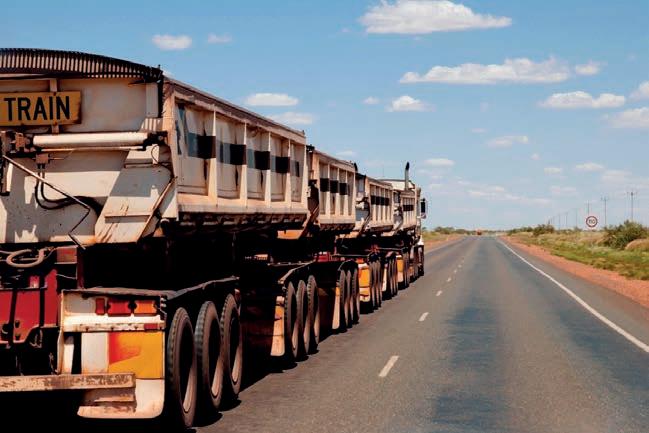
“If CoR was implemented fully for all breaches then we MIGHT start to see change.”
Delphine Mugridge implored readers to sign her petition that helped drive the licensing changes in SA after her husband Slim was killed in a two-truck crash in there in April 2024,
“Please sign my petition to make government sit up and take notice like Minister Tom Koutsantonis did,” she said.
“Go to change.org under change the way licences for heavy vehicles are issued. There is a picture of Slim beside his truck. To date there are 23,283 signatures calling for change. Leave a comment as I also submit them to reinforce our cause desperately needed. Stay safe.”
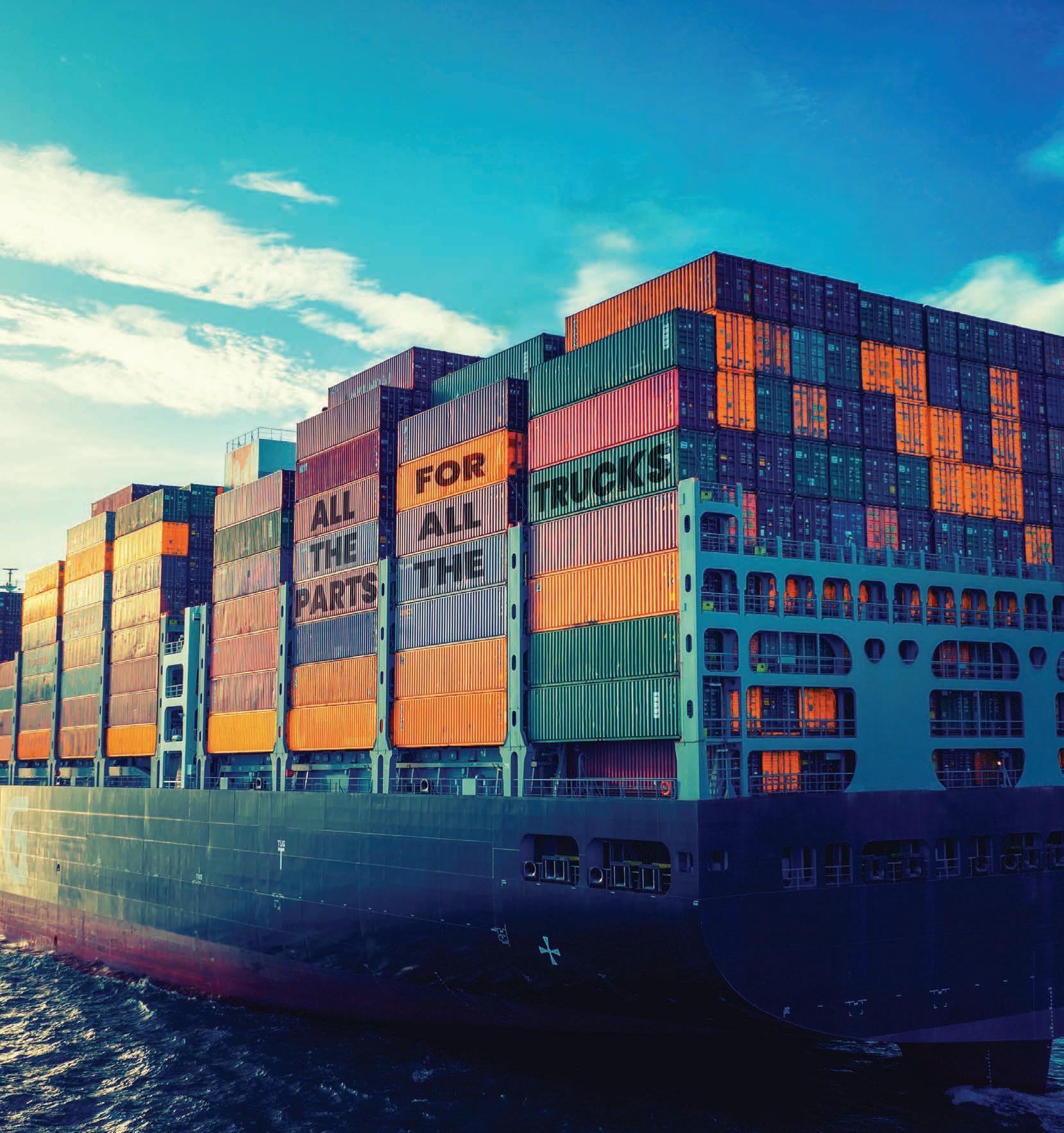


A Sydney-based earthmoving contractor fronted Parramatta Local Court on Tuesday July 22 over a fatal collision that occurred in November 2021.
The National Heavy Vehicle Regulator (NHVR) said the incident involved a heavy vehicle driver employed by the company whose truck collided with a light vehicle, tragically resulting in the death of the light vehicle driver and serious injuries to the passenger.
The company – which the regulator has not named – was found guilty of a Category 2 offence, one of the most serious under the Heavy Vehicle National Law (HVNL), receiving a $1.2 million fine and a further $75,000 in prosecution costs.
A n investigation into the company revealed that the heavy vehicle driver had suffered from significant health issues for several years, requiring 24-hour oxygen support and a family member to ac-
company them on work trips.
A Supervisory Intervention Order (SIO) was also imposed over the next 12 months, with one of the requirements being that all staff and contractors employed by the company have medical clearance or fitness to drive assessments before operating a heavy vehicle.
Other requirements within the SIO state the company must engage a suitably qualified external training provider to deliver tailored training to the owners and all employees.
NHVR Director of Prosecutions Brett Hearnden said the company had admitted to backdating the commencement date of its safety manual and had insufficient policies and procedures in place to ensure their drivers were fit for dut y.
“This tragic incident is a sad reminder of what can occur when an operator does not prioritise the safety of its employees, other road users and the
community,” Hearnden said.
He explained that operators of heavy vehicles must ensure the safety of transport activities and ensure conduct does not cause or encourage a driver of a heavy vehicle to breach the law.
“Put simply, it’s each operators’ responsibility to do everything they can to make transport actions safe, which is why it’s called the primary duty,” he said.
“In this instance, the company failed to implement and enforce systems and procedures to effectively manage the drivers’ fitness for duty.
“Drivers need to be in a suitably fit state to perform their driving tasks so that they don’t compromise or threaten their own safety and the safety of others.”
Commenting on the case, Principal Solicitor at Big Rig Law Megan Allanson told Big Rigs, “The matter highlights ongoing challenges in how the
industry balances duty of care, practical risk management, and regulatory oversight.
“While the facts of the case are tragic, it also raises broader questions for the industry:
It’s a reminder that asking a driver, ‘Is there any medical reason you shouldn’t be driving?’ is not enough. When health risks are known or reasonably suspected, it is reasonably practicable to go further – such as obtaining medical clearance. Relying on self-disclosure won’t shield a business from liability.”
The NHVR has a Heavy Vehicle Confidential Reporting Line (HVCRL) for those in the industry to report safety issues relating to procedures, practices or conditions that could endanger a driver or road user.
However Allanson believes more work needs to be done.
“The NHVR often points to the benefits of engaging external compliance providers, and
the SIO in this case mandates just that – third-party training and medical clearances,” she said.
“While part of the penalty, the SIO could also be seen as a priority-setting tool: it creates a framework for the company to be monitored over 12 months, with oversight and support mechanisms aimed at genuine behavioural change. But that level of structure and guidance isn’t available to most operators unless something goes wrong first.”
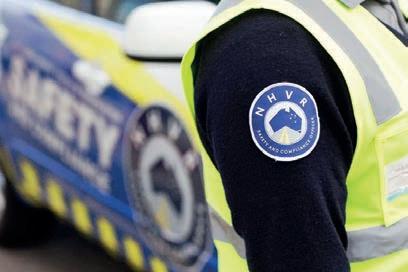
“The reality is that many operators enter the industry without a clear understanding of their obligations, particularly under Chain of Responsibility.
The HVNL imposes a primary duty, but what that means in day-to-day practice is still unclear to many.”
A llanson continued, “The NHVR promotes the Confidential Reporting Line and publicises its enforcement activity, but the broader system still tends to respond after harm has occurred, with the legislation frequently inconsistently applied.
“Ultimately, anyone thinking of going into business involving heavy vehicles needs to be aware of their responsibilities under the Chain of Responsibility. Perhaps this case is also an opportunity for the NHVR to be more proactive – by offering free, accessible training to new companies and their staff before issues arise. Enforcement has its place, but prevention should be the goal.”
FORMER Transport for NSW (TfNSW) staffer Ibrahim Helmy, 38, is under investigation by Independent Commission Against Corruption (ICAC) for allegedly taking $11.5 million in corrupt kickbacks in exchange for roadworks contracts.
Expected to run for several weeks, the public inquiry centred around Helmy has already heard claims that when he was
on the clock for the taxpayers, he was also busy working for himself – collecting cash envelopes in dodgy carpark meetings and “coaching” companies on how to send him millions in cryptocurrency.
Helmy joined the organisation in 2010 through the Roads and Traffic Authority graduate program and worked his way up to become a procurement contract engineer and later a category specialist in the Network and Assets Branch, where he oversaw major road maintenance and delivery contracts.

The ICAC inquiry, known as Operation Wyvern, began public hearings on July 14, and is investigating claims that Helmy and several other TfNSW employees manipulated procurement panels and tender processes over a 12year period.
Counsel assisting ICAC, Rob Ranken SC, outlined
allegations that Helmy had corrupted multiple contract panels, including those for asphalt, line-marking, bitumen and spray sealing, traffic control and safety barriers, with the total value of those contracts reaching approximately $343 million.
The inquiry has heard that Helmy received at least $11.5 million in illicit benefits, paid in cash, cryptocurrency, gold bullion and gift cards. Evidence presented suggests he maintained covert relationships with contractors, offering inside information and influencing tender outcomes in exchange for a share of inflated profits.
One of the key companies implicated is Protection Barriers Pty Ltd, which is alleged to have funnelled around $9 million to Helmy, including cryptocurrency payments between 2021 and 2024.
Jason Chellew, the founder
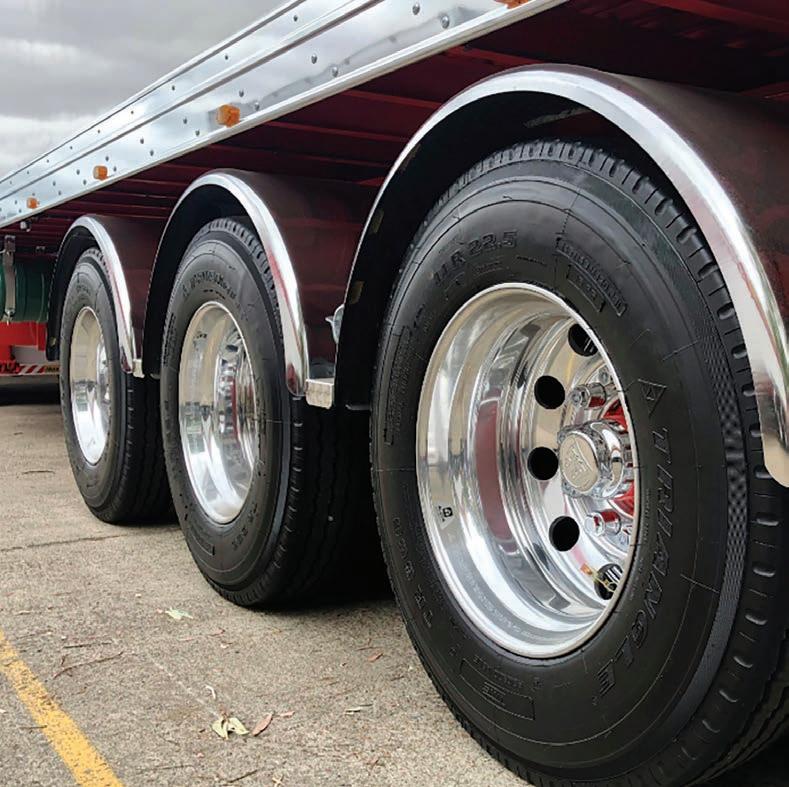
of Protection Barriers, told the inquiry that Helmy used private emails to coach him on how to stay on TfNSW roadwork panels, inflate tender prices and create arrangements where profits would be split between them.
Chellew said the scheme escalated to the point where more than 80 per cent of his company’s work came from TfNSW.
Between April 2020 and September 2024, Protection Barriers won close to $100 million in government roadwork contracts.
The inquiry has also revealed how Helmy allegedly manipulated the tendering process by stacking evaluation committees with compliant officials, passing on confidential competitor pricing and advising contractors on how to set up secondary companies to evade spending caps.
Other companies linked to
the scandal include Direct Traffic Pty Ltd, which received about $48 million in contracts, Lack Group Pty Ltd with around $50 million, Kerway Asphalting with about $35 million, as well as Southern Pavement (Twin City Sealing), Avijohn Contracting and Complete Linemarking.
One contractor said Helmy made it clear that they needed to make personal payments to him in order to secure work.
The network of alleged corruption extended to other TfNSW employees, including Peter Le, Mukeshkumar Patel and David Liu. Liu, an engineer based in Newcastle, is said to have received between $100,000 and $150,000 in kickbacks for helping manipulate truck hire arrangements and supporting Helmy’s schemes.
In September 2024, police raids uncovered large quan-
tities of gold, silver, platinum bars, cash and other valuables linked to the network.
Authorities also froze approximately $8 million in cryptocurrency believed to be tied to the alleged kickback operation. Protection Barriers collapsed into administration following the raids, and its offices were searched, with luxury vehicles and other assets seized.
Helmy was suspended from TfNSW in September 2024 and his position terminated in February 2025.
At deadline for this issue, Helmy had still failed to appear at the hearing. His family told investigators he went missing in May 2025, with one relative saying he “took the rubbish out on a Sunday night and did not return.”
An arrest warrant has been issued for Helmy, with authorities stating they believe he remains in NSW.
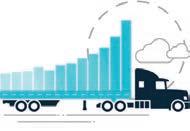

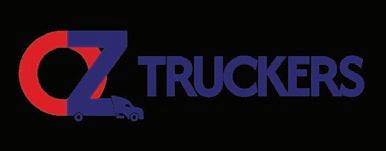
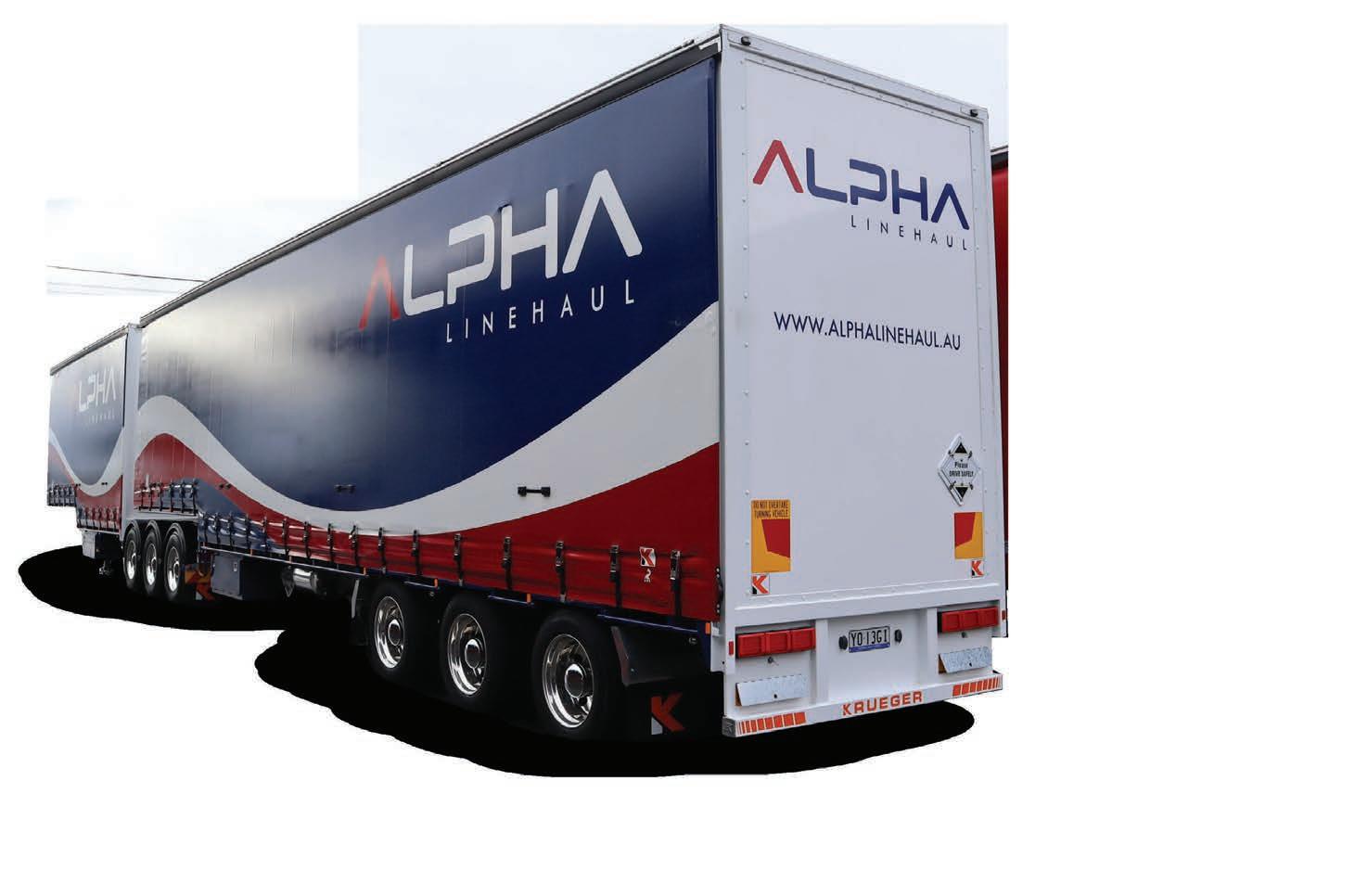
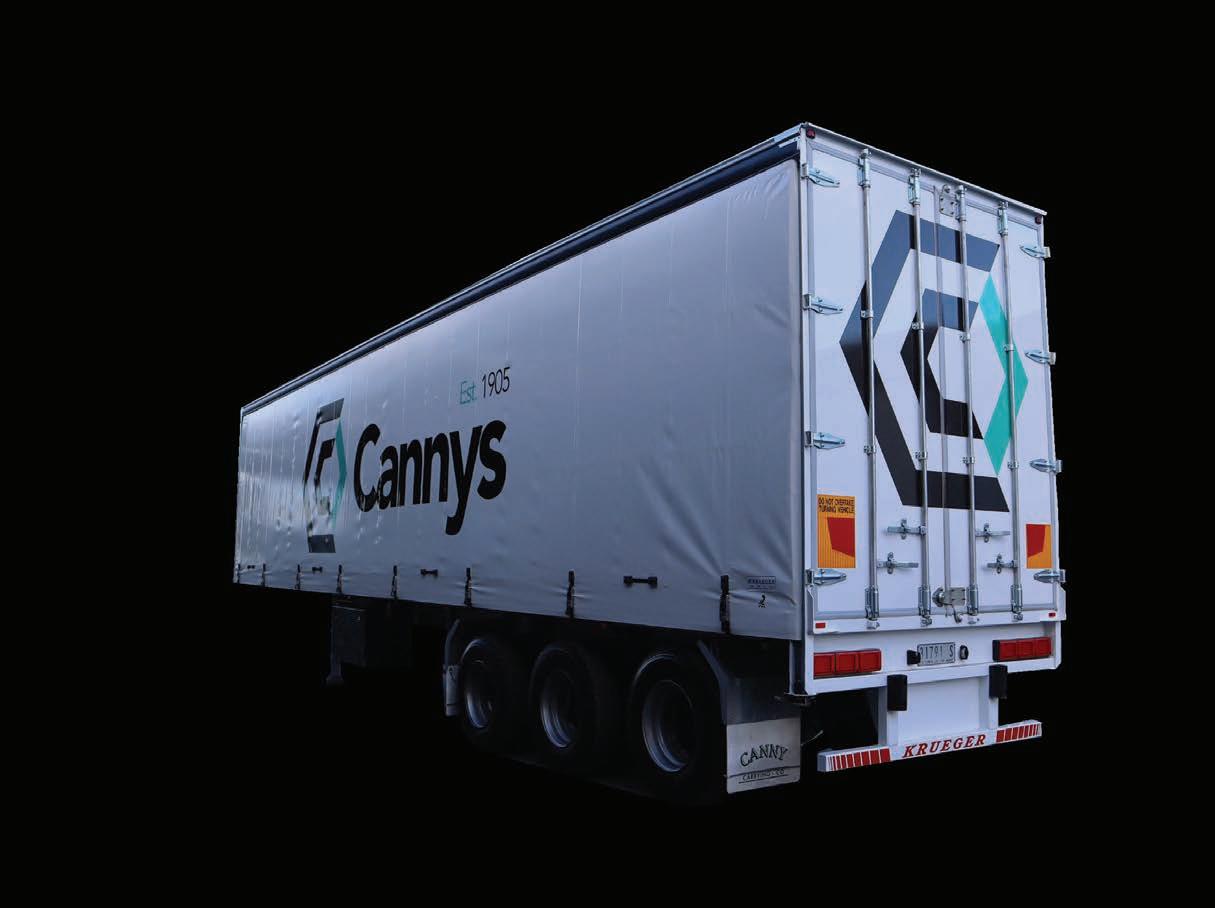

THE National Heavy Vehicle Regulator (NHVR) has released a rebranded and reformatted load restraint guide, aimed at enhancing its usability.
The Load Restraint Guide was transferred from the National Transport Commission (NTC) to the NHVR in 2021. The guide is being rebranded to reflect NHVR ownership and ensure it is clearly recognised as an NHVR publication.
The 2025 edition of the guide is the fourth edition, and the first to be authored by the NHVR.
Part of the Load Restraint Guide’s rebrand includes refreshing images and reformatting the guide to make it more user friendly; and correcting any known inconsistencies –this includes updating information on withdrawn Australian standards; and reflecting legal changes introduced by the 2018 Chain of Responsibility (CoR) amendments.
The Load Restraint Guide provides best practice load restraint systems to meet a broad range of loading requirements and standards.
Updates have also been made to reflect changes to equipment, advances in technology and load restraint equipment design.
This Load Restraint Guide provides helpful insights into:
• The process to follow when loading a vehicle and designing load restraint sys-
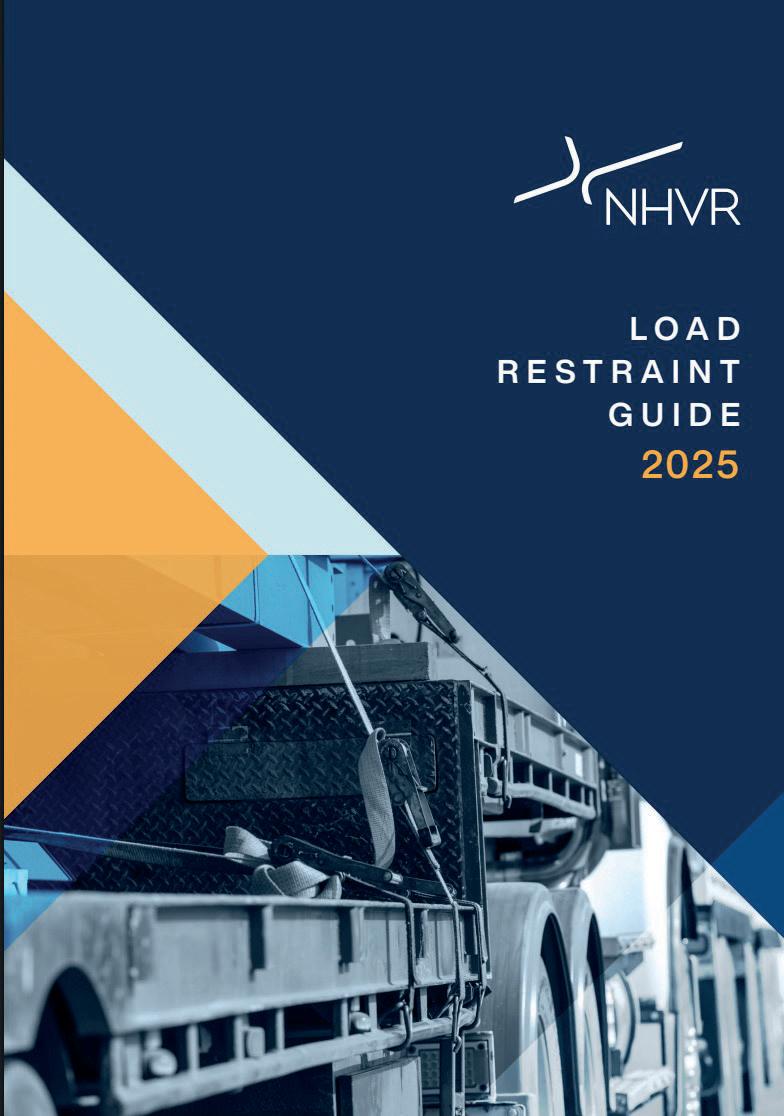
tems for common loading scenarios;
• Appropriate load restraint methods for different load types; and
• The engineering principles found in load restraint systems written using plain language.
As NHVR Manager Standards and Advice Peter Rouse explained, “The Load Re-
straint Guide is an important resource used across the heavy vehicle industry to support safe and compliant loading and load restraint practices.
“It includes technical information, detailed diagrams and worked examples to help determine the restraint required for heavy vehicle loads.”
Since the recent launch of the updated Load Restraint
Guide 2025, a review will also commence.
As Rouse explained, the purpose of the review is to ensure the Load Restraint Guide remains current and continues to reflect safe load restraint practices. “A review of the Load Restraint Guide has now commenced to ensure it continues to meet the needs of industry.”
For the review of the Load Restraint Guide, the NHVR has launched a discussion paper that will help assess the scope and direction of future updates of the guide. Its aim is to ensure the Load Restraint Guide continues to meet the needs of industry and reflects current loading technologies, equipment and practices.
The discussion paper is available at nhvr.gov.au/consultation/2025/09/12/loadrestraint-guide-review, with industry invited to provide feedback on the guide until Friday, September 12.
Feedback can be provided by emailing nhvr.regulatorystandards@nhvr.gov.au or using the feedback form found at nhvr.gov.au/consultation/2025/09/12/load-restraint-guide-review.
There is no required format for submissions, however the NHVR says that if your feedback includes attachments or is longer than three pages, a short summary of your key points should be included.
Rouse said the NHVR welcomes feedback from anyone
with an interest in the safe loading of heavy vehicles which includes operators, loaders, manufacturers and engineers.
“We are seeking feedback on the structure, layout and overall usability of the guide for different audiences,” said Rouse.
“The discussion paper will focus on improving how loading requirements and performance standards are explained and applied in the guide, which will ensure the next edition of the Load Restraint Guide is clearer, more practical and easier to use.
“The updated guide primarily had cosmetic changes, so industry can remain confident in using the 2018 version of the guide as it remains compliant.”
The review of the Load Re-
straint Guide builds on feedback received during the development of the 2018 third edition of the guide, authored by the NTC, as well as insights gathered through industry engagement, training activities and public enquiries to the NHVR.
It will also consider advancements in load restraint equipment and vehicle design since the 2018 edition.
The 2025 Load Restraint Guide can be purchased online at nhv.infoservices.com. au
* The Load Restraint Guide is an information guide only. It reflects best practice load restraint systems to meet loading requirements and loading performance standards and is not a legal document.
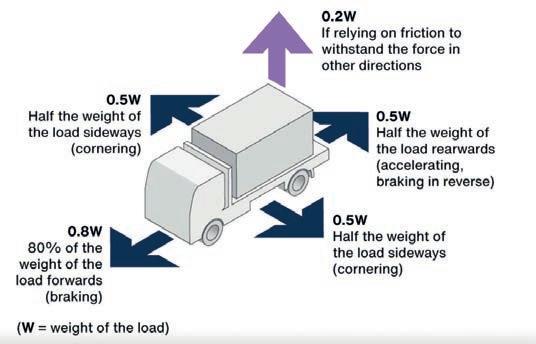
Loading performance standards set out the minimum amount of force a load restraint system must be able to withstand in each direction.
THE new load restraint guide includes detailed worked examples for a variety of load restraint cases, along with easy to follow steps and tips. By going through the common scenarios truckies are likely to encounter, you’ll have a better understanding of how to work out how much load restraint you’ll need for the load, said the NHVR. Below is just one of 12 case studies in the new guide.
Case 1: Tie-down restraint with webbing straps
Load: 3 rows of pallets blocked against a rated headboard (the front portion indicated in – Figure 487). Each pallet weighs 700kg. A row of pallets weights 1400 kg (2 pallets per row).
Vehicle: A prime mover and flat-tray semitrailer combination.
Equipment:
• Straps: 50mm webbing straps.
• Tensioner: truck winch (average pre-tension 300 kgf).
Choose a sensible load restraint method
What restraint methods may be suitable for my combination of load, vehicle and equipment ?
For this example, tie-down restraint is a suitable restraint method based on the load type, the vehicle and the equipment available:
• Check the load type. This is a load of pallets – see packs, pallets and stillages for more information on suitable restraint methods. See the loads module for information on other load types.
• Check how to use the equipment correctly. See the Vehicle and equipment module for more information
Can I block the load?
• Yes – this part of the load can be BLOCKED against the rated headboard (capable of withstanding 0.3 of the total load weight).
• Position the load against the headboard, or with a small gap (no more than 200 mm from the headboard).
• Block the load tightly so the sum of any gaps along the trailer (front to rear of the load) is less than 200 mm.
• A load is not regarded as blocked if it is greater than 200 mm away from the headboard or the cumulative amount of gaps along the trailer (front to rear) is greater than 200 mm.
Work out the numbers
What is the mass of the load?
• The mass of a row of pallets in 1400kg (2 pallets at 700kg each).
• Restrain each row separately.
• Simply restraining the front and rear rows WILL NOT pro-
vide adequate restraint to meet the Performance Standards.
• If you underestimate the mass, you are likely to put yourself and others at risk due to insufficient restraint. Double-check your calculations!
How much friction?
The load is timber pallets on a steel flat-tray truck. The friction level is MEDIUM.
• Friction levels within a load can vary. You need to design your tie-down restraint system for the lowest friction level. This is where the load is most likely to fail.
How many lashings do I need?
Easy option – use the tables. Recheck the following to make sure the calculation is correct:
• Lashing pre-tension amount: 300 kgf
• Blocking: BLOCKED
• Load weight: 1400kg
• Friction level: MEDIUM
For this example, assume a lashing angle greater than 60°. The table below outlines the number of lashings needed to restrain the load weight when using 50mm webbing straps with a lashing pre-tension of 300 kgf if the load is BLOCKED and has a MEDIUM level of friction.
Table note: Blocked load tables are based on a headboard capable
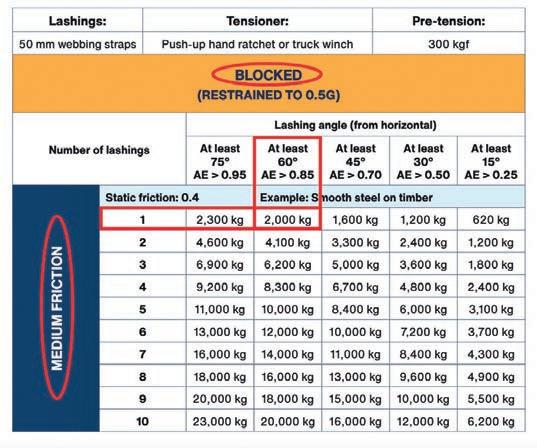
of withstanding forces from 0.3 g. If the headboard used provides less than 0.3 g forward restraint, use the unblocked table to calculate the number of lashings required.
Based on a lashing angle greater than 60°, when a load is BLOCKED and the friction level is MEDIUM, one 50mm webbing strap can restrain 2000 kg. The load weight 1400kg (per row of pallets) is under 2000kg. Therefore, one strap for a row of pallets is needed.
Tips:
• Block loads if possible. Unblocked loads will need a lot more lashings because the tiedowns need to resist the potential forward forces (equivalent to 80 per cent of the weight).
• Increasing friction levels can reduce the number of lashings needed. Friction can be increased using interlayer packaging or dunnage.
• Keep lashing angles greater than 60° wherever possible. The lower the lashing angle the less effective the tie-down lashing will be. Lashing angles can be increased by using dunnage.
For more load restraint case study examples, see the 2025 Load Restraint Guide or visit nhvr.gov.au/road-access/ loading/case-studies.

August 20–21
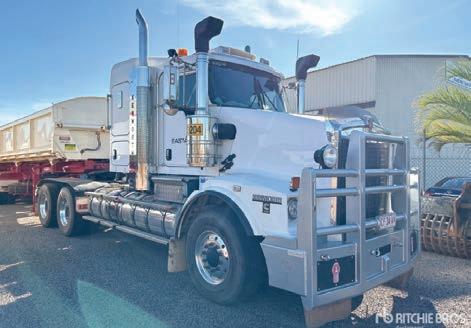
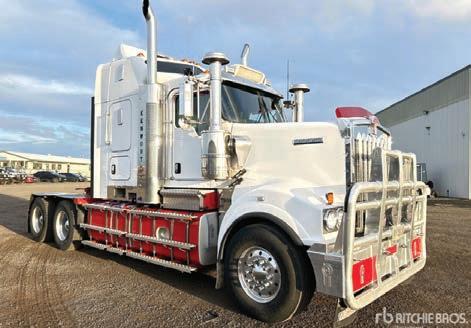
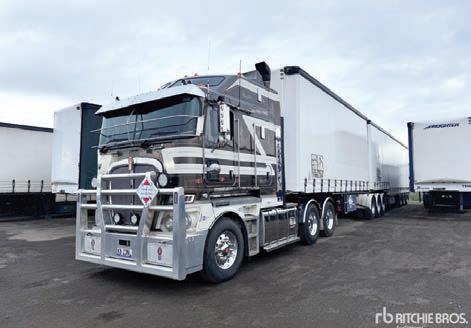
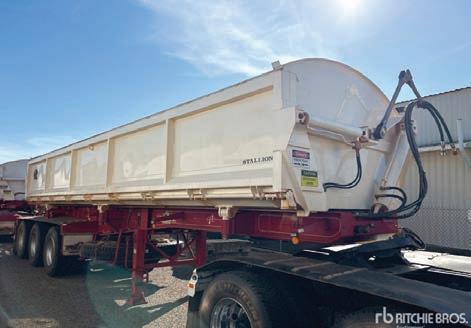



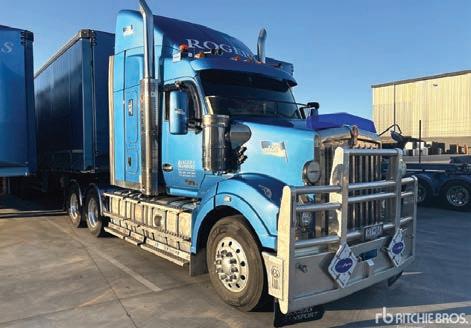
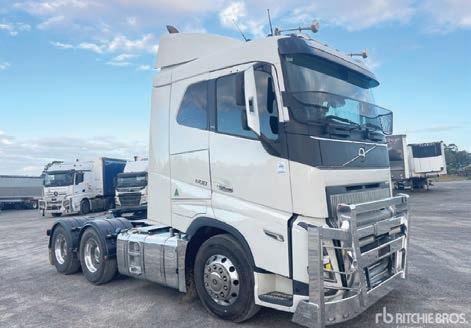

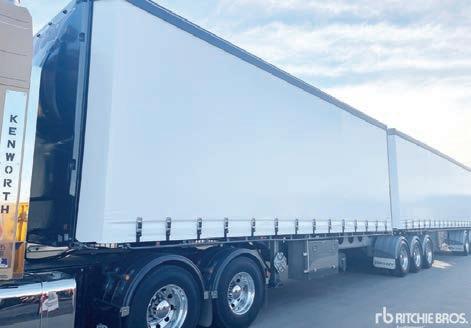
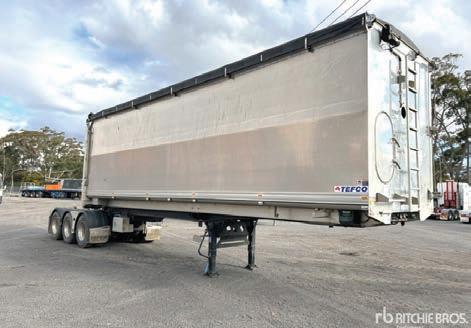
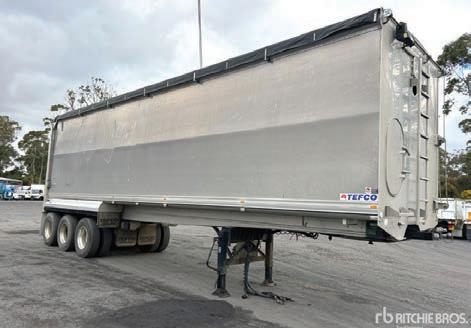

Centurion marks a major milestone in its sustainable freight journey by launching its second truck charging site powered by 100 per cent renewable energy.
BY DAVID MEREDITH
BIG Rigs recently met with Justin Cardaci, Centurion Transport’s CEO at the company’s Hazelmere depot in WA, under roofs covered with 9025 solar panels, linked to a renewable energy project that has transformed (no pun intended) the business’s local area freight collection service.
In 2023 with a view to building renewable assets for the company’s transport operations, Justin kicked off a project that promised to bring latest green energy technology into operations and sections of the truck fleet.
Hamish McHaffie is the boss of Corporate Affairs and Sustainability for Centurion’s parent, the CFC Group, and when Justin decided that electric truck and battery technology had reached a stage where deployment into Perth metro area work was feasible, the project fell within Hamish’s role.
From that, the project was developed to attract the support of the Australian Renewable Energy Agency (ARENA), along with BP Australia, Daimler Trucks, and locally, Switch Technologies and another CFC group outfit, Cape Dunstans.
The role of Dunstans in particular was significant. In 2019 the CFC group took a stake in the company, taking over completely in 2022.
Apart from project managing the installation, Dunstan’s expertise in horizontal drilling was going to play a crucial role in laying kilometres of cable at the Centurion depot without disturbing hardstand and disrupting ongoing operations.
The numbers reveal what is probably the largest 100 per cent in-house renewable energy installation in the southern hemisphere. Frankly, we have been unable to find another
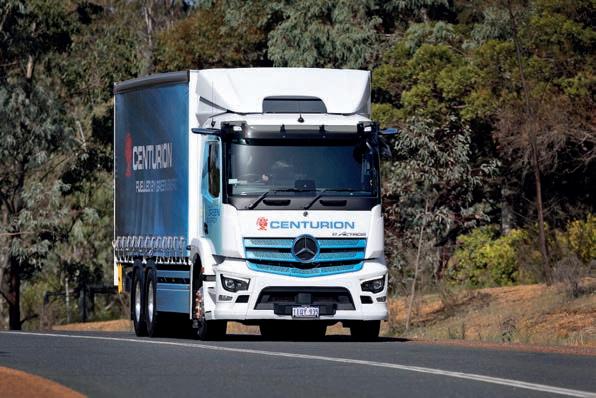
one like it anywhere in the world – at the moment.
In short, there are 10 dual low-capacity chargers drawing from 6-8mWh of batteries, which in turn are charged from a 2.2mWh solar array on the northern depot roof. At the southern depot are five dual high-capacity chargers – 3x75kWh and 2x150kWh – connected to the same size solar array but smaller 3.44 mWh battery storage.
The entire package is backed up by two 650kva HVA-fuelled generators.
During our visit Perth was covered in heavy cloud and the morning had delivered drenching rain. Despite this, by 3pm the array had topped up the battery packs to 70 per cent capacity.
Ralton Benn, the project manager from Cape Dunstans, said that the overnight charging was likely to draw the battery storage levels down to around 20 per cent.
Clearly the system has been designed to provide all the required energy throughout the year.
Ralton told us that in summer the batteries are fully charged by mid to late morning. Systems then start shutting down the inverters, as there is no grid connection to put power back into the Perth network.
The project was developed in two stages, the second of which has just been completed. The first 20 Mercedes-Benz e-Actros 300-series trucks are now at work handling day-time schedules and recharging overnight from the batteries. Another 10 e-Actros 300s were delivered the day of our visit. They will run the afternoon and night-time routes, with the high capacity charging stations topping up the trucks during the day directly from the solar array.
The trucks are all built on
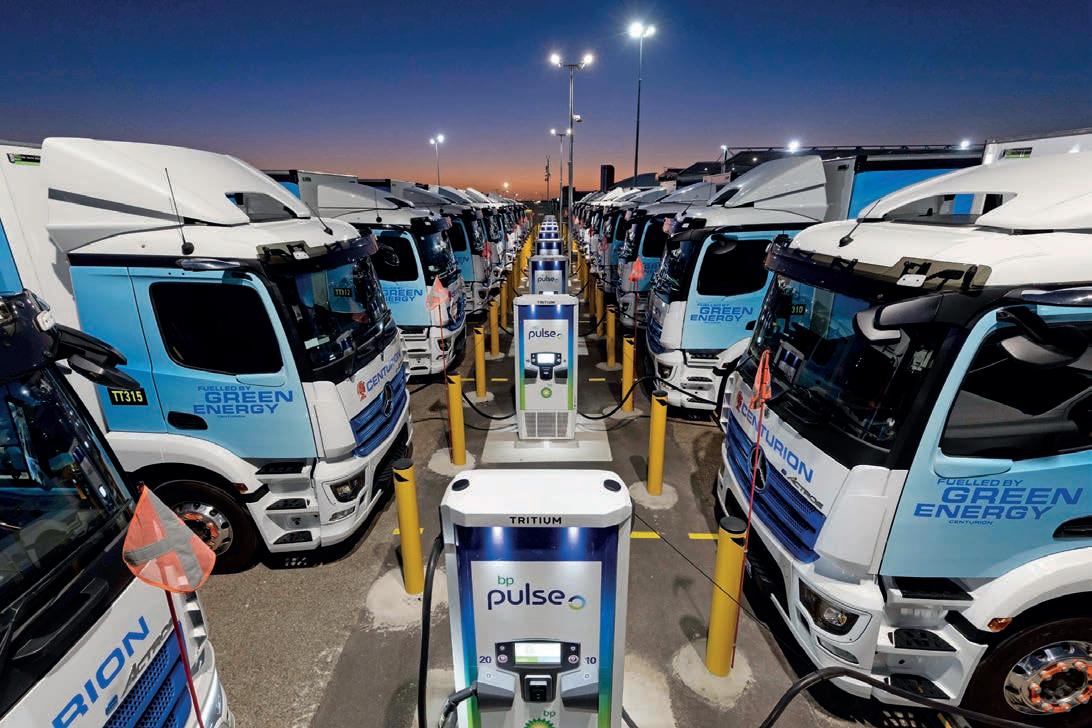
the e-Actros 300 series platform, which houses three lithium-ion battery packs with a total of 336kWh capacity, delivering 443hp continuous output and 536hp at peak.
Regenerative braking provides the majority of the braking effort through the driveline, which is a fairly standard electric vehicle feature.
What is not standard is a Benz system on the prime movers called High Power Brake Resistor, or HPR.
Unlike conventional regenerative braking on cars, which fades away to nothing when the battery is full, HPR directs excess energy to resistors on the back of the cab where it dissipates as heat, keeping a constant level of retardation when off throttle.
The driveline is Benz’s proprietary two-speed e-axle, which eliminates the need for a driveshaft. Twenty-five of the trucks are rigid chassis, split 20 x 6x2 and 5 x 4x2, with the remaining five configured as prime movers. Three of the tray tops have electrically powered tailgate lifts.
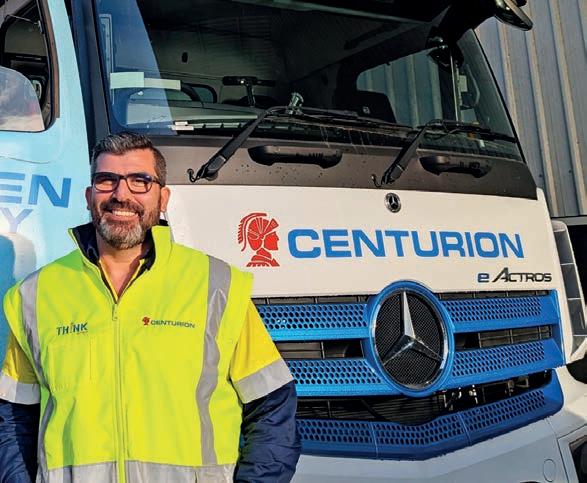
300km for the rigid versions,
and over 200km for the prime movers. Route planning and logistics at the Centurion depot will tailor the duty cycles to keep the trucks within those limits.
To assist with range, Centurion has limited the maximum speed of the trucks to 85km/h. Naturally, diesel powered trucks are also onfleet to plug any shortfalls.
Overall, it’s a $32m initial investment to which ARENA contributed $15.8m. The Centurion investment includes the capital costs of the trucks themselves – there was no intention of leasing.
Hamish told us that the company has hired new drivers exclusively for the new fleet and is hopeful that the experience will generate interest among the overall driver roster for future electric operations.
The e-Actros driving experience, along with its host of digital driver assistance and safety features is expected to attract a younger and more diverse driver group, potentially of people on their first
developed on-site. Depot staff have been trained to manage near-silent truck movements from the fleet, and depot emergency personnel are wellversed in the special requirements for handling accident and recovery events with dangerously live high-voltage cabling on board.
Centurion’s broad group activity has developed strong ties to major suppliers.
The truck fleet, which is over 1000 trucks across its operations is heavily skewed towards Daimler Trucks, through its Mercedes-Benz and Freightliner brands.
Diesel fuel consumption is a significant component of any large transport business, and Centurion’s size and scope amounts to an eye-watering figure (rumoured to be over $80m per annum), so it’s no wonder it turned to BP for its “Pulse” charging systems to keep the electric fleet on the go.
The on-ground battery packs were designed and assembled by a WA group, Switch Technologies, and their team is minutes away from the Centurion depot -

tions to operations.
Centurion’s biggest activity is its road train operation throughout WA and “across the top,” but as Justin Cardaci noted: “For most of our operations, zero emissions technology for heavy transport won’t be ready for several years. However, battery electric trucks are now ready for operations across the wider metropolitan area and it’s great that Centurion has the capacity to bring this technology into our fleet.
“Operating a real zero emissions truck fleet from off grid solar and battery is a significant step in supporting the energy transition.”
In reality, there wouldn’t be 30 Mercedes-Benz eActros working at Centurion without this renewable energy project coming on stream. The local grid simply hasn’t got the juice without extensive infrastructure additions, including transformers etc, and possibly expansion of power to the suburb. Additionally, the approval process for those changes would be likely to have taken 12-24 months, assuming no hiccups along the way. This project is a real-time test of the competitiveness of electric trucks within commercial imperatives.
With an initial cost nearly three times the cost of an equivalent diesel truck, and nearly 30 per cent higher tare weight, the appeal of an electric truck to the industry broadly is limited to its emissions and renewable energy credentials.
Centurion’s early recognition that an electric driveline powered by renewables is the future, represents a major and pioneering step which seems likely to narrow the existing affordability gap.
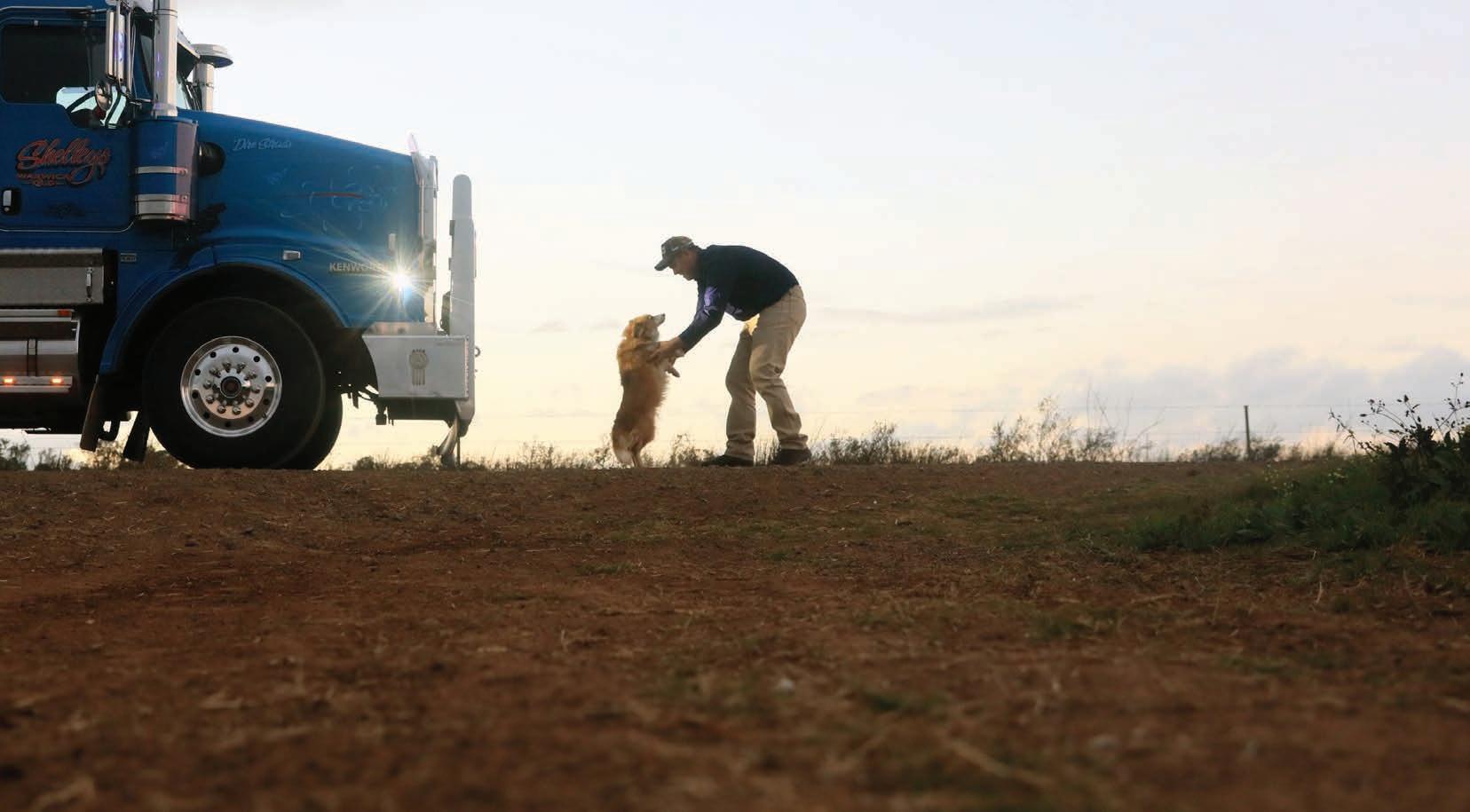

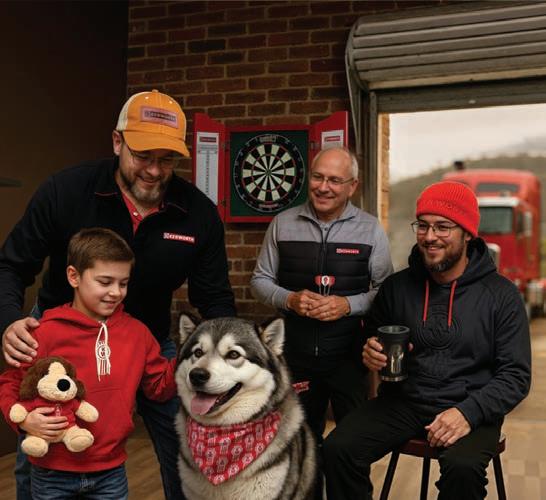
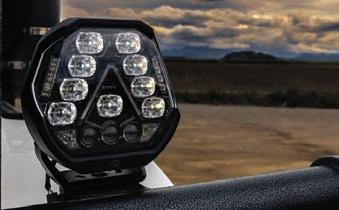

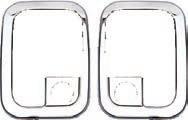
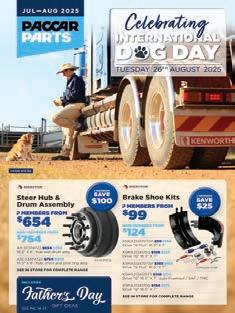
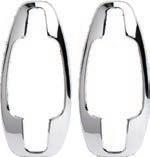

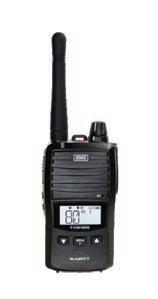
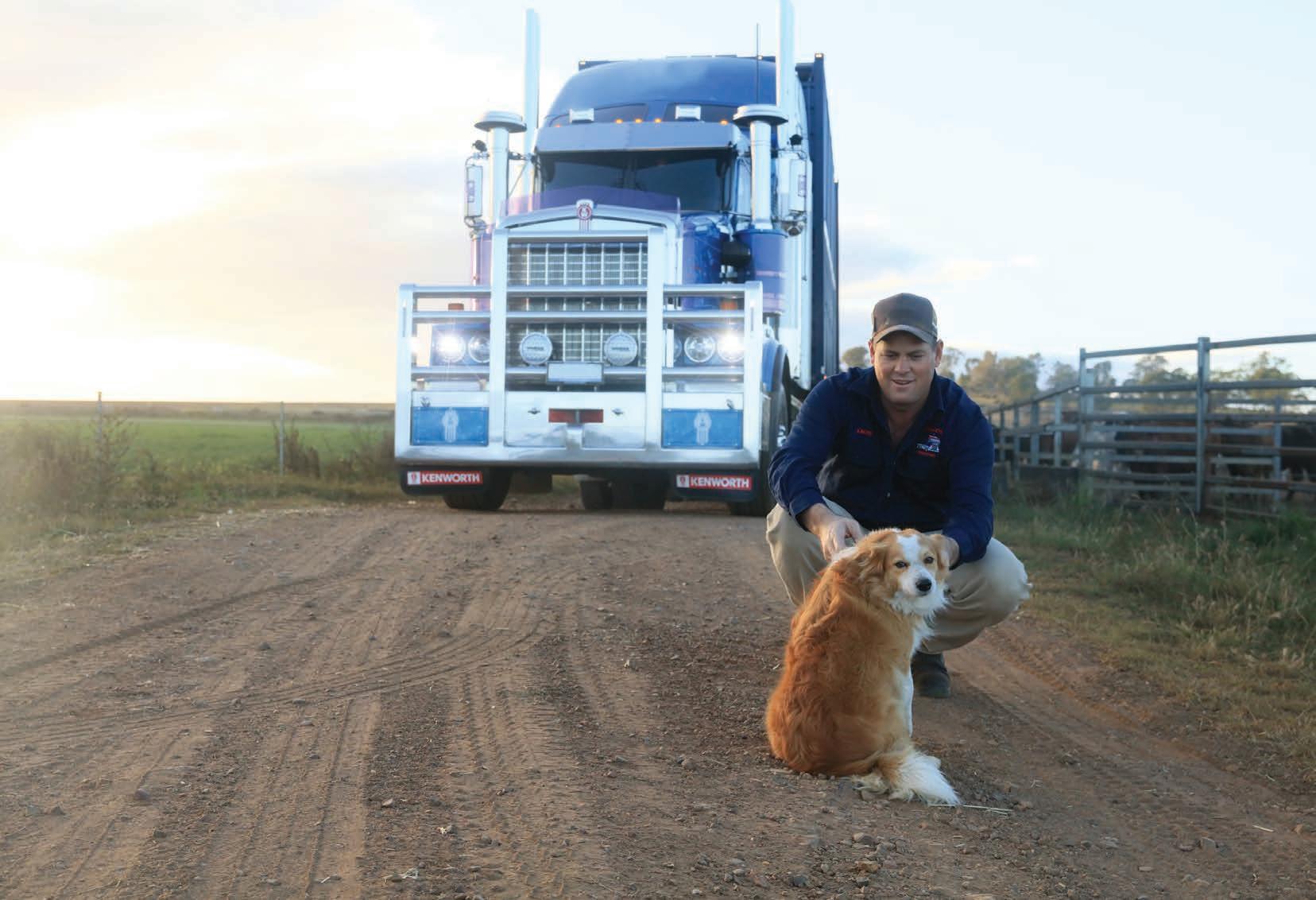
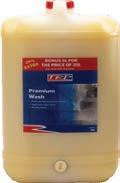
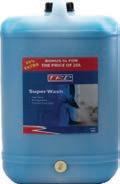
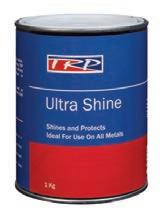

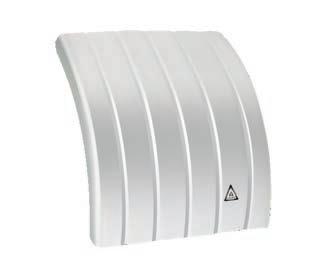
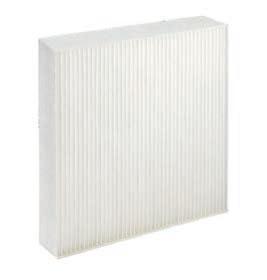
At 80 years of age, this veteran truck driver has spent a lifetime on the road and has no plans of slowing down.
BY DANIELLE GULLACI
BACK in 1971, after serving in the army, Phil Thompson – who turned 80 earlier this year – applied for a job as a truck driver at Russell Transport. That was 54 years ago and he’s never looked back.
While many people his age are well into their retirement, Phil is still showing up for work between 5-5.30am every day and giving it his all. Phil’s current role at the company sees him behind the wheel of an Isuzu heavy rigid, doing multi-drop steel deliveries in and around Brisbane.
Speaking with Phil, it’s pretty obvious he doesn’t do things by halves.
He’s also an avid race walker, usually completing 20 kilometres at least three times a week, and competing on most weekends too. It’s a sport he’s taken part in since 1980. Phil’s competed in the Australian and Queensland championships and the World Masters.
“My kids were in little athletics and they were all whinging that they had to do it and we didn’t, so some of the parents started race walking and a few of us became quite good at it,” Phil recalled.
In his younger years, Phil was also on the rodeo circuit, competing across Australia and New Zealand.
Asked what sparked his career in trucking, Phil explained, “I come from Tamworth and grew up on a lucerne farm. We had a truck on the farm and I basically taught myself how to drive it.”
Phil was in the army during his early 20s and then made the move up to Brisbane. When he got there, Phil applied for just one job and he’s never left.
“I was talking to a fella who knew Phil Russell at Russell Transport. He recommended me to him, so I fronted up and all these years later, I’m still here,” Phil said.
“If you’ve got a good job, stick to it. Over the years –even now at my age – I’ve been offered jobs at other companies, but I’m happy here. I’m a happy go lucky sort of fella. I like being here and the people are great.
“I do different loads every day, it’s always different and you go to different places. I’ve had some really good managers over the years. They’re people that really look after you.
“I have a good reputation with customers too. I’ve never done anything wrong by the customers, I’m always cordial and I always talk to them.”
Phil has become the longest serving driver in Russell Transport’s 100-year history – and the oldest too.
“A lot has changed since I started at the company. I’ve seen a lot of things come and go,” said Phil.
But perhaps the biggest change is how much the
company has grown. “There’s been a lot of growth, a lot of new trucks, a lot of new peo ple,” said Phil. “They only had a few trucks when I started and look at it now.”
Today the Russell Transport fleet includes around 200 trucks and 350 trailers.
Phil says he started out in an International Acco. It was a prime mover that had been converted into a rigid, used to cart wool bales from New stead to the port. “That was a very tough job,” said Phil, as he recalled the time things didn’t quite go to plan for a fellow driver.
“There was a funny occa sion where another fella who was carting with me didn’t tie down the bales properly. He left before me and was dropping bales all the way through, then I came along and saw them on the road. They had to send trucks and cranes out to pick them up again!”
From wool bales to refriger ated transport, and fuel tank ers to steel deliveries, Phil has taken on various driving roles throughout his time at Russell Transport. “It’s a been a jour ney and there’s been a lot of variety,” he said.
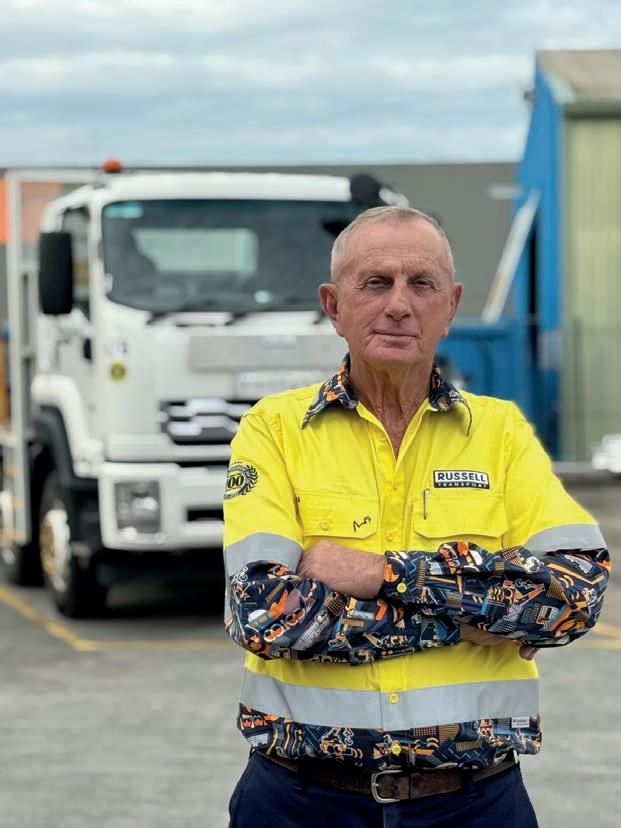
“I’ve been doing the steel deliveries now for close to 20 years. I go as far as Hervey Bay, Mooloolaba and sometimes into Toowoomba.
“I like to get out of town a little bit. But it doesn’t matter what they throw at me, I enjoy it.”
As Phil explained, “When I turned 65, they asked me what I wanted to do and I said I wanted to keep going – I like working and don’t want to be at home doing nothing. I said I wanted a body truck without a crane on it, so I’ve kept doing that since then.
“They’ll load the truck overnight and then in the morning we come up and restrain the load. The loads are checked and then off we go.
“I do about 10-13 drops in a day. It’s not an easy job, but if I couldn’t do it, I definitely wouldn’t do it. I pass the medicals and everything like that so I just want to keep going as long as I can. And I think Russell Transport is pretty happy for me to be here too.”
Asked about the ‘R’ word, Phil admits he had thought about it, but the thought was only fleeting. “When I got to 65 I thought about retirement. My wife is still working. She’s a school teacher. So why would I stay home while she’s at work?
“The other reason I keep going is because it’s hard to give up. I see a lot of drivers stop work and within a few years, they’ve passed away. If I’m going to kick the bucket, I just want to keep doing what I’m doing – and to keep enjoying it.”
And with his many decades of knowledge and experience, who better to help train up young drivers coming into the
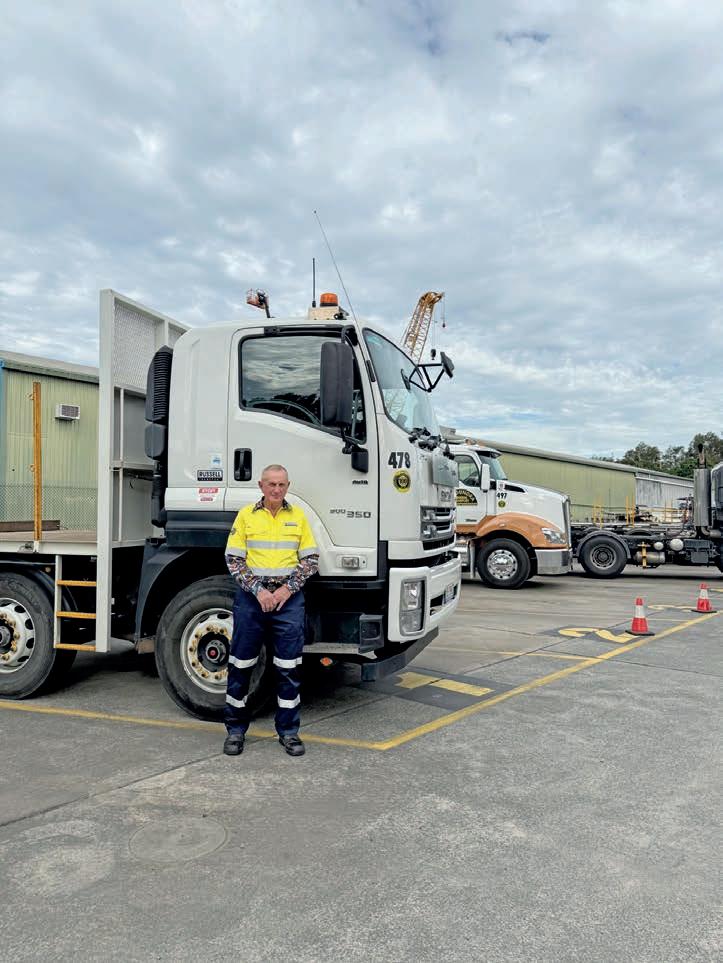
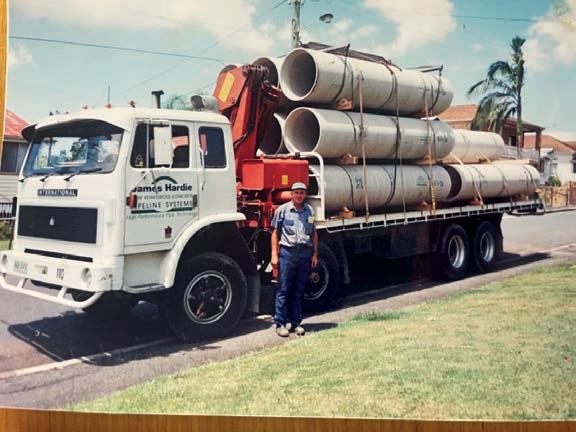
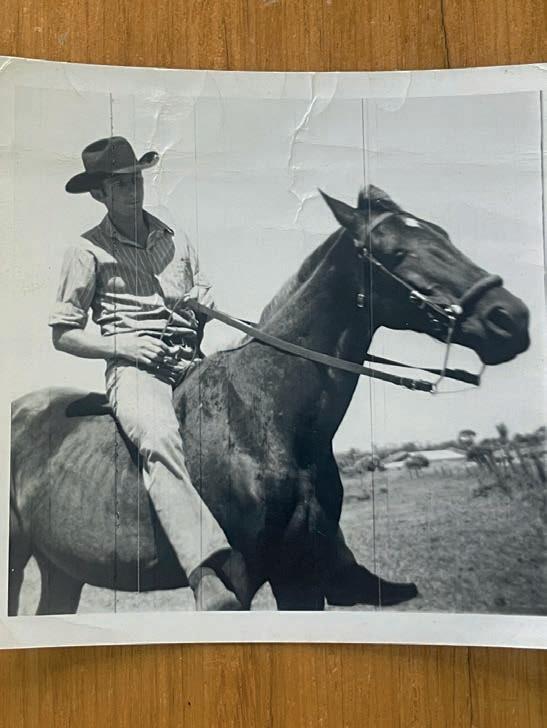
about load restraint – and most of them are still here, so I must be doing something
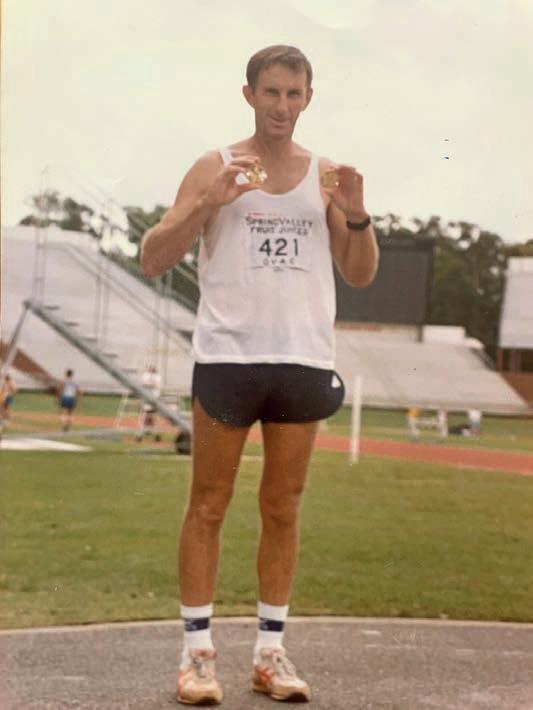
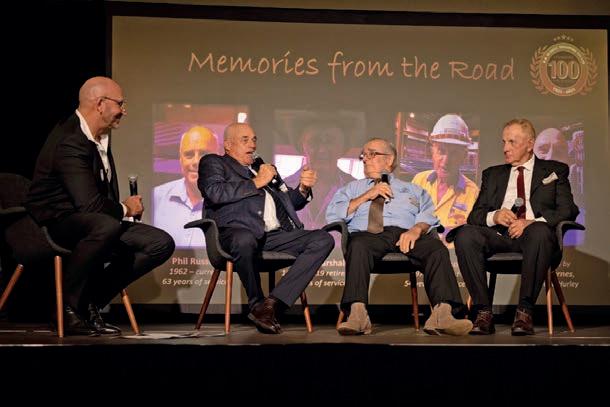
fellas, and a young lady I’m training up too. I show them how the company wants things to be done.”
Asked about what he enjoys most about working for Russell Transport, Phil replied, “The best part of my job is all the good people working here, from the top, right down. I always try and treat everybody as a friend.
“Even at my age, I’ll always get out there and have a go. If anyone says anything, I tell them they’re going to get there too one day. No one is pushing me to retire – and I won’t be leaving until I’m ready to leave.”

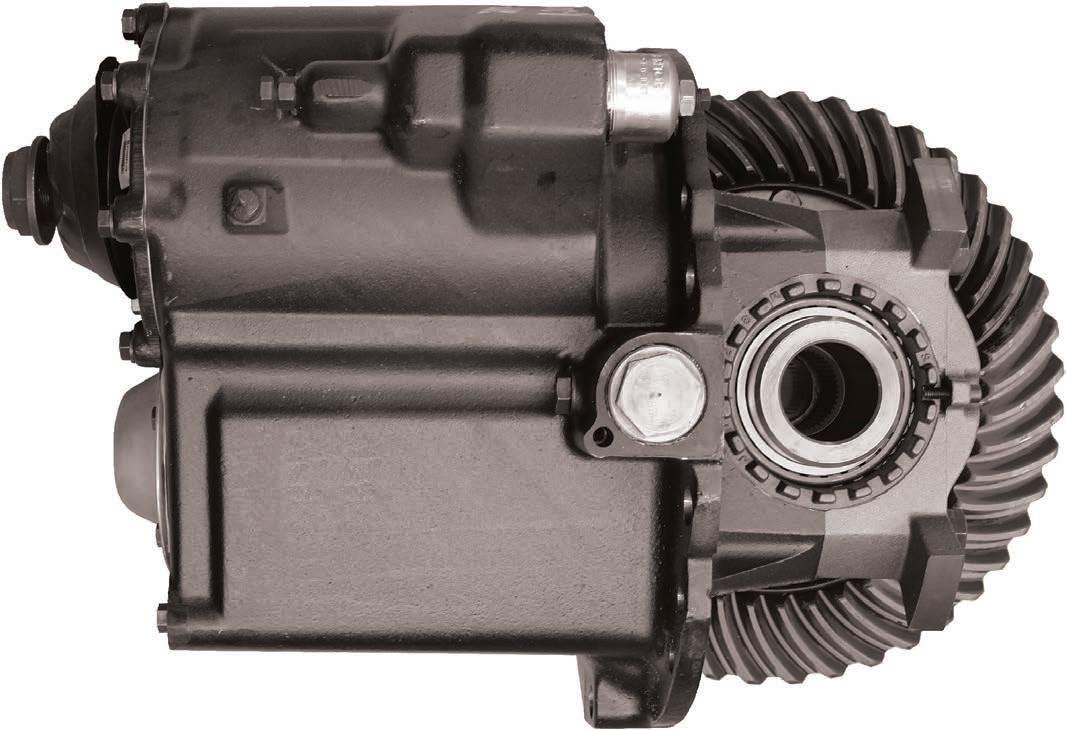

This company’s proud 115-year journey - from horses and carts to a fleet of hard-working Kenworths - is winding up as its owner gets ready to retire.
BY JAMES GRAHAM
AFTER 115 years of service to customers across Victoria, New South Wales, and beyond, Corowa-based Francis Transport is preparing to close its doors this month.
The final deliveries are scheduled for August 15, with a handful of staff staying on to help third-generation owner Mark Francis tie up the loose ends and ready the distinctive red and white fleet for auction.
Mark, who is busy finalising his last delivery commitments when Big Rigs calls, is quick to stress the bittersweet decision to bring the curtain down may be a sad one in many ways, but it’s entirely by choice.
“It’s been some time com ing,” Mark tells counts down the final days until retirement.
“I’m 68 and it was time to reinvest in a lot of plant and equipment, or not, and I’m pretty tired and worn out now – I can’t imagine what I’d be like in five or six years if I stayed on.”
Francis Transport was start ed by Mark’s grandfather Arthur (snr) in 1910 when he would haul beer kegs and other freight by horse and cart throughout the Rutherglen district of Victoria.
Later he carted wine from the district wineries to the railhead at Rutherglen using a TT Model Ford, one of the first trucks in the region.
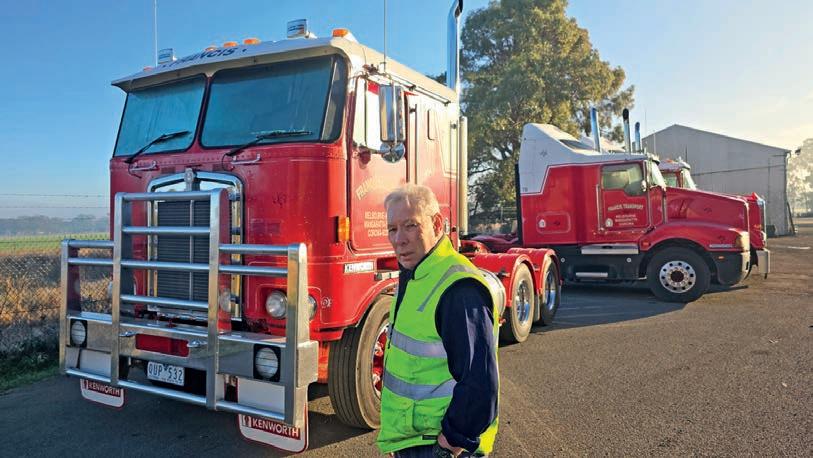
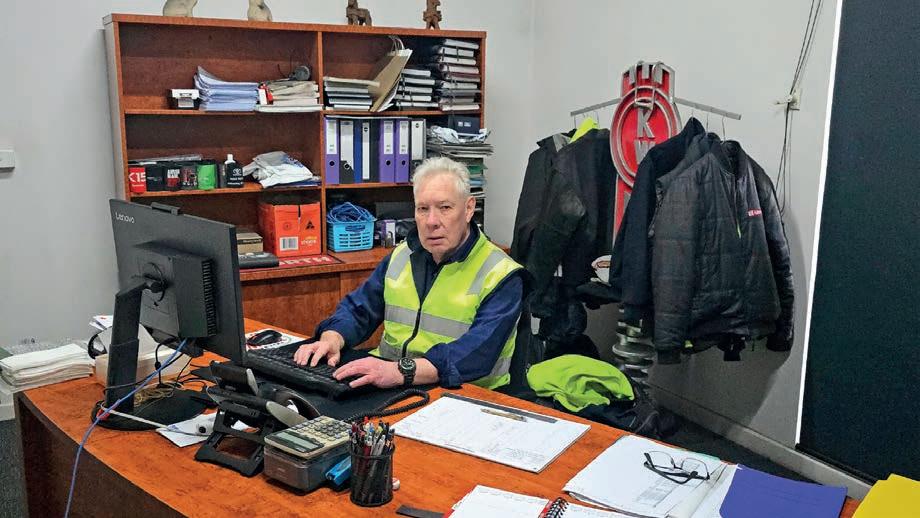
Photos of those early pioneering days hold pride of place in Mark’s busy Corowa office, alongside those of his late father Arthur (Pod) and uncle Leonard (Hec) who took over the reins in 1953.
Both Pod and Hec were inducted into the Shell Rimula Wall of Fame in Alice Springs in 2002 and were celebrated for their reputation for caring deeply for their employees and families, who returned the sentiment with steadfast loyalty.
Mark became hands-on at Francis Transport in 2008 after answering his father’s call for help when uncle Hec decided to retire.
“My father wanted to stay for the employees and customers, so he and I brought out Hec,” said Mark who was chief financial officer for pharmaceutical giant Sanofi in the Philippines at the time.
down after working long hours and being on airplanes every two weeks flying all over the place.
Pod passed away in 2020, aged 93, after bowing out of the day-to-day operations in 2015.
After taking a break from his old role, Mark, however, soon found his stride running the show, ably assisted by brother Ray who managed the Melbourne depot in Derrimut.
At its peak, Francis Transport was a regional powerhouse, a testament to the family’s grit and never-say-die attitude through two world wars, the Great Depression, recessions, a global financial crisis and countless other industry upheavals that finish off less resilient operations.
Today, there are around 80 vehicles flying the Francis flag, including 23 prime movers and some 32 trailers and 12 rigids, spread across three
in Sydney.
Multi-national clients include Nestle and the contract to cart its Uncle Tobys cereal products, in and out of the nearby factory in Wahgunyah.
Others in the diverse portfolio include James Hardie out of Sydney and Melbourne, Visy in Sydney, Elders Wool, Nutrien Wool and Fox and Lillie Rural.
“So, it’s varied,” Mark explained. “We go out to farms to pick up wool, we freight transformers for Wilson Transformers daily on flat tops as well as rigids.
“Flat-top work throughout Victoria as well as rigid work to Sydney along with other rural locations.
“And beer, of course, which we’ve been doing since the start.
“It’s only a small part of the business but that’s how it all started back in 1910 out of the Rutherglen station delivering
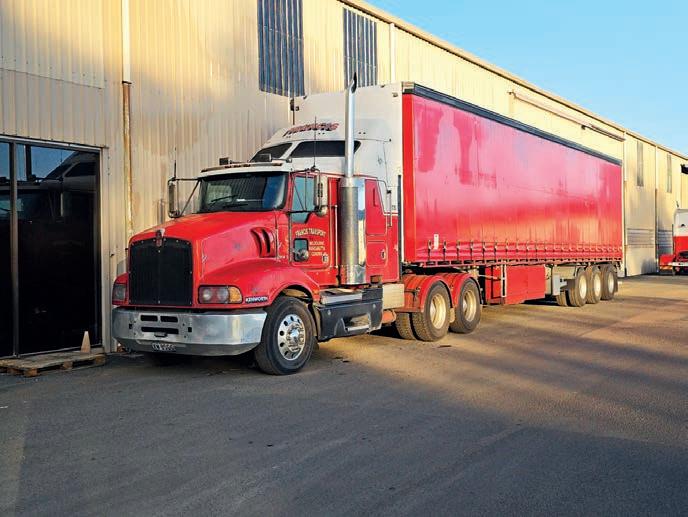
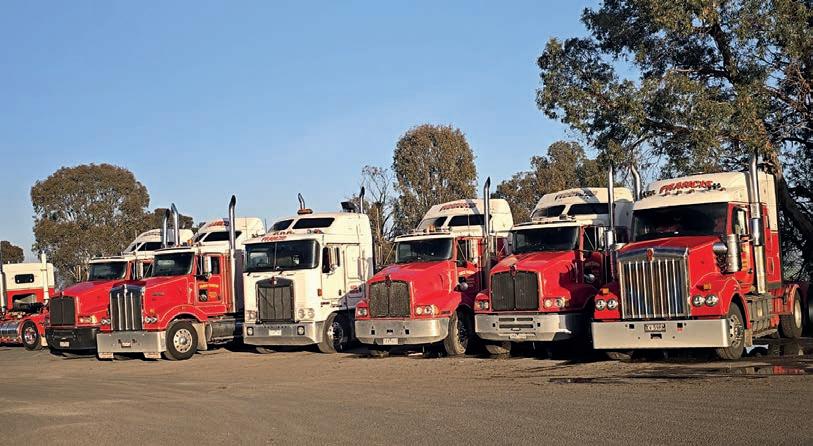
“We [still] do wineries up here as well.”
Francis Transport boasts around 30 staff, with administration and mechanical all in Corowa, two others in Wangaratta and three in Melbourne, including Mark’s brother.
“A lot of the guys have got jobs pretty much lined up already,” Mark said.
Mark said consideration was given to selling the business as a going concern, but in the end, shutting the operation was the logical, less complicated call.
“If I was buying a company nowadays, I wouldn’t buy the company, I’d buy the assets,” Mark said.
“The contracts aren’t worth a pinch of salt anymore because there are usually clauses in there that make it easy for people to just walk away from so they’re not worth anything.”

Seventeen years at the helm has also given Mark a front-row seat to the changes
sweeping through transport.
“It doesn’t get easier – it gets trickier each year,” he admits.
“Everyone’s just trying to do the right thing, but it gets more and more complicated.
“If you’re running operations, you’re not just organising trucks, you’re organising compliance, you’re checking everything’s running properly, all of these things now.”
Mark said most of his drivers are “pretty good” mechanically and can usually get the truck going if something is wrong.
“But I’m not sure that’s necessarily happening with a lot of people.
“So, compliance is just so huge, and it’s growing and growing, which is becoming more time consuming and obviously more expensive as well – there’s not a lot of fun in that part of it.
“Everyone’s been trying to get Australia-wide rules but it’s probably never going to happen because they’ve been trying and trying but people
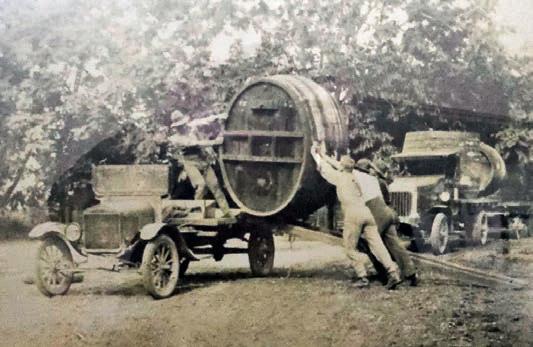
have been busting their heads trying to do it.”
Still, Mark has hope for the industry and is confident there is still money to be made.
“Freight is still moving in Australia, so it’s still working – it’s just getting harder.” Meanwhile, as he does his best to find alternative solutions for his customers after the final runs on August 15, Mark pauses to reflect on what made Francis Transport so successful for so long.
“I don’t know if we’re that special, but we just try and work with the customers and do a good job – we get on pretty well with them,” Mark said.
“We’re here to help and support people and we thank everyone for their loyalty to us, and we tried to provide loyalty to them as far as possible and provide a quality service.”
While he won’t miss the 3.45am starts and going to bed at 7pm so he can “do it all again”, Mark confesses that he will miss the people when he does finally drive out the depot gates on the banks of the Murray River for the last time.
“We had a very low turnover. We had a mechanic leave about a year ago and I think that’s about the only person that we’ve put on in the last year.
“We’ve got a lot of guys that have been here 20-plus, 30plus years.
“The employees are terrific people.”
































































































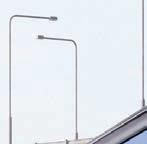













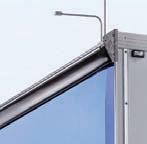


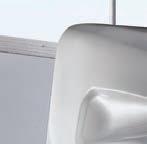
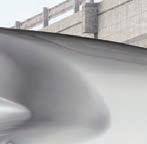







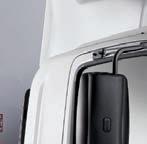
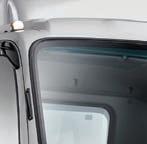



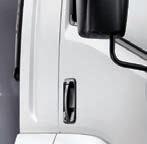
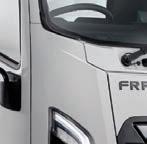



















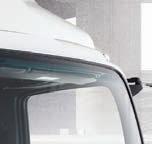
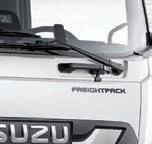
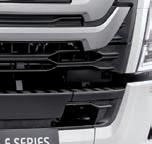


















































To find out more, visit your nearest Isuzu Trucks Dealer or visit isuzu.com.au







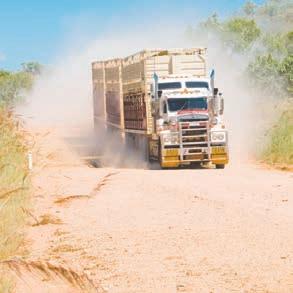

Averaging around 9000 kilometres a week, this husband and wife team enjoy life on the road, pulling triple road trains across Western Australia.
BY DANIELLE GULLACI
BOTH Bente and Shane Andrew had been in heavy vehicles long before they even met, so the decision to give two-up a go made perfect sense.
With the huge distances they travel, it’s a huge amount of hours spent on the road, however as Bente explained, “Doing this together makes the time away from home a lot easier – it makes a big difference.
“It works well being together on the road. And if you have a disagreement, you just say I’m going in the bunk, see you in five hours!” she joked.
“We don’t have kids, just our cats and a dog at home and we have a great neighbour who looks after them while we’re away, so that makes it a lot easier.”
Based in Perth, the couple began working for Centurion six years ago, hauling general
Wednesday night, travelling the length and breadth of the state, often with deliveries for Wubin, Newman, Broome and Kununurra – arriving home on a Monday morning, if all goes to plan.
Originally from Norway, Bente, now 68, moved to Sydney in 1983. She had worked as a bus driver back home and continued that after she arrived down under.
A fter around 20 years of driving buses, Bente was ready for a change, so she decided to switch to trucks, and that’s how she met Shane.
“I went out in a friend’s truck in Sydney one day and he let me drive. I thought this is fun, so decided I wanted to switch to trucks,” explained Bente.
“I met Shane while he was working at his brother’s nursery as a truck driver, carrying plants around Sydney and into Melbourne. I was sick of driving buses so I started working

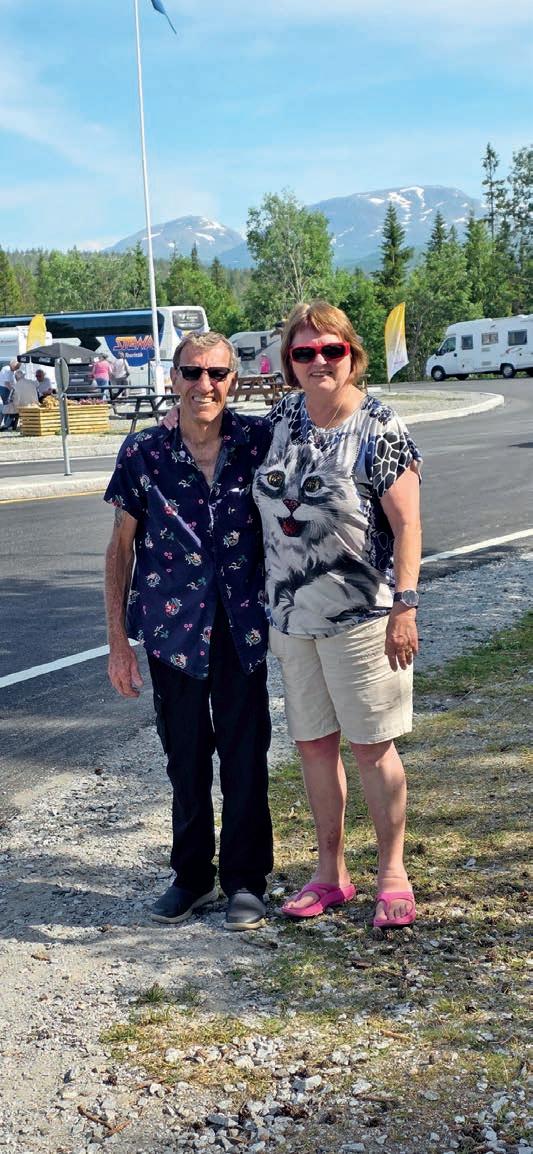
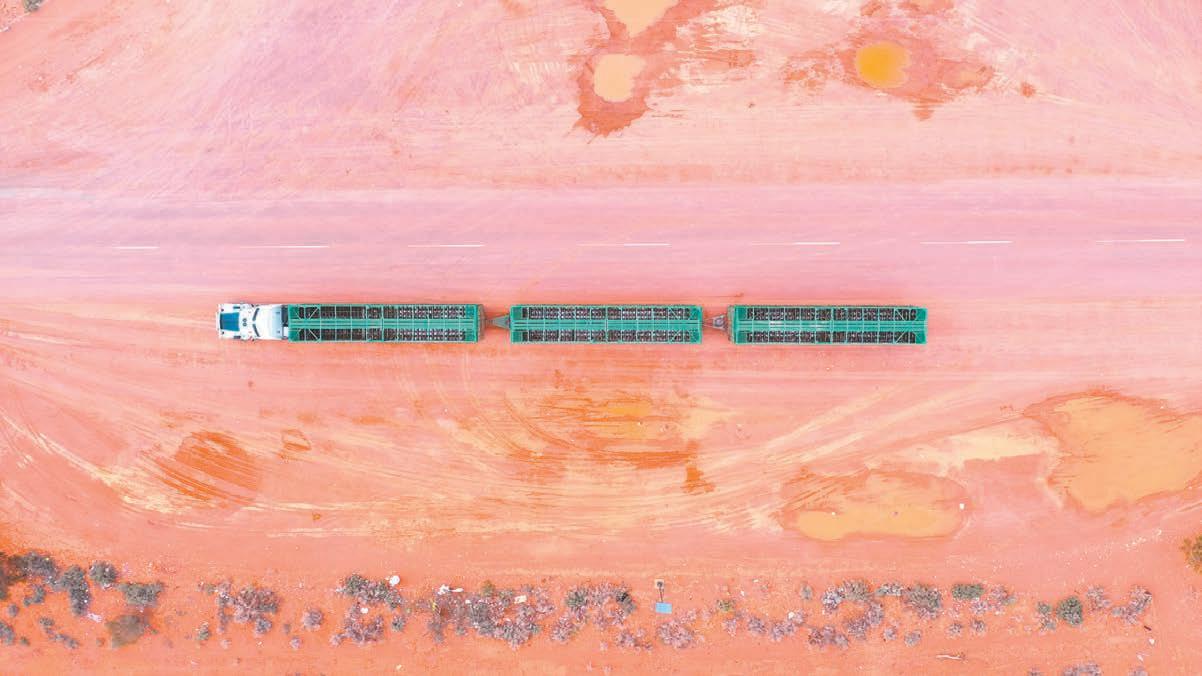
ful. In the truck, you can listen to your music or podcasts.”
Shane, 66, has been driving trucks for over 40 years now.
“He grew up in nurseries, so they always had trucks in the family,” added Bente.
The couple has been married for 16 years now and have made their life an adventure.
After leaving the nursery, they both found work with another Sydney company doing general freight. That company needed B-double drivers so Bente and Shane both upgraded to their MC.
“We had done a little bit of two-up driving when we worked for Shane’s brother, so we decided to move to Perth in 2005 to do two-up work in the west,” said Bente.
“We didn’t have anything keeping us in Sydney, so we packed up our animals – three horses and a dog – and moved across to Perth. That’s when we got into road trains.”
Their first job in Perth was doing B-double runs from Perth to Sydney. They eventually began working for Regal Transport and were there for almost 13 years. When Regal Transport was acquired by Centurion in 2019, Bente and Shane moved across to Centurion.
They were handed the keys to a brand new Kenworth T610 SAR in May 2024 and in just over a year, it already has over 450,000 kilometres on the clock. Doing around 9000 kilometres a week, it adds up quickly!
Typically, they’re in a new truck every two to three years.
“Because of the distances we do, once the trucks get to a certain amount of kilometres, they come off the two-up runs and are given to single truck operators,” said Shane.
Bente says her favourite spot to travel through is the Kimberley. “It’s beautiful going through the Kimberley – it’s really pretty up there.”
Bente added that they don’t
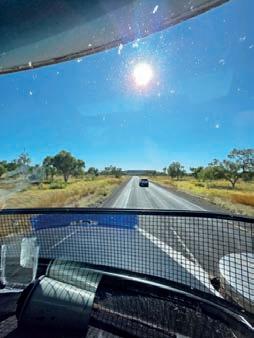
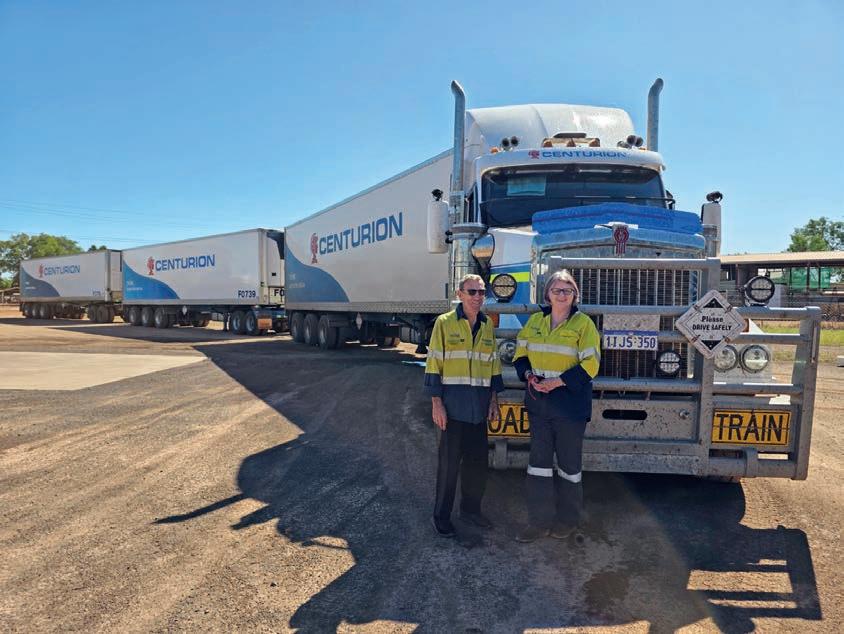
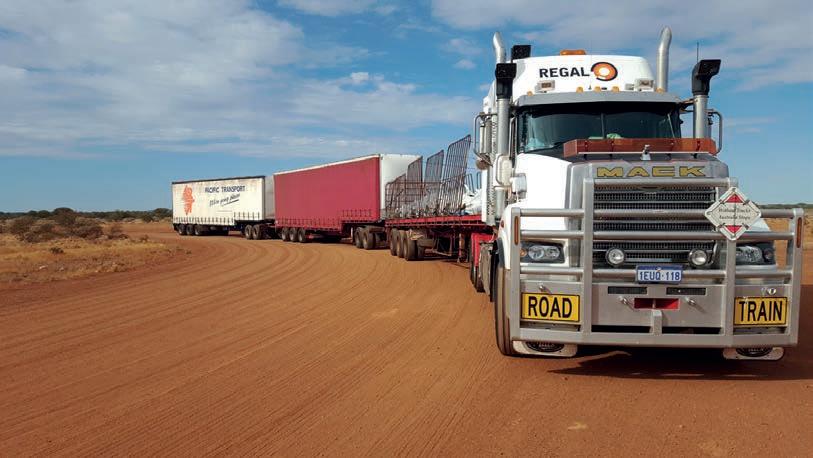
often stop at roadhouses, instead choosing to bring everything they need with them. “We cook up everything at home. We have two fridges in the truck so we carry everything we need. You get so used to knowing exactly what you need to have with you for the time that you’re away on the road.”
Asked about the roughest roads they travel, Shane said, “It’s especially rough when you leave Halls Creek, between there pretty much nearly into Warmun. It’s so narrow for about 30 kilometres before you get into Warmun. And then about 30-40 kilometres on the other side of Warmun, there’s barely enough room to pass
each other. And it’s all triples going along that way. There are also cows and horses on the road, so you need to be careful.”
Bente added, “It’s rough into Fitzroy Crossing too. Back in 2023, when the bridge in Fitzroy Crossing went down, we had to go up through the middle for a few months.
That was interesting going up through Alice, it added at least another day.
“From Mount Magnet through to Newman it’s better now that they’ve widened the roads.”
Though they both enjoy the role, Bente admitted that retirement could be on the cards in the near future. “I think we’re looking to retire
DOING THIS TOGETHER MAKES THE TIME AWAY FROM HOME A LOT EASIER – IT MAKES A BIG DIFFERENCE.”
BENTE ANDREW
next year but we’ll see what happens. We might still do it part time though. I think it would be really hard to give it up altogether. It’s always nice to have time off, but then when you have time off, you quickly get bored!
“It’s always so quiet when we get home because we’re so used to all the noise.”
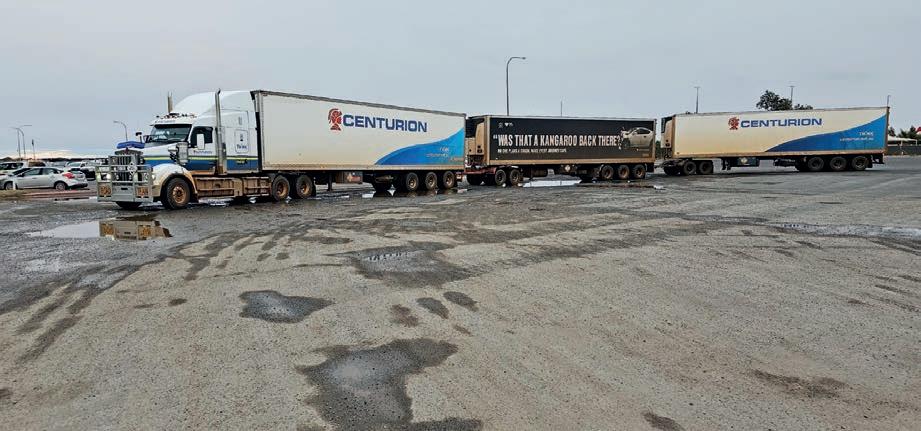
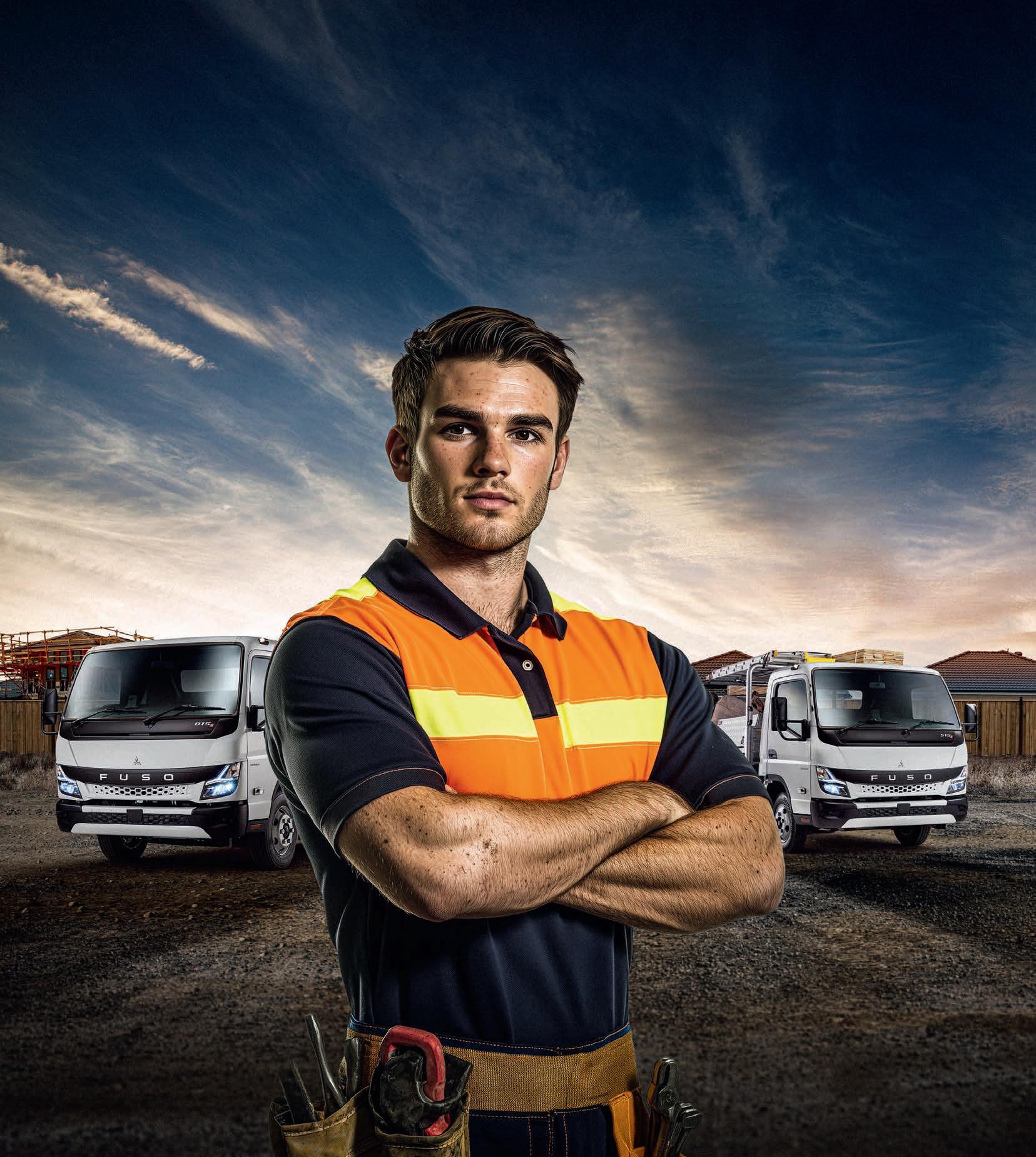
Despite this
operator’s
many years of experience moving military gear, this recent move was a little out of the ordinary.
HEAVY haulage operator and owner of Irwin Logistics, John Irwin, has plenty of military transport experience behind him, but in all his years of moving big gear, he’s never had an aerial bomber on the back of his truck. Until recently.
“This was the first time for me having a low-flying bomber behind me,” he said.
“I have spent a lot of time with army tanks on the back, as well as in recent years transporting the Bushmasters, but this was a new experience.”
While the payload was no challenge to the high torque Scania 770 R V8 driven by John, the smoothness of the truck and its accurate steering and airbag front end played a crucial role in the safe tran sit of the load through some pretty hairy experiences tra versing the A2 and A7 in Queensland.
The aircraft in question is a Douglas A-20 Havoc bomber, dubbed ‘Hell’n Pelican II’ and weighing 8 tonnes.
This bomber has a fasci nating history behind it. It was operational in WWII in Papua New Guinea in 1944. It was not shot down but had to make an emergency bad weather crash-landing in Madang after running out of fuel, and then the captain and gunner trekked 15 days be hind enemy lines through the jungle to escape.
The plane was one of two salvaged from PNG in 1984, winched out of the jungle by a Chinook, and brought to Australia where the heritage centre at RAAF Base Amberley painstakingly put them back together over a 10-year restoration. The second plane is on display at Point Cook in Victoria.
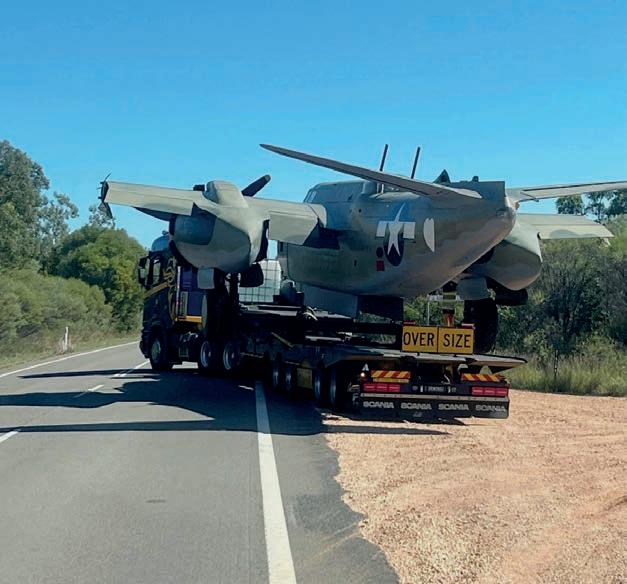
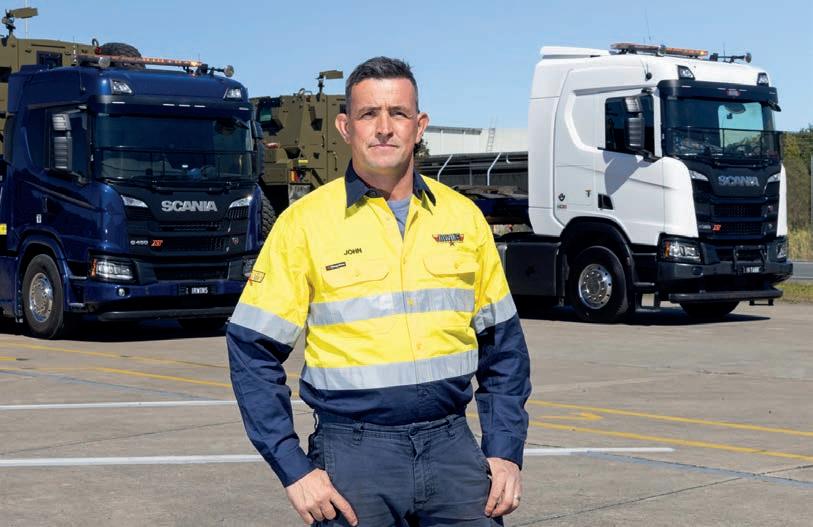
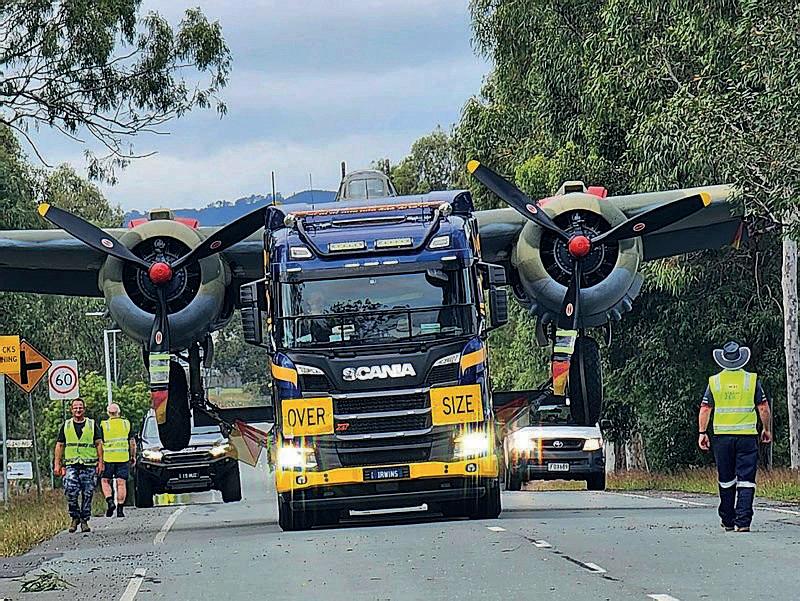
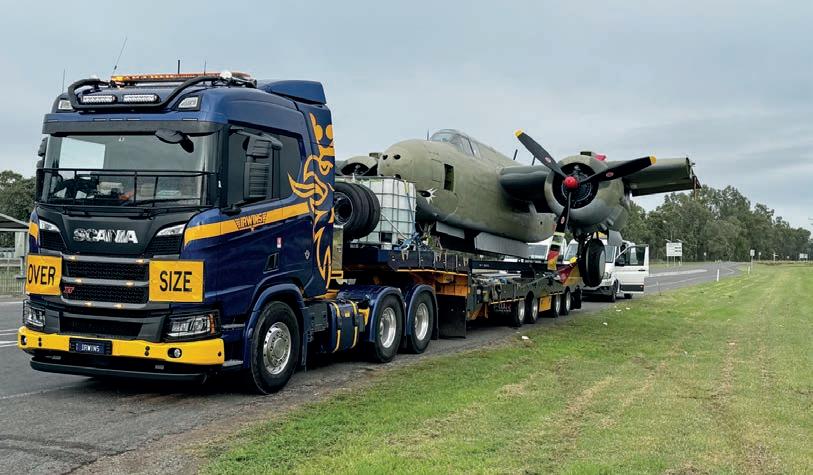
In 2025, the Douglas is set to return to PNG to be displayed by the National Museum and Art Gallery to celebrate the country’s 50 years of independence. However, the ship to collect it was in Townsville. And that’s where John’s expertise came in.
“So, an aircraft is not particularly heavy, but it is wide, even with the wings removed.
Oversized movements is our game, but 10 metres wide is big even for us, probably double the width of anything we have hauled before,” ex plained John.
Amberley was quite slow and
OVERSIZED MOVEMENTS IS OUR GAME, BUT 10 METRES WIDE IS BIG EVEN FOR US, PROBABLY DOUBLE THE WIDTH OF ANYTHING WE HAVE HAULED BEFORE.”
JOHN IRWIN
frustrating in parts. It took us seven hours to get to Dalby, which is only 200 kilometres.
“Some of the roads we were able to get up to speed and get going. We had a team of four pilots and two police cars with us to clear the
“There was one young fella in a ute who almost took the driver’s side engine off the plane, just didn’t see us coming, if you can believe that.”
The trip to Townsville took three days in all, and aside from leaving at night, most of the driving was done during daylight hours. Naturally the route was pre-checked by a team to spot height and width issues, although there was some miscalculation in Dalby where the 10 metre wide load had to shuffle down a 9.5 metre wide section crab-like.
“In Dalby we had street furniture and overhanging power lines, and I had about 9.5 metres to play with, and the load was 10 metres. So, I would go through on one side, reverse back and pull the truck over to the other side, get through that side and vice
with about 20cm either side of the railway line.”
Despite the stress of the driving, John found time to snap off a few images of the warbird on his truck, including shooting at night using only the moonlight and the stars for illumination, resulting in some hauntingly powerful images.
“I didn’t have a flash or any gizmos to take the shots, I just lay on the ground and took some long exposures with a steady hand,” he said.
“The paintwork on the Scania really popped.”
John’s blue 770 V8 is the latest Scania V8 to join his fleet and has racked up 90,000 kilometres of heavy hauling in just the first six months.
business of around 2.4km per litre, a result that John is pretty pleased with.
“The 770 is fitted with the CR23 extended cab, so there’s plenty of room inside. It’s got a big bed to go with the big motor,” John said.
“The most impressive aspect of the big V8 is the pulling power coming up the Range. We can have the big gear on the back, but the truck just marches up the Range at a steady 50km/h, leaving the other big trucks for dead.
“She starts getting into those hills and she’ll just drop down. She’ll find her gear and she’ll just sit on that speed.
truck again. The Scania airbag front end is a complete game changer. You just don’t realise how different they are on air. In my Scania 580 with parabolic springs, I’d get up to Goondiwindi and I’d have to pick up from the passenger footwell all the stuff that I had on my dash when I left Brisbane, like my souvenir beer mats, ball caps and paperwork, etc.
“On this truck with airbags, nothing falls off the dash. Makes the truck much better to drive and at the end of the day reduces the fatigue.
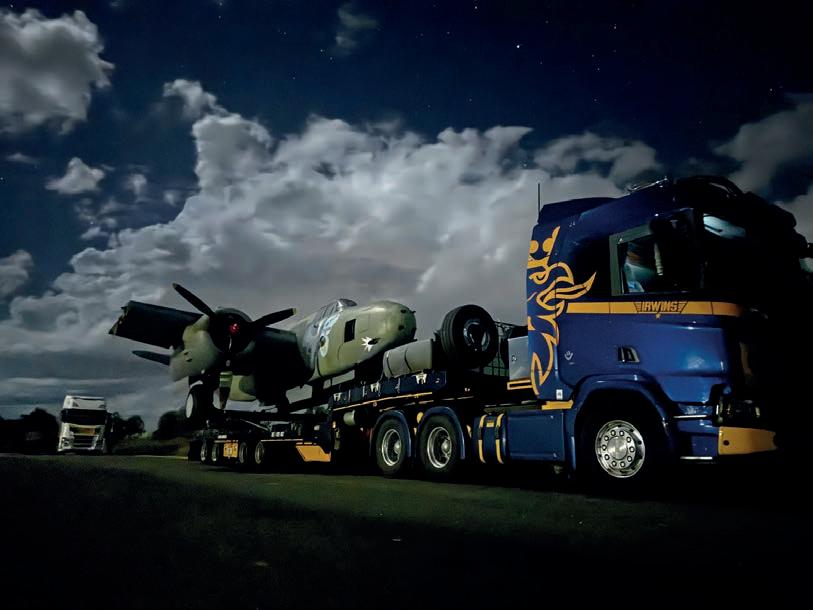
“When we got to Emerald, we used the old bypass and were able to squeeze through
Normally it is tasked with carrying big gear on the quad low-loader for the Department of Defence, such as dozers, and it’s been returning impressive fuel figures for t
I’ve got a bonneted American truck behind me, driven by a subbie with the exact same load on, probably 6-tonnes lighter overall, and he can only get up at 40km/h.
“The other huge advantage of the 770 V8 is the front end is on airbags. I will nev
“So now I have a Scania 660 V8 on order bringing the Scania fleet size up to seven, and that will get a new quad super tilt trailer behind it, so the fleet will have three super tilts and two low loaders. We’re that busy the new truck is needed to cope with the workload,” John added.
“But as for planes, I think
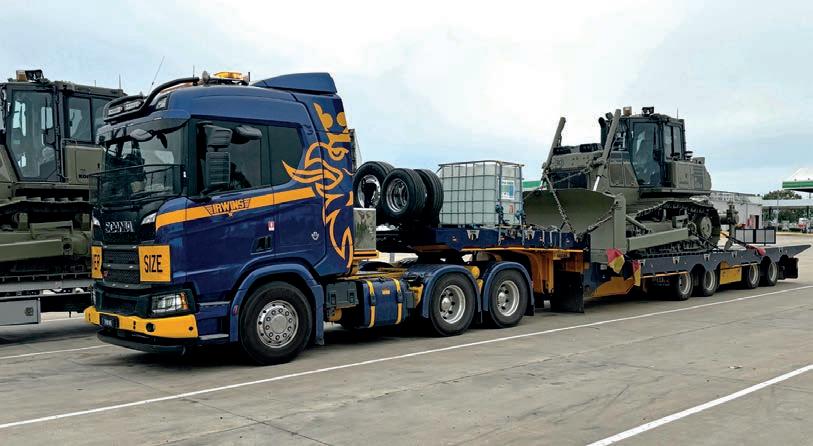
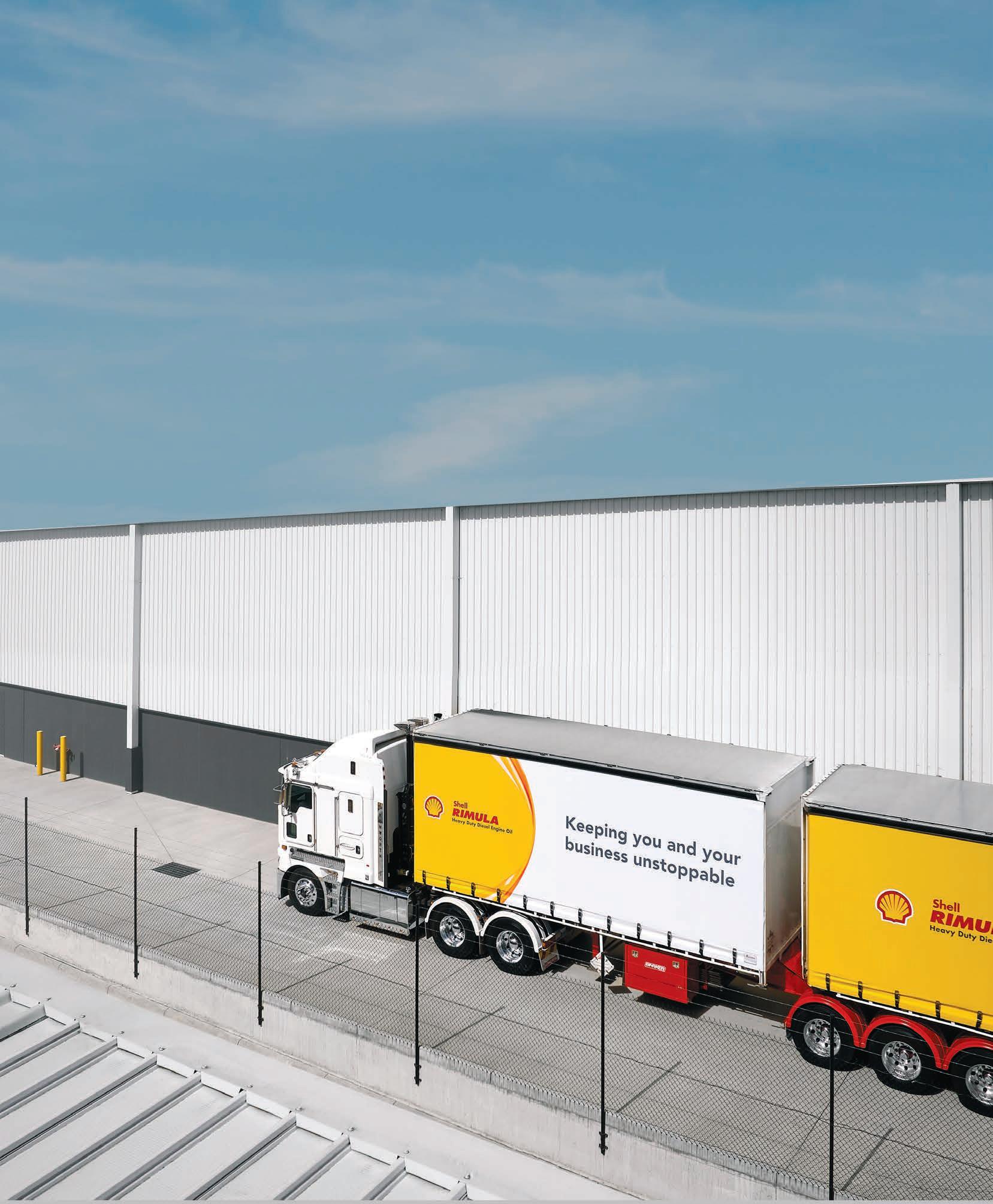


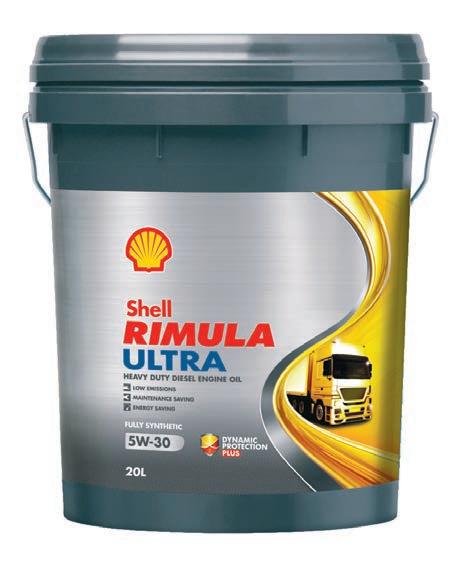
VICTORIAN truckie Nicholas Hawtin has self-published a humdinger of a free e-book about his life growing up in the cab with truckie dad John.
Titled “The Shotgun Kid, Tales of a truck driver’s son riding shotgun”, the easyto-read 30-pager is a loving tribute to the ‘golden days’ of trucking – and also a heartfelt gift to his own children who never got to meet their largerthan-life pop.
“I wrote this book for my kids who were born after my dad died. I want them to know how good of a man he was,” said Nick, a part-time truckie who also runs bakery café Caffeine N Machine in Rutherglen.
Below are couple of extracts from Nick’s homage to his father and a bygone era.
To download your free copy, just visit lulu.com/shop and search The Shotgun Kid.
Cafes and roadhouses
Food, sleep, showers and coffee always played a big part in dad’s and every truckle’s life.
You always knew a good place for a feed as the roadhouse or cafe would always have two or three trucks parked there, the obligatory truckies lounge with free coffee and a television that you could never quiet hear.
Some car drivers rarely dared to enter to lounge as it usually had a secret men’s club appeal about it.
I remember watching Dad sit down to eat a plate of bacon and eggs with a side of toast and pot of milk coffee as the regular breakfast at most roadhouses. The serves were generous and the compliments to the waitresses’ the sa me.
Truck drivers had their own stop or roadhouse they frequented.
It was like dropping in on mates.
Watching dad drink coffee was amazing to me as he a lways was talking to some other driver about the price of fuel, freight or police. During these conversations I would watch in amazement him tipping sugar from the sugar dis-
penser into his white ceramic cup. He would tip up the dispenser and empty one sugar into the milk coffee and then stir it clockwise. This process depending on the conversation might happen up to four or five times.
By the time he actually took a sip, the skin of the milk would attach to the side of the cup.
No wonder the truckies could drive, as if they all drank coffee this sweet, they would have been like a hyperactive child never settling.
Even the kid serves in the truckies lounge were large. Maybe they were grooming our figures early for the truckies life. I never could grasp the concept of eating a huge meal and then sitting and driving for four hours. Most truck operators had large bellies and skinny legs from changing gears. Probably the only exercise they ever got.
Another sign of a great roadhouse was the showers. Truckies always loved clean showers and hot water. Plenty of water pressure and if you are lucky even a seat to sit on in the cubical of the shower to get changed.
If you were in good luck, you knew that the roadhouse had good showers and meals by the amount of bullbars with towels on them. The truck driver would have his shower and then hang his towel to dry over the bull bar of his truck while they went to eat.
Every truckie had his own story to tell and as a kid trying to eat my oversized meal in the truckies’ lounge I still remember the stories that were told as much as the swear words that I learnt and use today.
I remember at the Boggabilla shell roadhouse one night, we were eating tea and I asked if I could have some dessert. Dad agreed and I ordered some ice cream while he had another pot of milk coffee.
The waitress explained to me that they were all out of ice cream and I would have to choose something else. With
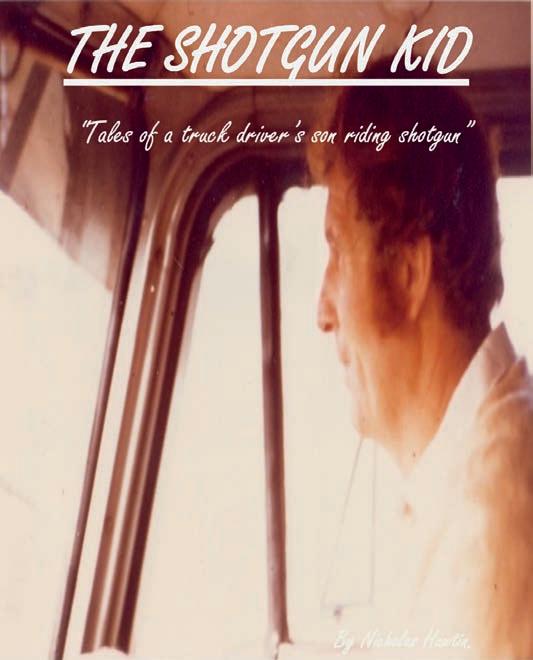
this, a big guy bellowed out from the truckies lounge to me. “You want ice cream son? Come with me”. I looked at my father for the nod that the stranger danger rule did not apply to this guy. He walked me outside and mumbled on about how poor it was a roadhouse with no ice cream. However, all I could hear was the clicking sound of his large Dunlop thongs on his feet. We walked out to the back of this blue Kenworth towing a tri-axle freezer van. He opened the doors on the back of the van and a cold fog and draught hit my body. I remember him asking me what flavour I liked? Pineapple, chocolate, rocky road?”
I was in ice cream heaven; this truck was the Streets ice cream semi-trailer. The back of this trailer looked like it had a skyscraper of twenty litre tubs of ice cream in every flavour I could imagine. I did not want to cause much fuss so I asked for vanilla.
He said, “Vanilla you want, vanilla you get.”
With this he put his fist through the top of the cardboard liner and grabbed out the tub of my dreams. “We’ll
put it down as damaged hey,” he said.
With eyes bigger than my belly we entered back into the roadhouse.
He said to the waitress “free ice cream for all the truck drivers’ love”. I felt special and privileged, as I tucked into an extra creamy vanilla bowl of ice cream as dad thanked the driver for his generosity.
Police and scalies
A pet hate of most truck drivers is the dreaded scallies or police. If they weren’t hassling them for road infringements, they booking them for overweight. I think at one stage they measured Dad’s truck on the side of the road and with the driving lights on the bull bar the truck was one hundred millimetres too long. Seems totally irrelevant now that we allow B-doubles on the road and he gets booked for an over length truck.
Undoubtedly, he would have been one of the many that squeezed an extra tonne on here and there, but boy did he bleed when he got nabbed. I suppose I shouldn’t stir the pot as it was probably loaded heavy so he could buy us that motorbike we always wanted or mum a new kitchen.
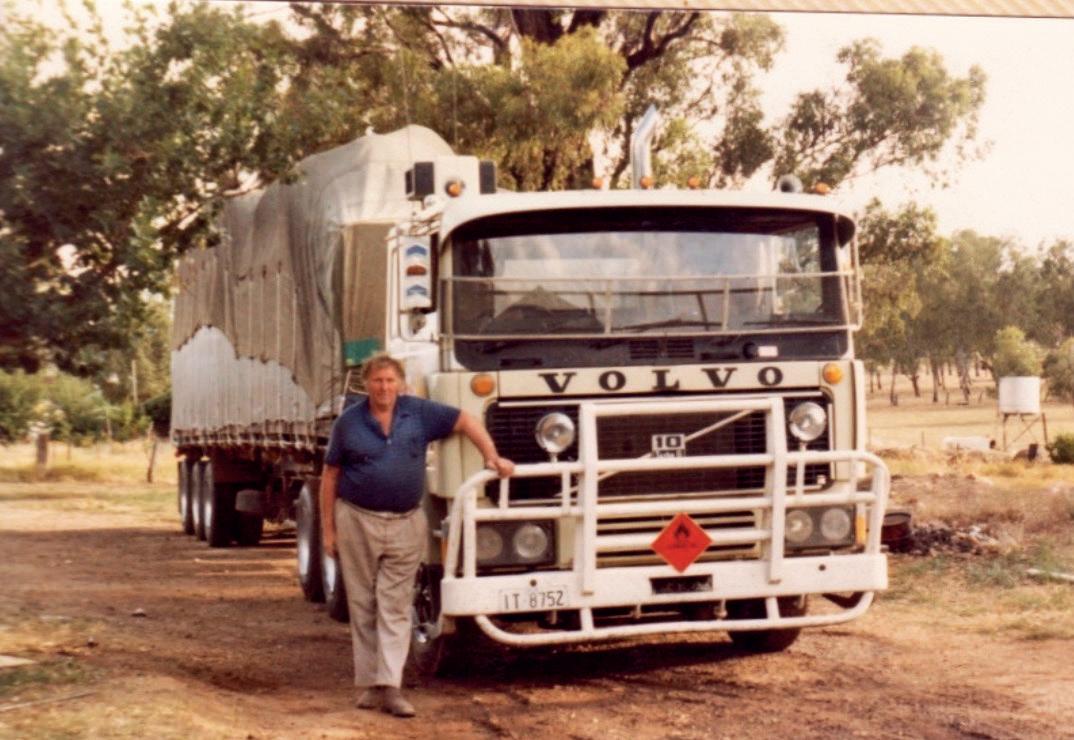
Police and scalies (the RTA) have played a cat and mouse game with the truck drivers for decades now. Truck drivers for years have borne the runt of the traffic infringements from the police whilst he average car driver could get away with blue murder.
A truckie had to have cer tain rest stops and break pe riods in one day. I know that he logbook was a estimation of most trips but I could and still do not understand how a car driver could drive for 24-hour’s straight, have a 10-minute sleep and then attempt to drive for another 24 hours with no logbook of travel times.
When the car driver falls asleep at the wheel and runs under the front of an on coming truck, the newspaper eadlines the next day would read, “Truck hits car and kills driver”.
In general, the consumer is to blame for the risk taking of the truck driver. If we didn’t want everything now, then the transport companies wouldn’t put the demands on the drivers to break the law.
A vicious circle of demand.
Some stories of the police that I love were the time the local Mulwala police pulled dad over on his way to Brisbane.
Dad was so wild to be stopped 20 kilometres from home that he slammed on the trailer brakes bringing the truck to a halt rapidly. The local policeman wasn’t ready for this and nearly ran up the rear end of dad’s trailer. Sheepishly he got out of the car and walked up to the truck’s driver door.
Upon reading the name and location on the door he said “Oh it’s you John. On your way” They realised that he did not have to have his logbook filled in because he was in a driving area that it did not have to be logged.
One to Dad.
None of Dad’s trucks, bar the Scania, really ever made enough top speed to cause him drama for speeding so it was mainly the RTA he had to watch out for.
One time we were in Bris bane and he spied the RTA approaching at a rapid rate. As sons of a truck driver we knew what to do when Dad yelled logbook. We quickly grabbed the book and began filling in the blanks that dad yelled out.
This particular day we had to do two laps of the round about for me to get the last timeline written in. As he pulled over for the Scallie, I passed Dad the logbook that he signed and passed out the window to the ap-
proaching officer who was walking down the side of the truck looking for faults. This would happen on several occasions.
The demands of the road meant that sometimes he would forget to fill it in for two trips, thus as the truck sat idle and built-up air pressure before he left home he would fill it in with the best of his memory. Nowdays they can check with cameras your exact time and locations. So hard on the driver to be exact all the time.
I remember the story of Dad’s mate being clocked by the police in New South Wales doing an estimated 110km/h in a 100-zone. He took the fine and fought it in court. The fine was thrown out when he informed the courtroom that his truck was road train geared and would not exceed ninety kilometres an hour no matter what he did.
One to the truckies.
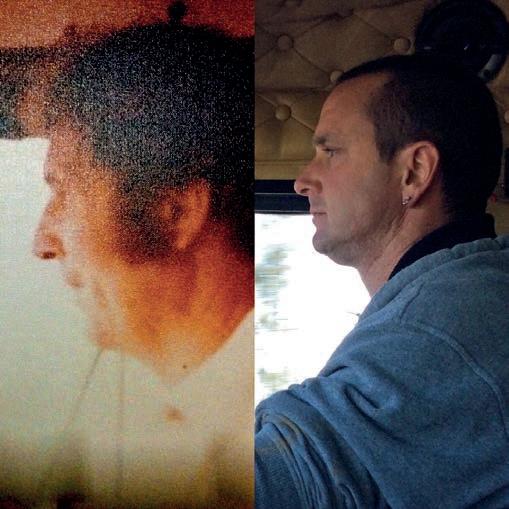
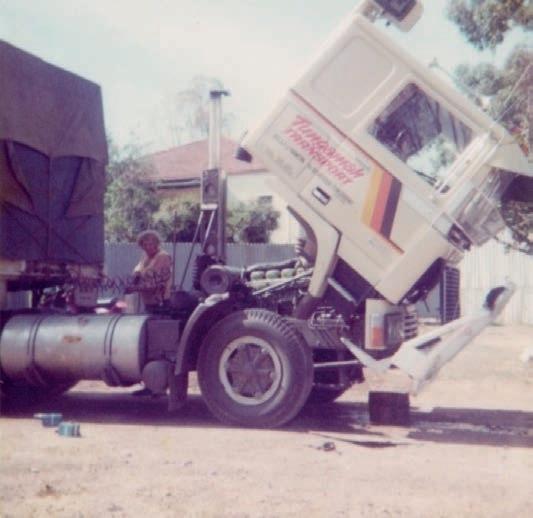
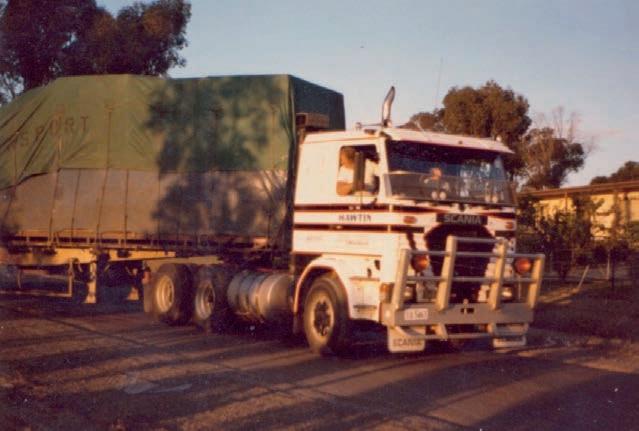









2025
- 780 Horse Power with 3800 Nm torque
- D17 engine
- Volvo Active Safety, Volvo Dynamic Steering, Pilot Assist
- Ai powered Real Time Monitoring
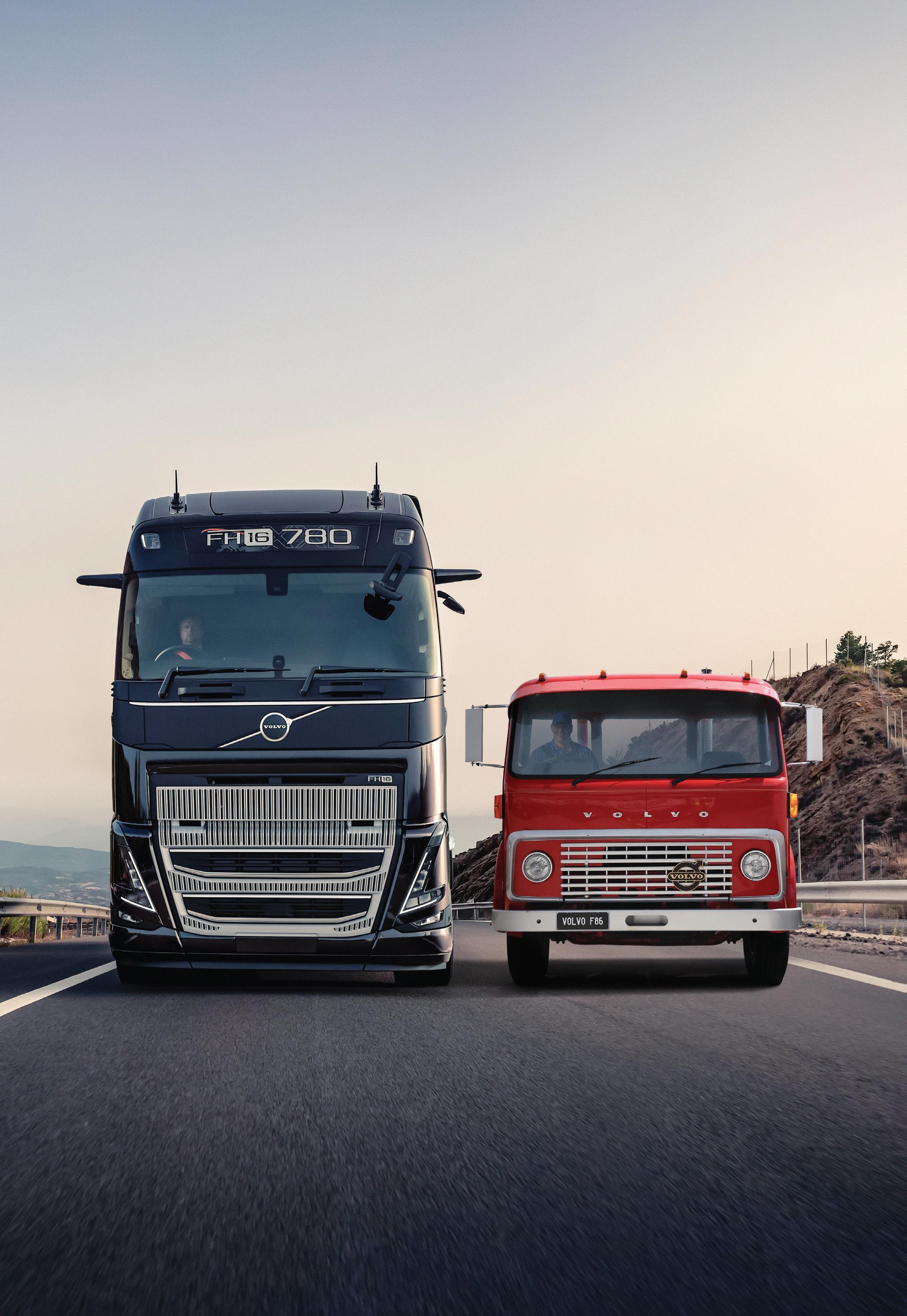
1965
- 117 Horse Power
- D50 engine
- Seat belt
For 60 years, Volvo Trucks has helped move Australia forward - safely, powerfully, and more sustainably with every generation. From the trusted F86 to the groundbreaking new FH16 780, we’ve never stopped evolving. Our past inspires everything we do. But it’s the future that keeps us moving.



SHELL Rimula has partnered with Big Rigs in a big way – so there are even more reasons to send in your best truck shots.
Each month, the Big Rigs team will choose a #PicOfTheMonth, with the lucky winner receiving a $500 Shell Coles Express Gift Card.
Keep an eye out for our regular posts on the Big Rigs Facebook page, calling for your best truck photos and add yours in
the comments, or email them direct to danielle.gullaci@ primecreative.com.au for your chance to win the main prize.
Don’t forget to include a brief note about the truck and where the photo was taken. We’ll feature some of the best photos in each print edition of Big Rigs, with one winner announced each month.
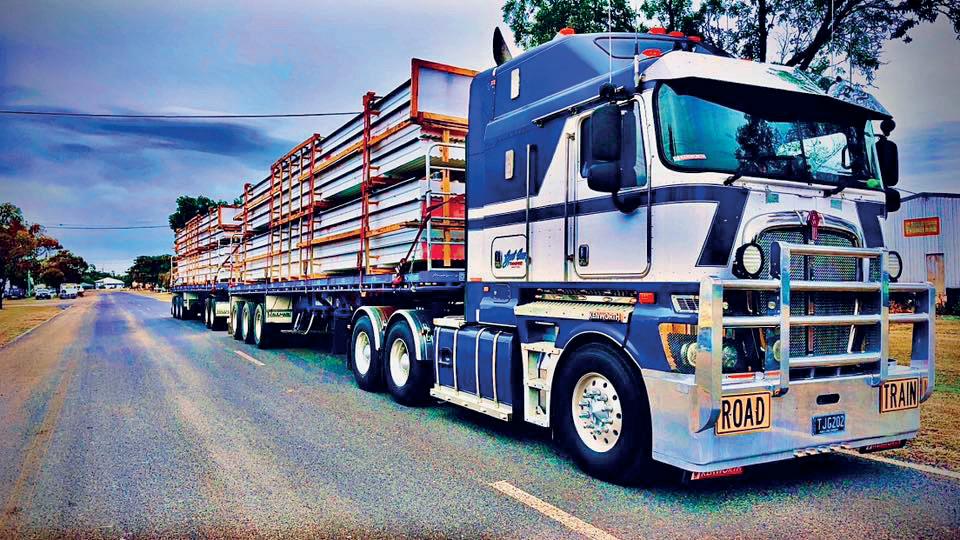
Keep those amazing truck pics coming!
Nicholas
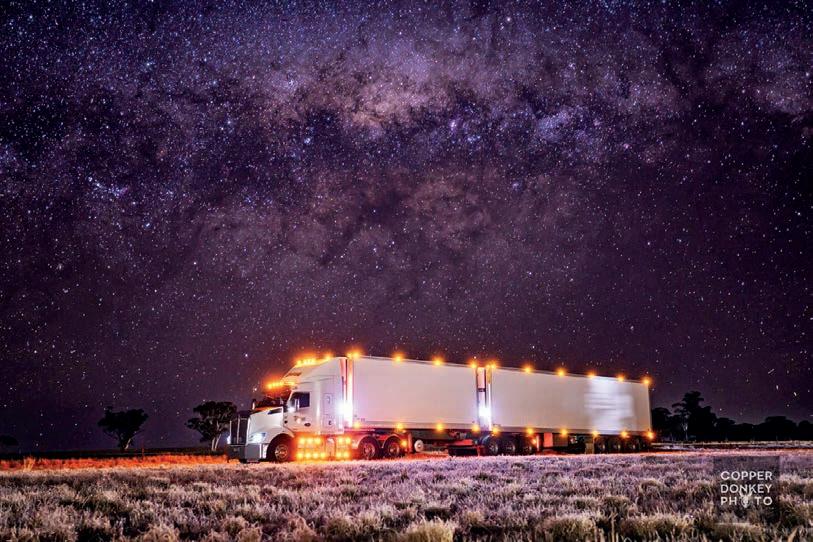

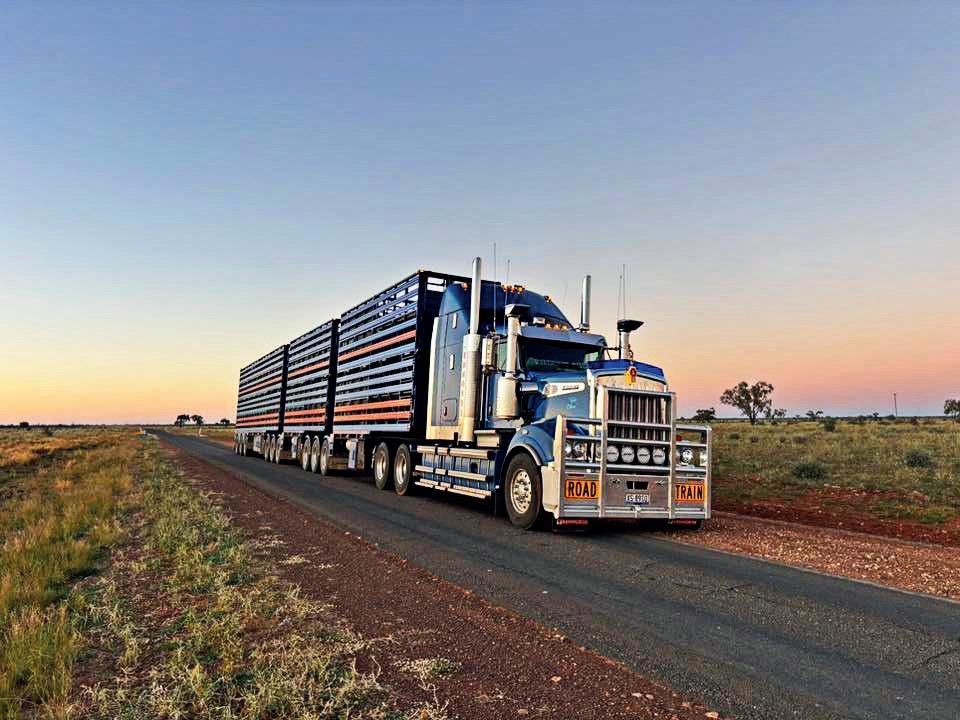
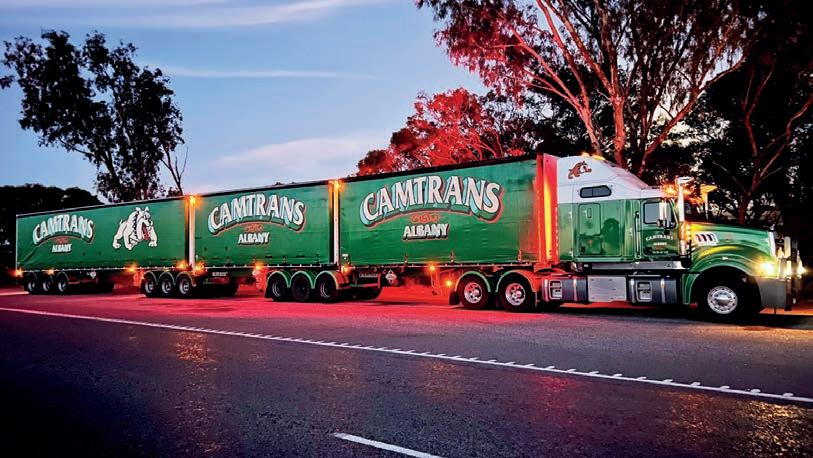
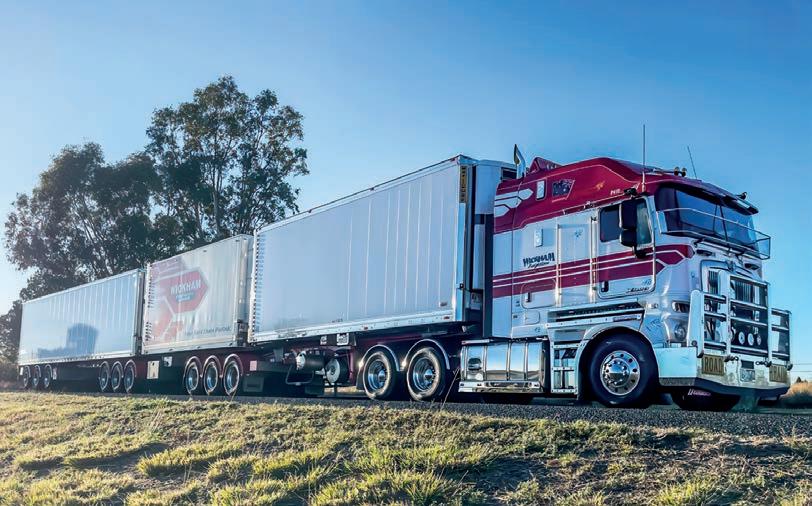

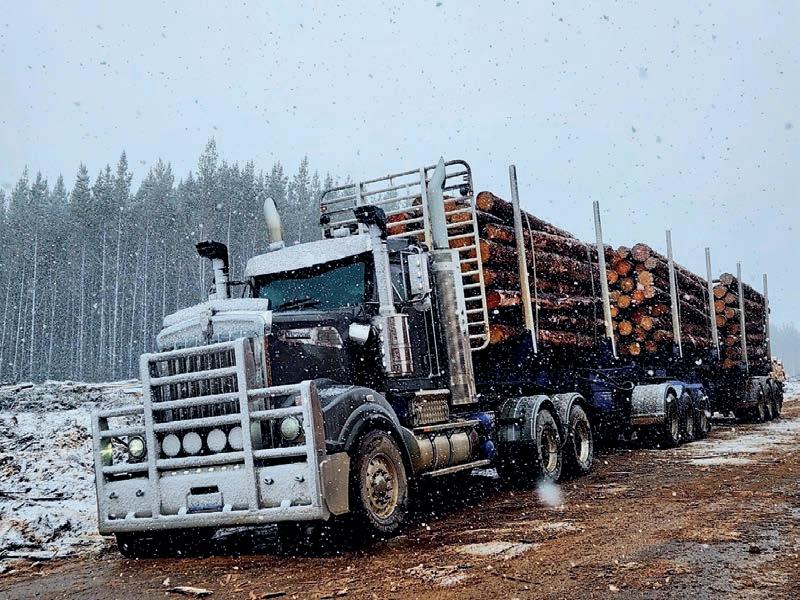
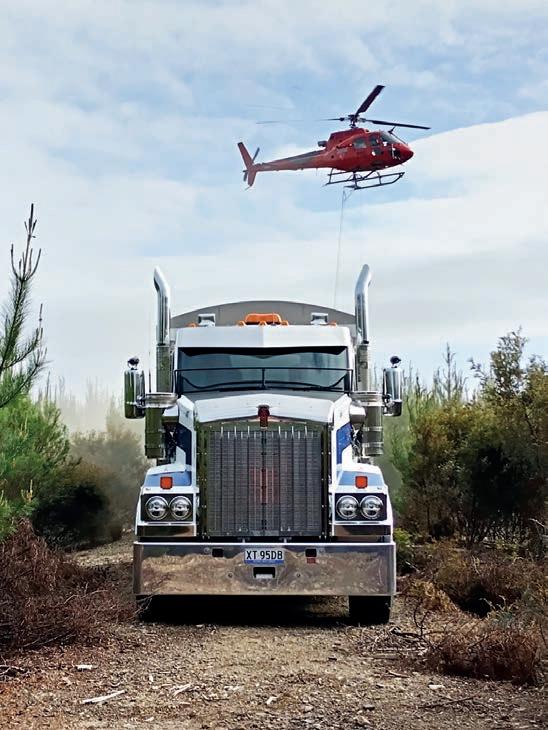
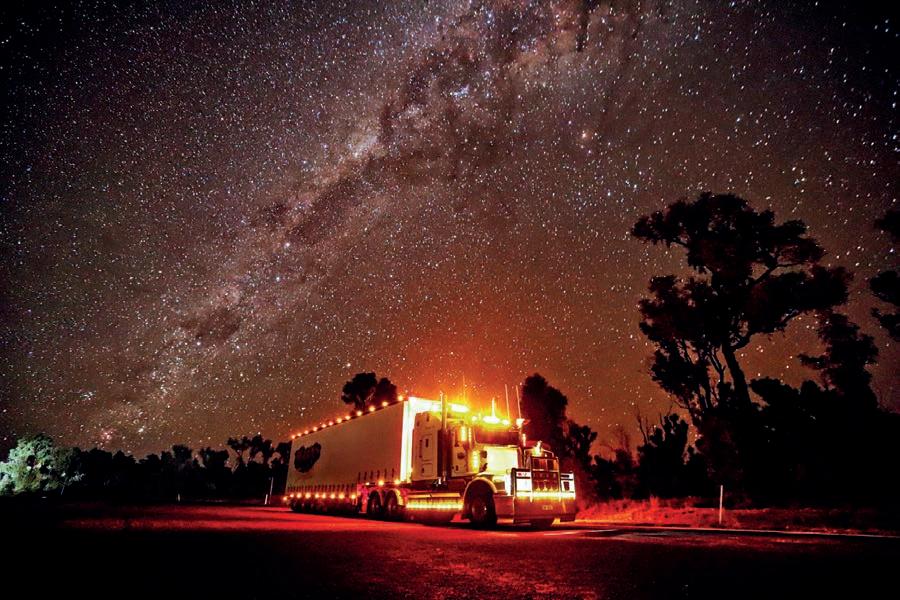
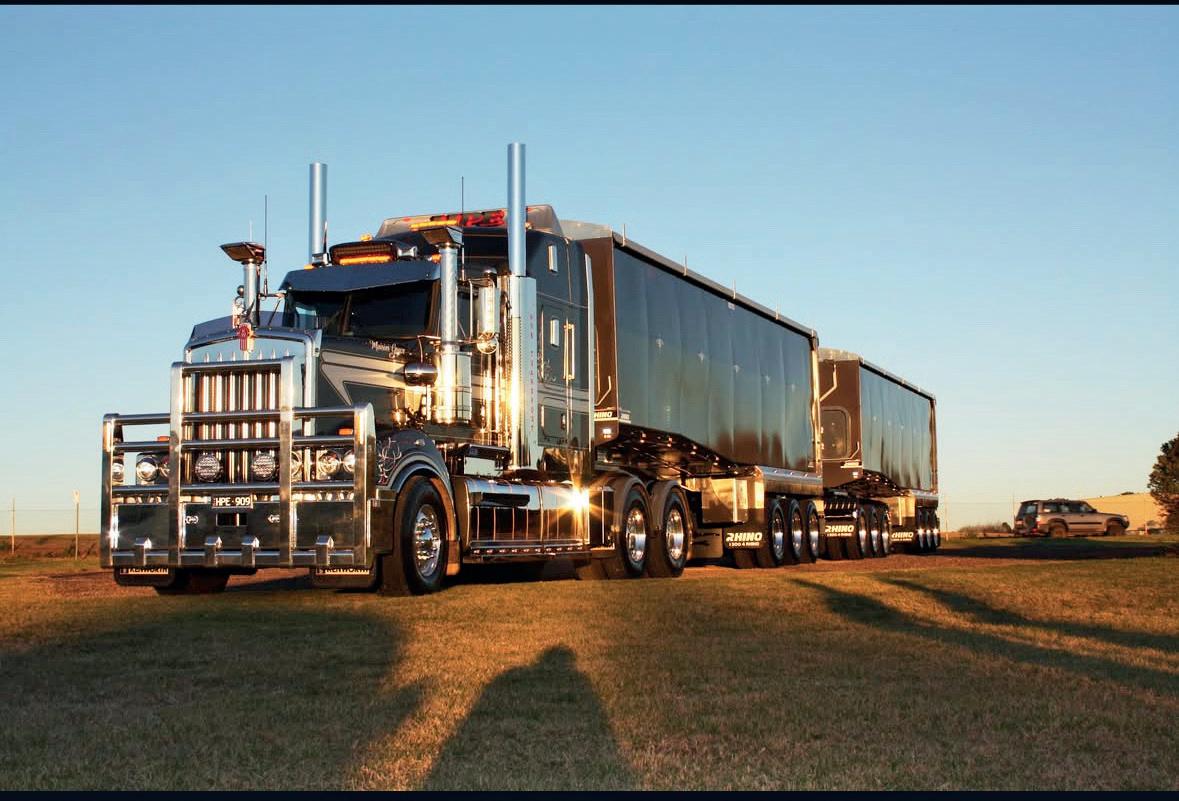
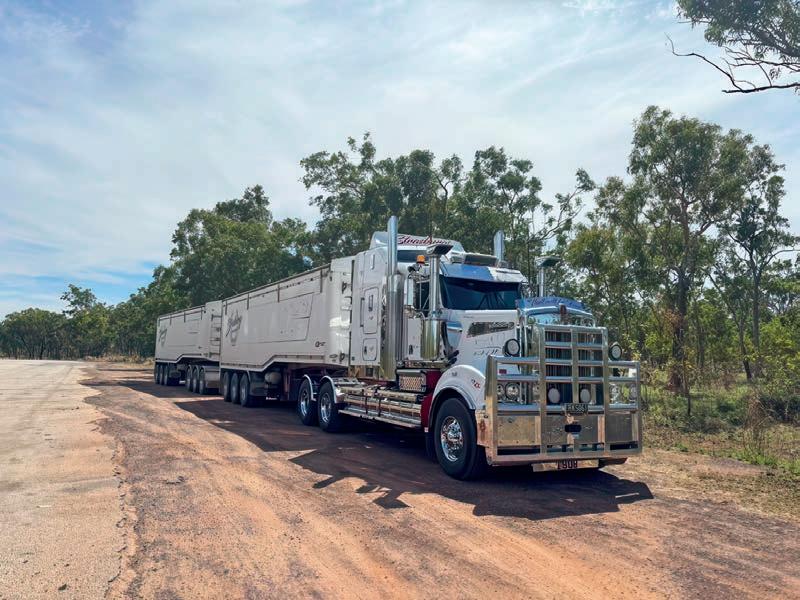
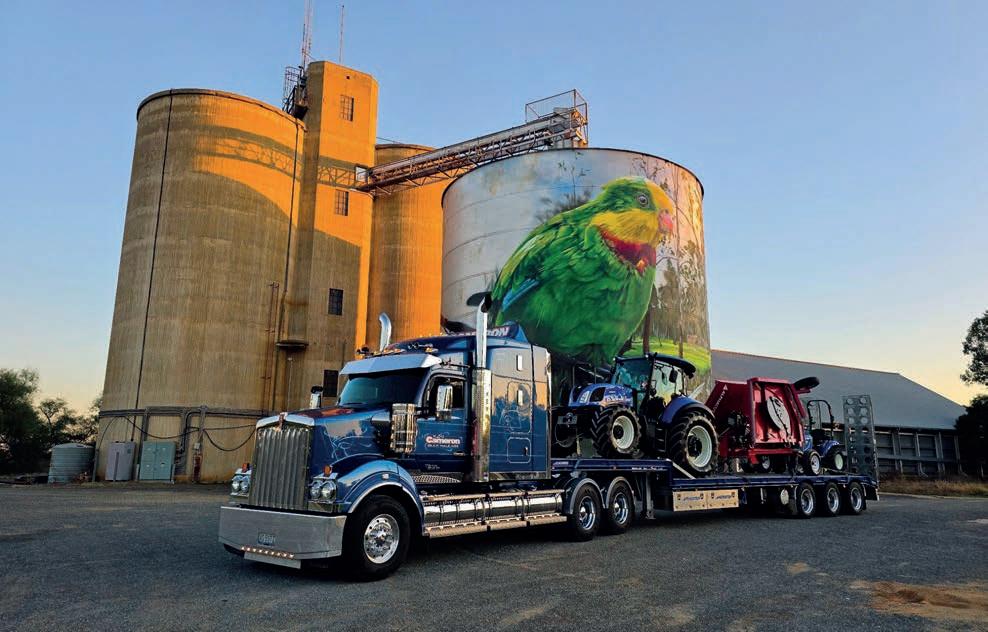
ALL roads lead to Casino, NSW, for truck fans this month.
The biggest regional show of its kind in the southern hemisphere is expected to draw thousands of truckies, families and industry figures from across the country on August 2.
A massive 550 trucks are tipped to roll in for the show, with more than 200 taking part in the ever-popular Dawson’s Haulage parade through town.
There’s more than $60,000 in cash and prizes up for grabs this year, with the coveted Rig of the Show winner set to walk away with $1500 in cash and a $5000 voucher from RTE Custom Trucks.
Make sure you grab the August 15 print issue of Big Rigs for our bumper wrap-up coverage of the big day from our man on the ground, Graham Harsant. Meanwhile, here are a few other major industry events to mark in the diary.
Casino Truck Show
August 2
Casino, NSW casinotruckshow.com.au
Excitement is building to this iconic industry event and attendees can look forward to a great day out with food, trade stalls, kids’ amusements and much more on one of the biggest regtional truck shows in Australia.
LRTAV State Conference
August 8-9
Move Museum, Shepparton, VIC lrtav.com.au
The Livestock & Rural Transporters Association of Victoria (LRTAV) will host its annual 2025 Conference in Shepparton, featuring all things livestock and rural. Registrations will open soon, with more details to come.
Coolgardie Rodeo and Outback Festival
August 15-17
Coolgardie, WA
Organisers of this year’s Coolgardie Rodeo and Outback Festival are planning an even bigger and better event, with an expanded truck and ute show and a brand new tractor display.
Wondai Truck Show
August 23
Wondai Showgrounds, QLD wondaishow.com
Held on the final day of the Wondai Show weekend, the popular truck show boasts an array of categories and has
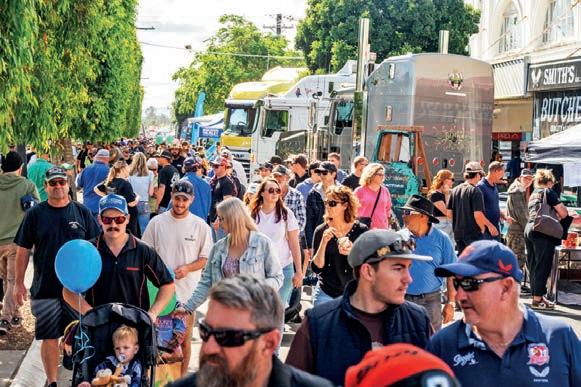
an impressive prize list up for grabs this year. The Truck of the Show winner receives $1000, runner-up $400 and the Encouragement Award winner gets $250. Powered and unpowered camping sites are also available at the showgrounds with shower and toilet facilities. For just $25 per night, you can enjoy the peace and quiet yet be only a short walk from the middle of town. For more information, call 0418 916646 or email secretary@wondaishow.com. au.
National Historical Machinery Association
National Rally
August 23-31
Kingsthorpe Park, QLD susci.com.au
Transport enthusiasts can look forward to 10 days of heritage displays and activities – expect classic and vintage cars, trucks, motorcycles, antique engines, tractors and machinery along with antique earthmoving equipment and heritage steam equipment such as traction engines and road rollers. Check out working displays, ploughing and earth moving demonstrations, a working blacksmithing display, market stalls, live entertainment and much more. Exhibitors from machinery car and truck clubs welcome. For more info, email Warren Buckley at secretary@susci. com.au or call 0414 334 006.
Festival of Transport 2025
August 28-31
Alice Springs, Northern Territory roadtransporthall.com
Held at the National Road Transport Museum’s hometown of Alice Springs, the four-day Festival of Transport 2025 will host various events including the Shell Rimula Wall of Fame Induction,
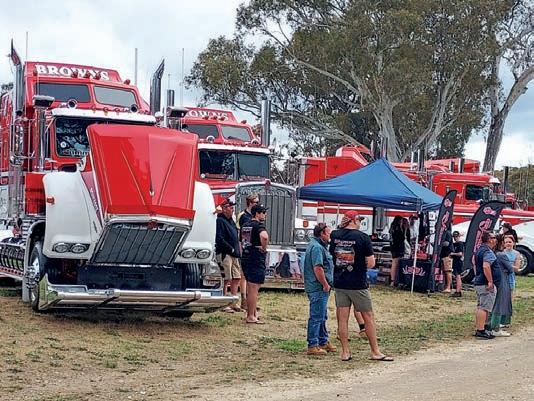
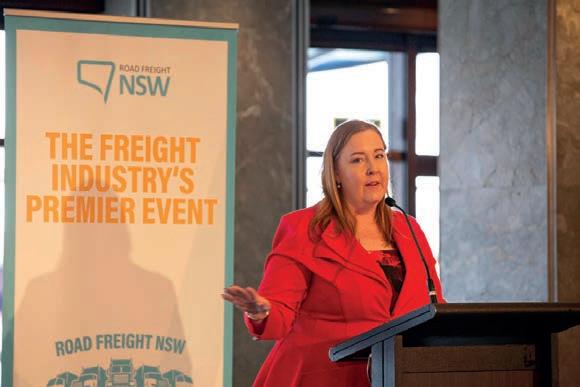
petting, magic shows, and a night lights display. Convoy participants will also compete in a range of categories, with awards handed out on the day.
Ulverstone Truck Show
November 1
Ulverstone Showgrounds, Tasmania
Held as part of the Thank You Day Show, a fundraising event to raise money for Beyond Blue and New Mornings, this year’s truck show component will feature a Kenworth focused show alongside the usual truck show. There will be prizes for both shows and lots of giveaways. The event starts at 9am.
Transport Women Dream
Maker Award, Truck Drag Racing and a street parade.
SEPTEMBER
NatRoad Connect 25
September 11-12
Shepparton, VIC natroad.com.au
NatRoad’s annual conference gives you the opportunity to connect with industry representatives, operators, NatRoad members and partners to receive practical operational information and advice. Save the date to your calendar and keep an eye on their website for updates closer to the time.
QTA Industry Awards and Gala Dinner
September 13
Royal International Convention Centre Brisbane, QLD qta.com.au
Heralded as the ultimate night of celebration for Queensland’s road freight industry, the gala promises to bring together leaders from government and industry, fleet owners, suppliers, and professionals from across the sector to recognise and reward the outstanding contributions shaping the future of freight. Hosted by QTA President Michael Mahon and the QTA Board of Directors, the event will feature a dynamic evening of networking, gourmet dining, live entertainment, and the prestigious industry awards ceremony. Award nominations close on August 1.
Road Freight NSW Conference and Awards
September 19
Dockside
Sydney, NSW roadfreightnsw.com.au
Road Freight NSW is return ing to the Dockside venue at Cockle Bay Wharf, right in the heart of Sydney.
Key topics will include eco nomic forecasts, regulatory reforms, and workforce trends with a spotlight on how busi nesses can prepare for growth. Attendees will also have the chance to engage with industry leaders, government stakeholders, bureaucrats, regulatory experts and fellow freight workers to gain invalu able insights and strategic per spectives on the industry. For more information on award categories and to make a nom ination, visit roadfreightnsw. com.au/2025-conference.
October 12
Perth Hockey Stadium, Bentley Camp Quality’s Convoy Perth is a fun way for anyone who drives a truck to show their support for kids facing cancer and their families. Supporters will cheer on our Convoy, as we travel a 53km route around Perth City and Osborne Park, starting and finishing at Perth Hockey Stadium. The event venue will host a free Family Festival packed with entertainment and experiences catering for kids and adults alike.
There will be food vans, kids’ rides, face painting, roving entertainment, live music, fundraising awards ceremonies, and the chance to cheer on the returning Convoy. Plus, you can check out all the trucks and vehicles at the Show ’n’ Shine after the Convoy returns.
October 14-15
Victoria Pavilion, Melbourne Showgrounds, VIC new.truck.net.au/tmc
The TMC Conference brings together technical professionals, fleet and workshop managers, technical regulators, mechanics and service technicians. For 2025, the event moves to a new venue – delivering bigger exhibition spaces and a larger workshop area.
The venue will also provide greater space for workshops on trucks and trailers, and expanded networking areas. The program will focus on key industry priorities, in-
cluding safety, productivity, environmental sustainability, cost efficiency, and workforce career development.
Sydney Convoy for Kids
October 26
Sydney Dragway to Hawkesbury Showground, NSW convoyforkids.com.au
Convoy For Kids Sydney Inc. was started in 1992 by a small group of dedicated people from the transport and associated industries who had a desire to help sick children. Today, 31 years later, we are still a volunteer committee who spend time to put together one special day, not only as a fundraiser but a family day for all. Drivers and owner drivers, travel from all parts of NSW with their families to participate in this great event each year. It is a spectacular sight to see 500 or more trucks, in a convoy supporting the event.
Funds are raised on the day by truck entries, sales of food and merchandise, major raffle, donations and our giant auction. Taking part means you are helping raise funds for the NETS Ambulance Service and Kidzfix.
NOVEMBER
Brisbane Convoy for Kids
November 1
Brisbane, QLD brisbaneconvoyforkids.com.
au The Brisbane Convoy for Kids is back on November 1, travelling from Larapinta to the Redcliffe Showgrounds. Once it arrives, a family fun day will take place, with a wide range of activities on offer including live entertainment, auctions, food stalls, free kids’ rides, face painting, animal
Mullumbimby Truck Show
November 8
Mullumbimby, NSW mullumbimbyshow.org.au
Held in conjunction with the annual Mullumbimby Agricultural Show on the second Saturday of November each year, you won’t want to miss the Mullumbimby Truck Show!
This event will feature a truck parade through the town, sideshow alley, kids’ rides, food vans, full bar facilities and live music. Other features will include horse and cattle events including trotting. For further truck show info see the registration form at mullumbimbyshow. org.au.
Dane Ballinger Memorial Truck Show
November 15
Bathurst Showgrounds, NSW bathursttruckshow.com.au
The Dane Ballinger Memorial Truck Show is back, with plenty to see and do for the whole family. More info to come.
Illawarra Convoy
November 16
Illawarra, NSW illawarraconvoy.com.au
Touted as the largest truck and motorbike convoy in the Southern Hemisphere, the Illawarra Convoy raises funds for individuals and families affected by potentially life threatening medical conditions, and the charities that work with these people, and local hospitals.
Castlemaine Rotary Truck Show
November 29-30

Castlemaine, VIC Held at Campbells Creek Recreation Reserve and organised by the Castlemaine otary Club, this year’s truck show is gearing up to be bigger and better than ever. ttendees can expect plenty of well-presented trucks on display, as well as food, a licensed bar, kids’ rides, free ealth checks and live music. For more information, visit rotarycastlemaine.org.au/ page/truck-show.
Have you got an event you’d like included in the next Save the Date? Email all the details to danielle. gullaci@primecreative. com.au.
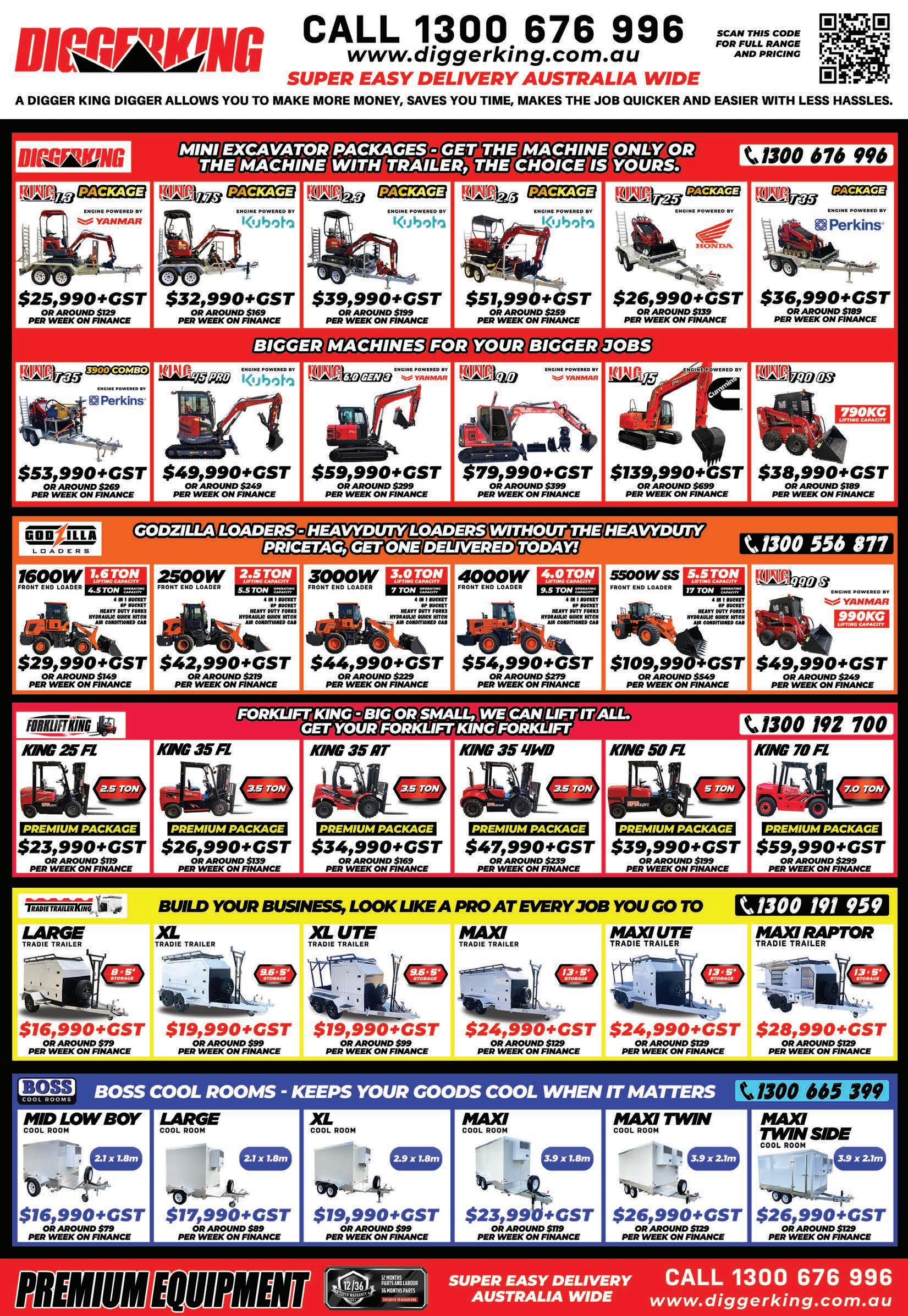
THE Variety Victoria Bash will see a wide range of vehicles and entrants tackle 10 days of difficult terrain from Hamilton in Western Victoria through to Darwin in the Top End, to help raise money for a worthy cause.
Isuzu Australia Limited (IAL) has joined forces with one of its dealerships, Ballarat Isuzu, in a unique two-car entry for the event, as well as a truck fundraising raffle.
Providing practical event support in 2025, IAL will also supply a Giga model prime mover truck for the event’s on-road logistics operation from August 8-17.
The Variety Victoria Bash offers a unique blend of adventure and philanthropy, where participants rally across remote and regional areas, while raising essential funds to support children who are sick, disadvantaged or living with disabilities.
Isuzu’s 2025 Variety Bash entries include a 1984 Holden Caprice (Car #707) and a unique 1997 Holden (Isuzu manufactured) Jackaroo (Car #505), painted to replicate Peter Brock’s famous Round Australia Trial entry of 1998.
IAL has stepped-up its commitment in 2025 by becoming a Silver Heart Partner.
This year’s drive team will include personnel in the form of IAL Director and Chief of Corporate Services, Ben Lasry, alongside the
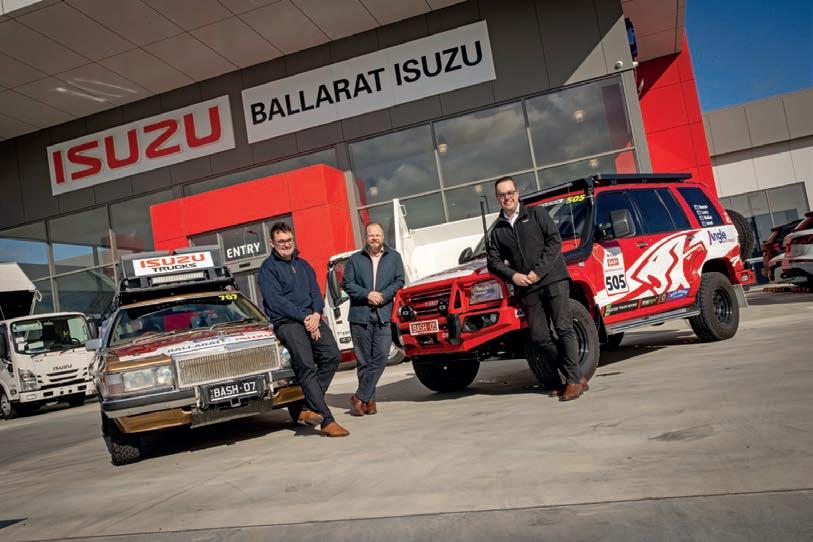
brand’s Head of Marketing and Customer Experience, John Walker. They will join Ballarat Isuzu Dealer Principal, Ian Deacon, and Service Manager, Jonnie Arnel.
As part of a double celebration, both Variety and Ballarat Isuzu are marking 50 years in operation.
“Variety is celebrating the milestone of 50 fantastic years of operation in Australia this year, so it was a perfect opportunity for Isuzu to come together and get actively involved to support the good work Variety undertake across the country,” said Lasry.
“We’re excited to be on board with the team at Bal-
larat Isuzu this year, which is also celebrating 50 years, which only strengthens the overall commitment from the brand family.
“The Bash is a uniquely Aus tralian event that brings out the very best in people and business to raise much needed funds, while taking part in an incredible experience.
“There’s little doubt the Aus tralian outback is a true test on driver and machine, so the event provides full mechani cal support along the way and Isuzu is thrilled to be able to offer a vehicle to act in this role.”
Variety Victoria’s CEO Pe ter Bruce has welcomed the
ful, it’s challenging, and it’s all for the kids,” said Bruce.
“Entrants travel thousands of kilometres through the outback, raising vital funds to support children who are sick, disadvantaged or living with disability.
“Having Isuzu Trucks on board as a Silver Heart Partner, and two Isuzu teams on the road this year shows just how committed the team is –not just to the adventure, but to making a real difference.
“This kind of support helps us reach more kids, in more places, with what they need most.”
The key fundraising initiative has also seen IAL and Ballarat Isuzu partner to raffle
raising push,” Deacon said.
“The raffle is open right now and will run through to Wednesday September 3, so there’s plenty of time to get on board and support a wonderful charity.
“It’s a great prize and along the journey, we’ll be promoting it at every opportunity with the goal to raise as much money as possible for Variety.
“We have two great looking cars and a crew of enthusiastic competitors. It’s sure to be 10 days of adventure, a few laughs and importantly, a lot of money raised.”
The 2025 Variety Victoria Bash begins in Hamilton, Victoria on Friday August 8, travelling through Ade-
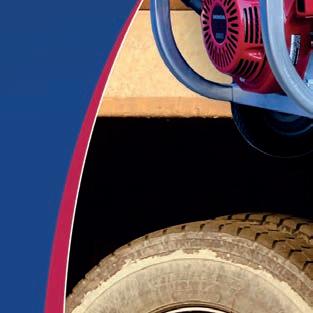

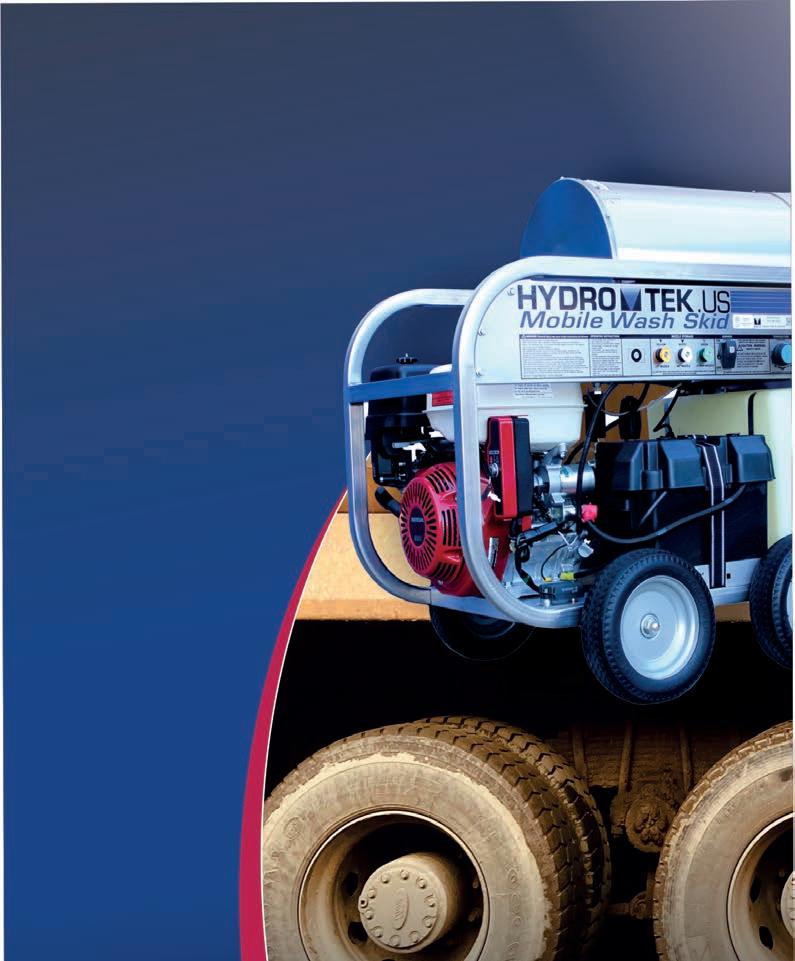
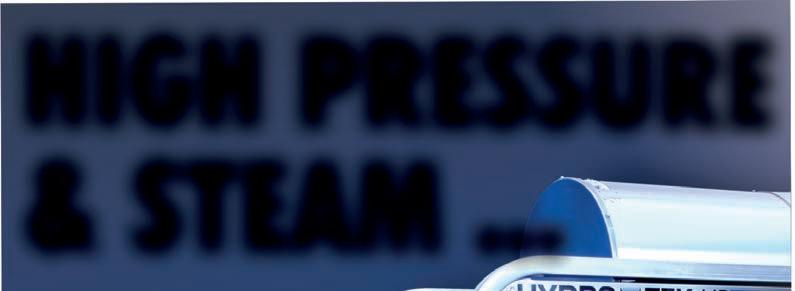
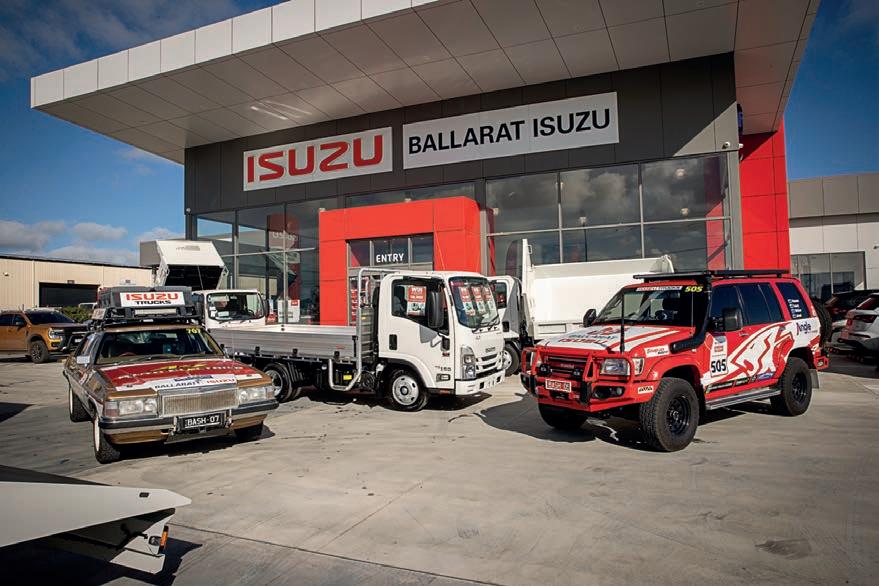
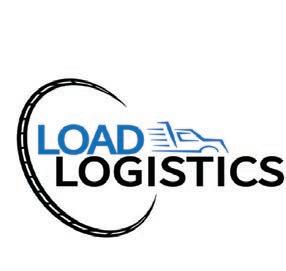



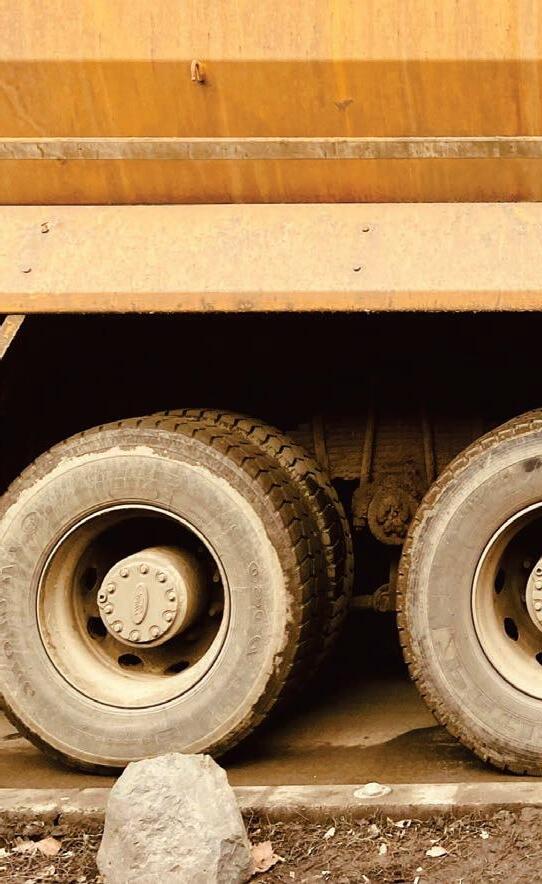
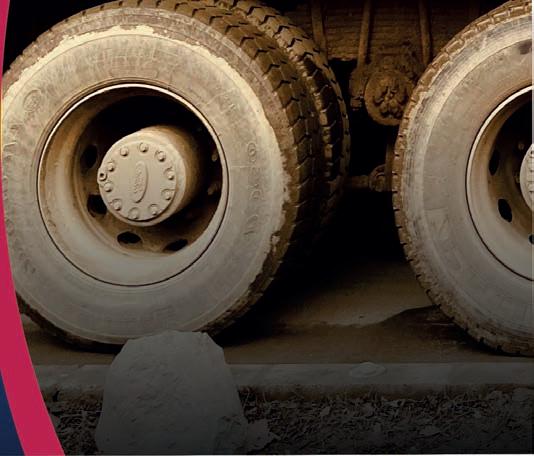
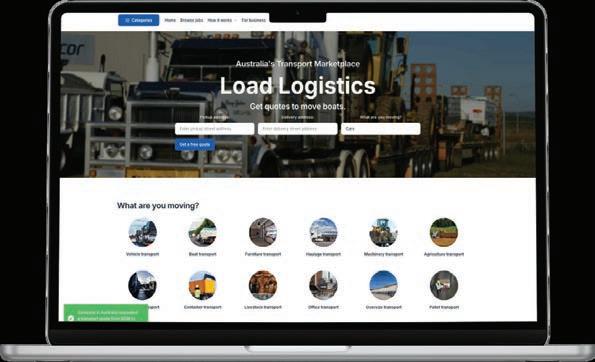


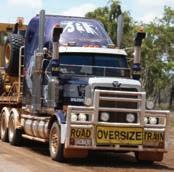
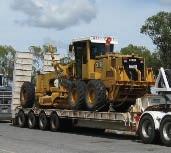
Every part of a trailer matters when you are hauling serious weight. SAMPA’s trailer equipment works quietly underneath and in the background so everything stays steady. Landing gears hold firm during loading and parking, kingpins keep your connection solid through every mile, and wheel chocks add that extra layer of
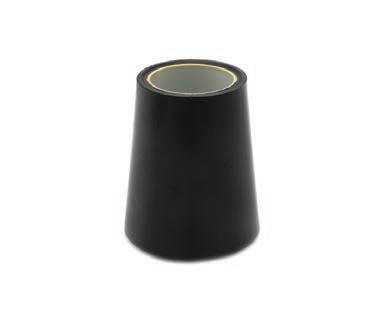
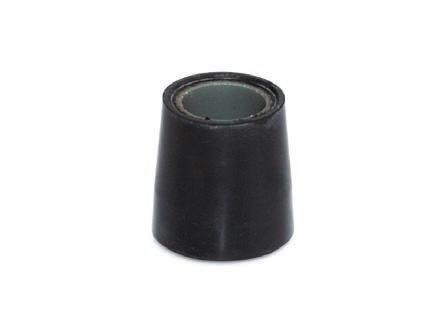
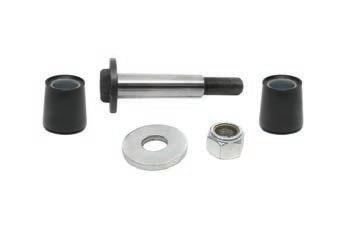
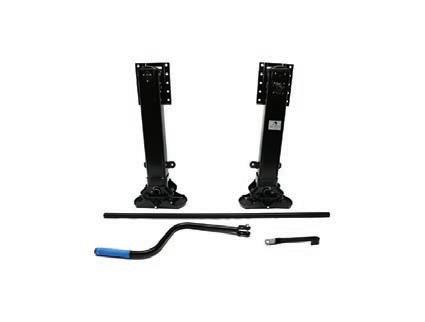
safety when parked up. More than just parts, they are the reason your trailer stays steady, secure, and ready to face whatever challenges come your way. When your load is heavy, your equipment shouldn’t be a heavy question mark. That’s why professionals choose SAMPA.
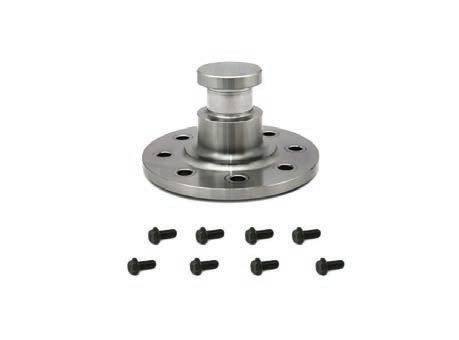
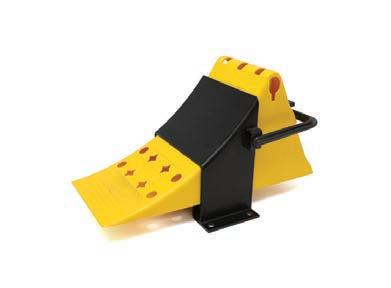
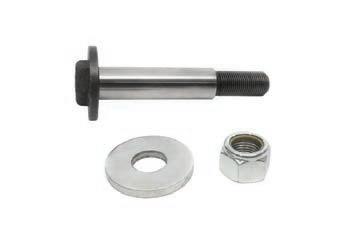
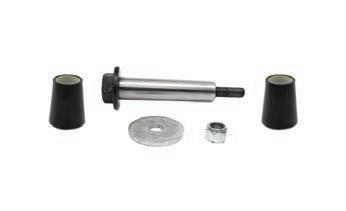
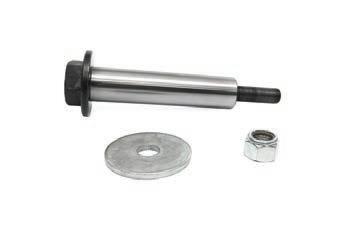
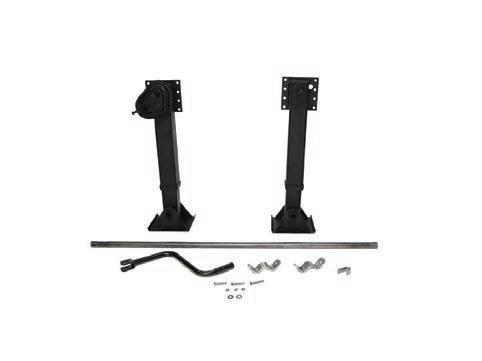
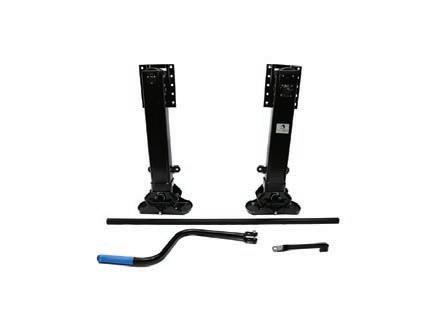
AS the countdown to harvest begins, farmers and contractors across Australia are gearing up for one of the busiest times of the year. With late September marking the official start of harvest for many regions, now is the critical time to prepare your machinery – not when you’re a lready out in the paddock, racing against weather forecasts and tight schedules.
A ny seasoned operator knows the frustration of equipment breakdowns. A simple stuck coupling, a clogged hydraulic line, or a seized connection can bring your entire day to a halt. In an industry where every hour counts, downtime during harvest isn’t just inconvenient – it’s costly. That’s why smart operators are taking steps now to protect their gear and avoid preventable setbacks.
One brand making waves across the agricultural sector is PT Blueboys. Their Australian-designed range of silicone coupling covers and
solution for protecting air, hydraulic and electrical couplings from dust, dirt, moisture and damage. So, what makes PT Blueboys products so important as harvest approaches?
Firstly, prevention is key. During harvest, your machinery works harder than at any other time of the year. Dust and debris are everywhere. Without proper protection, it doesn’t take long for contaminants to enter your couplings, leading to corrosion, blockages and stuck fittings. Every farmer, truckie and equipment operator knows the frustration of wasting precious time fighting with seized couplings when you should be in the field or on the job.
PT Blueboys products provide a simple yet highly effective solution. Their flexible silicone covers and plugs are easy to install and remove, sealing your couplings against the elements and protecting them from the harsh conditions that harvest inev-
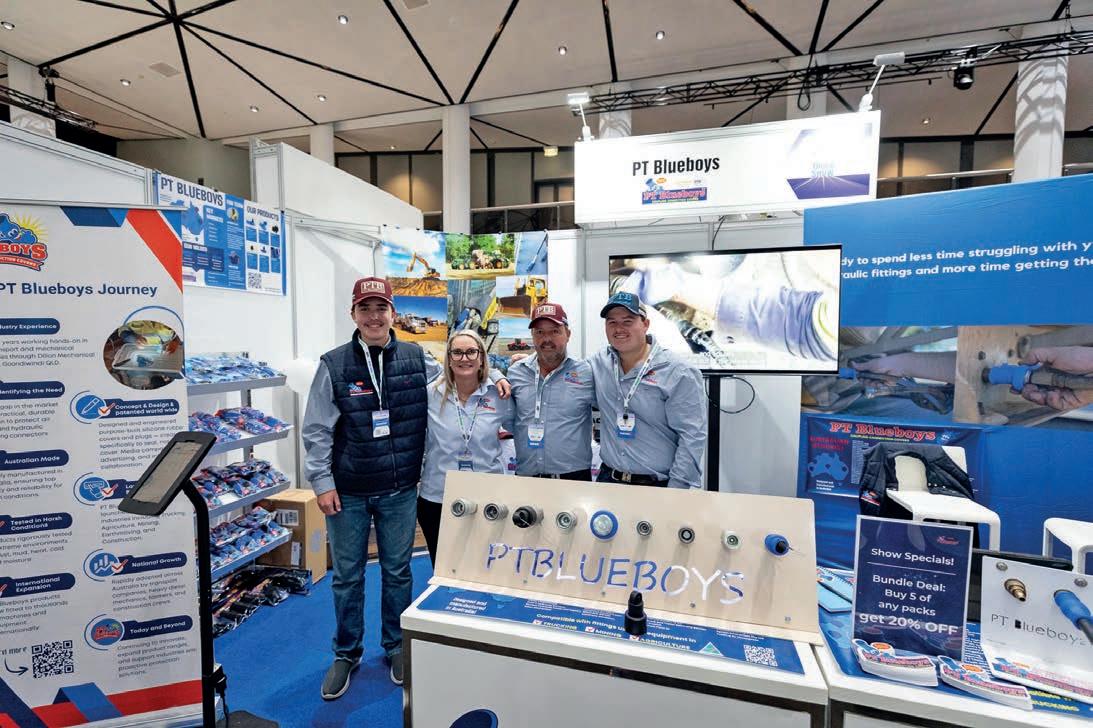
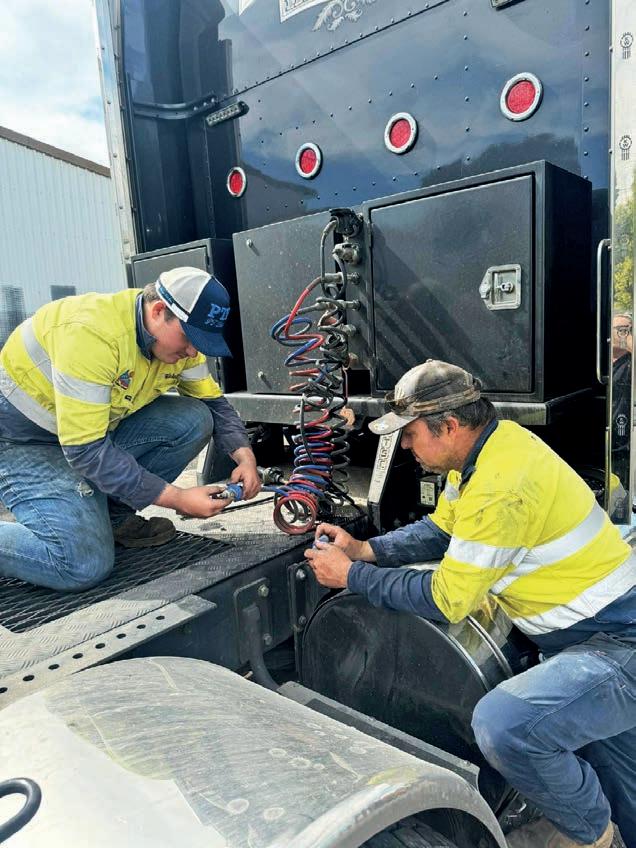
Secondly, there’s the financial impact. Breakdowns don’t just cost time – they cost money. Every minute spent dealing with blocked or damaged connections is a minute your machine isn’t working. Repairs, callouts and lost productivity add up quickly. By protecting your equipment now, you’re not only saving yourself from headaches in the paddock but also protecting your bottom line. Finally, it’s about peace of mind. Heading into harvest with clean, protected couplings means one less thing to worry about. PT Blueboys products are built tough for Australian conditions, designed by people who understand the demands of farming and heavy machinery. They’re not just a product – they’re a practical investment in your harvest’s success.
So, as you prep your tractors, headers, chaser bins, transport rigs and equipment this August, ask yourself: are you ready for harvest?
Be prepared. Keep your frustrations down. Keep your gear running smoothly. And protect your investment with PT Blueboys. Because when harvest arrives, you’ll be glad you did.
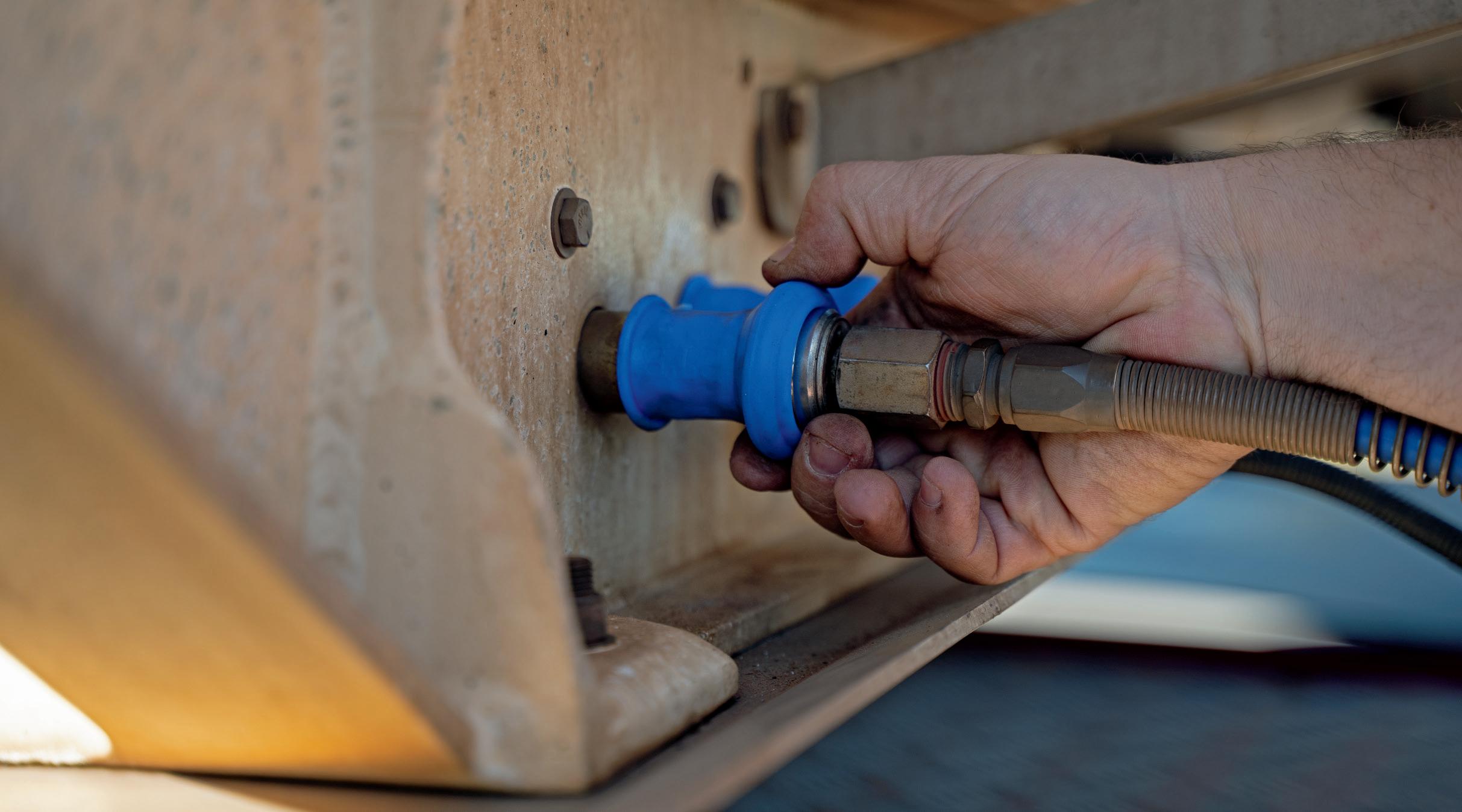



FOR fleet operators and transport businesses, braking performance isn’t just a matter of vehicle mechanics – it’s central to safety, efficiency and uptime. In Australia’s diverse heavy vehicle landscape, where both European and North American trucks are widely used, understanding the differences between braking systems can have a real impact on fleet operations.
A key point of divergence lies in how braking signals are transmitted from the truck to the trailers. European trucks are equipped with Electronic Braking Systems (EBS) that use a high-speed CAN (Controller Area Network) signal to communicate with all trailers in the combination. This allows for fast, coordinated application and
release of brakes across the entire combination, which becomes especially important at high speeds or in longer combinations.
In contrast, North American trucks typically only output a pneumatic brake signal to trailers which introduces a natural delay between the driver’s input and the braking response of each trailer. That delay can be critical – particularly in long combinations, where the rear trailer can lag significantly in responding.
At highway speeds, even a small delay in trailer brake response can make a big difference to how a heavy vehicle combination behaves. For example, in a typical A-double
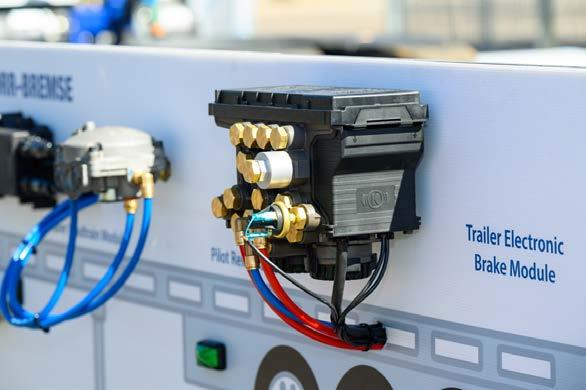
combination traveling at 100 km/h, the rear trailer may lag by as much as 18 metres before initiating its braking response after the driver applies the brakes. During that time, the rear trailer continues to push forward, reducing overall stability and increasing stopping distances. The same challenge appears during acceleration. Because pneumatic signals also delay brake release, the rear trailers can continue dragging brakes even after the driver has begun to accelerate – impacting fuel efficiency and contributing to premature brake wear.
Electronic braking systems eliminate these issues by transmitting brake and release signals instantly across all trailers. This ensures a simultaneous re-
sponse throughout the entire combination – resulting in a more consistent perfor mance, improved handling, and a safer, more predictable driving experience, especial ly in demanding operating environments.
Knorr-Bremse has developed solutions to help operators unlock the benefits of elec tronic braking. The Trailer Roadtrain Module (TRM) and Trailer Electronic Brak ing System (TEBS) are de signed to synchronise brak ing between the truck and its trailers – regardless of whether it’s a European or North A merican vehicle.
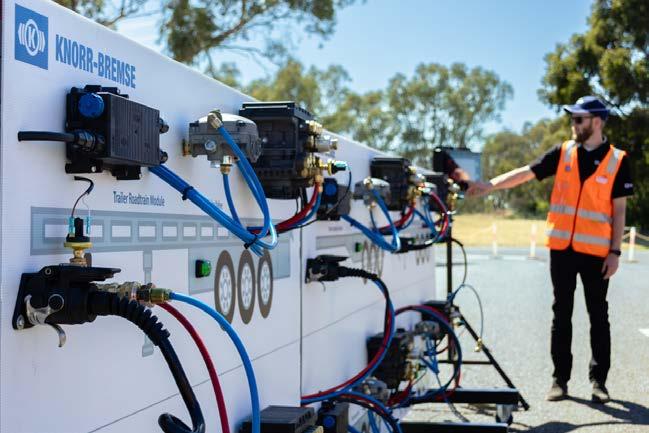
The benefits of electronic braking can be unlocked by
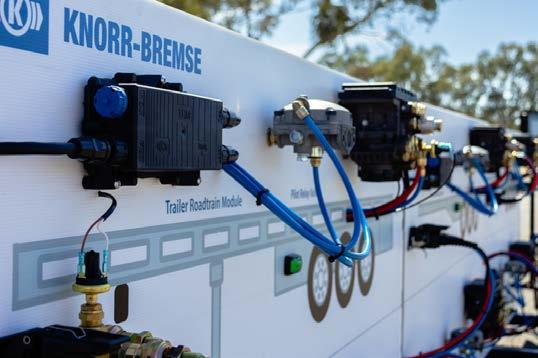
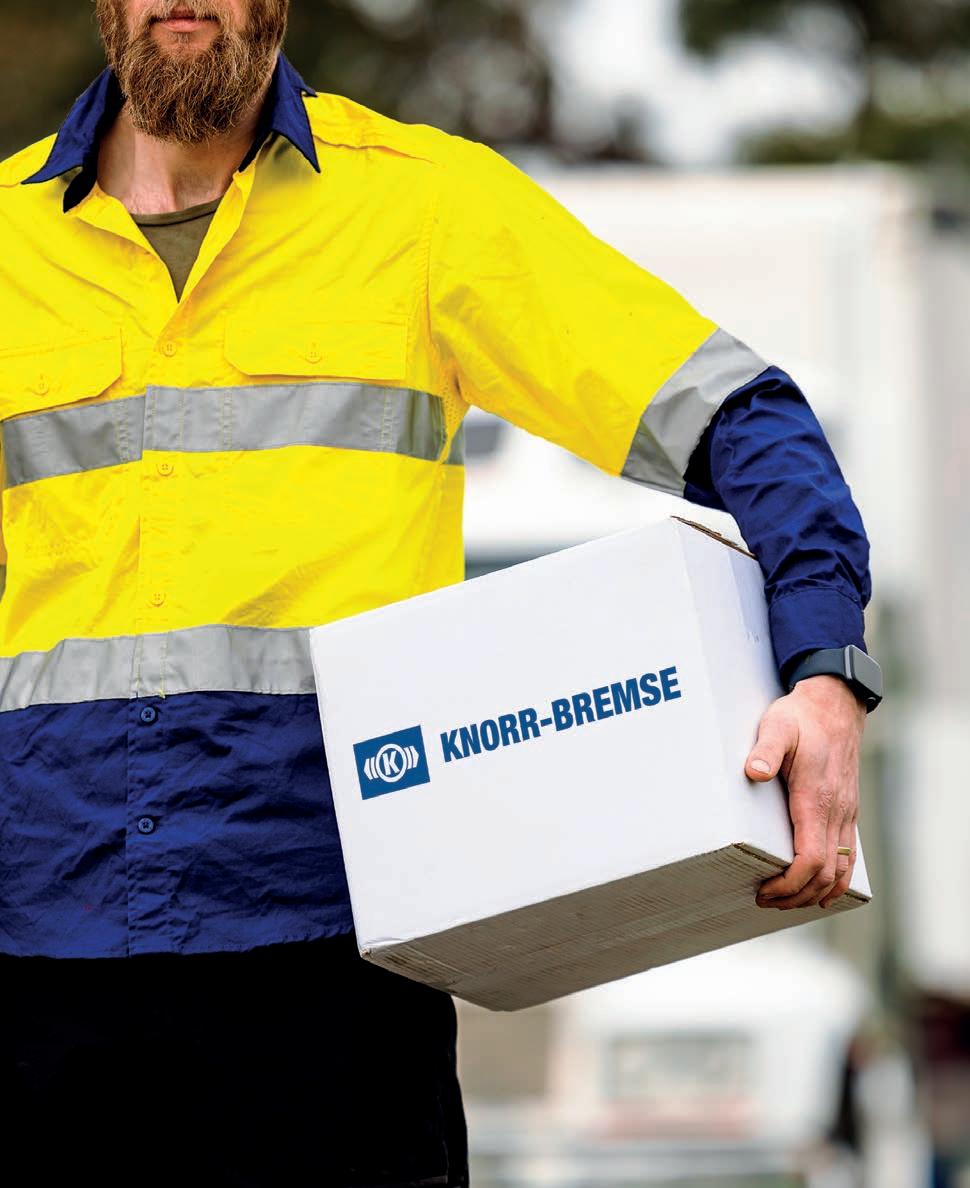

retrofitting a TRM onto the truck. The TRM converts the pneumatic signal to an electronic one and delivers that message down the trailers to improve brake response timing within the whole combination.
Fleet operators are constantly balancing performance, compliance and cost-efficiency. As braking systems become more sophisticated, aligning your fleet with modern braking technology isn’t just about ticking a technical box – it’s about reducing risk and improving operational smoothness.
Knorr-Bremse continues to support the Australian transport sector with intelligent solutions that improve vehicle performance and safety. With access to local support, spare parts, and a network of service partners, operators have the tools to modernise without disruption.
Whether you’re operating North American trucks, or managing mixed fleets with both vehicle types, upgrading to electronic trailer braking can deliver measurable benefits across your operation – improving safety, reducing wear, and keeping your trucks moving.
Unlock peak performance of your trucks & trailers with KnorrBremse‘s advanced retrofit solutions, designed to enhance safety and performance.
Our retrofit solutions, including the Trailer Electronic Braking System (TEBS) and Trailer Roadtrain Module (TRM), enable electronic braking, ensuring your vehicles meet modern standards with precise braking control and improved efficiency.
Contact your local Knorr-Bremse representative, a member of our Expert Network, or your local parts distributor for more information.
| truck.knorr-bremse.com/en/au/ |

HYDROSTEER, an Australian powerhouse in truck steering technology, has carved out a reputation as the go-to specialist for comprehensive power steering systems and diagnostics, delivering performance that truck fleets across the country rely on.
Hydrosteer’s extensive product line covers the full spectrum of truck power steering components.
Whether it’s a road train navigating the outback or a metro delivery truck weaving through city traffic, Hydrosteer has developed and supplied steering systems tailored to Australia’s diverse trucking needs.
Their inventory spans exchange, remanufactured and OEM steering gears, OE and aftermarket pumps, drag link assemblies, steering slip shafts, tie rod and draglink
ends, pitman arms, coolers, steering wheels and power steering reservoirs – each manufactured to standards for superior performance, durability and reliability.
In-house steering diagnostic services
Behind every exceptional product is exceptional service – and Hydrosteer’s in-house steering diagnostics highlights that commitment.
When truck steering issues emerge, such as stiffness, wandering, fluid leaks or unusual noises, the skilled technicians at Hydrosteer apply their deep expertise to identify and resolve the problem.
Their workshop features advanced diagnostic equipment capable of simulating driving conditions, measuring system flow and pressure (individually or simultaneously),
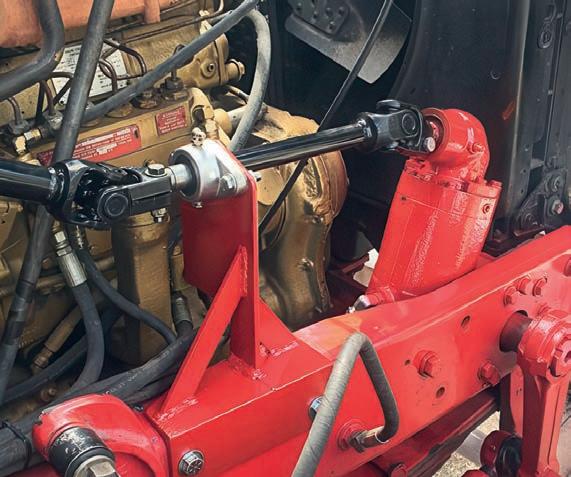
detecting worn components, verifying calibration settings and monitoring overall system performance. This hands-on approach allows Hydrosteer to offer not only repairs but tailored recommendations, including potential upgrades or modifications.
By keeping diagnostics inhouse, the company maintains complete control over quality and turnaround time, ensuring trucks return to the road quickly and with renewed confidence.
Custom solutions and reconditioning
Hydrosteer also recognises that one size doesn’t fit all. The team regularly works on custom steering solutions for unique truck configurations, including vintage rebuilds and high-performance conver
sions. For operators looking to reduce costs without sacrificing quality, Hydrosteer offers custom made steering components. These parts are manufactured under our ISO9001 manufacturing processes to meet or exceed original performance standards
Driven by trust, proven by performance
From fleet managers to owner operators, Hydrosteer continues to be a trusted name in the Australian trucking industry. A customer-first ethos, combined with technical excellence, has earned the company long-standing partnerships with globally recognised brands and a growing footprint across Australia. Trucks fitted with
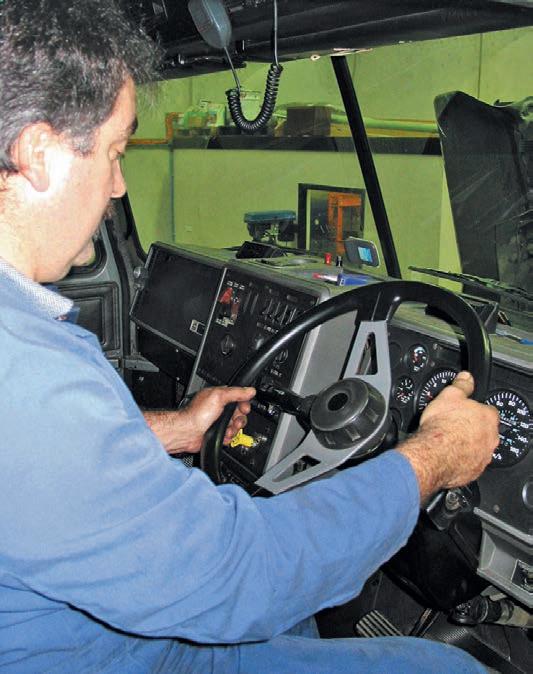
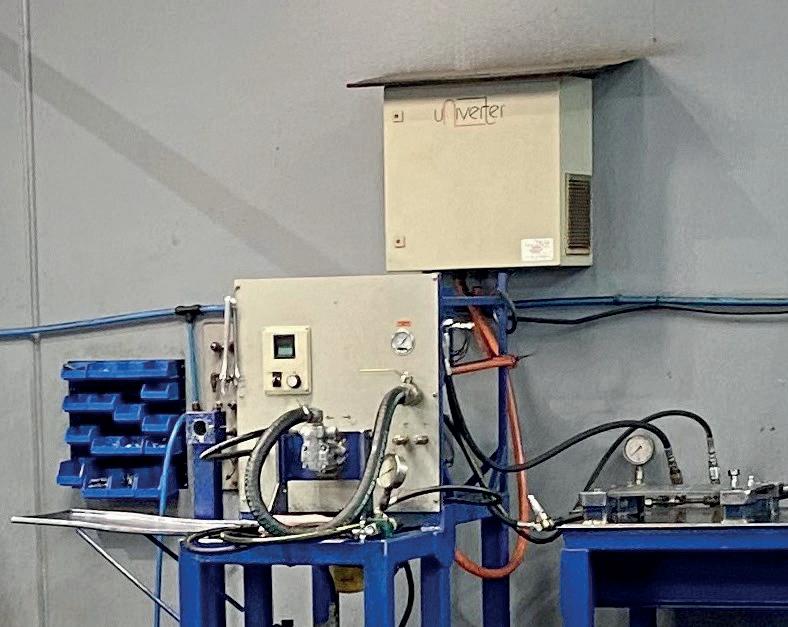
Whether you’re in search of an advanced power steering system or expert diagnosis to steer brings knowledge, quality
IN the world of transport, minimising downtime is critical. Whether you’re an owner-driver hauling interstate or a fleet manager overseeing 100 trucks, every hour a rig spends off the road cuts into your bottom line. That’s why reliability isn’t just a buzzword, but a necessity.
HELLA Australia understands that the transport industry runs on trust: trust in your gear, trust in your rig, and trust that every component will perform when it matters most.
has earned its reputation as a global leader in automotive lighting and electronics. Their
products are trusted by truck manufacturers, fleets, and drivers alike, not just because they meet industry standards, but because they’re built to exceed them. From the harsh outback roads to coastal salt air and freezing highlands, HELLA products are tested and proven in Australia’s toughest conditions.
One challenge we’ve seen across the industry is the complexity of wiring and fitting trailer lighting systems. Damaged cables, incorrect connections or poorly secured

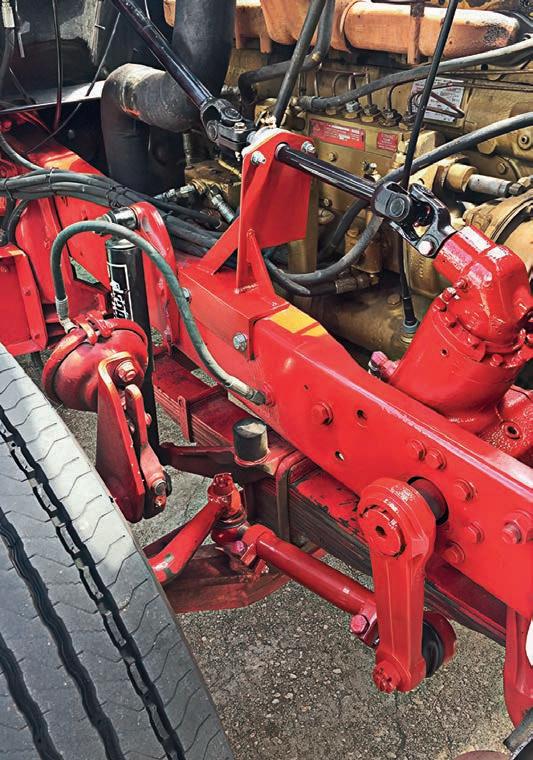
specialist tools. With its IP 6K9K rating, the Distribution Box also offers outstanding protection against water, dust and vibration which are key factors in maintaining consistent performance in harsh environments.
Fleet operators especially benefit from this system.
formance that professional drivers rely on. Whether it’s their iconic LED marker lamps, high-output driving lights or robust work lamps, each product carries HELLA’s hallmark of reliability, backed by rigorous testing and local support from HELLA Australia’s team.
HELLA’s commitment is simple: to provide lighting solutions that keep you moving, minimise downtime, and deliver peace of mind on every journey.
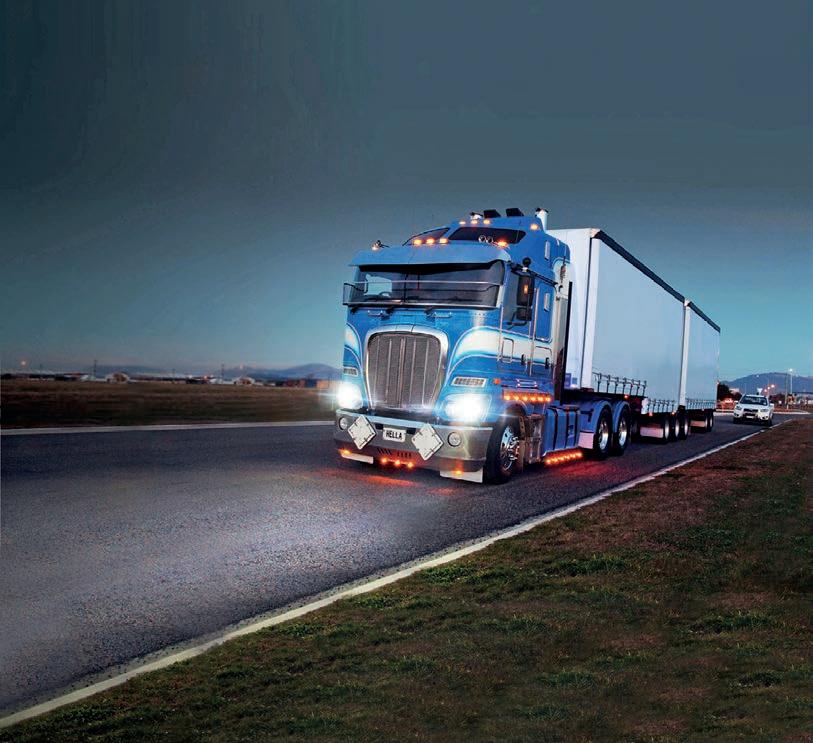
aches. In response, HELLA developed a smart, practical solution: the HELLA Lamp
Distribution Box. The Distribution Box is designed to simplify trailer lighting installation and make maintenance faster and easier. Instead of traditional wiring looms that require intricate connections and individual fault diagnosis, the Distribution Box provides a centralised, plug-and-play interface for all trailer lighting. It allows multiple lamps – such as tail, stop, indicator, clearance, and marker lamps – to connect via a single distribution module with pre-configured ports.
For drivers and operators, this means significantly reduced installation time and quicker repairs. In many cases, a faulty lamp can be swapped out in minutes with-
Standardising lighting connections across trailers simplifies fleet maintenance, streamlines inventory for spare parts, and reduces the risk of wiring errors during repairs. This translates into lower workshop costs and improved uptime, critical for any operation looking to maximise productivity.
Beyond the Distribution Box, HELLA’s lighting range
For more information on HELLA products, email info.au.hella@forvia.com, call 1800 061 729 or visit the website at hella.com/ australiansolutions.
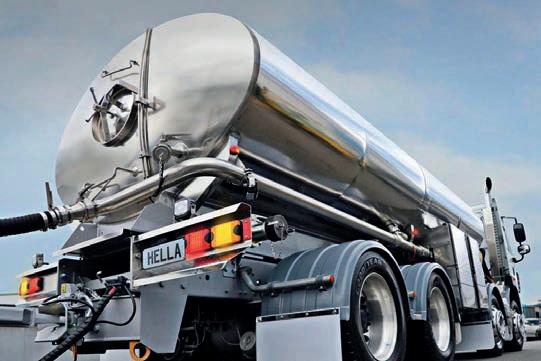
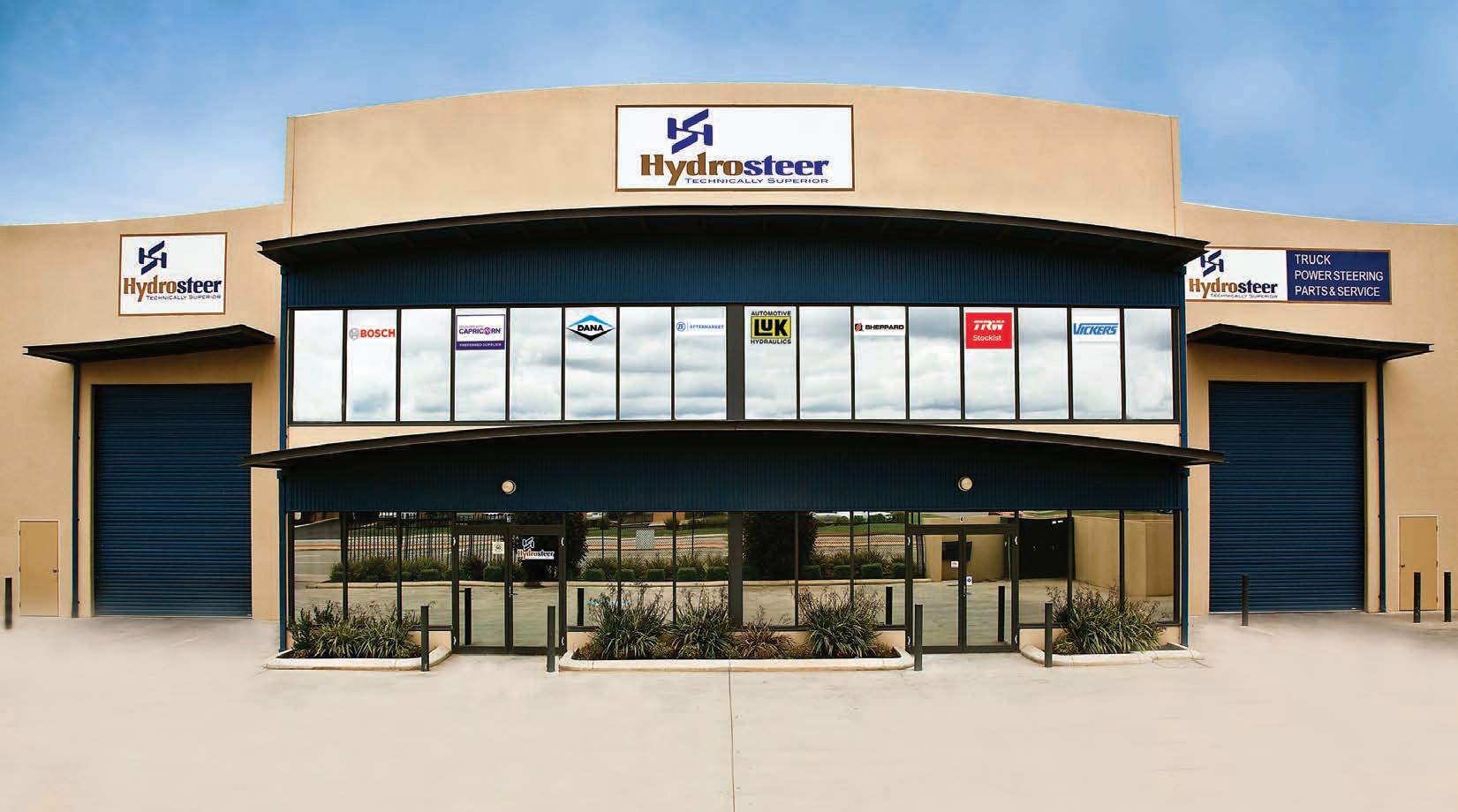
Hydrosteer, Australia’s largest heavy vehicle power steering specialists, carrying Australia’s largest range of heavy vehicle power steering and commercial vehicle power steering products. The range includes the following:
• New and re-manufactured power steering gears, R.H. Sheppard, TRW/ Ross, ZF Steering Systems, Bosch, JKC, Aisin Seiki and Koyo
• Steering pumps to suit all makes and models. (ZF, TRW, Vickers and more)
• IMMI (Formerly VIP) steering wheels

• Steering slip shafts
• Australian Made Mitre boxes and R.H. Sheppard.
• Drag link assemblies that are made to OEM`s stringent quality specifications.
• Oil reservoirs, filters and parts
Hydrosteer have 4 fully equipped workshops in Bayswater Victoria, Laverton Victoria, Maddington W.A., and Wetherill Park New South Wales*. Workshop services include steering system diagnosis, steering system optimisation, full driveway service*, steering gear remanufacturing, pump refurbishment, Dual Control Conversions, LHD to RHD conversions, Road-Rail Vehicles. All completed by qualified technicians with years of experience in heavy vehicle power steering systems. Whatever your heavy vehicle steering system needs are Hydrosteer has you covered, and all our products and services come with a 12 month “No Argument” warranty


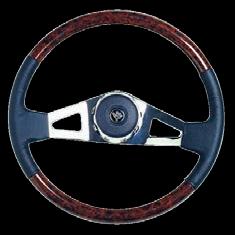
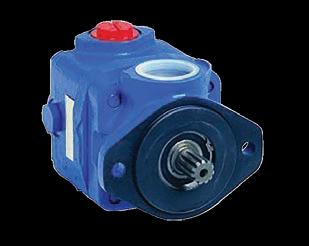

PROUD AUTHORISED

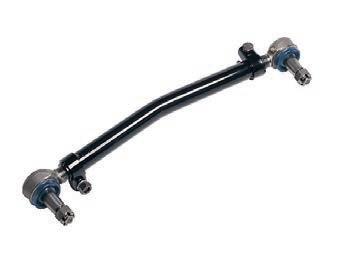

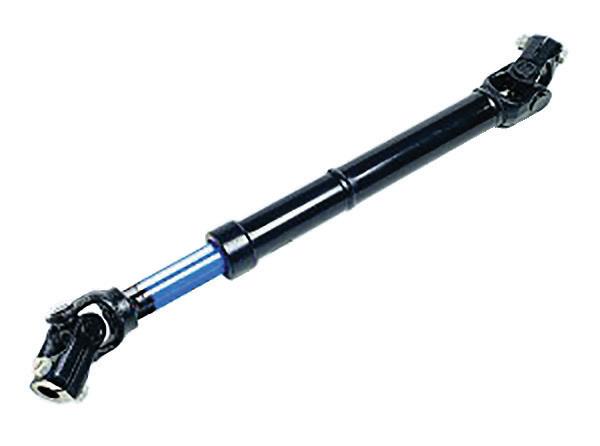
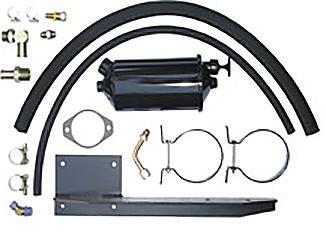
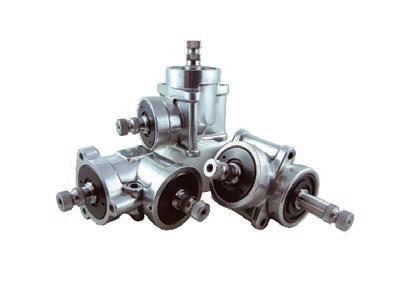
AUSSIE CTI Systems has designed, built and tested our components to suit Australia’s tough, demanding conditions, giving transport operators a simple, safe and reliable means of controlling tyre pressure from the cabin. The team is headed up by Andrew Kee and includes Stuart, David and Nik (names that many in the industry will recognise). This experienced team is passionate about the work that they do and offers more than five decades in CTI design, development and manufacture. They know the job and what works best for your operation.
CTI is no longer an untried and yet to be proven concept but is now known as a crucial and invaluable option offering many benefits for drivers and vehicles. The industry acknowledges this, and many contracts now have a requirement for a CTI system to be fitted to all their haulage trucks. Let’s look at the benefits.
Increased traction

Many industries benefit enormously from the use of Aussie CTI Systems. Here’s how.
Log haulage: Traction is improved 2.5 times. Tyre life is often doubled. This results in up to 60 per cent less road damage.
Road trains: Tanami, Tropicana and Gibb River roads are a challenge, along with many others. Large corrugations, gravel roads and gibber rock require reduced tyre pressures on the drive and steer tyres.
Tippers: Running 90 PSI on the drive tyres, loaded on bitumen, 60 PSI on gravel and 30 PSI empty allows best traction and reduces the likelihood of jack knifing.
Electrical service industry: EWP and pole trucks. Two big benefits for this industry are maximum traction which reduces bogging and the ability to use 2x4 and 6x4 trucks where traditionally 4x4 were used.
Beekeepers: The main benefits offered here are traction which reduces the chance of being bogged when servicing hives and the reduction in vibration which reduces stress and death for bees and cracked honeycomb when transported.
Reduced tyre wear
By maintaining optimal tyre pressure, Aussie CTI reduces tyre wear, often extending the
Aussie CTI allows you to adjust the tyre pressure according to road conditions. This feature allows for better traction and safety on loose, wet o vehicle mobility. Traction is increased by up to 2.5 times, giving you the equivalent of 20 drive tyre footprints instead of eight.
replacement costs. It reduces punctures and all but eliminates blow outs.
Improved fuel economy
Proper tyre inflation reduces rolling resistance and improves fuel economy, therefore saving operators money.
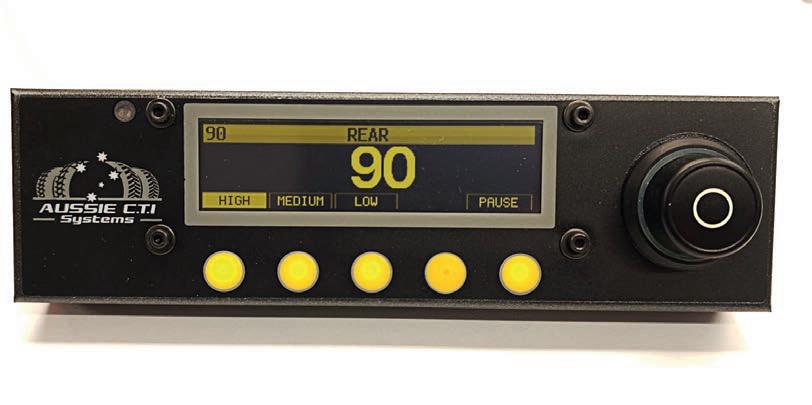
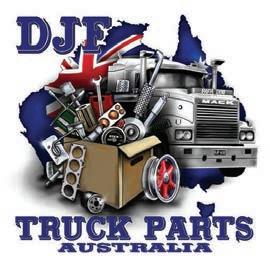
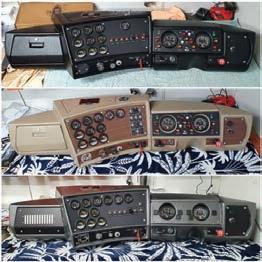
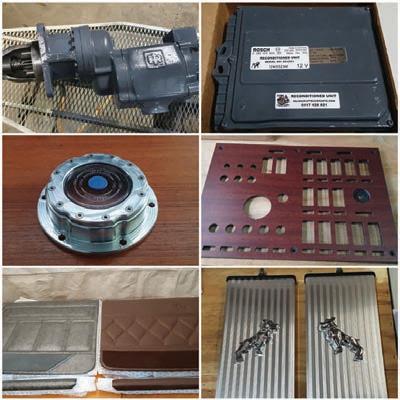
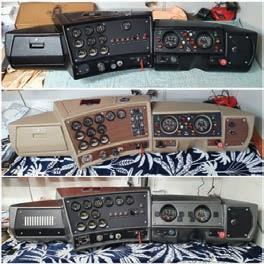

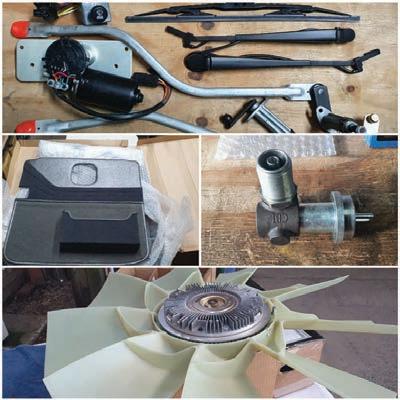
tribute to the vehicle’s stability, helping to prevent rollovers and other accidents.
Reduced maintenance costs
Aussie CTI helps reduce shock which prevents truck vibration and damage, reducing maintenance costs, which can be expensive in terms of downtime and repairs.
Improved safety
Properly inflated tyres contribute to better vehicle handling, reducing the chance of jack-knifing with up to 20 per cent shorter braking distance
– thereby enhancing overall vehicle safety.
Enhanced off-road capability
Aussie CTI allows drivers to lower tyre pressure when off-roading, increasing the vehicle’s ability to traverse challenging terrain.
Improved driver comfort
Properly inflated tyres contribute to a smoother ride, reducing whole of body
vibration by up to 60 per cent which reduces driver fatigue and improves comfort.
Better resale value
Well-maintained vehicles with properly inflated tyres tend to have better resale value, which can be important for companies looking to upgrade their fleets.
For more information, call Andrew Kee on 0459 222 137.
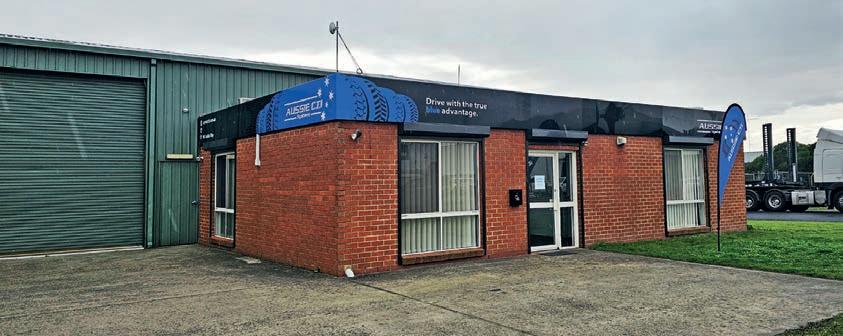

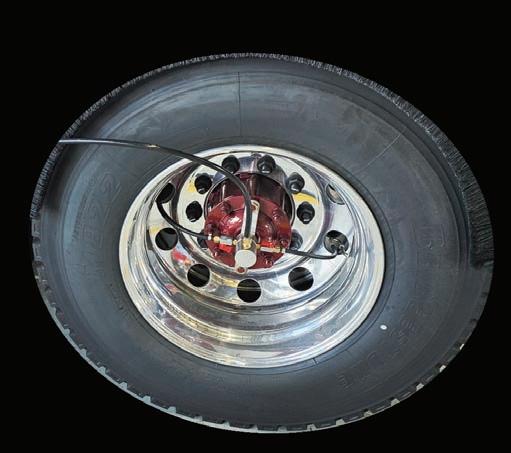
COMPLETE Steering Australia (CSA) provides commercial truck and bus steering services and products for US and European heavy vehicle brands – including Kenworth, Western Star, Freightliner, Mack and Volvo to name just a few.
CSA offers the largest range of heavy vehicle power steering products in Australia, covering a wide array of makes and models.
Its history dates back to 1988, when Complete Truck Alignment was established. Then in 1999, the business was approached by TRW and a new identity was formed as Complete Steering Australia (CSA).
In 2001 CSA expanded and moved to its own location in
Laverton North, Victoria. Today, CSA has locations in Melbourne and Brisbane – and it provides a full driveway service for both on-truck and bench work.
At CSA, you’ll find leading global brands including R .H. Sheppard, ZF/TRW Aftermarket, Bosch, Hema, Vickers, and high-quality aftermarket options, providing both premium and cost-effective solutions.
A s a proud Tier 1 supplier and remanufacturer, CSA works closely with numerous OEMs in the manufacturing sector.
CSA has long been a leader in the truck and bus power steering industry, known for decades of innovation and patented designs, including
its Australian designed mitre boxes and I-shaft manufacturing.
CSA’s commitment to excellence has made a significant impact on the industry. At CSA we ensure every product meets strict original equipment quality standards, backed by our ISO9001-certified development and manufacturing processes for both remanufactured and new products.
We are especially proud of our Australian made products, with the official green and gold triangle seal of approval. Our patented range of Australian made mitre boxes (available in 90-degree, 120-degree, and 3-way) offers unrivalled reliability, ensuring your vehicles per-
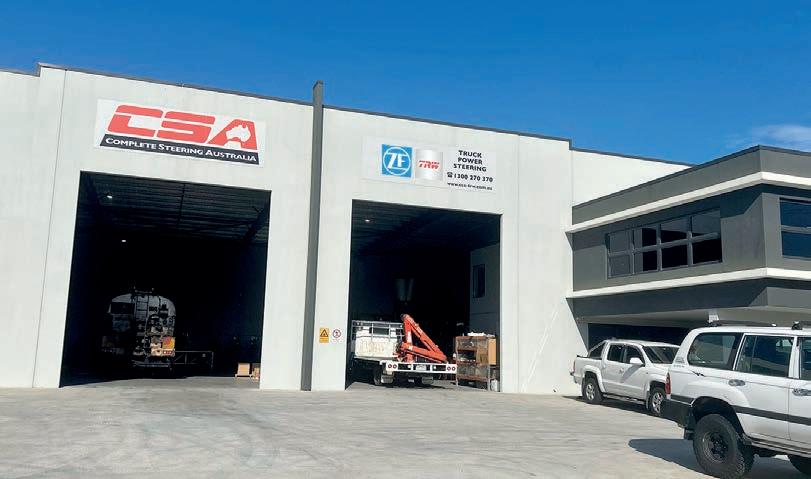
form at their best.
CSA’s mitre box is a direct replacement for the TRW mitre box and features smoother operation, nil backlash, and minimal rotating drag in a smaller package that is lighter in weight.
While its I-Shaft design has revolutionised the industry, gaining support from fleets and owner operators who benefit from improved steering feel and dynamics. CSA’s I-Shaft is a smaller overall size than others for easier fitment, has reduced operational sliding spline drag and a low slip load that attributes to smoother steering feel with quieter operation. It also features replaceable and greaseable universal joints and can be retrofit into current applications.
CSA also provides comprehensive driveway services, including repair for all makes of trucks and buses, with quick turnaround options using remanufactured steering gears and power steering pumps.
Our full-service diagnostics include mechanical inspections, as well as pressure and flow testing. Additionally, we offer in-house remanufacturing of steering columns – true to our name, Complete Steering Australia.
For more information, call Complete Steering Australia on 1300 270 370 or drop in to our Melbourne or Brisbane locations.

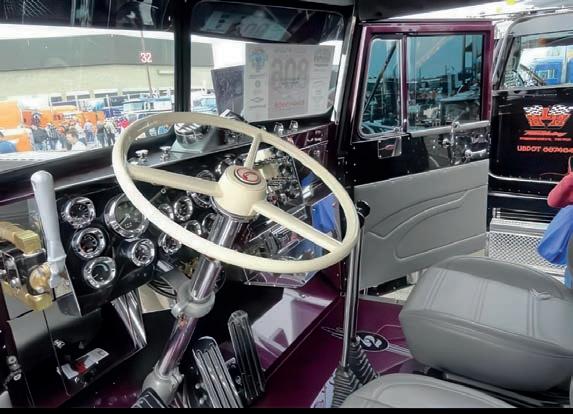
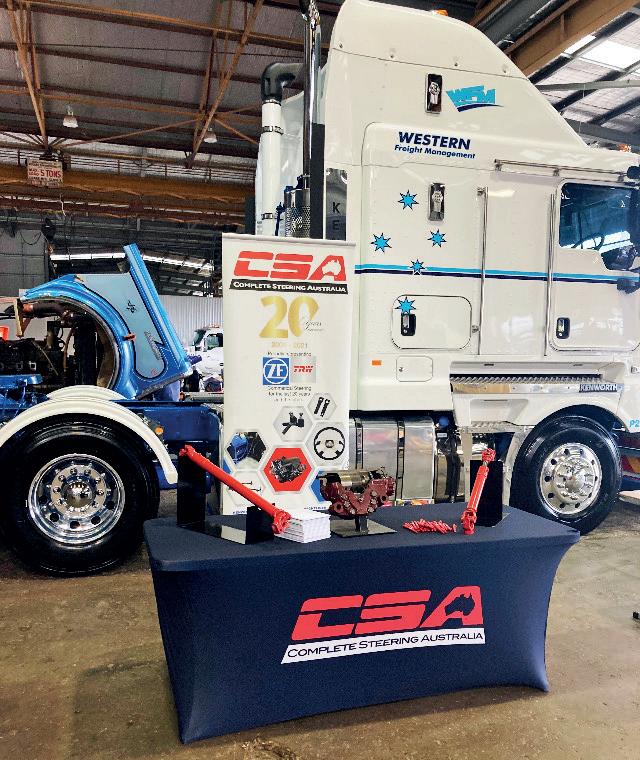

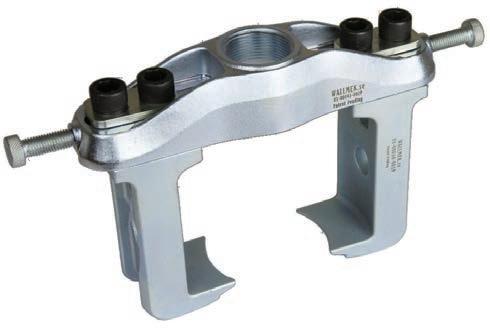

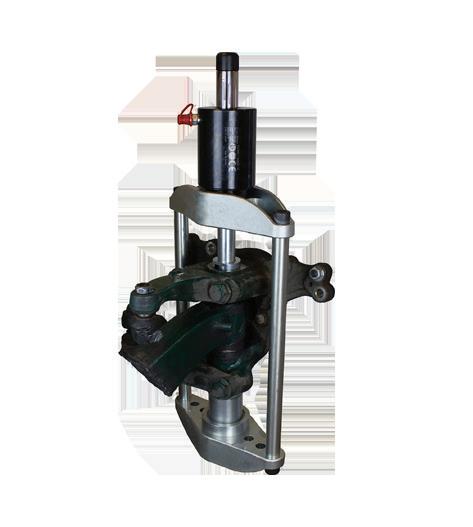
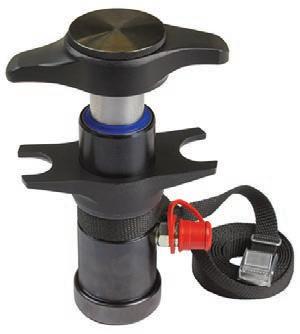
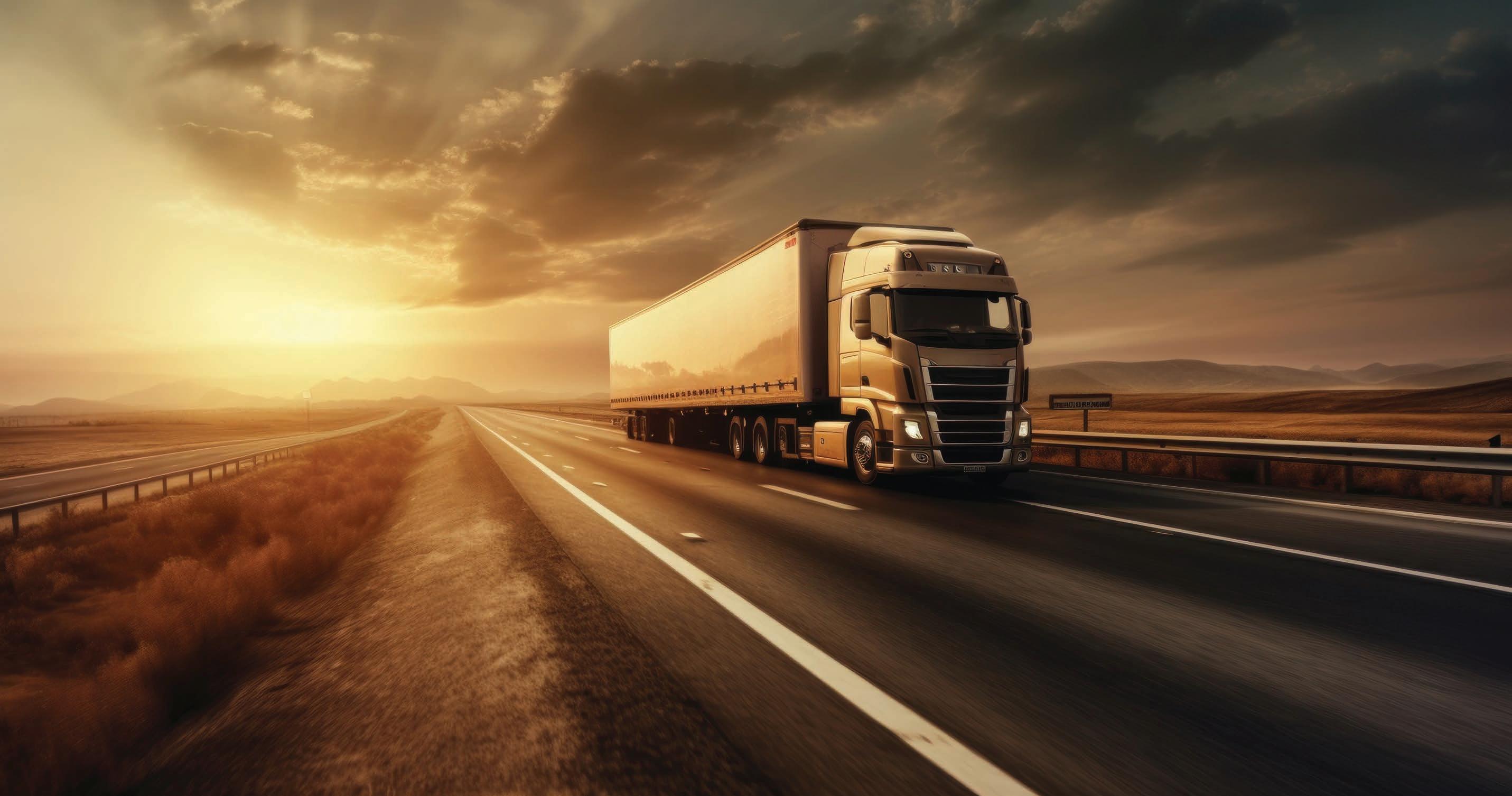
WHEN it comes to nighttime driving, having a reliable set of lights is critical.
And that’s especially important for truck drivers who are often behind the wheel for long stretches of time, facing dark roads, unpredictable weather and everything else that being on the road throws their way.
Great Whites LED lights feature advanced LED technology, which produces an intense beam that can reach far ahead, illuminating the road and any potential hazards.
For truck drivers who may be carrying heavy loads or driving on unfamiliar roads, this is particularly essential.
The high-quality beam produced by Great Whites LED lights ensures drivers can see obstacles in their path and react quickly to avoid them.
Great Whites has unveiled two new innovative headlight solutions to its catalogue, the 7” LED Headlight (GWF1005/GWF1005CH) and 7” High Beam Headlight (GWF1010/GWF1010CH).
Available in black or chrome finish, the headlights deliver greater performance with
long lasting LEDs. As with the previous Great Whites headlights, they are certified as ADR compliant for RHD vehicles.
The GWF1005 incorporates both park and indicator lights and includes class 1 amber strobe lights that can be synchronised across both headlights. This innovative advancement allows for greater visibility and ensures you are safe on the road without the need for installing additional warning lights or strobes and beacons on your truck.
The GWF1010 features LED park lights, and is an ideal replacement for factory sealed beams or 7” halogen lights.
With a smarter, more intense light source, Great Whites deliver greater performance with long lasting LEDs. Featuring full ADR compliance for RHD vehicles and incorporating both park and indicator lights, these headlights also include class 1 amber strobe lights that can be synchronised across both headlights. A new design with improved UV stabilisation, it’s still tough as nails and de-
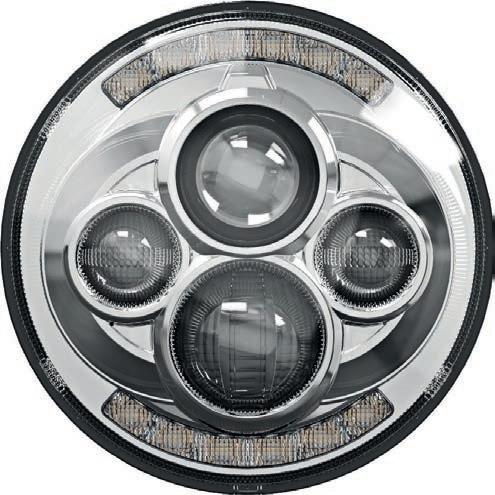
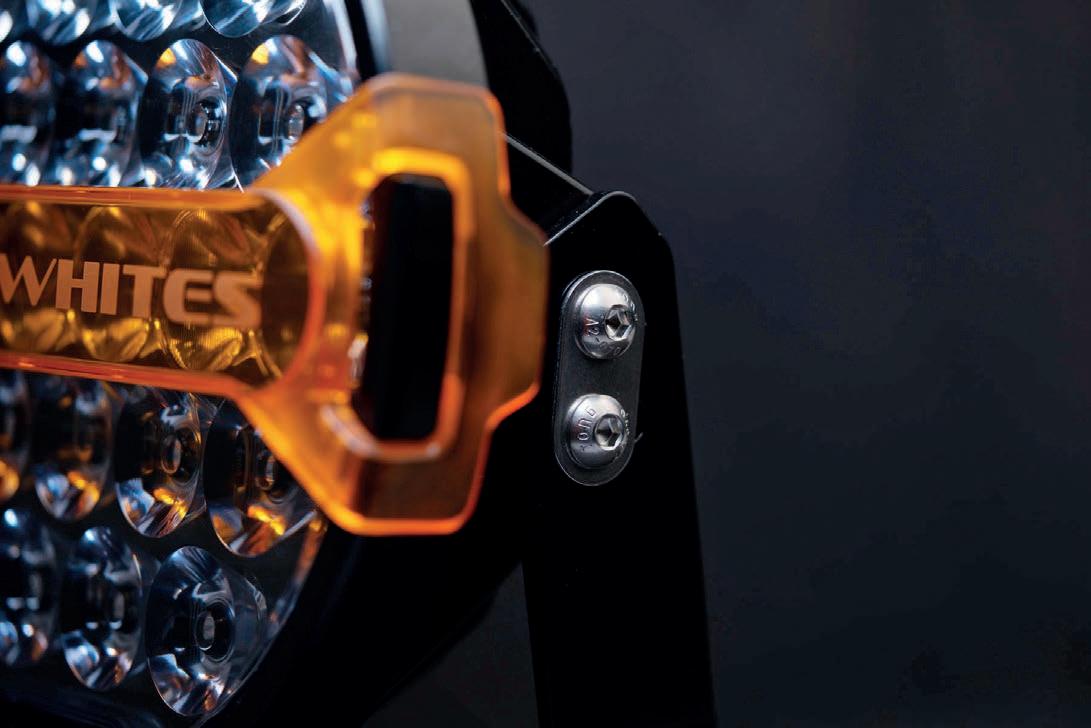
veloped to last in the world’s toughest conditions.
Control the beam for the conditions
Great Whites has also un veiled its new innovative Ad justable Beam Technology (ABT).
ABT allows you to fully control the beam pattern to best suit driving conditions with the turn of a 2-stage dial. Easily switch the lights be tween full flood light, full spotlight, or both, plus you can separately control the brightness of each, for a per fectly tailored combination beam.
Kits include two driving lights, driving light harness, dial switch, and two amber covers. Available in 170mm kits or 220mm kits.
Available at your local NAPA store, contact your local rep for more information.
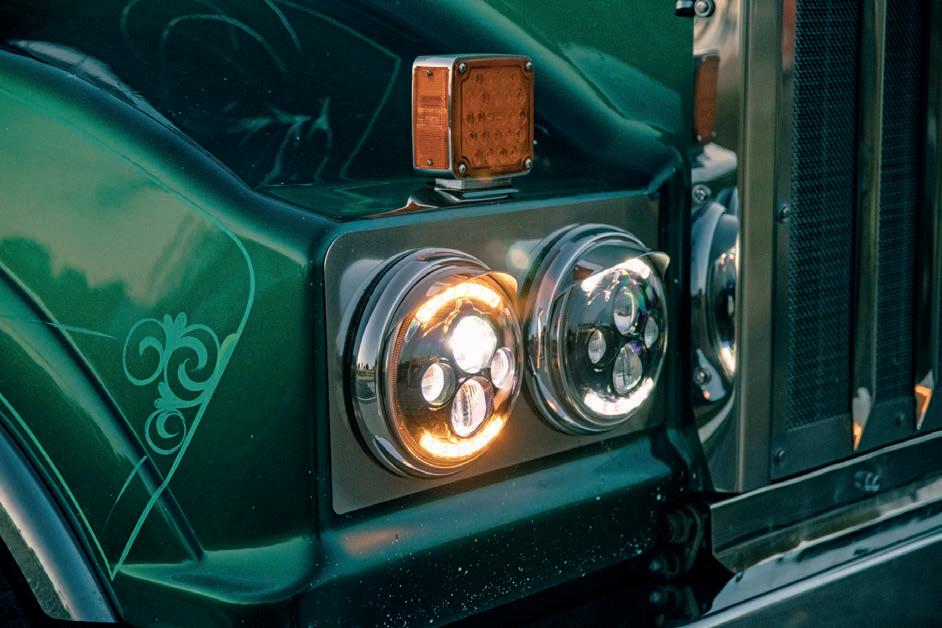
AS Wettenhalls marks its milestone 100 year anniversary, the company has welcomed 10 new Mercedes-Benz Actros trucks into its Queensland and Victoria fleets.
Reginald Amezdroz was working at a western Victo
rian dairy as a cream tester and boiler attendant when he saw an opportunity to buy a truck and deliver the company’s product from Colac to Melbourne in 1925. And that marked the start of Wettenhalls.
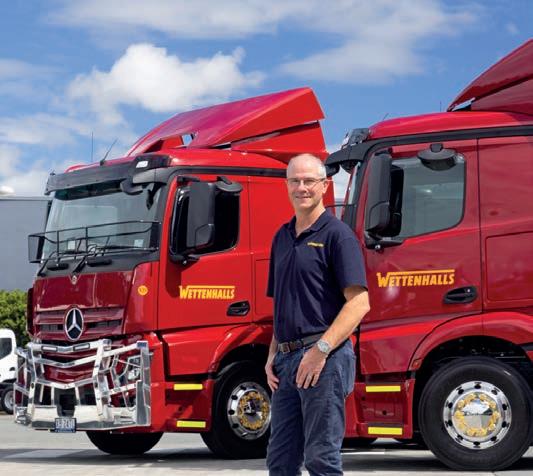
The company still delivers products for the same dairy to this day.
While back then ice was needed just to keep fresh cargo cool, the company’s fleet of trucks have come a long way.
The new Wettenhalls Actros models feature a raft of technology to reduce emissions, save fuel and operate as safely as possible.
When cruise control is activated, they use GPS data for road map information to coast in neutral whenever possible to save fuel and also change gears at the optimum moment.
Two Wettenhalls 2653 Actros models with single trailers have been delivering bread out of Brisbane since April, while eight of the same trucks have been added to its Melbourne operations for use as A-doubles.
The first two trucks immediately recorded best-in-fleet f uel efficiency for that partic-
ular application, demonstrat ing the fuel economy of the Mercedes-Benz Actros.
Head of Fleet at Wetten halls, Marcus Prato, says he’s pleased to welcome the Mercedes Benz trucks into the fleet.
“It’s early days, but we are seeing positive gains in fuel consumption and drivers are enjoying the comfort levels,” Prato said.
“The advanced safety fea tures the Actros offers and support locations were key drivers in Wettenhalls’ pur chasing decision.”
Daimler Truck and Bus
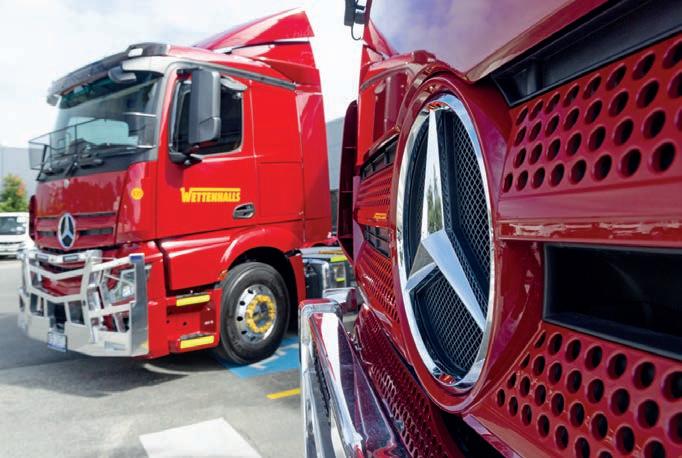
Australia Pacific President and CEO, Daniel Whitehead, added, “To see Mercedes-Benz trucks in Wettenhalls colours is very exciting wherever you’re from, but it is particularly special for those of us from western Victoria who understand how iconic this company is in the region.”
While Daimler Truck Aus-
tralia Pacific Daimler Truck Australia Pacific Sales and Marketing Vice President, Andrew Assimo, commented, “We are delighted the Wettenhalls team has given us the opportunity to demonstrate how the Mercedes-Benz Actros can significantly reduce fuel consumption using
long-proven Euro 6 technology, while providing the highest levels of safety.”
The 2653 trucks that have joined the Wettenhalls fleet feature a 13-litre six-cylinder OM471 engine that produces 530hp and is teamed with a 12-speed Automated Manual Transmission (AMT).








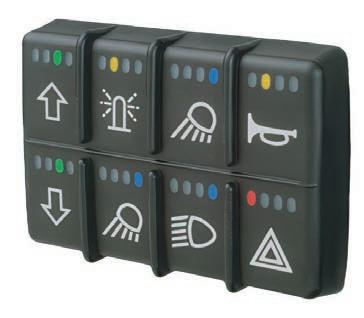


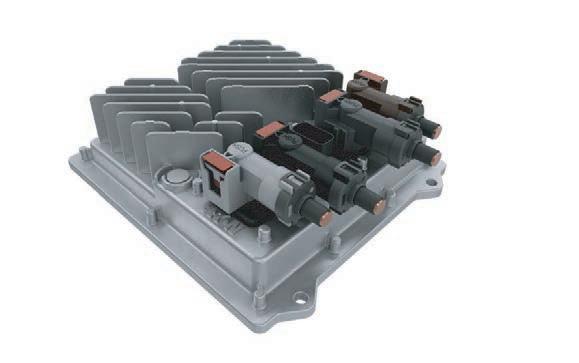
BY ALF WILSON
OWNERS of an outback roadhouse, at which business with truckies has been booming, have decided to temporarily close to make way for renovations and an upgrade of facilities.
The Bluewater Springs Roadhouse is located along the Gregory Development Highway, about 110 kilometres away from Charters Towers, and 100 kilometres away from Greenvale in the other direction – in north Queensland.
It sits on a popular inland route for drivers who don’t want to use the notorious coastal Bruce Highway to gain access to and from the Atherton Tablelands and Cairns.
W hen parts of the Bruce Highway are flooded, this is also a vital alternative route to keep supplies flowing.
Many truckies also detour the western Flinders Highway and travel the Hann Road, before using the Gregory Development to reach Townsville along the Hervey’s Range route.
A variety of trucks pull up at the roadhouse including those carrying livestock, minerals, food, machinery, equipment and other freight.
Two years ago the roadhouse was purchased by Jody Rankine who had been at Malanda. She took over from former long-time owners Geoff and
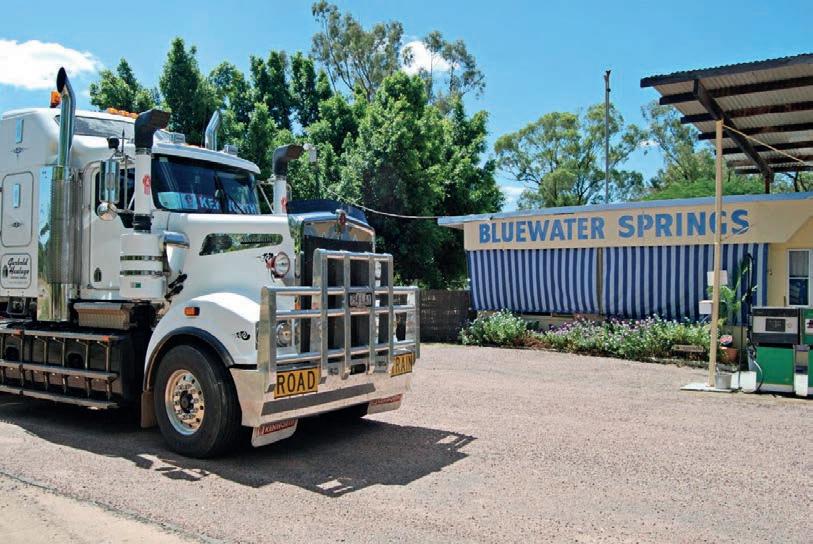
Melissa Bolster. Several truck drivers have recommended Bluewater Springs to me including Mount Garnet small fleet owner Brian Smith.
“It is a great place to stop and the staff are very friendly and make us feel welcome. You can park easily and pick up good food,” Brian said.
Jody added that at least 20 trucks a day stopped there.
At the roadhouse, she’s assisted by her 17-year-old daughter Rosie and local Amanda.
“We look after the truck drivers and many order our steak or barramundi burgers, rump steak or a big breakfast. We source fresh food and our barra comes from a fisherman at K arumba,” Jody said.
Open seven days a week between 6am and 8pm, Jody said
South Australia have stopped there when in the area, after it was recommended by other truckies.
I had phoned the roadhouse several times and Jody or Rosie had to pause the conversation because trucks had pulled up and required service – such is their commitment to drivers.
But I did manage to contact Jody during a quieter period and she dropped the bombshell that the roadhouse would be closing on July 27 for renovations.
Jody said it had been a difficult decision but was necessary to get the upgrades done to provide the best facilities for drivers.
“We will be closed for six to 12 months and the renovations
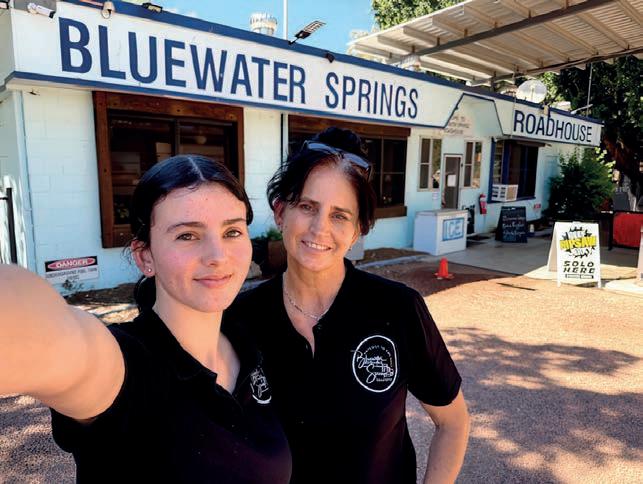
will be extensive and worth the wait. We have enjoyed growing the business and it is now time to get the renos underway for the next chapter of Bluewater Springs,” Jody said.
“There will be some amazing changes and more of your favourite barra, coffee and burgers.”
These major renovations will include new toilets and showers and a modern place to eat.
“When it is complete the drivers will love it,” Jody said.
The roadhouse has a long history of association with the road transport industry back from previous owners Ernie and Fran Datt, Laurence and Yvonne Heilbronn and the Bolsters.
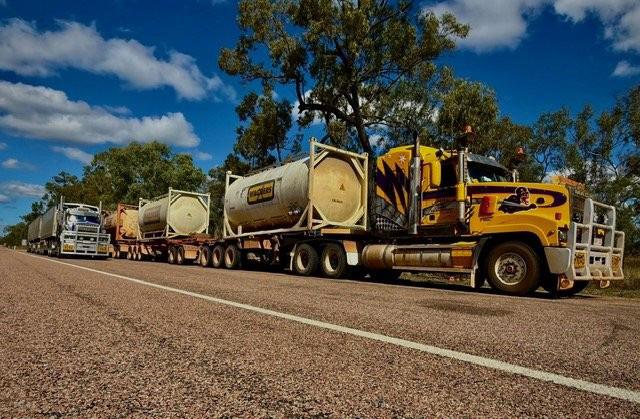
male peacock was named
after the former Australian Liberal Party politician and the females were dubbed Susan and Margaret after his two wives.
They became instant tourist attractions and stories about them and the roadhouse appeared around the world.
meeting and Wallace was not the only “minister” there. Amongst the audience was a religious preacher from Richmond.
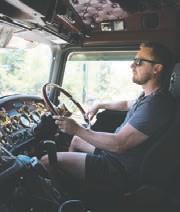
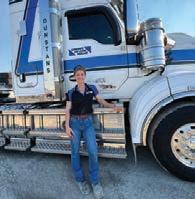
Booking
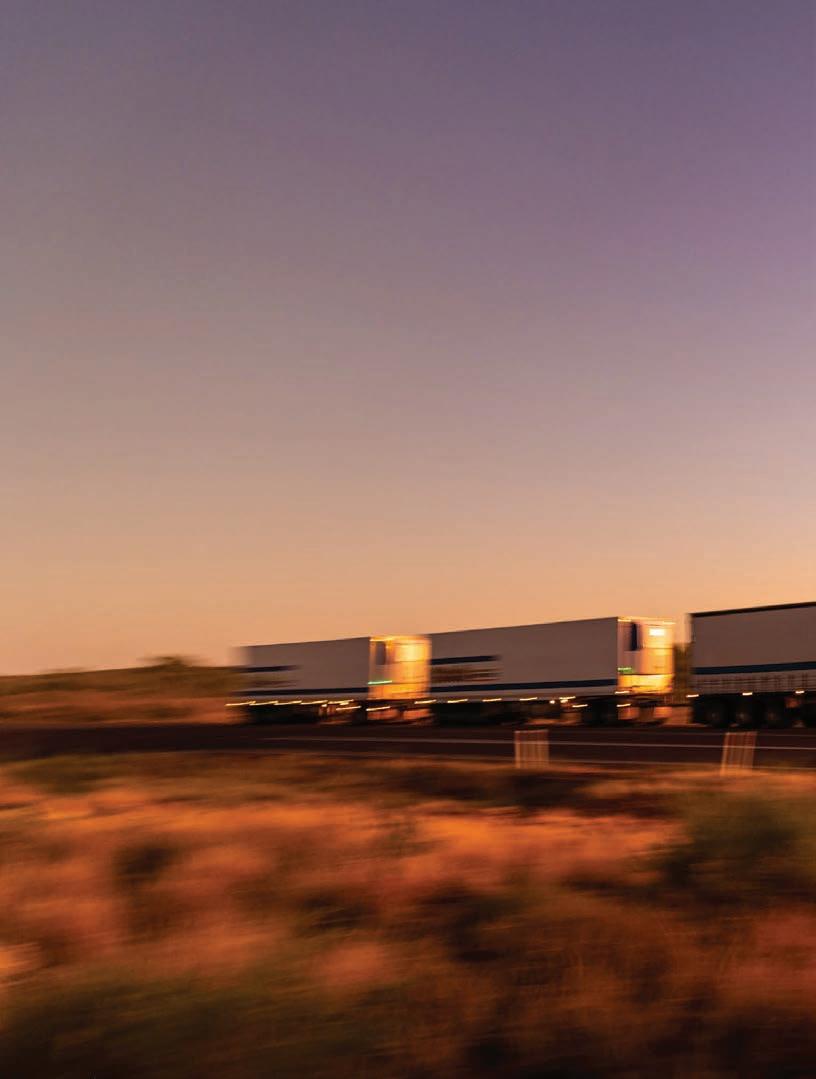
I have been at the roadhouse many times over the years and found it a place where many outback truckies have stopped.
Numerous meetings have also been held at the roadhouse where stakeholders met to lobby government officials to upgrade the Gregory High way which was mostly a nar row 250km stretch with rough shoulders.
The first such meeting was in 2006 and since then, most of the highway work has now been completed.
Back in 2009, there was a high profile meeting held at Bluewater Springs regarding an upgrade of the highway.
Then Queensland Main Roads Minister Craig Wallace attended along with senior Main Roads public servants
The mode of transport which really turned heads was a MD500 helicopter which was parked on grass next to the highway as triples and doubles whizzed past regularly.
The copter was owned by pilot Wayne Prichard of Charters Towers-based company Heliway and brought State Member of Parliament for the seat of Dalrymple Shane Knuth.
“I wanted to check out the
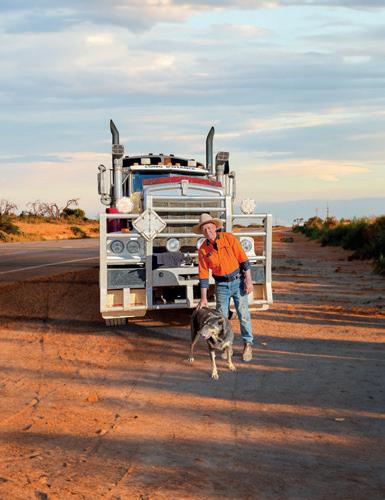
Back in the early 2000s the roadhouse received worldwide publicity because of three pet peacocks that lived there.




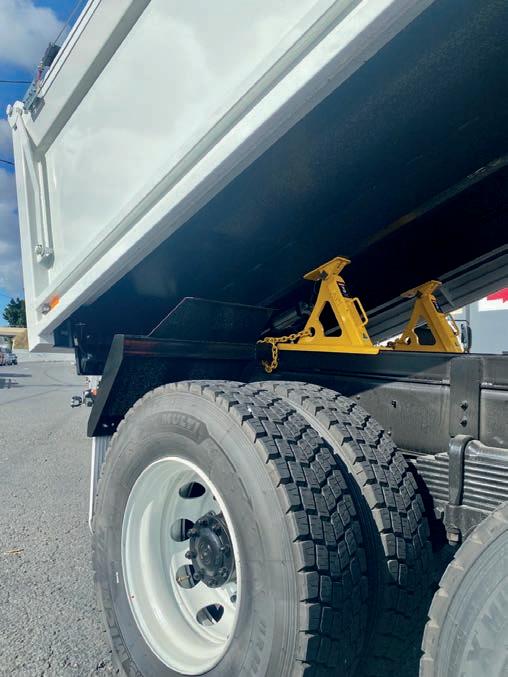
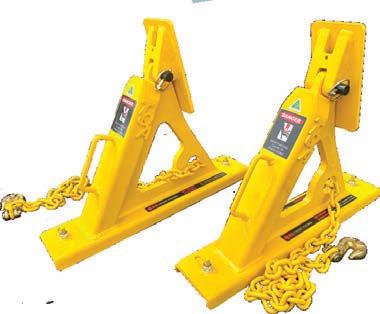
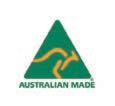



V ETERAN truckie Wally
P feared a reckless pushbike rider who collided with his bullbar was either seriously injured or even deceased.
The 75-year-old truck driver was travelling very slowly on a downhill run through Coffs Harbour when the incident occurred.
“This pushbike rider had a hood on his head and earphones and he wasn’t looking and came out of nowhere and hit my bullbar,” Wally said.
“I feared the worst but he got up off the ground and took off. The only thing that saved him is I was going very slow.”
When I caught up with Wally recently he was sit-
ting in the cabin of the Kenworth SAR Legend which he drives for Flowers Freightlines out of Brisbane: “This is SAR Legend number 44.”
Wally had carted a couple of tanks from Sydney to Townsville and had a backload to pick up.
A truckie since 1978, these days Wally is a casual driver and loves it. Although Wally doesn’t eat at roadhouses often, when he does, he likes sangas and mash.
“I don’t drink alcohol or smoke,” he said.
The worst road he has travelled on recently has been near Katherine in the Northern Territory.
As for rest areas, Wally
said many more are needed for truckies.
“The good ones for us are a dime a dozen,” he said.
His favourite NRL team is the West Tigers who haven’t enjoyed the best of seasons with no hope of making the finals series.
However, Wally did have some joy a couple of days earlier when the West Tigers beat hot favourites the Sydney Roosters.
“I have supported them all my life,” he said.
Wally added that he had always wanted to appear on the pages of his favourite publication Big Rigs. “I never thought it would happen but now it has when I am 75,” he said.
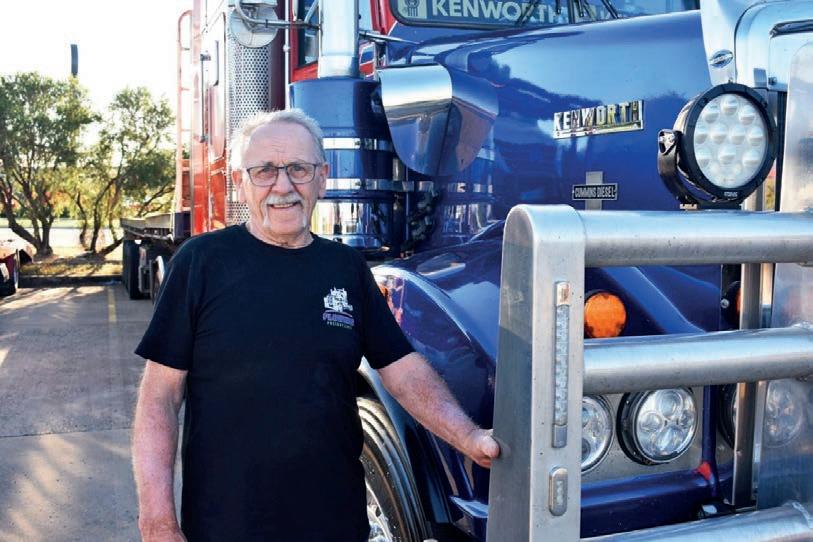
WHEN Big Rigs saw Darryn James at the BP Cluden Roadhouse parking area late in the day last month, he was sitting on a chair in front of a DAF CF.
The 58-year-old driver works for TGR, based at Acacia Ridge, and was carrying two Porsche cars for t he V8 Supercar Races in Townsville three days later.
“They will be taking part
in the early part of the races and I will be taking them back south on Sunday,” he said.
A truckie since 1989, Darryn tries to avoid buying food at roadhouses.
“A lot of them sell mostly fast food but I do like the BP Cluden which has clean facilities including good showers,” he said. Another is along the Sydney express
road. Darryn said the highway which is the worst for him is the Bruce between Ayr and Mackay.
When he manages to get time off, Darryn is into car and go kart racing around Brisbane.
His NRL footy team is the struggling Parramatta Eels.
In conclusion, Darryn said he loves the job and gets to meet many friendly people.
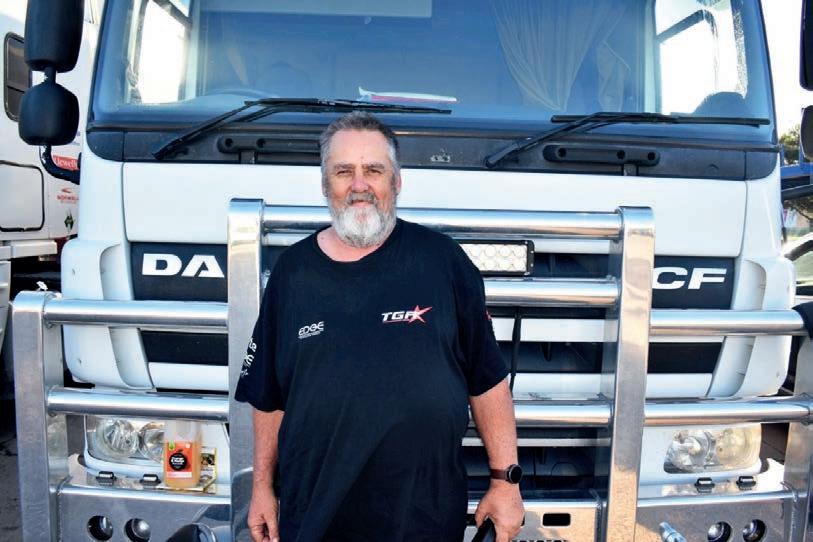
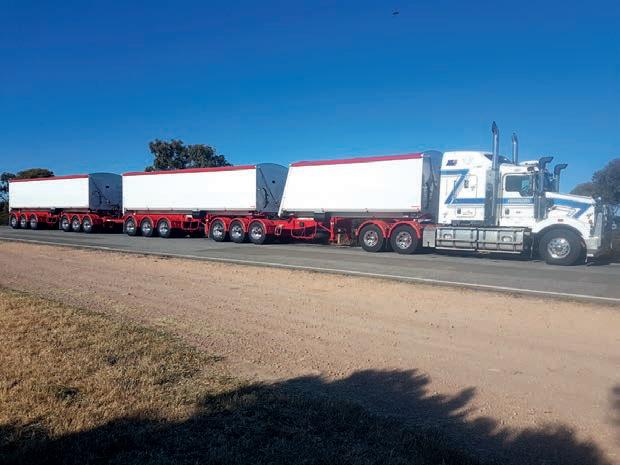
TIM Jones was driving a 2024 Freightliner Cascadia for A&R Bock out of Maryborough, and had carried pipes from Brisbane to Townsville.
“I have a backload of cycled cardboard to pick up at Mackay on the way back south,” Tim said.
Now aged 56, Tim started driving when he was in the Army as an 18-year-old.
His favourite roadhouse is at Alligator Creek just south of Townsville.
“It has good toilets, food and plenty of parking space,” he said.
Tim added that he loves Indian food, especially mango chicken.
While he said there needs to be more rest areas with facilities for truckies, Tim does like stopping at one.
“It is at Waverley Creek located 13km south of St Lawrence on the Bruce Highway between Mack-

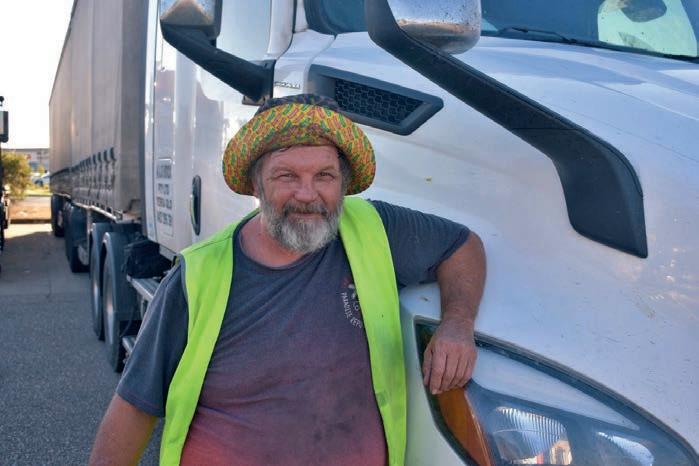
ay and Rockhampton,” he sa id.
The Bruce Highway between Marlborough and Sarina is the road he dislikes travelling along. Outside work, Tim loves

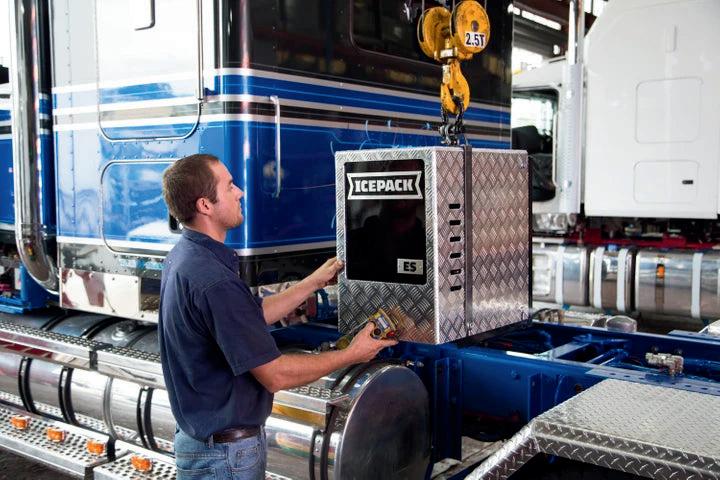





THERE are teething problems, holdups and other problems for truckies when roadworks are undertaken anywhere.
Such is the case with the major upgrades being done to sections of the Carpentaria Highway in the NT.
This is a key access road to the Beetaloo Sub-basin, Borroloola and an important service route for the pastoral, tourism, agricultural and mining sectors.
Carpentaria Highway provides access to the Roper Gulf Region, and about 26 outstations, with a population of approximately 6505 people, of which 80 per cent are Aboriginal.
This road is a key link for health and social services, assisting wider initiatives to improve living standards in Aboriginal communities.
The road is also a key route for Glencore’s McArthur River Mine for provision of supplies and transport of heavy equipment, including 40,000 litres of diesel per day, supplied by road train from Darwin.
Several drivers have told me there are detours around some sections where the work is being done which can prove chaotic.
When the widening, lifting and flood immunity improvements are complete it should result in safer driving.
A completion date has been set as December 2025.
Van driver outrage
An extremely irate NT driver phoned Spy to complain bitterly about a van driver who illegally parked across a highway as he fuelled up at an outback roadhouse.
His call was full of expletives as he described this grey nomad as a “brain-dead tourist”.
Normally a sedate fellow, he explained the reason for his outburst.
“The Camooweal Roadhouse is in Queensland but near the NT border and is close to the highway and this idiot pulled his vehicle in to get fuel but the van was halfway across the road,” he said.
The driver added that he gave the van man an “absolute spray on the radio”.
“His reply was to tell me not to be nasty even though I had to pull onto the wrong side of the road to get past his van,” my informant said.
Another truckie told me that he saw a van driver overtake on a blind corner along the Barkly Highway in the NT.
“There are van drivers everywhere up here at the moment,” this bloke said.
Action galore from SA parking area
Drivers who park at the roadhouse or service centre at Nuriootpa in South Australia often get some unexpected entertainment.
One told Spy that near the parking area is a Go Kart Racing Track where regular events are held.
“If you are there when the kart racing is on you see them zooming around the track. Often they will be practicing there for race day and it is great to watch. If it is the first time you stop there during a break it passes the time,” he said.
Nuriootpa is the major commercial centre of the
Barossa Valley, about an hour’s drive north of the state capital Adelaide.
Lots of trucks stop there and another driver said the BP Service Centre provides good food for drivers with good toilets.
“There is also a Maccas there where you can get some fast food,” he said.
Nuriootpa has a population of over 6500 people, making it the largest town in the area. There are vineyards surrounding the town. It is home to wineries including Penfolds, Elderton Wines and Wolf Blass.
Abandoned old trucks hobby
Since he retired, Graham Hunt has travelled far and wide and loves snapping pics of old abandoned trucks.
His latest snaps are of a few old abandoned trucks which had worked the Lightning Ridge opal mines in north-western NSW.
“The first one is a Leyland, then an AEC and the third is an International AB 180. That Australian-built model International dated back to the 1960s. The Leyland is possibly a Comet, dating back to the 1950s. Associ-
ated Equipment Company (AEC) was a British vehicle manufacturer that built buses, motorcoaches and trucks from 1912 until 1979,” Graham said.
A nother favourite town of Graham has been Australia’s other well-known opal mining town of Coober Pedy in South Australia, where there are also abandoned trucks.
His pics include an old Bedford and a Foden.
“Apart from the International, all the trucks were British built,” he said.
Outback boxing legend
For decades, off duty truck drivers have entered a canvas ring under a tent at locations around the eastern states to have a boxing bout for the Fred Brophy Troupe.
They have taken on the troupe boxers to check out how tough they are and have been cheered on by mates.
Legendary Fred travelled to the locations carting his gear including the ring and tent in several trucks, and these were often seen during their journeys.
I have covered many of his events including at outback Boulia, Mount Isa, Julia Creek, Hughenden, closer to
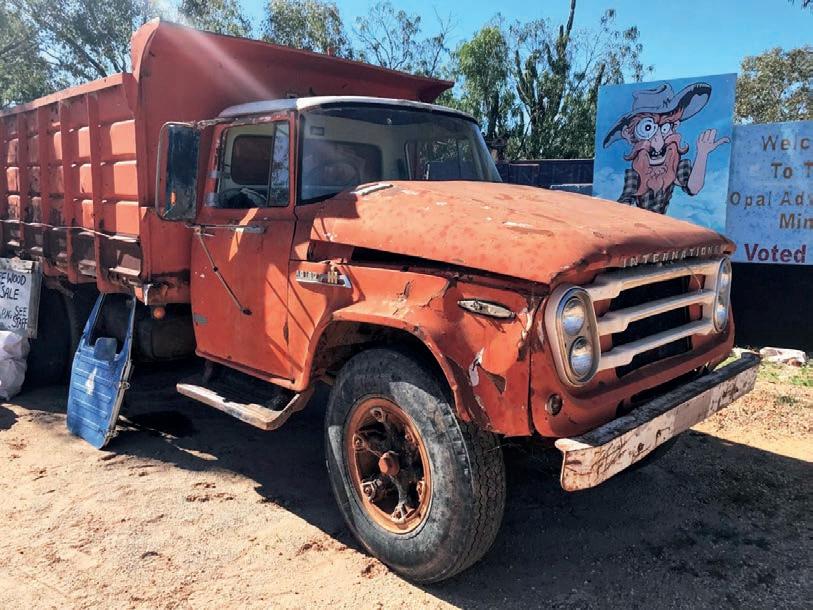
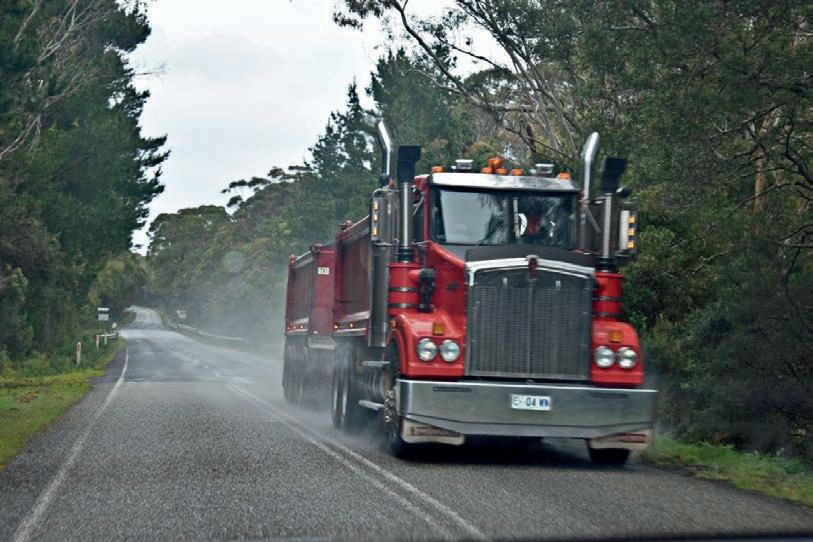
the coast at Mingela and in Townsville.
Some years ago I also stayed at Cracow in central Queensland where Fred was publican of the popular local hotel.
Fred has been a regular at the iconic Birdsville Races which this year will be held on September 5 and 6.
But the well known Fred who now lives on Bribie Island has indicated this will be his last time at Birdsville.
He will be sadly missed there but fortunately will still host tent boxing closer to his home.
Over the years there has been many troupes such as Jimmy Sharman, Roy Bell and one run by the late Larry Dulhunty.
I am sure many truckies who read this will have fond memories of having fought under an outback tent or at least having been a spectator.
These have been an integral part of Australia’s colourful history.
cancer truck
The Australian Skin Cancer Foundation truck is a mobile
The truck set up at Queen’s Park where 78 junior rugby league teams battled it out for the prestigious Laurie Spina Shield.
It also was at the NRL match between the local Cowboys and Melbourne Storm on the second night. It was much appreciated with the many adults and youngsters who were checked.
Many truckies around the country have skin cancers which require surgical removal.
The truck provides free skin checks to communities which otherwise may not be able to access a similar service, while further educating them on skin cancer and how to take preventative measures.
You see lots of B-doubles carrying bananas travelling around Australia.
Spy often gets asked by members of the public who know I write for Big Rigs if I would have any idea about the total weight of the popular fruit in each truck. nswer is a definitive
So I asked one driver who
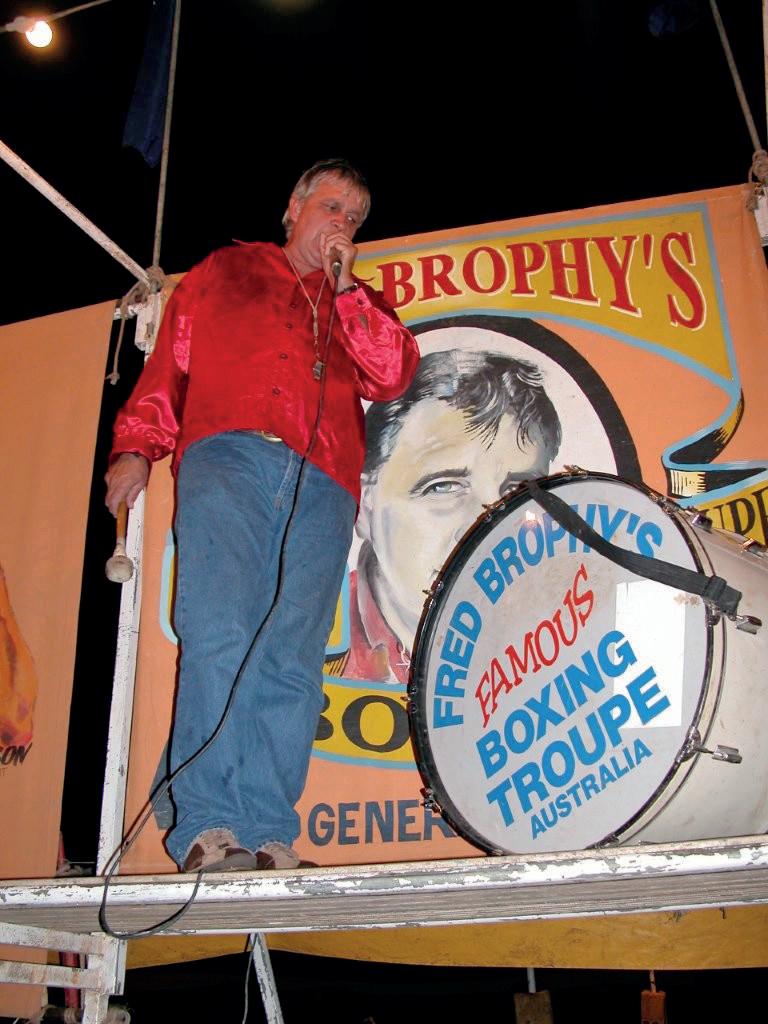
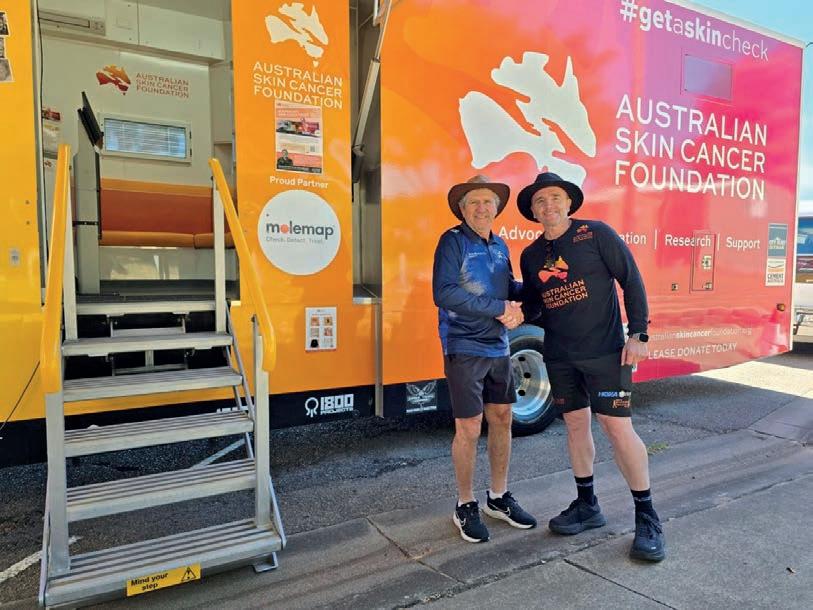


does a regular run with bananas between North Queensland and Perth.


“The two trailers hold 42 tonnes of bananas and 26 B-doubles a fortnight travel to Perth with them,” he said.
The driver also added that when the bananas arrive in Perth they must be quarantined before being distributed to markets.
“Once they pass quarantine the bananas can then be sold on,” he said.
Lots of drivers tell Spy they
Strahan to Queenstown upgrade
An upgrade to Tasmania’s Lyell Highway between Strahan and Queenstown had made travelling between the towns safer.
It is 41km between the centres and Strahan is a tourist centre whilst Queenstown is famous for mining. When I was down in Tassie
Isle drivers had told me that the Lyell Highway overall needed work and some were especially critical of the section between Strahan and Queenstown.
The work has included: the creation of opportunities for faster moving traffic to overtake slower moving vehicles; improved travel time reliability for commercial and social purposes between Queen-
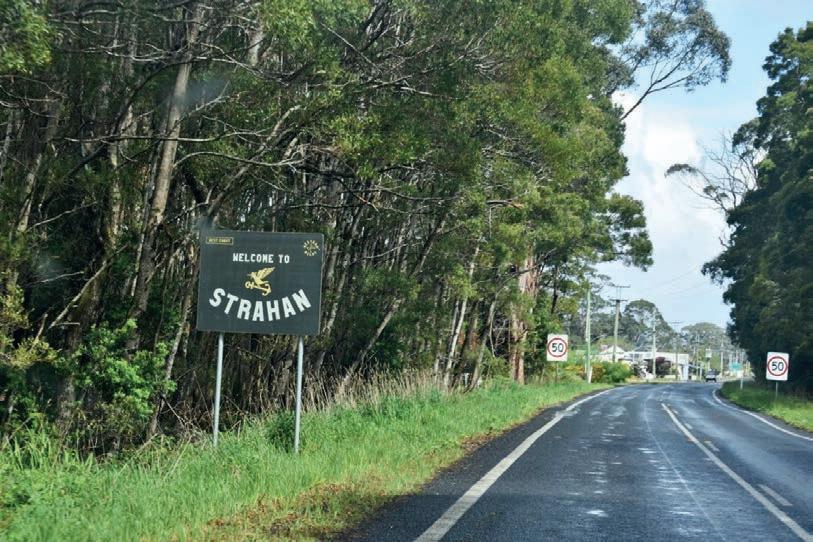
ators and tourists; creation of eight stopping bays; passing lanes; safety treatments such as adding new safety barriers, road signage and guideposts; adjustments to the road alignment; and clearing vegetation and rocks.
Record number of spectators
Men, women and children lined streets along the route
The 2025 NTI Townsville 500 started two days later.
Dubbed the “Transporter Parade” the convoy commenced at Webb Drive at the Bohle and meandered along Ingham Road, Bundock Street and others before arriving at the race headquarters at Reid Park.
I have covered many of these convoys and have never seen so many people lined up

These trucks carry tens of millions of dollars’ worth of Supercars and equipment. They traversed around iconic Castle Hill and past fans at Central Park enroute to Reid Park street circuit. In a global first, Professional Bull Riders (PBR) Australia will bring its renowned, high-adrenaline format to the heart of the Supercars precinct with the first-ever Australia vs New Zealand PBR showdown.
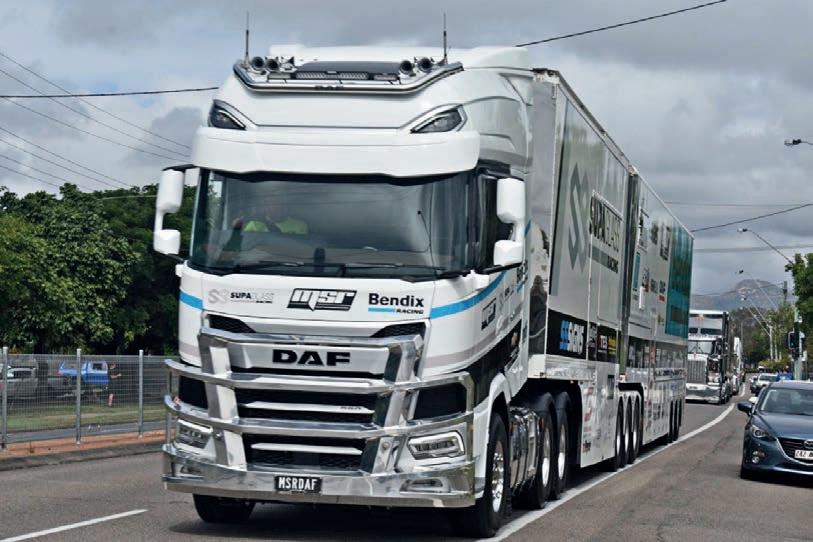

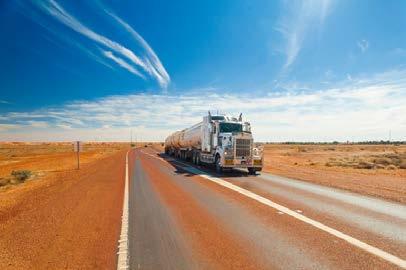
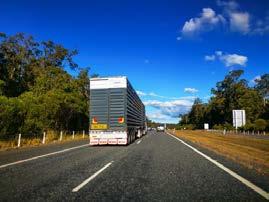

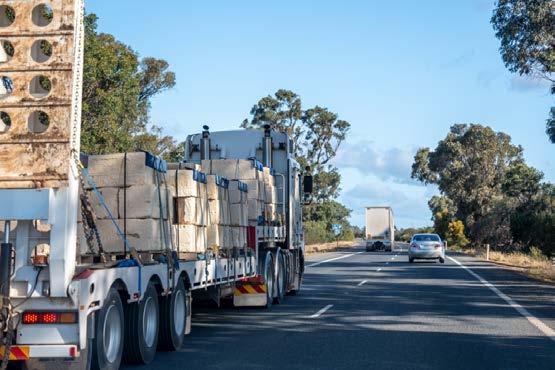
AFTER completing his trade as a boiler maker, Phillip Taylor made the switch into trucking about 15 years ago when he secured his HR licence – eventually working his way up into the bigger rigs.
Originally from Geelong, Victoria, Phillip moved to Darwin 24 years ago for work and it’s been his home ever since.
“It was about seven or eight years ago that I was offered a job driving road trains, so I got my MC licence and I haven’t looked back,” he said. “I’ve had the chance to work
in many parts of Australia.”
Earlier this year, Phillip started a new role with NEAL Freight & Logistics – a subsidiary of North East Arnhem Land Aboriginal Corporation. It sees him doing a weekly run from Darwin to the Gore Peninsula in the Northern Territory’s far north-east tip, carrying general freight.
“I’ve just started this year with the company.”
Though he’s new to the company, he’s no stranger to the treacherous 1200-kilometre run each way along his route. “I’m into my
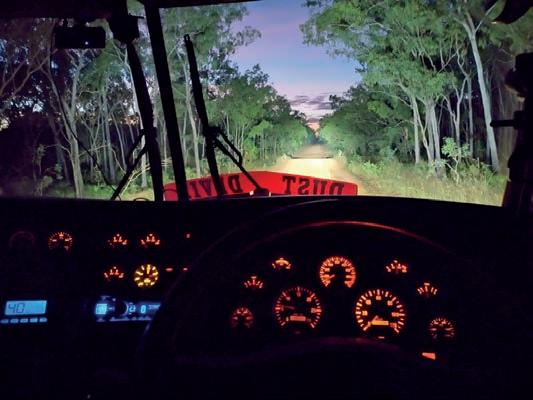
fourth dry season this year doing this run – and I love it,” Phillip said.
Typically he’s on the road for about nine months of the year, depending on the season. “Usually the road opens around April/May but it opened late this year because of all the rain, so we only got out there in June. It gets really wet from around November/ December and usually operators will pull the pin by December at the latest.”
You’ll find Phillip behind the wheel of one of the company’s two prime movers – a 160-tonne rated 2017 model Kenworth T909, called ‘Dust Devil’.
Asked about his favourite part of the job, Phillip responded, “It’s just being out in the Top End of the Northern Territory, driving in God’s Country up in Arnhem land and not seeing even one car in 12-plus hours – it’s just you on the road.
“And the fact the road changes from week to week. Every week it’s different, the corrugations change, it’s always moving.
“You’ve got to have discipline and respect to do this
sort of work, otherwise it’ll bite you.
“Out driving in the bush, we get so much respect. It doesn’t feel as safe on the road when you’re driving down south, I’ve had too many close calls!”
Phillip added that he doesn’t have a favourite roadhouse to stop at – because “there’s not much around where I go!”
He also admitted that having to stop and change flat t yres is his least favourite part of the job. “Sometimes you get them but sometimes you’ll have a good run.”
When it comes to training, Phillip believes there’s definitely a lot of room for improvement; and offered some advice for newcomers to the industry.
“Start in a heavy rigid, give it a go and stick at it, then move up to your HC. You need to learn that, then move onto the bigger ones,” he said.
“I was lucky that the first load I did in a road train was three trailers of hay. It was in a big 509, which was nice. But even if you do start in a big truck, don’t think you’re a super trucker. It’s better to start smaller and slowly move up.”
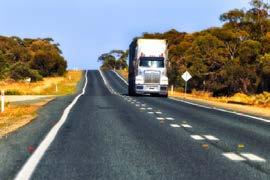
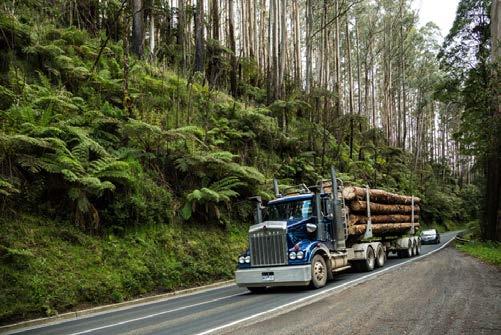
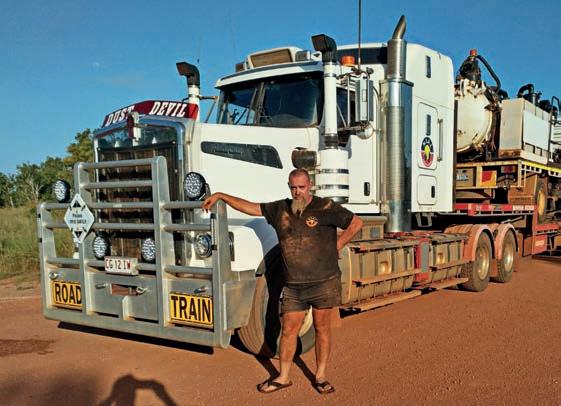
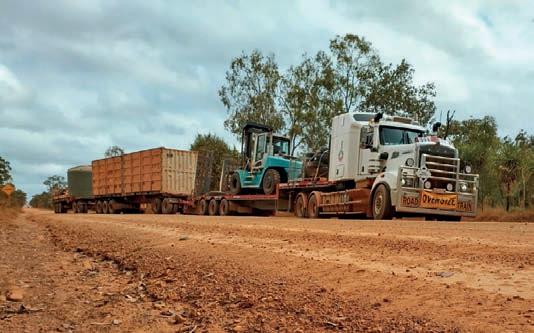

If you want to be featured in the Truckin’ Around Australia pages, just scan the QR code, answer a few simple questions, then email in a picture of you with your truck to editor@bigrigs.com.au.
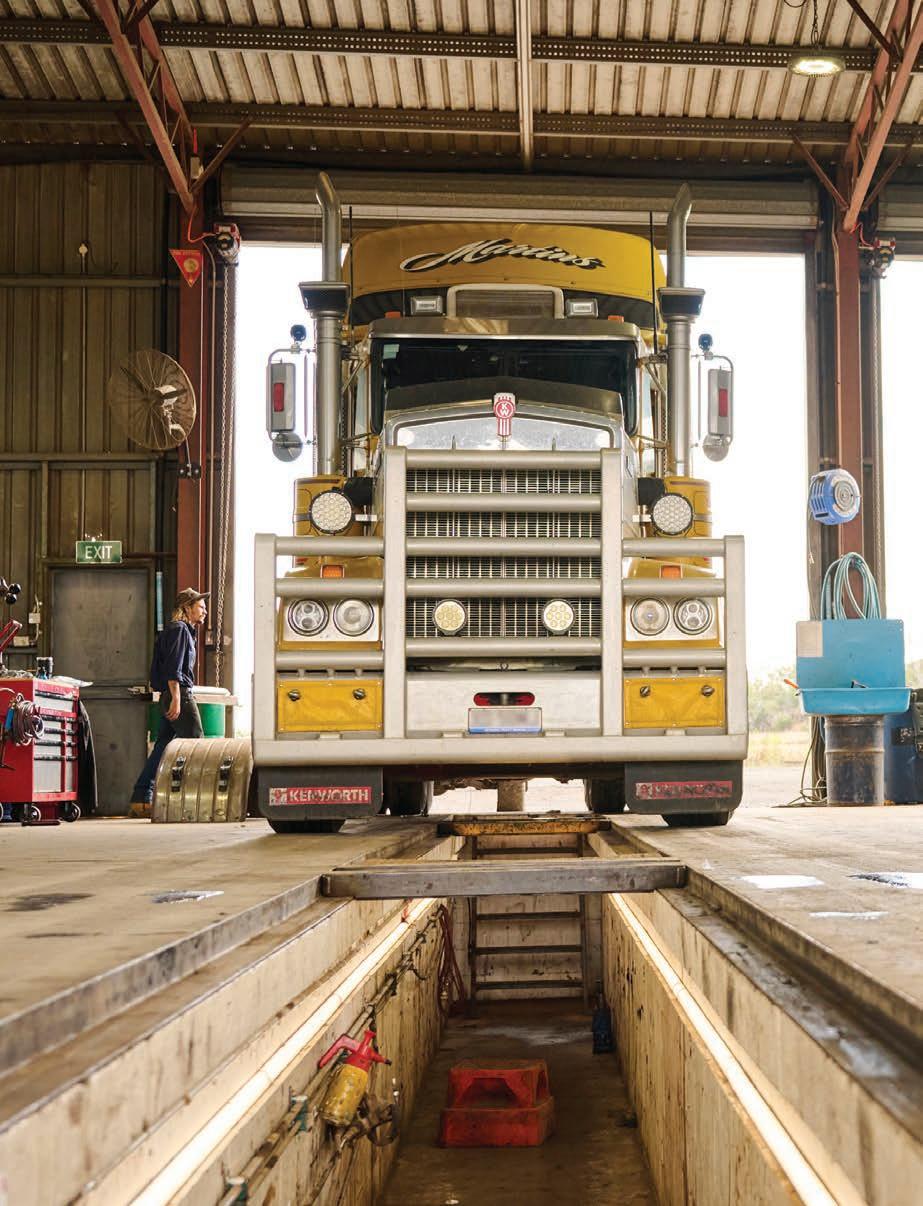
WITH a fleet of close to 40 heavy vehicles in operation across the country, Scania trucks form the backbone of Recycal’s national logistics network.
Recycal is a leading player in Australia’s recycled materials industry. It has been steadily expanding its national foot print, with operations in ev ery state except the Northern Territory.
From ferrous and non-ferrous metal recycling to green steel feedstock and foundry-grade products, Recycal is at the forefront of circular economy solutions, and its transport fleet plays a critical role in that mission.
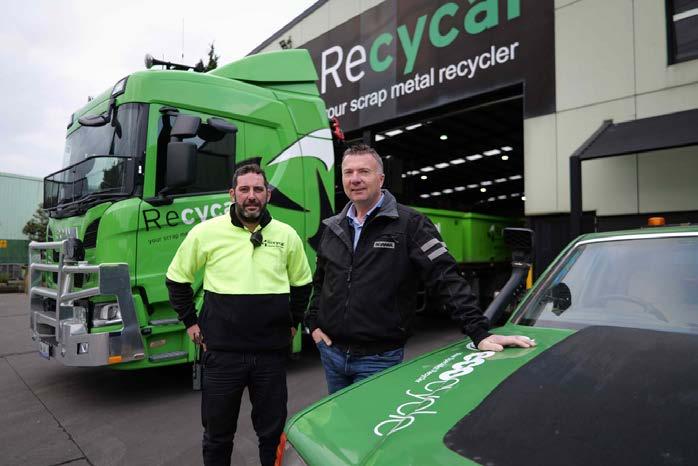
“Scania continues to be a strong performer for Recycal,” said Recycal National Operations Manager, Jason Zorzut. “We’ve recently placed another order of 11 vehicles for delivery in 2026, which
speaks to our confidence in the brand and its alignment with our operational needs.”
As the company transitions to Euro 6 compliance, vehicle performance and specifi-
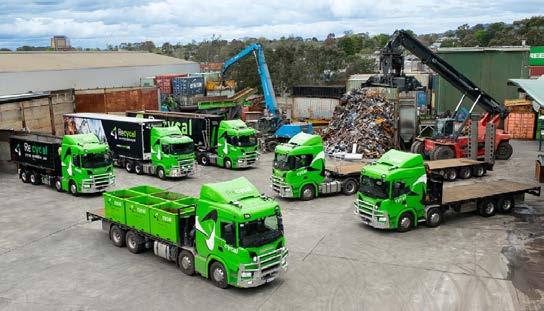
cations remain a key focus.
“We’re reviewing elements such as weight distribution, AdBlue capacity and tyre configurations to ensure we’re running an efficient and compliant fleet,” Jason said. “Our current line-up includes front-mounted cranes with Palfinger units, hook trucks and prime movers. These set-ups have proven reliable and versatile across our sites and services.”
Recycal’s long-standing partnership with Scania includes the use of repair and maintenance contracts, which have supported the fleet over its lifecycle.
“Some of our earlier vehicles have now reached the seven-year mark and are being retired from the fleet,” added
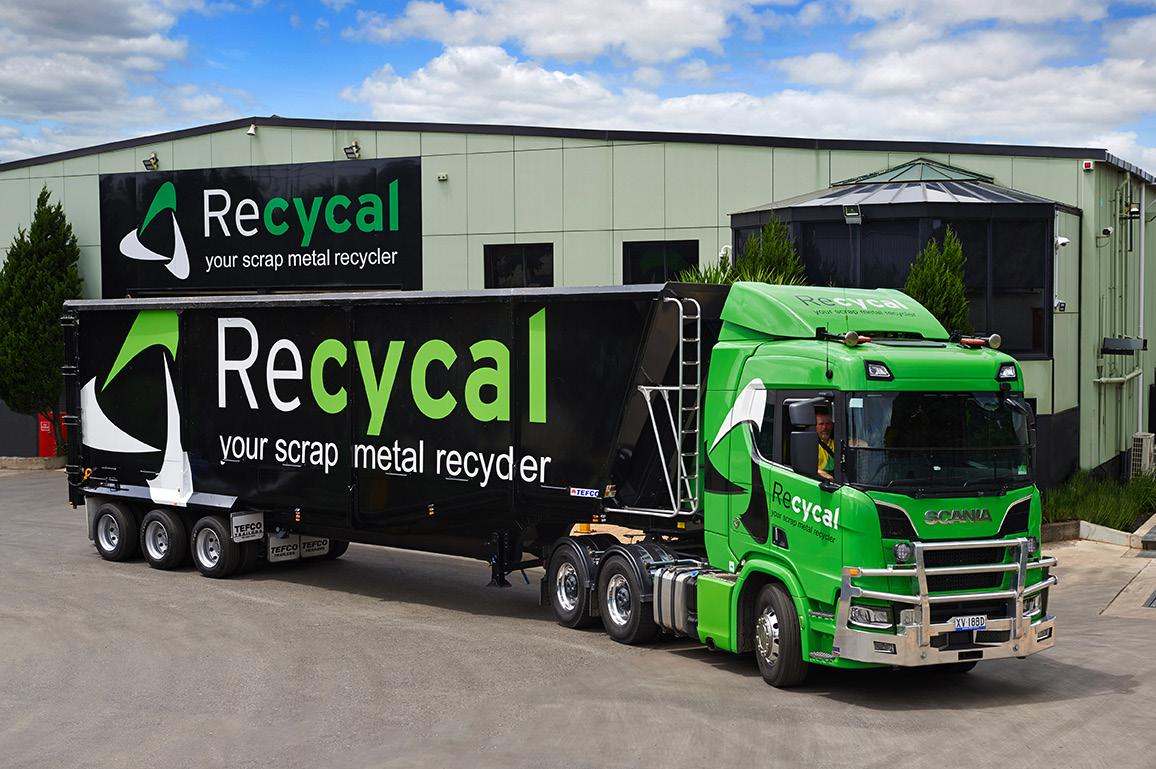
Jason. “Having those vehicles on Scania’s repair and maintenance contracts has given us peace of mind and allowed us to plan around performance and servicing with confidence.”
Jason says that confidence is matched by the team behind the brand. “Our Scania Account Manager Roger Lake has been instrumental in supporting our operational requirements and ensuring we continue to get the most out of our investment.”
Driver satisfaction has also played a pivotal role in Recycal’s ongoing commitment to Scania.
“The performance of the trucks has been excellent and the feedback from our drivers
has been overwhelmingly positive, particularly from those who’ve previously worked with older or less ergonomically designed vehicles,” Jason added.
“Choosing Scania was a strategic decision, not just for the quality of the equipment, but also to attract and retain skilled drivers. We see our vehicles as an extension of our brand, and we want our team to feel valued and supported in their roles.
“When drivers are comfortable and engaged, they’re more focused on safety, more mindful on the road and take greater pride in their work, especially when operating one of our distinctive green trucks bearing the Recycal livery.”
With major infrastructure
THE PERFORMANCE OF THE TRUCKS HAS BEEN EXCELLENT AND THE FEEDBACK FROM OUR DRIVERS HAS BEEN OVERWHELMINGLY POSITIVE.”
JASON ZORZUT
developments underway in Queensland and Tasmania, Recycal’s fleet and its continued investment in Scania is helping to keep recycled materials moving safely, sustainably and efficiently.
































If you’re serious about safety, durability, and all-round

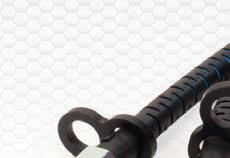
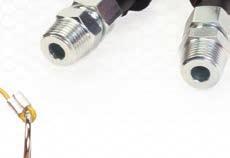



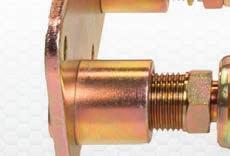
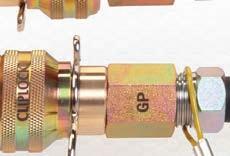

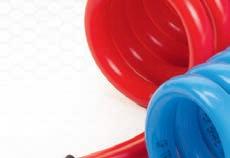
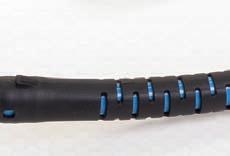


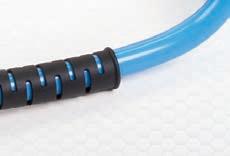





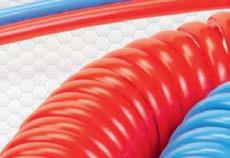

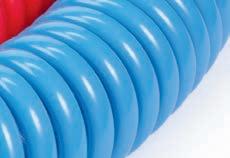




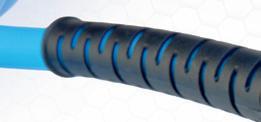






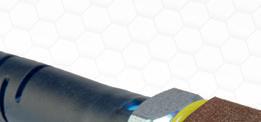






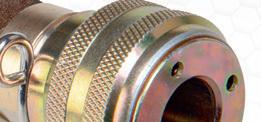








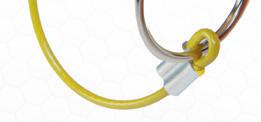




















CLEAN Vibes helps keep the good times rolling, providing event cleaning, sustainable waste management, and business sanitation for Australian events.
From pubs, clubs, music halls, theatres, festivals, showgrounds, office spaces, and outdoor sporting events, Clean Vibes offers waste management plans with teams that aren’t afraid of hard work.
From pubs, clubs, music halls, theatres, festivals, showgrounds, office spaces, and outdoor sporting events, Clean Vibes offers waste management plans with teams that aren’t afraid of hard work.
Since opening in 2017, the business has seen success right off the bat. It now employs 55 full-time staff, including 12 truck drivers, and a mammoth casual workforce of roughly 2500 temporary workers around the country. The workforce is coordinated from a head office in Sydney and hubs in Brisbane and Melbourne.
Earlier this year, Clean Vibes celebrated the opening of its New Zealand branch and a rebranding of its waste truck fleet.
Managing Director, Andrew Macarthur, shared the details on the fleet – which transports various cleaning equipment: bins and bin bags, sanitisation products, hi vis clothing, and toilet paper to and from events, along with waste and recycling that has been sorted by staff on site heading back to the Clean Vibes facility for processing.
“We have recently rebranded and refreshed our Isuzu trucks fleet with the assistance of Suttons Trucks Arncliffe,” said Andrew.
“Waste management planning is a 24/7 operation, with all our trucks on the road seven days a week.
“Reliability is incredibly important in our industry, so having vehicles that are maintained well, ready to go, and that don’t break down are a must.”
Waste can take up a lot of space – and get heavy, especially when catering to the huge range of music festivals and sporting events that Clean Vibes works at.
So payload is an important consideration for their truck
fleet, which also needs to be nimble enough to collect bins full of recyclables and corflute fence signage and get around venues easily.
Andrew says Isuzu is favoured for its high-payload, low-fuss model range. The Clean Vibes fleet includes an NNR 45-150 AMT MWB Vanpack, four NNR 45-150 AMT MWB pantech trucks with the tail lifts, a FRD 110260 AUTO LWB pantech, and a FVY 240-300 Auto rear lift compactor truck.
Navigating back roads for waste collection for festivals and events, the NNR 45-150 AMT has a medium wheelbase of 3.4 metres and a kerbto-kerb turning circle of 11.8 metres, which slots smoothly into just about any loading bay, back dock, or crowded event site.
With a GVM of 4500 kg and a GCM of 8000 kg, this light-duty truck is rated for standard car driver’s licence holders with the necessary payload for cleaning supplies and bins.
Bins are loaded via a custom rear tailgate lift for Clean Vibes, saving time in the bump-in and bump-out process.
The NNR 45-150 has an Isuzu 4JJ1-TCS engine under the hood, providing 110 kW of power (150 PS) at 2800 rpm and 375 Nm of torque at 1600 – 2800 rpm, matched with a 6-speed Automated Manual Transmission (AMT).
Also tackling bin collection is Clean Vibes’ NNR 45-150 rubbish raider. This truck features a 4.3-metre by 2.2-metre pre-built body fabricated with sturdy fibreglass panels, featuring barn door access, internal tie-down rails and a customer fitted rear tailgate lift.
A 6x4 FVY 240-300 Auto rear lift compactor truck gets called in for large-scale events such as multi-day camping festivals and street parades like the Sydney Marathon and Sydney Mardi Gras.
Underpinned by an Isuzu 6HK1-TCS engine that offers a maximum 221 kW of power (300 PS) at 2400 rpm and 981 Nm of torque at 1450 rpm, the FVY has a 24,000kg GVM that streamlines the collection process, eliminat-
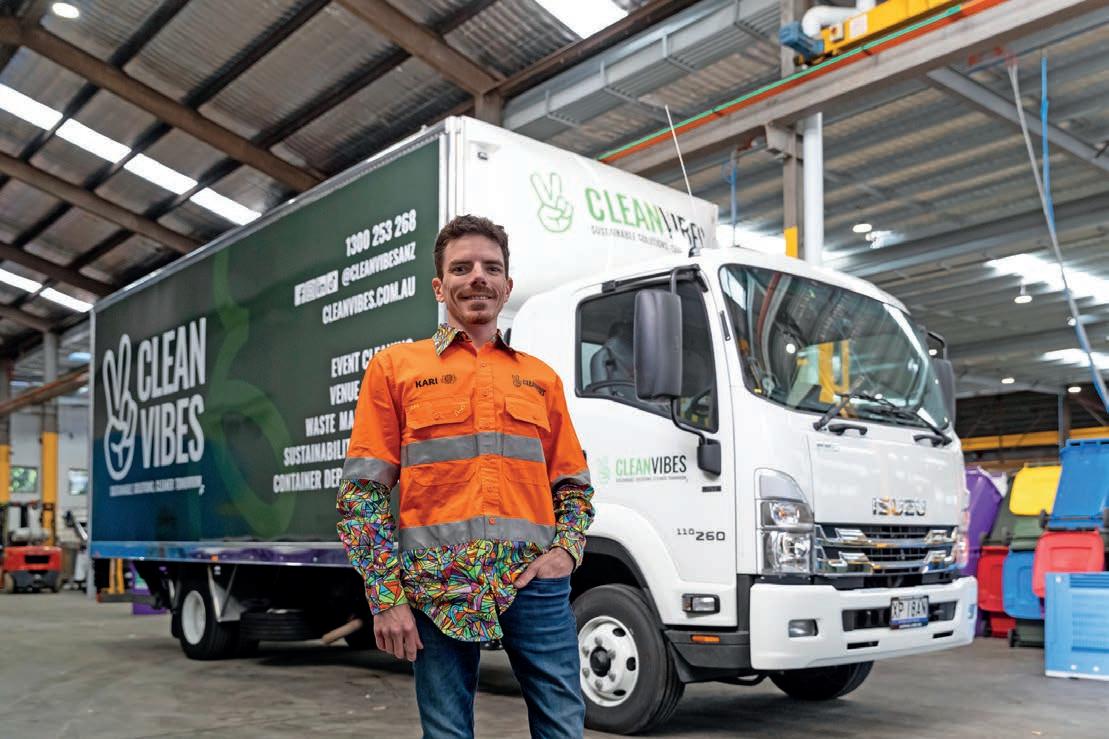
ing the need for multiple runs back to base.
Clean Vibes has opted for AMT and automatic transmission across its Isuzu units, stating ease of use as the primary reason, supporting the dozen-strong driving team.
This extends to the last of the fleet, an FRD 110-260 Auto (long wheelbase model) primed to tackle their biggest events and cleaning operations.
This medium-duty workhorse features a 6-speed Allison LCT 2500 automatic transmission, Isri 6860/875 NTS air suspension seat, and a six-cylinder 6HK1-TCC engine.
“The FRD is a nice truck to drive… the air suspension driver’s seat is very comfortable,” said Andrew.
“I’ve driven other truck brands in the past and found that there was quite a lot of lag, especially when we had a full consignment load on board— sluggish going uphill and not much power compared to our new Isuzus in the same weight range.”
In the early years as Clean Vibes was finding its feet in the competitive waste market, Andrew hired trucks from rental
companies wherever an event booking was located.
However, he found this wasn’t a viable long-term solution due to the inconsistent availability of new or reliable trucks when he needed them for a job.
Reaching out to Suttons Trucks Arncliffe and sales
manager Alex Bil, Andrew ordered his first Isuzu truck in 2021 and hasn’t looked back since, maintaining a close working relationship with the dealership.
“Since purchasing my first Isuzu, we have only had great experiences with the brand,” Andrew added.
“We’re extremely happy with the service that we’re currently getting, both from Alex in the sales team, the Isuzu brand, and the service team, who do an amazing job. With Isuzu, we can continue to provide fantastic waste management and recycling for our customers.”
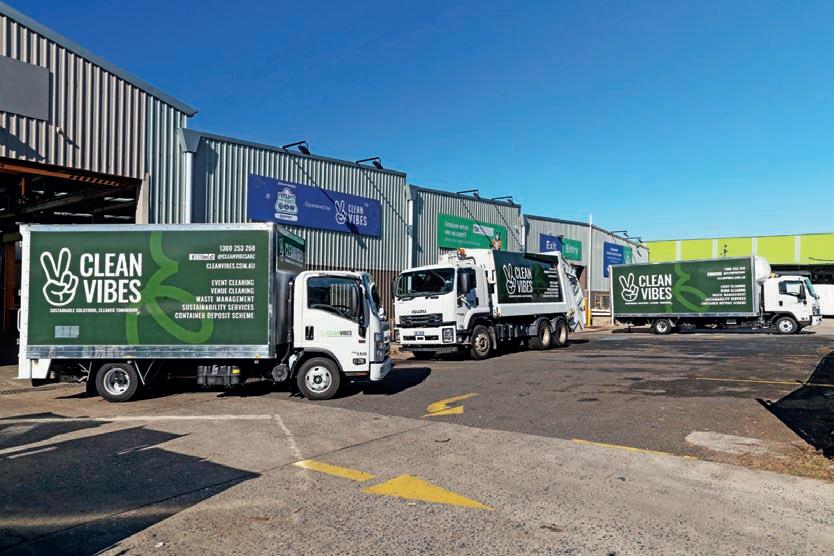
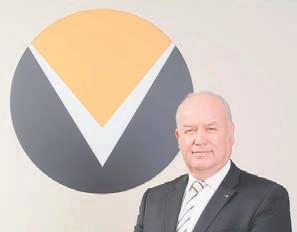
ADVOCATE
PETER ANDERSON CEO, Victorian Transport Association
The transport, freight, and logistics sector is the engine room of Australia’s economy – moving goods, connecting communities, and underpinning every supply chain from agriculture to retail.
Yet despite its critical role, the industry continues to be sidelined in national policy discussions, hampered by outdated regulations, skills shortages, and fragmented infrastructure planning. It’s time for a reset.
Australia’s heavy vehicle licensing system remains inconsistent and outdated.
Despite multiple reviews –dating back to 1996 and again in 2013 – there is still no nationally standardised training and licensing framework. This failure not only undermines safety but also deters new entrants from joining
THE ROAD FREIGHT INDUSTRY IS NOT ASKING FOR SPECIAL TREATMENT. IT IS ASKING FOR RECOGNITION, REFORM, AND RESPECT.”
the industry. Reform must be fast-tracked to ensure drivers are properly trained, assessed, and supported from day one.
The average age of a truck driver in Australia is now over 47. Without urgent investment in skills development and training pathways, the industry faces a protracted workforce crisis.
We need nationally funded programs that promote transport careers to younger Australians, including schoolbased apprenticeships, TAFE partnerships, and targeted incentives for women and underrepresented groups. The future of freight depends on a pipeline of skilled, motivated professionals. Australia’s freight task is growing, but our infrastructure is not keeping pace. Better integration between road,
rail, and port networks is essential to reduce congestion, lower emissions, and improve delivery times.
Policy must prioritise investment in intermodal hubs, lastmile connectivity, and digital freight corridors that enable seamless movement of goods across modes and borders.
The industry is not asking to cut corners. It is asking for smarter regulation that supports both productivity and safety.
This includes reforming the Heavy Vehicle National Law
to reflect modern operating conditions, reducing red tape, and enabling the use of high-productivity vehicles where appropriate.
Safety outcomes improve when operators are empowered with the right tools, training, and technology –not when they’re buried in bureaucracy.
Despite its $140-plus billion contribution to the national economy, the transport sector still lacks a dedicated voice at
Minister for Infrastructure, Transport, Regional Development and Local Government, Catherine King, has demonstrated commendable leadership and commitment to the sector, the breadth of her portfolio means that transport-specific issues often compete for attention among other priorities.
A dedicated Federal Minister for Transport – focused solely on freight, logistics, and supply chain resilience – is essen tial to ensure that the unique challenges and opportunities
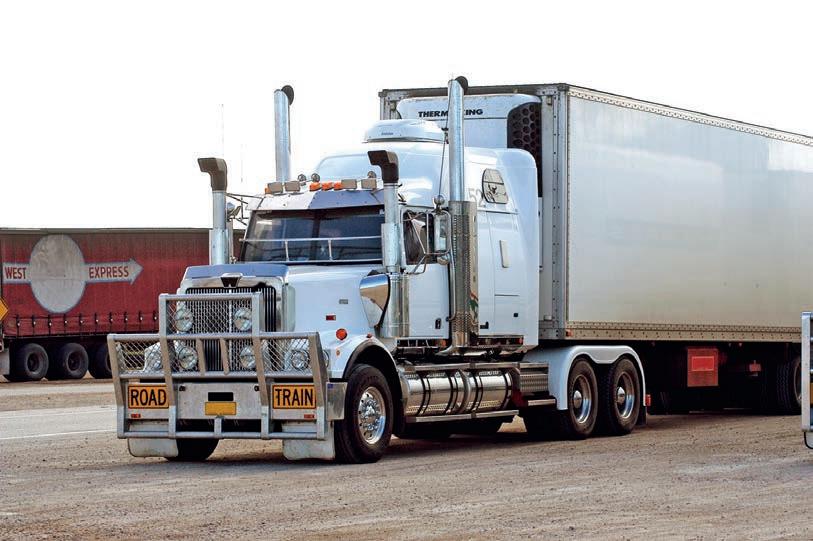
of this vital industry are addressed with the urgency and strategic focus they deserve.
Such a role would elevate transport policy to a national priority, enabling more responsive decision-making, better coordination across jurisdictions, and stronger advocacy for the sector’s needs within government.
The road freight industry is not asking for special treatment. It is asking for recognition, reform, and respect.
We need governments – federal and state – to move beyond consultation and deliver real outcomes. That means implementing national heavy vehicle licensing reform, investing in skills and training to attract the next generation, prioritising intermodal infrastructure and connectivity, supporting productivity through smarter regulation, and appointing a dedicated Federal Transport Minister. The time for talk is over. The time for action is now.
Let’s work together to build a safer, more efficient, and more resilient transport system –one that reflects the vital role this industry plays in every Australian life.

WITH the amount of old established family companies closing and other companies going into administration, along with the state of our economy and the turmoil around the world, it is hard to keep up the cheerful demeanour right now.
For some it is harder than others, many of you who know me or have read my columns over the years know that I have fought a long battle with depression throughout the years, and while we may win the battle, I am never sure that we can win the war.
The struggle against the abyss began with the long Covid lockdown when I was unable to see my family, followed by my departure from Lineage Logistics after 14 great years with Oxford Cold Storage.
While I was happy to move on, it was a move from the familiar. Then I lost my beloved mother, and my depression decided it was tougher than me and would return to the fight. There has been a journey of highs and very low, lows.
Returning to work in the livestock transport industry with some former employers has been blessing; another bonus has been amazing in young and youngish Indian drivers that I have been able to introduce to this, my favourite industry sector.
Some of them have become like family and I have been able to travel to India to attend a wedding and enjoy
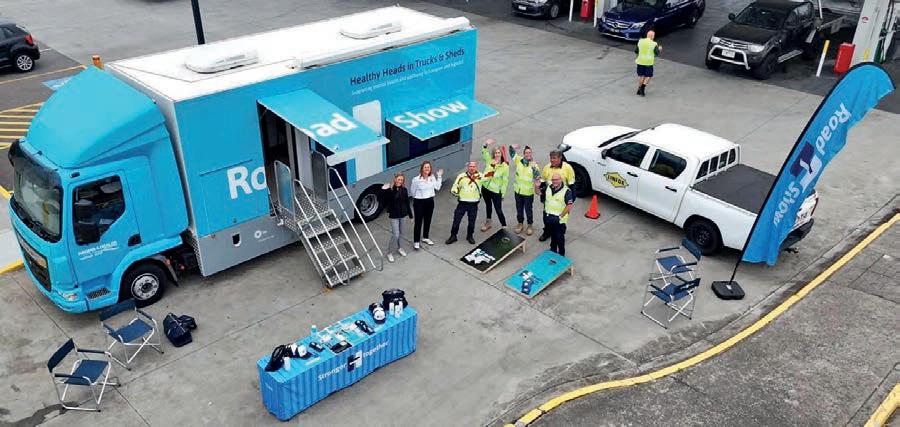
Help
their wonderful culture and community.
Of course, my continued involvement with Transport Women Australia Limited and the National Rural Women’s Coalition has also played a part.
But it is still my friends who have stepped up and ensured that I eat, get out of bed, and leave the house rather than giving up, which would be so easy sometimes.
I know that I am very privileged and what a wonderful
life, but it is sometimes difficult to convince myself.
We are truly fortunate to live in a world where so much help is available like Healthy Heads in Trucks and Sheds and other organisations for both our mental and physical health.
To offset the downside, as we move into August, I will have been 55 years in the trucking industry.
I joined at the beginning of my teenage years, and I have had so much fun, met some amazing people, and worked for some wonderful bosses and companies. I went from being the youngest person in the room to one of the oldest, but what amazing journey it has been, with many incredible stories to tell.
When I see the incredible young people in our industry and the people that I have been so fortunate to work with and mentor, I know that it has all been worthwhile and that I have been very, very blessed.
• If you, or someone you know needs support, phone Lifeline on 13 11 14, Health in Gear on 1800 464 327, or Beyond Blue at 1300 22 4636.
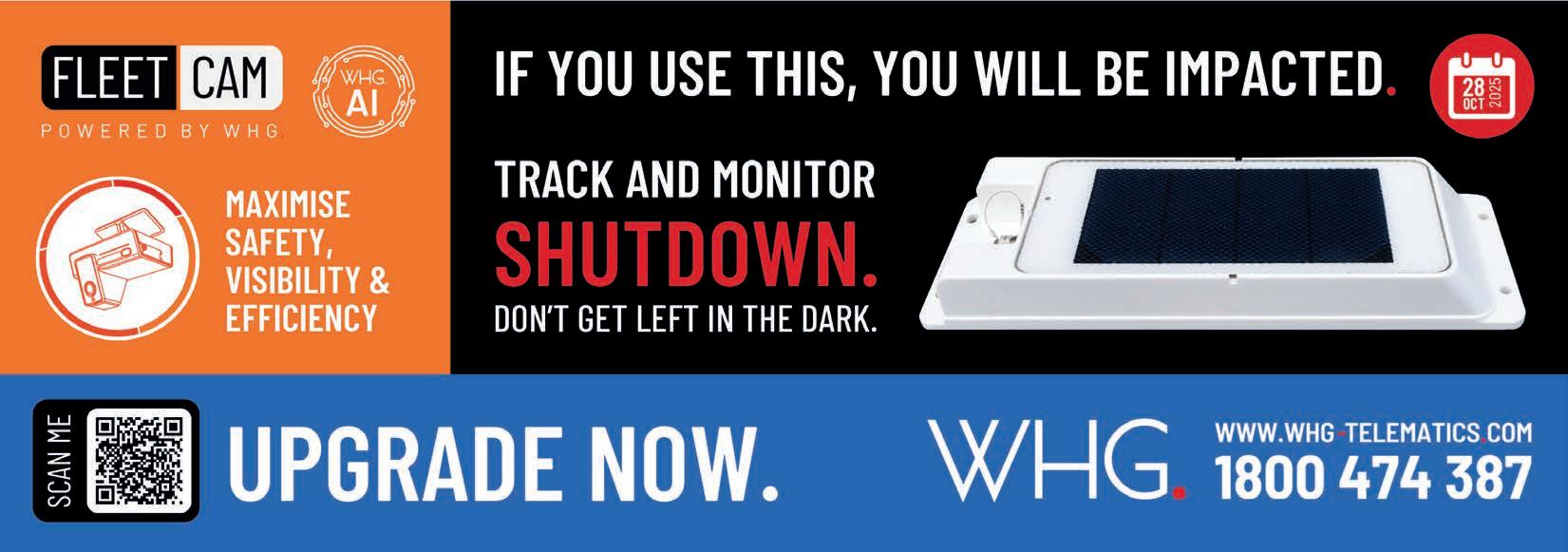
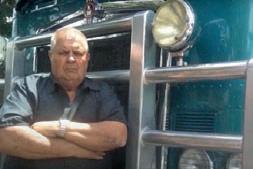
IT’S time for conversations about roads in Australia.
Australia is one trillion in debt. Two hundred thousand kilometres of roads need building or rebuilding at a cost of say $100 billion-plus, yet the states have no money.
History shows when governments run out of money they will come back to this industry, the cash cow that always pays, so they are coming somehow.
Damages to transport and private vehicles per year amount in the millions due to the poor state of the roads.
The pittance that government spend on roads cannot continue.
Without them, the industry has grounds for a class action against governments based on the sections of the Heavy Vehicle National Law on fatigue.
Under current government expenditure it will take 40 years, or more, to make 20 parking bays.
Current road user charges (RUC) in fuel is 32.4 cents per litre with the new consumer price index (cpi). There is no RUC for EVs and hydrogen vehicles.
In 1979, 95 per cent of trucks were six axles, maximum of 38 tonne, not including road trains.
Now we have 10 per cent of six axles vehicles and 90 per cent multi-axle up to 20 axles, and 90 per cent on air bag suspension, which is causing all major damage to roads.
There are more than 44 different combinations of vehicles now, instead of the six we had in 1979, including tridrive, multiple quad axles on trailers and converter dollies. has it started?
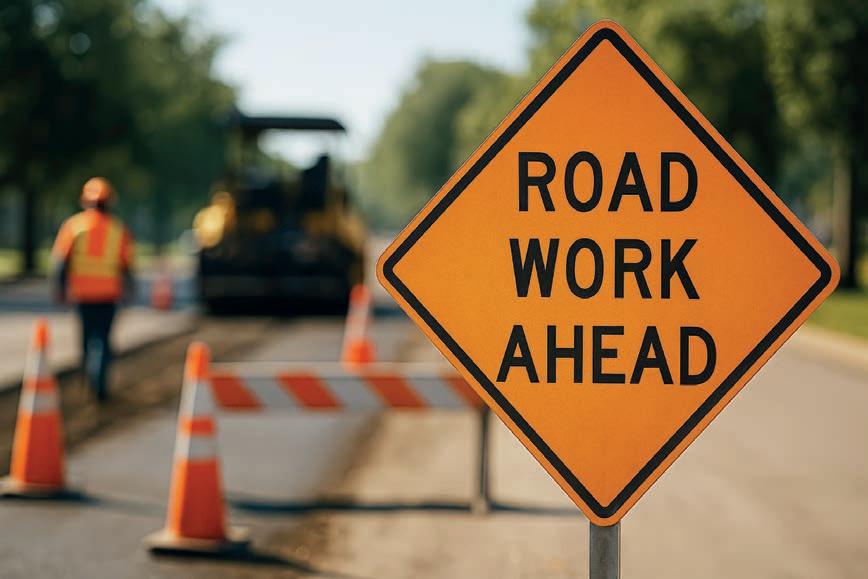
Treasurer Jim Chalmers has
axles. The resulting damage done by them has never been
ery from EV, hydrogen and multi-trailer combinations of
To capture all these vehicles, we would need to go back to the original SA legislated-rate of .17 cents per tonne per kilometre.
If a new RMC must be charged, it must be legislated to apply to every freight contract/invoice, set as separate so it is transparent, so that the supply chain pays it to every prime contractor and every independent contractor must be recompensed by them. It would be only just that the supply chain pay as it’s their freight doing the damage. And if a claim is made for a road, a state cannot claim a maintenance cost without evidence it has maintained it, other than just grading it. Today in the industry where everyone wants to use an electronic work diary, the evidence of kilometres done in each state is already there and one could expect the NHVR to be the watchdog. What people forget, or don’t know, is that the Marulan, Mt

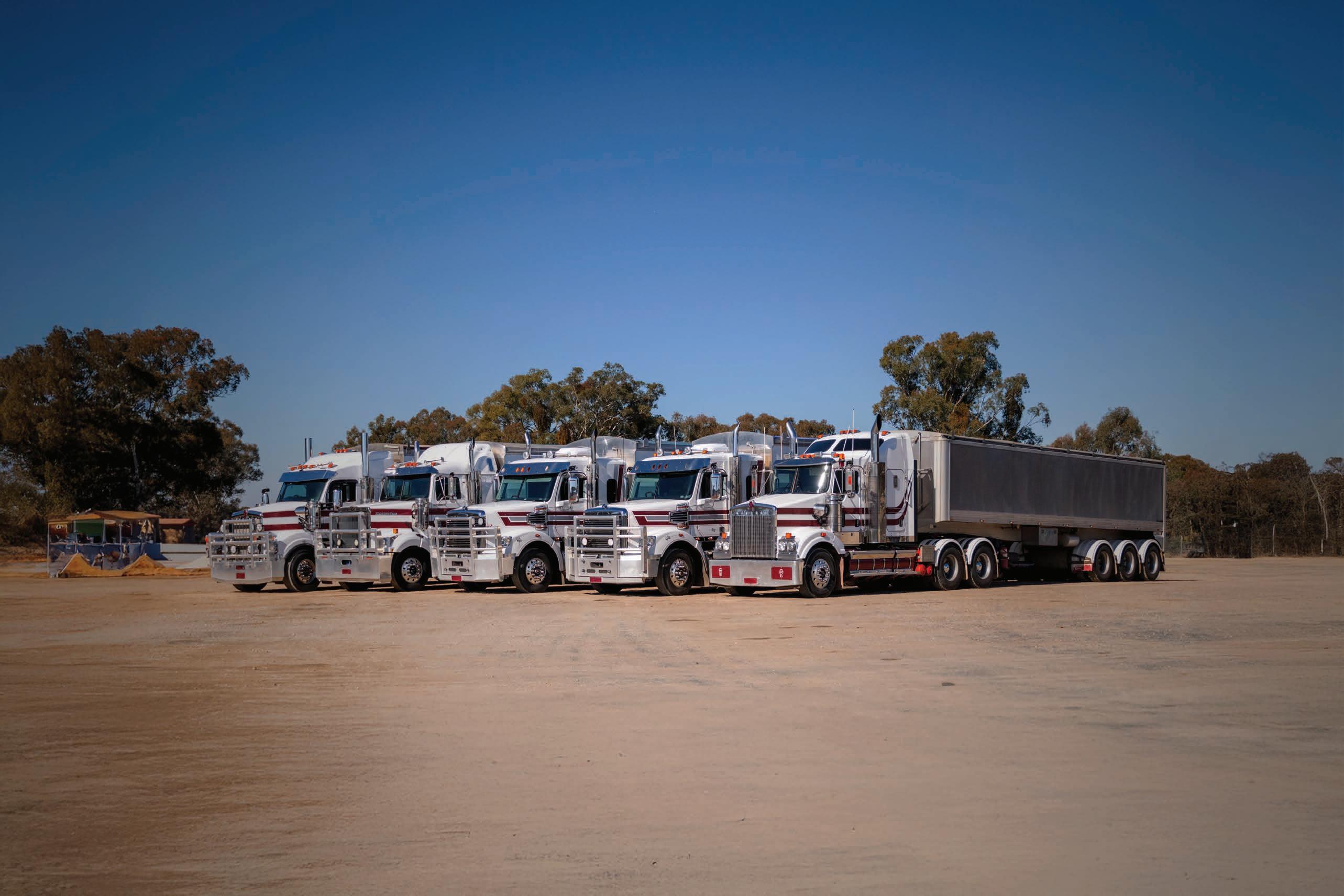
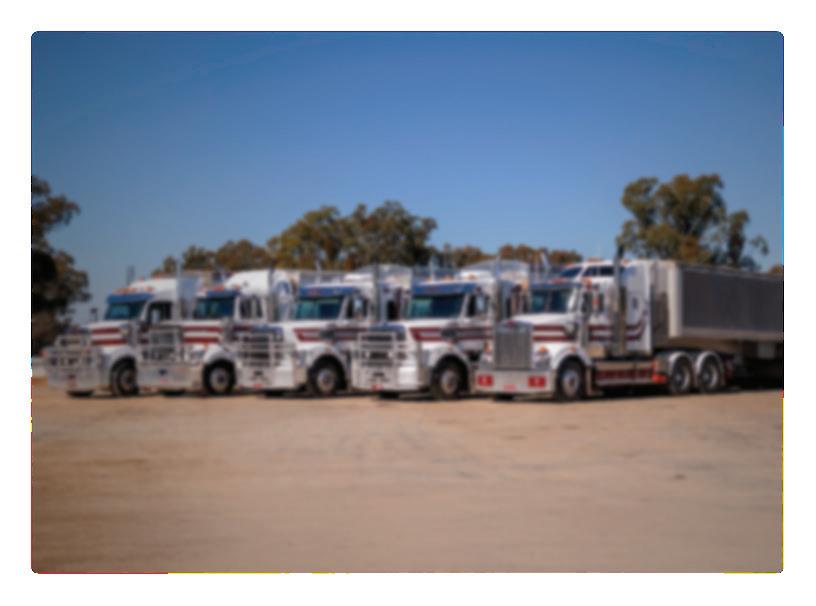
(6)
(6)
(8)





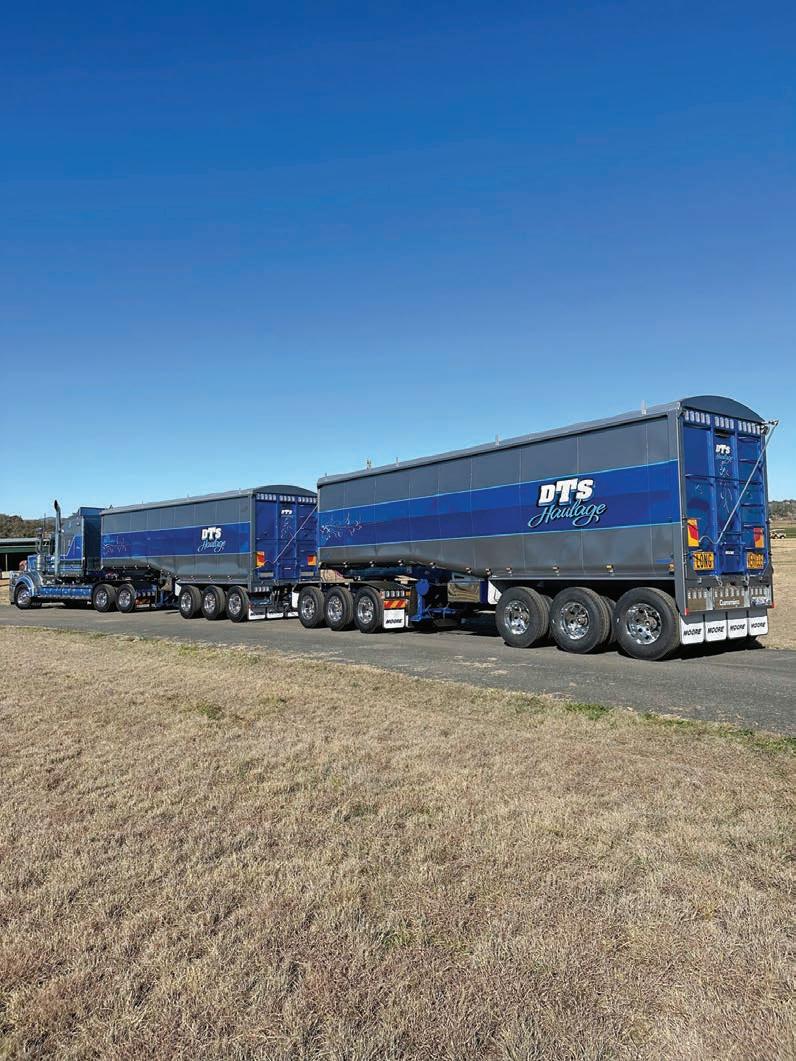
ISUZU Australia Limited (IAL) has renewed its commitment to ongoing training and retention of diesel technicians with a donation of 32 contemporary engines to TAFE colleges across Victoria.
Speaking at a hand-over event hosted by SuniTAFE in Mildura, IAL’s Head of Aftersales, Brett Stewart, said the brand was committed to continuing its support of TAFE training.
“Demand for diesel powered commercial vehicles and capital equipment has never been higher and these machines all need service and support throughout their lifecycle,” Stewart said.
“However, a persistent issue for our sector is a shortage of skilled diesel technicians in the system.
“As Australia’s truck market leader, we’re committed to ensuring this demand is met. Our TAFE institutions really are the lifeblood of this broader push, so what better place to lend a hand.”
The diesel engines supplied include a range of four and six-cylinder variants encompassing mechanical and common rail designs.
These are the same units that are used in many of Isuzu’s existing line-up of truck models and off-highway Isuzu Power Solutions products.
“We have secured 32 diesel
BRETT MILLINGTON
engines of various sizes and configurations for students to work on that are all current, ‘in-market’ models – not old or discontinued technology,” Stewart said.
“As the biggest selling truck brand in the country, there’s a fair chance that many of these technicians will eventually work with Isuzu diesel engines, so having them experience the same type of technology during their TAFE training, ensures a smoother transition to workshops or out into the broader capital equipment field.”
SuniTAFE CEO, Brett Millington, said the arrival and scale of the Isuzu donation will have an immediate impact on student training.
“We’re very grateful for the immense generosity of this donation,” Millington said.
“This equipment will be used in vital day-to-day
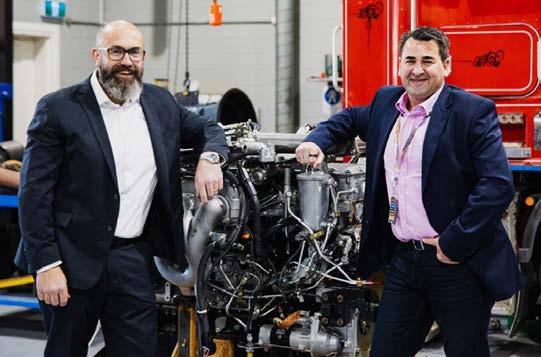
training of our students and will make a significant difference in the classroom.
“We pride ourselves on the training we deliver, and this equipment will help us teach skills that are vital for our region now and into the future.”
Will Sharpe, SuniTAFE Heavy Automotive Teacher, said that diesel technician training using current model engines and ancillaries closes the gap for real world experience.
“These engines and radiators will have a massive impact on our training in Mildura and Swan Hill,” Sharpe said.
“It will give hundreds of apprentices hands-on exposure to real-world engine, diagnostics, cooling system designs, and modern com-
mon rail diesel technology.”
Stewart reinforced the no tion that a career as a diesel mechanic remains a longterm proposition, with a range of employment opportunities available well into the future.
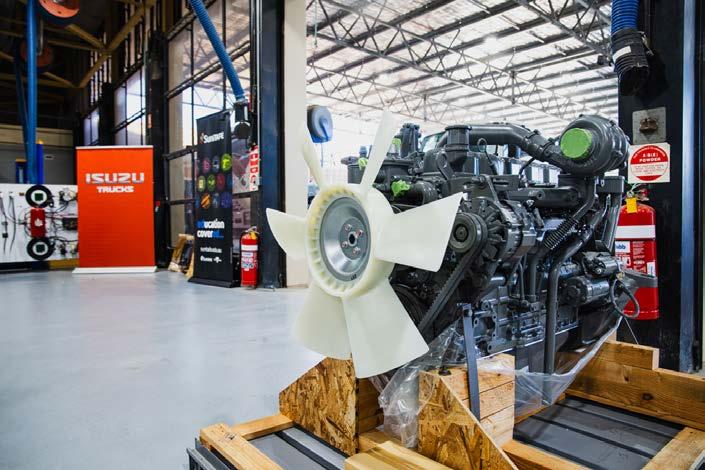
“Diesel engine technology, whether it be in trucks, off-highway applications or a range of other heavy industries, has a strong future despite perceptions,” Stewart said.
“Demand is only increasing and with engine technology and overall efficiencies improving drastically, the need for trained technicians will remain strong for many decades to come.
“This means that Isuzu dealers and other workshops will be busy places, and the most valuable resource will
be skilled technicians.
“I started as a diesel apprentice and did all my TAFE studies at the Gordon Geelong. I forged a successful career in workshops, dealerships, and now within a leading OEM.
“Having professional training is a skill for life and can lead to a range of opportunities that many people never imagined.”
The following line-up of Isuzu engines have been supplied to Sunraysia Institute of TAFE (SuniTAFE) (Mildura and Swan Hill), The Gordon (Geelong), Chisholm Institute (Dan-
denong), Wodonga TAFE (Barnawartha campus) and Outer Northern Trade Centre (Lalor):
• 14 x 4JG1 engines (mechanical)
• 7 x 4JJ1 engines (common rail)
• 1 x 4HK1 engine (common rail)
• 2 x 4BG1 engine (mechanical)
• 5 x 6HK1 engines (common rail)
• 1 x 6BG1 engine (mechanical)
• 2 x 6UZ1 engine (common rail)
• 49 x radiators.
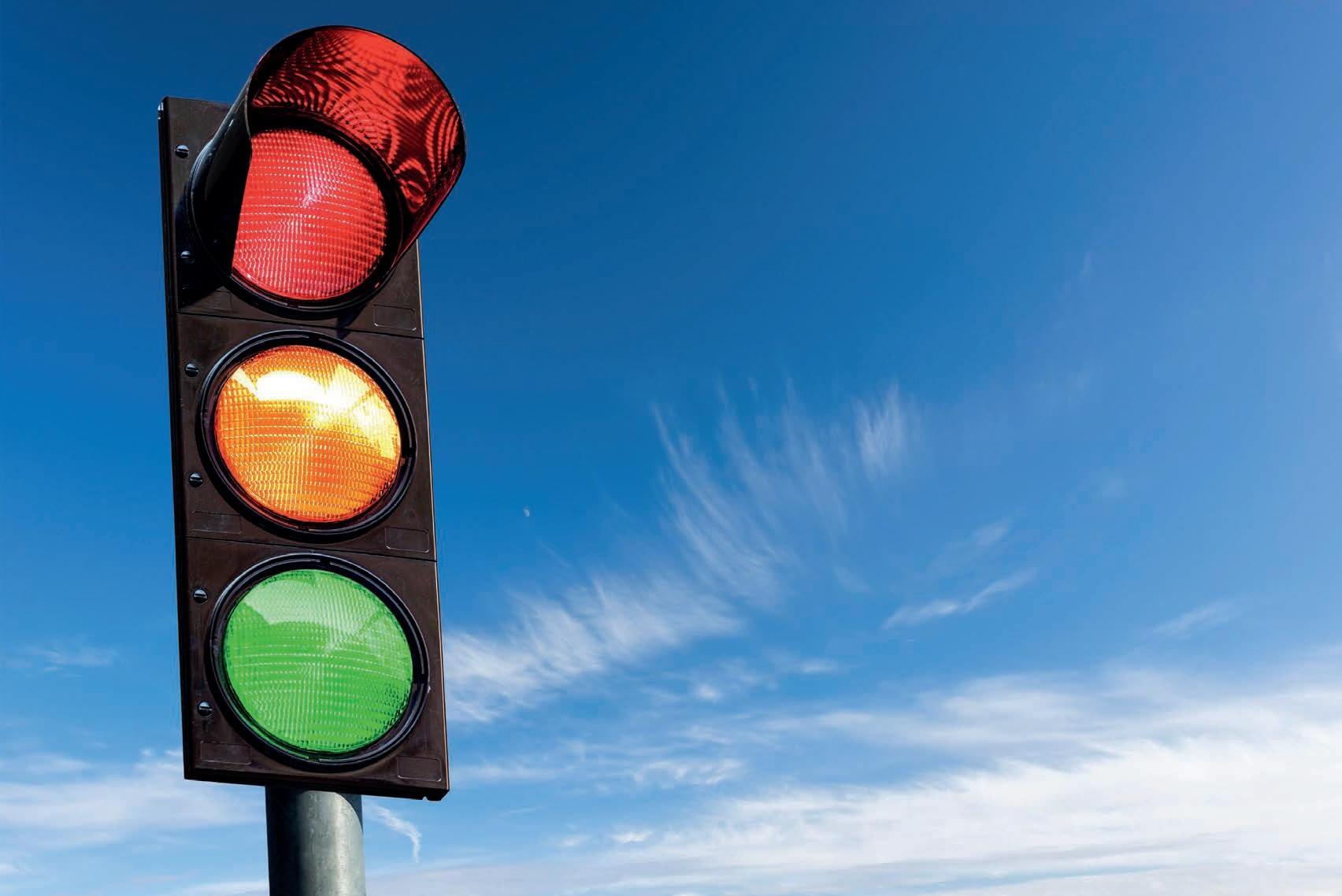





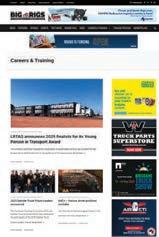
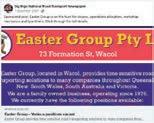
Since recently upgrading to her MC licence, this third generation truckie is loving life on the road, tackling the Townsville to Mt Isa run in a triple road train.
BY DANIELLE GULLACI
For Kaela Iversen, 37, sitting in the passenger seat a longside her late grandfather, helped instil a passion for trucks that’s seen her work her way up to driving B-triples.
“I grew up around trucks. My pop had a truck to cart livestock, hay and wool. My fondest memories were going out with him from as young as seven. I’d have rather be in the truck any day than having to go to school!” she said.
“I loved helping Pop on the farm – he was my hero.”
Growing up in the Snowy Mountains, NSW, Kaela moved to Queensland – to a rural property located somewhere between Julia Creek and Normanton – in 2010 to pursue station work. And it was there that Kaela got her first taste of being behind the wheel. “I was carting stock around the station – cattle and horses – in a heavy rigid with a crash box, so I sort of fell into truck driving. I sat the test for my HC and haven’t looked back.”
K aela went on to work at several outback stations – and during a stint at Avon Downs in the Northern Territory, she
got her first taste of driving a triple around the property.
Speaking of her years spent doing station work, Kaela said, “I was chasing cattle, riding horses, it was good fun. Then in 2019, I moved to Mt Isa and got into general freight. I started working for Windus Transport in 2021, which sub-contracted to Fol lowmont, along with other bits and pieces.
“Then when I made the move to Townsville with my partner, I gave my resume to Followmont and they took me under their wing.”
Kaela joined Followmont’s Townsville branch as a lo cal driver in October 2024.
Recognising the commit ment and passion she has for her role, she was asked if she’d like to do the Townsville to Mt Isa run.
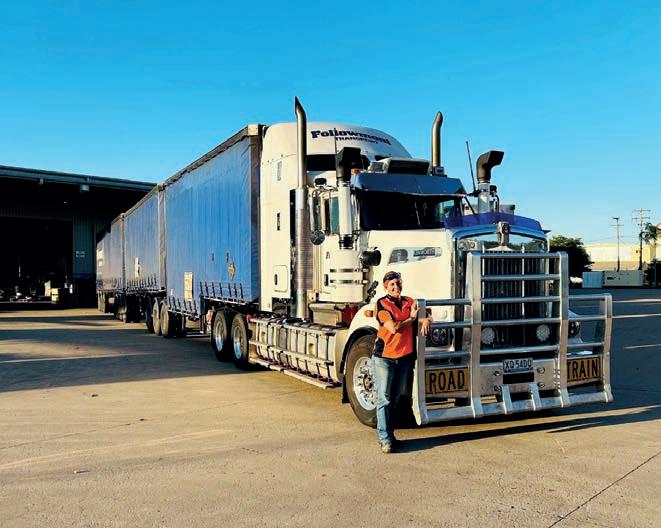
Followmont helped her to upgrade to her MC licence and in June, she did her first run in the B-triple.
The 900-kilometre route from Townsville to Mt Isa involves stops at Richmond, Julia Creek and Cloncurry, on the way up and back – and typically Kaela does that run twice a week.
“I always wanted to be a truck driver just like Pop, and
now here I am,” said Kaela. “As a necessity for property owners, they often have an external job to supplement their income, Pop’s job was carting livestock and hay. Once Pop passed away, Dad took over so he’s in trucks too.”
Followmont has four bonneted Kenworths dedicated to the Townsville to Mt Isa run – two T409s, a T909 and a T610. “The Kenworths are a beautiful truck to drive,” Kaela added. “They’re comfortable and smooth. The roads out west aren’t the

greatest, with all the culverts, but the Kenworths glide over quite easily,” said Kaela.
“It’s a heavily used road between here and Mt Isa, because a lot of the dirt on the edges of the road has fallen away, so it can be quite tough.”
Kaela’s partner Luke Fletcher is also a road train driver at Followmont – and that’s how the pair met. He’s been with the company for 13 years and does the Townsville to Mt Isa run too.
“So we understand what
each other goes through out on the road. It works out well when he gets home in the morning and I’ve got a couple of hours before I go to work and before he goes to bed.”
Kayla says that Followmont’s Townsville Branch Manager Thomas Dungavell and Regional Manager, North Queensland, James Henderson, have both been instrumental in helping her get to where she is in her driving career.
“I love working for Followmont. I love the people who
I ALWAYS WANTED TO BE A TRUCK DRIVER JUST LIKE POP, AND NOW HERE I
AM.”
KAELA IVERSEN
upported me every step of the way. Luke was a cabinet maker, so he didn’t come from trucking background like me. But both of us haven’t look back,” Kaela added. Truck driving is a fantastic career if you’re looking for a job that’s rewarding. There is so much responsibility riding on you when you’re trusted with hundreds of thousands of dollars worth of equipment and freight. That in itself is really rewarding.
“You don’t need to have grown up around trucks or have come from a trucking background and Luke is a prime example of that.
“His brother is now also a truck driver with Followmont, transporting refrigerated freight.
“In this job, you get to go to so many interesting places, and meet so many wonderful, amazing people.”

SEPTEMBER
MEGATRANS is Australia’s largest integrated conference and exhibition for the logistics industry. It brings together leading companies showcasing advanced technologies and services, all focused on enhancing and supporting a sustainable supply chain through innovation and collaboration.
